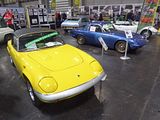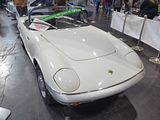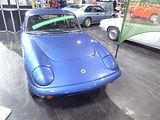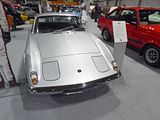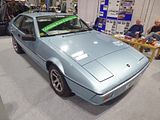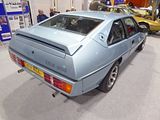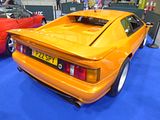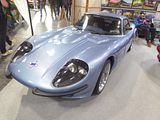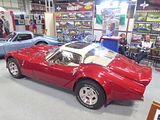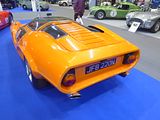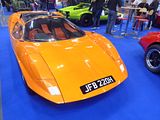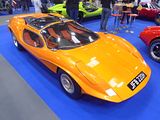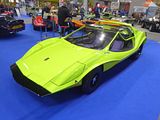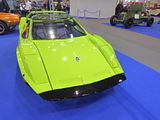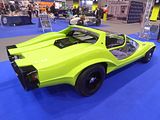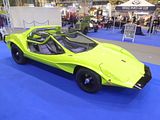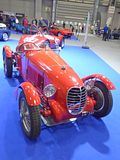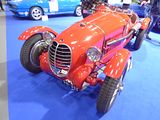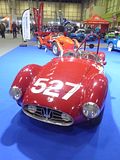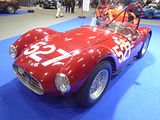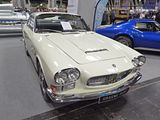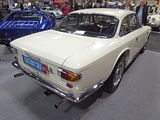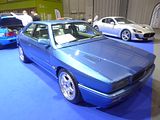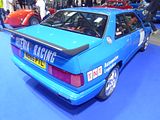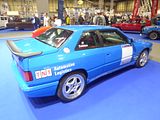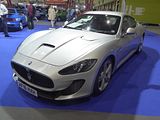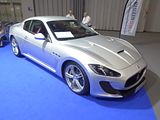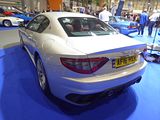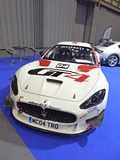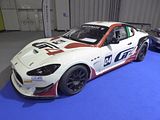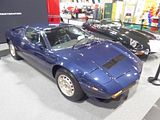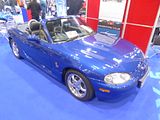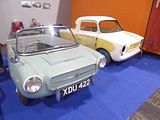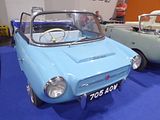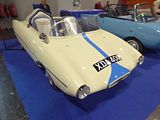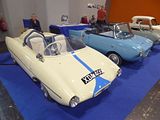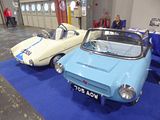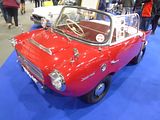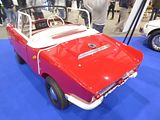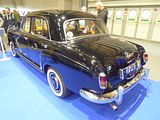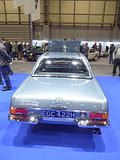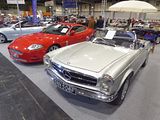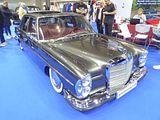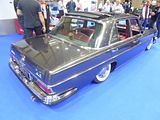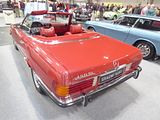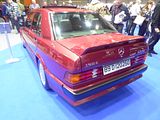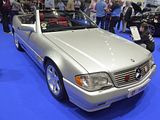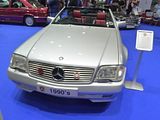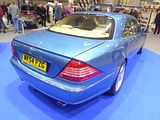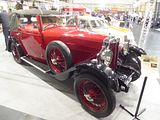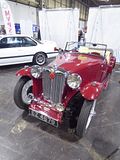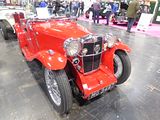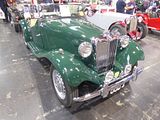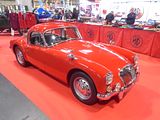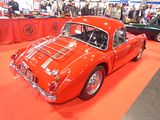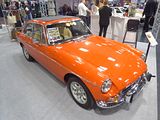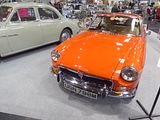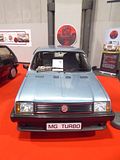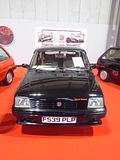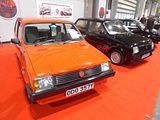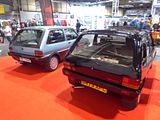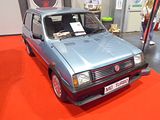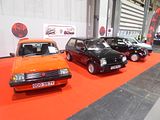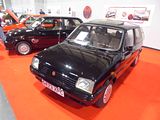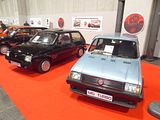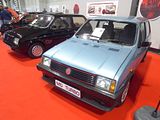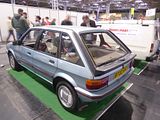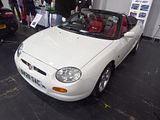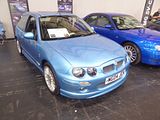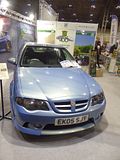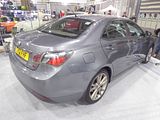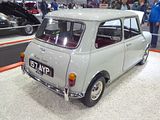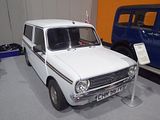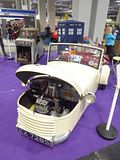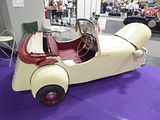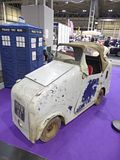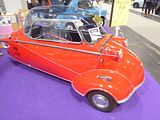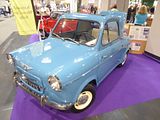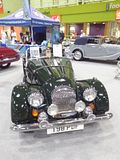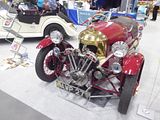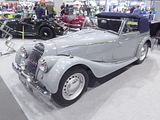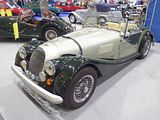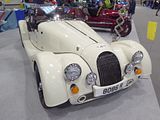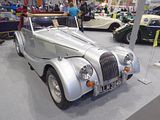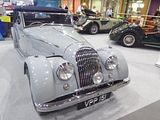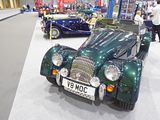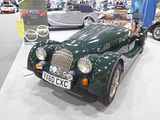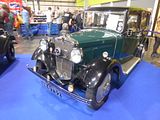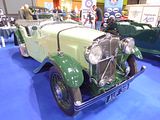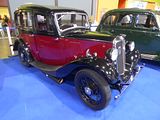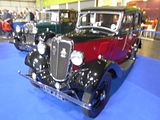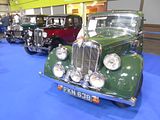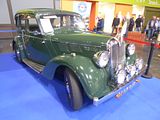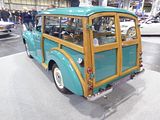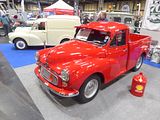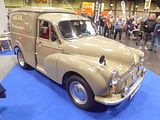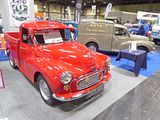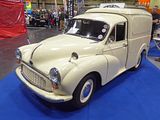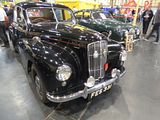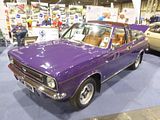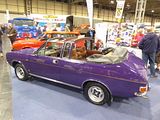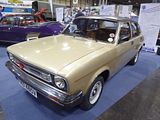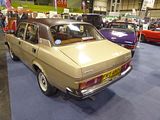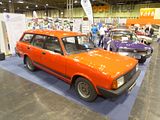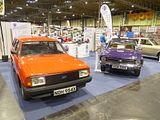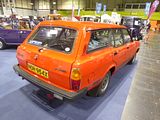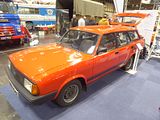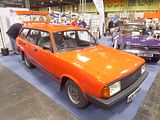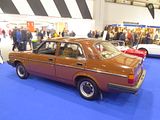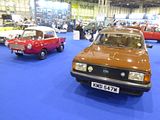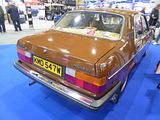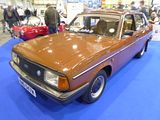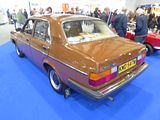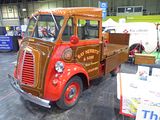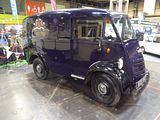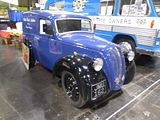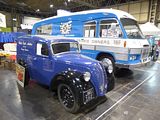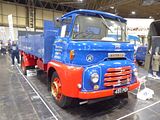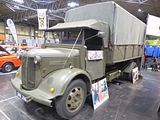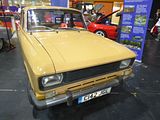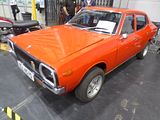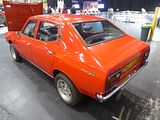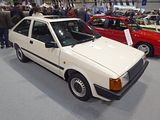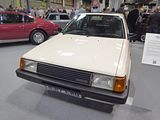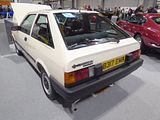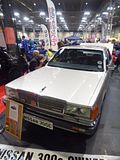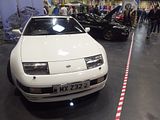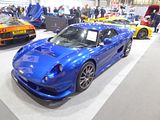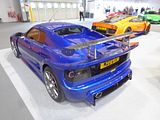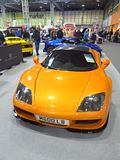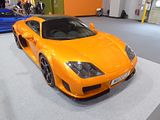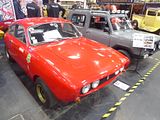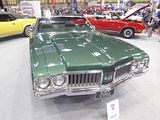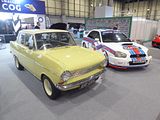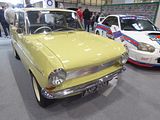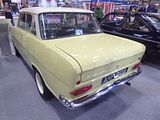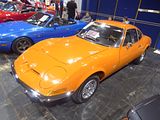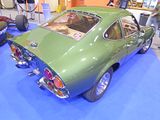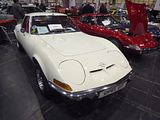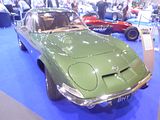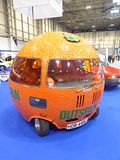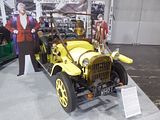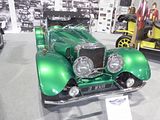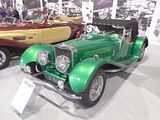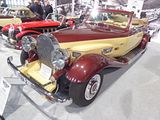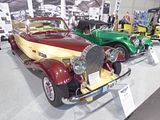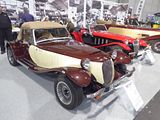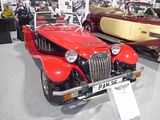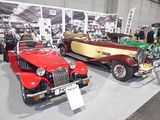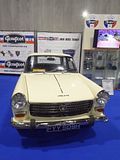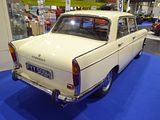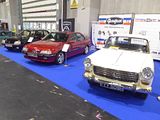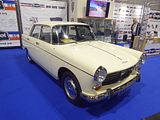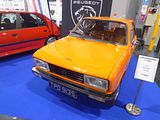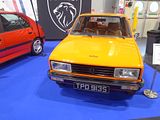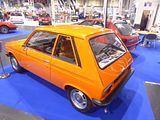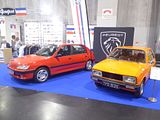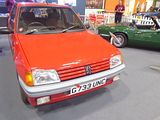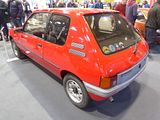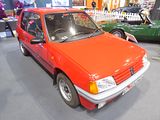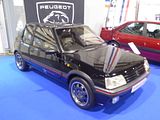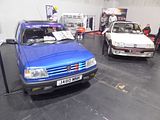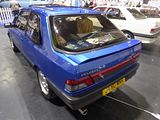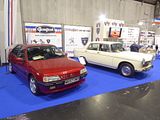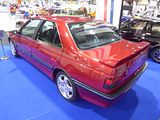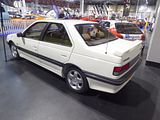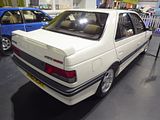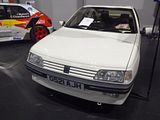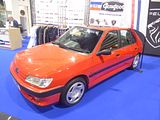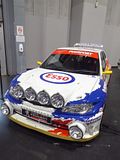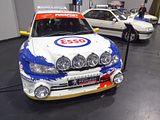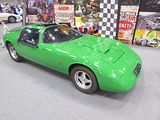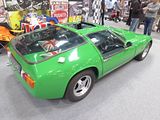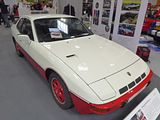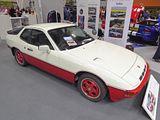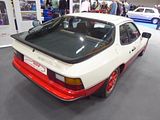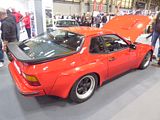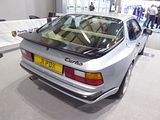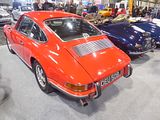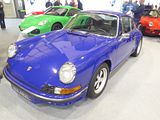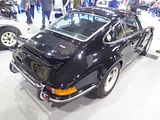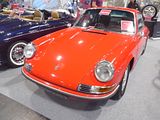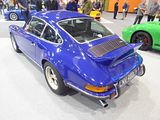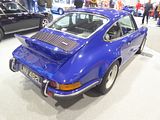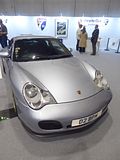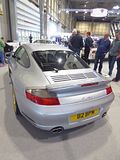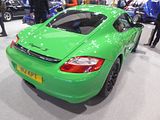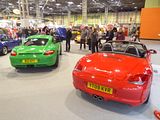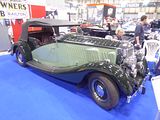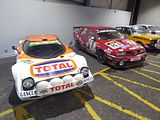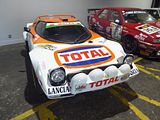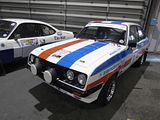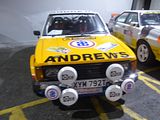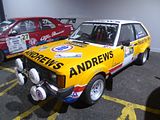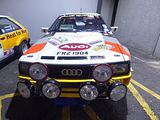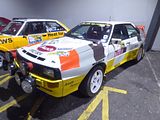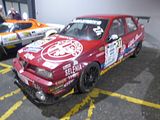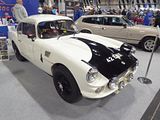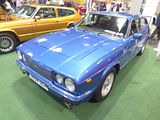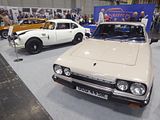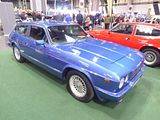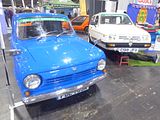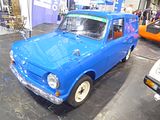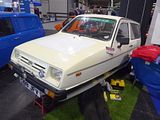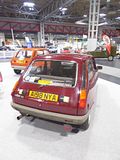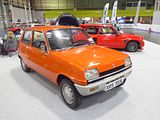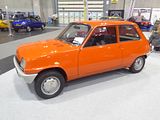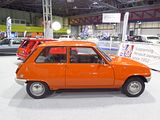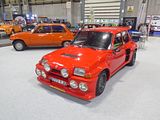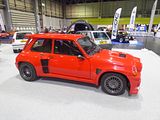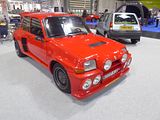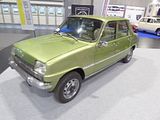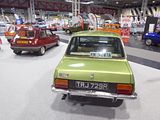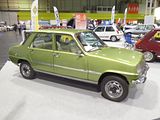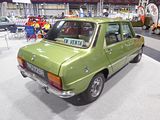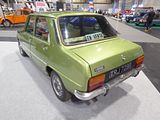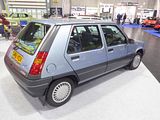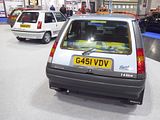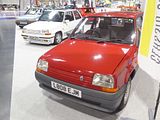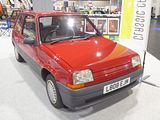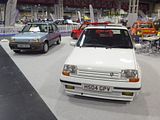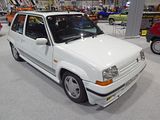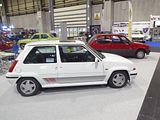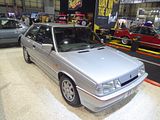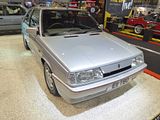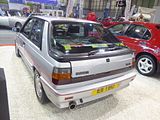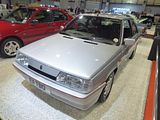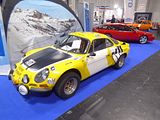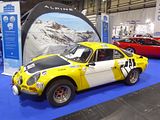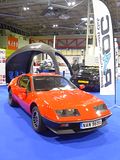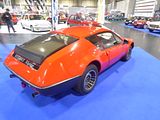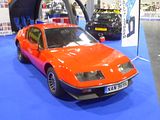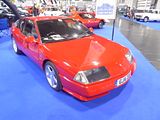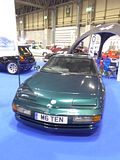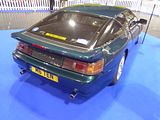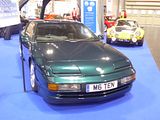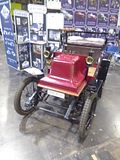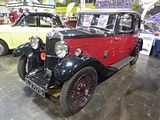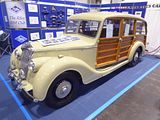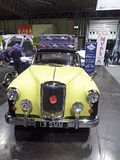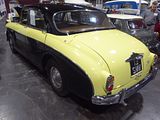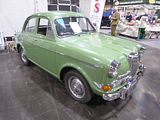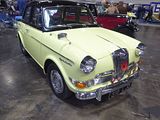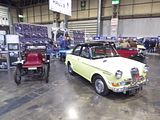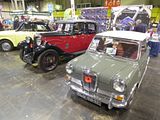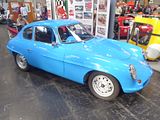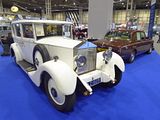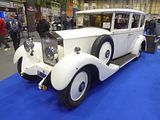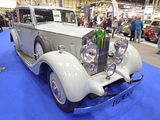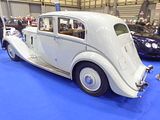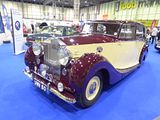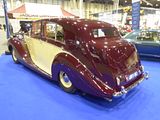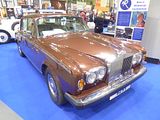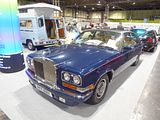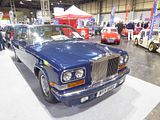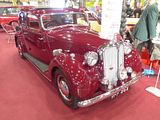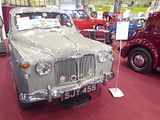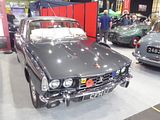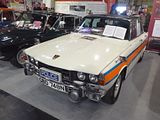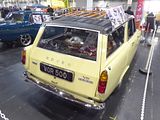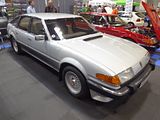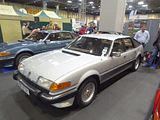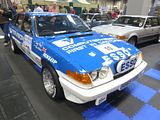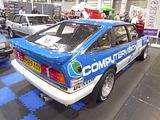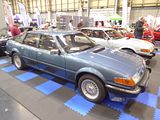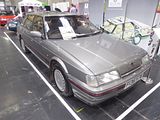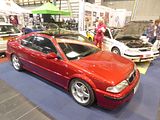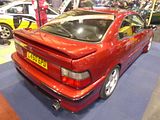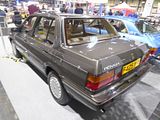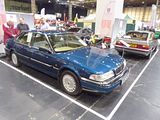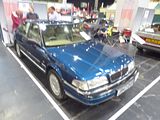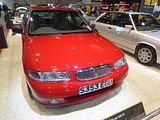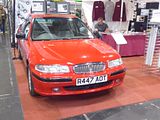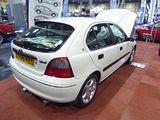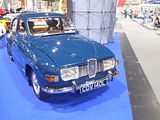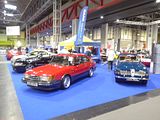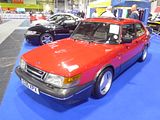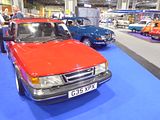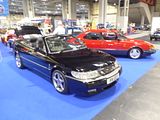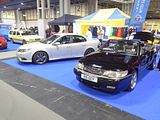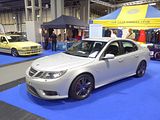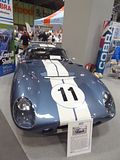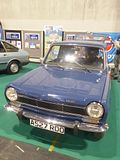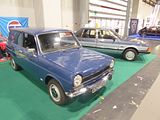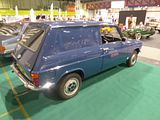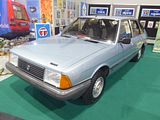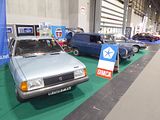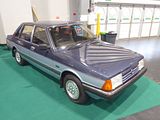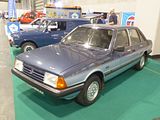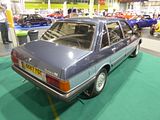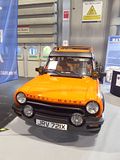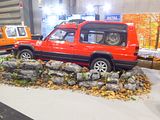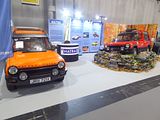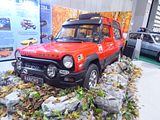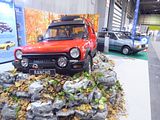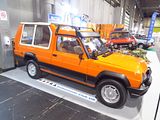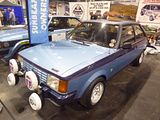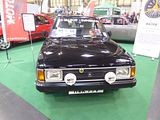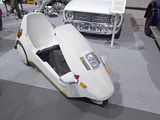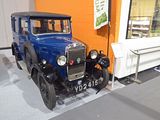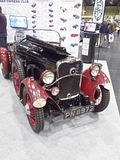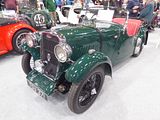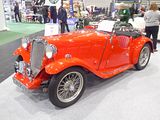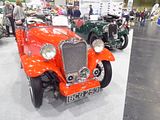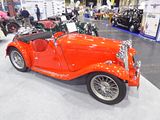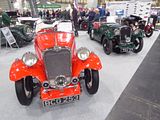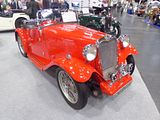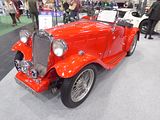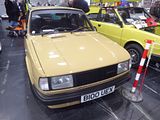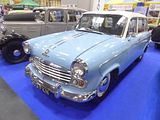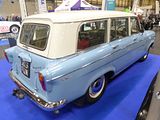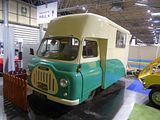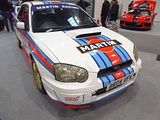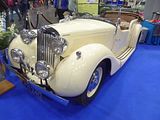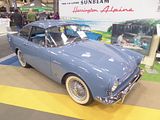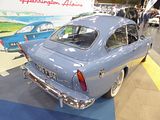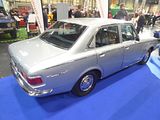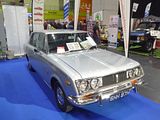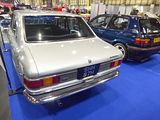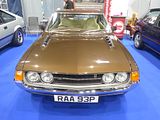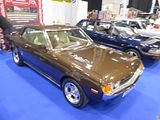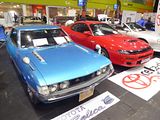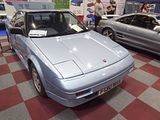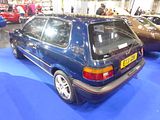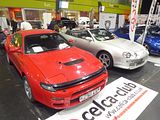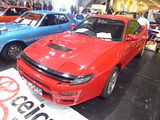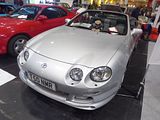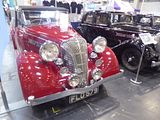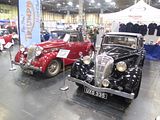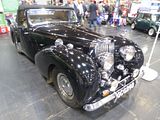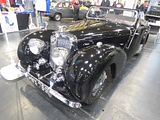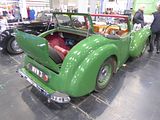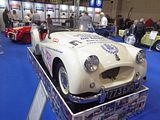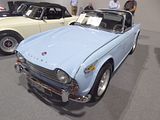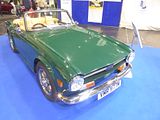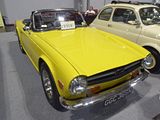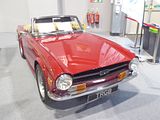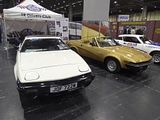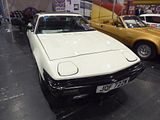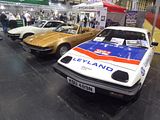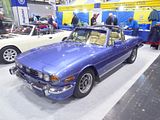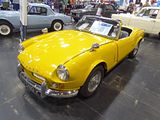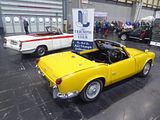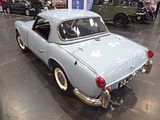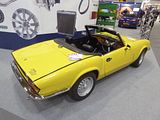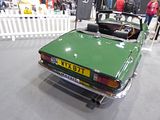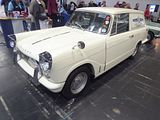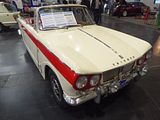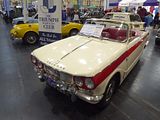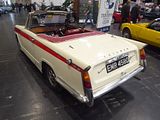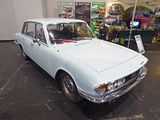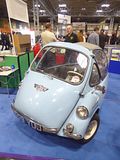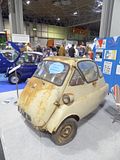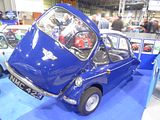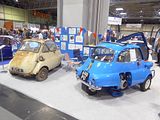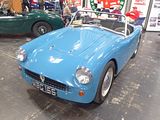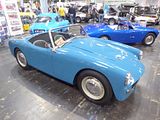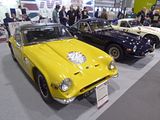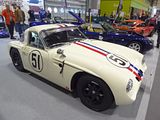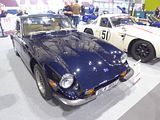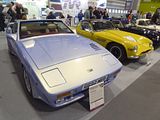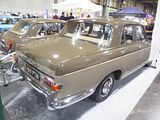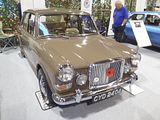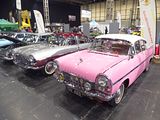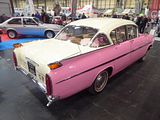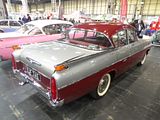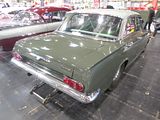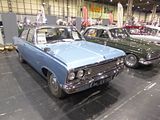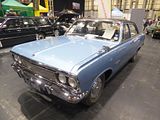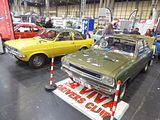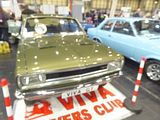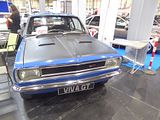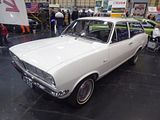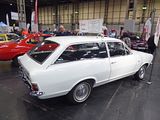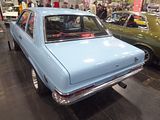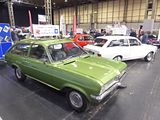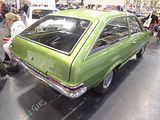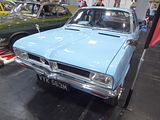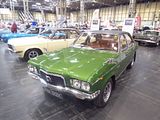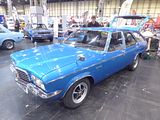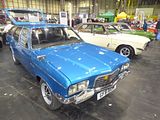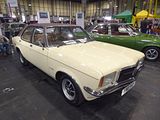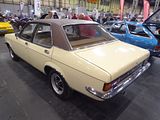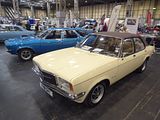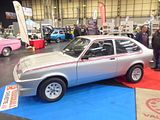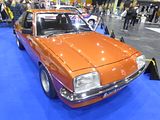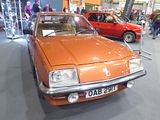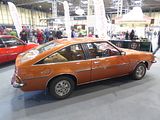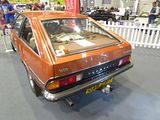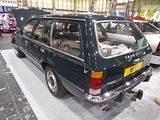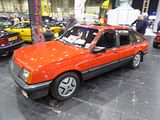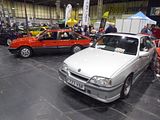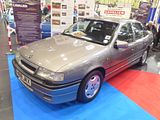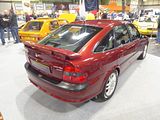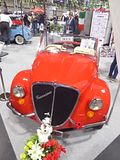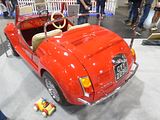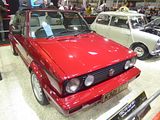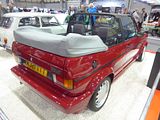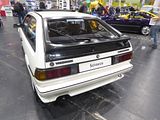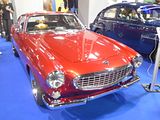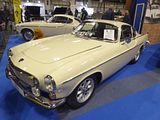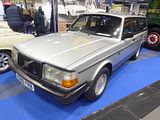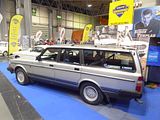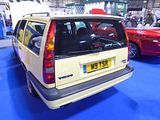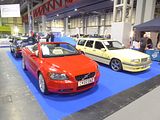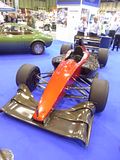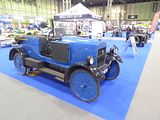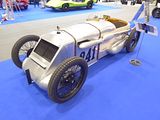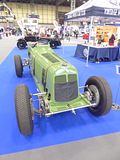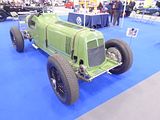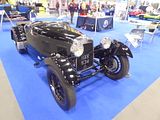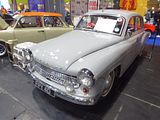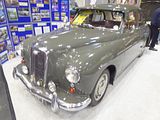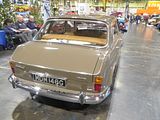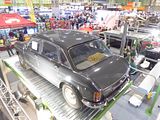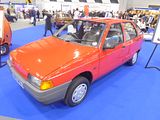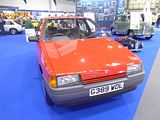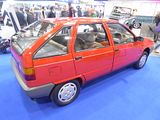LOTUS
The original Elan was introduced in 1962 as a roadster, although an optional hardtop was offered in 1963 and a coupé version appeared in 1965, and there were examples of all of these here. The two-seat Lotus Elan replaced the elegant, but unreliable and expensive to produce Lotus Elite. It was the first Lotus road car to use a steel backbone chassis with a fibreglass body. At 1,600 lb (726 kg), the Elan embodied the Colin Chapman minimum weight design philosophy. Initial versions of the Elan were also available as a kit to be assembled by the customer. The Elan was technologically advanced with a DOHC 1557 cc engine, 4-wheel disc brakes, rack and pinion steering, and 4-wheel independent suspension. Gordon Murray, who designed the spectacular McLaren F1 supercar, reportedly said that his only disappointment with the McLaren F1 was that he couldn’t give it the perfect steering of the Lotus Elan. This generation of the two-seater Elan was famously driven by the character Emma Peel on the 1960s British television series The Avengers. The “Lotus TwinCam” engine was based on Ford Kent Pre-Crossflow 4-cylinder 1498 cc engine, with a Harry Mundy-designed 2 valve alloy chain-driven twin-cam head. The rights to this design was later purchased by Ford, who renamed it to “Lotus-Ford Twin Cam”. It would go on to be used in a number of Ford and Lotus production and racing models.
Introduced in 1967, the Elan +2 had a longer wheelbase and two rear seats and so was intended for those Lotus customers who needed space to carry (small) people in the back, without sacrificing the same basic principles which made the Elan so appealing. A fast and agile sport coupe, a number of different engines were fitted over the years, with the later models having 130 bhp and a 5 speed gearbox at their disposal, which gave a top speed of 120 mph and 0–60 acceleration of 7.9 seconds and 0-100 mph 21.8 seconds. 5,200 Elans +2 were made, with production ceasing in 1975. Fewer than 1,200 of these cars remain on the roads today. Their relative rarity, beautiful lines, impressive performance and practicality are the main factors for the rising interest on these cars among collectors. There was a rare Drophead conversion here as well as the standard fixed head production cars.
Known internally as the Type 89, the Excel, built from 1982 to 1992, was a development of the earlier Lotus Eclat, which itself was based on the Type 75 Elite. Although a promising design, the Elite and Eclat had suffered from numerous quality control issues which were difficult for owners to accept given the price of the cars. The Excel was a concerted effort to address these, and it stood every chance of so doing, as it took advantage of the relationship with Toyota. This had started when Toyota engaged Lotus to assist with engineering work on the Supra. During this period, Toyota then became a major shareholder in Lotus. Part of the deal between the two included the use of many Toyota mechanical components in Lotus’ cars. The original Excel (aka the Eclat Excel) used the W58 manual transmission, driveshafts, rear differential, 14×7 in alloy wheels, and door handles from the Supra Mk II, which was made from 1982 to 1986. The engine was the familiar all-aluminium, DOHC 2.2 litre Lotus 912 Slant Four which was also used in the Lotus Esprit S3. During its lifetime, the Excel received two major upgrades. With the introduction of the Excel SE which had a 180 bhp engine vs the standard 160 bhp car in October 1985, the bumpers, wing and interior was changed, including a new dashboard. In October 1986 the Excel SA with automatic gearbox was introduced. Further facelifts in 1989 saw Citroën-derived mirrors, as featured on the Esprit, and 15 inch OZ alloy wheels to a similar pattern as the Esprit’s. According to Lotus records, only 1 Excel was manufactured to USA specification. The lack of release in the USA was due to the high emission regulations (which would hinder the car’s performance), and poor sales of the car in Europe.
In 1987, a new version of the mid-engined Esprit was unveiled, incorporating rounder styling cues given by designer Peter Stevens (who later designed the McLaren F1). A new Lotus patented process was introduced to create the new body, called the VARI (Vacuum Assisted Resin Injection) process, which offered more advantages than the previous hand laid process. Kevlar reinforcement was added to the roof and sides for roll-over protection, resulting in an increase of the Esprit’s torsional rigidity by 22 percent. Giugiaro is said to have liked the restyling, claiming it was perhaps too close to his original design. The Stevens styled cars retained the mechanical components of the previous High Compression Esprit and Turbo Esprit, but introduced a stronger Renault transaxle, which necessitated a move to outboard rear brakes. However, the MY 1988 North American Esprit Turbo kept its Citroën SM type transaxle and the Bosch K-Jetronic fuel injection system used in the previous model year. The car’s Type 910 engine retained 215 bhp and 220 lb·ft, but decreased its zero to sixty from 5.6 seconds to a varied time between 5.4 – 5.1 seconds and a top speed of over 150 mph. The exterior style changes were accompanied by a redesign of the interior, allowing a little more space for the occupants. The Stevens styled Esprit is often known by its project code of X180. In 1989, the Esprit was again improved with the GM multi-port, electronic fuel injection system and the addition of a water to air intercooler, which Lotus has named the Chargecooler, producing the SE (Special Equipment). This inline-four engine was known as the Type 910S. Horsepower was pushed up to 264 with 280 available on overboost and zero to sixty miles per hour times reduced to 4.7 seconds with a top speed of over 160 mph. Several modifications were made to the body kit as well, like side skirts which are parallel to the body, five air ducts in the front air dam, wing mirrors from the Citroën CX and the addition of a rear wing. Along with the SE, Lotus produced the little seen Esprit S, a midrange turbocharged car offering fewer appointments and 228 hp, as well as the standard turbo still offering 215 hp . The N/A and lower-powered turbo were cancelled after 1990, and the S in 1991. Another unusual variant was a two-litre “tax special” developed for the Italian market, fitted with an intercooled and turbocharged version of a new 1,994 cc version of the venerable 900-series four-cylinder engine. Equipped with SE trim, this appeared in December 1991 and produced 243 PS at 6,250 rpm. Beginning in the autumn of 1996, this engine became available in other markets as well. The Esprit was a popular and successful addition to the American IMSA Bridgestone Supercar Championship and as a result Lotus produced the SE-based X180R, with horsepower bumped to 300 and with racing appointments. The Sport 300 was a derivative of the X180R sold in Europe, which included many modifications. These are known as the fastest of the four-cylinder Esprits and among the most desirable. In 1993, another exterior and interior revamp of the car resulted in the S4 which was the first model to include power steering. The exterior redesign was done by Julian Thompson, which included a smaller rear spoiler placed halfway up the rear decklid. Other major changes were to the front and rear bumpers, side skirts and valence panels. New five spoke alloy wheels were also included in the redesign. The S4 retained the same horsepower as the SE at 264 hp.The S4 was succeeded in 1994 by the S4s (S4 sport), which upped power to 300 bhp and 290 lb·ft of torque, improving all-around performance while retaining the comfort of the previous version. Top speed was increased to 168 mph, skidpad increased to 0.91g, an increased slalom of 61.7 mph and a 0-60 mph time of 4.6 seconds. Although the engine kept its 2.2-litre capacity, many modifications were added to improve engine performance. Some of the changes were enlarged inlet ports, cylinder head modifications, a re-calibrated ECM and a revised turbocharger. The most visible external styling changes was the addition of a larger rear wing taken from the Sport 300. In 1996 the Esprit V8 used Lotus’ self-developed all-aluminium, twin-turbocharged (Garrett T25/60 turbos) 90-degree V-8, Code-named Type 918, in front of the same Renault transmission as before with no Chargecooler. Derek Bell developed an uprated gearbox that overcame a lot of the gearbox problems with a much thicker single piece input shaft. The Type 918 engine was detuned from a potential 500 bhp to 350 bhp to prevent gearbox damage due to the fragility of the Renault UN-1 transmission. In period tests, zero to sixty miles per hour came in at 4.4 seconds and top speeds of over 175 mph were achieved. Produced alongside V8 models was the GT3, a turbocharged four-cylinder car with the type 920 2.0 litre chargecooled and turbocharged engine which had been used only in Italian market cars previously. In 1998 the V8 range was split into SE and GT specifications, both cars with a much changed interior configuration, both offering similar performance with the SE being the more luxurious of the two. The ultimate incarnation of the Esprit came in 1999 with the Sport 350. Only 50 were made, each offering 350 horsepower (per the name) and various engine, chassis and braking improvements, like the addition of AP Racing brakes, stiffer springs and a revised ECU. Several visual changes were made as well, including the addition of a large carbon fibre rear wing on aluminium uprights in place of the standard fibreglass rear wing. By this time the Esprit could reach 60 mph in 4.3 seconds as well as reaching 0-100 mph in less than 10 seconds, and weighed 1,300 kg (2,866 lb) as a result of many modifications. Thereafter, Lotus made little development aside from minor cosmetic changes including a switch to four round tail lights for the 2002 model year. Esprit production ceased in February 2004 after a 28 year production run. A total of 10,675 Esprits were produced.
There has only ever been one front wheel drive model with Lotus badges on it, the “M100” Elan sports car. Like many specialist produced cars of the era, there was a long wait for this car form when news first broke that it was under development to the actual release of cars people could buy. The M100 Elan story goes back to 1986 and the purchase of Lotus by General Motors which provided the financial backing to develop a new, small, affordable car in the same spirit as the original Elan, the last of which had been built in December 1972. A development prototype, the M90 (later renamed the X100) had been built a few years earlier, using a fibreglass body designed by Oliver Winterbottom and a Toyota-supplied 1.6-litre engine and transmission. Lotus was hoping to sell the car through Toyota dealerships worldwide, badged as a Lotus Toyota, but the project never came to fruition and the prototype was shelved, although Lotus’s collaboration with Toyota had some influence on the design of the Toyota MR2. The idea of a small roadster powered by an outsourced engine remained, however, and in late 1986 Peter Stevens’s design for the Type M100 was approved and work began by Lotus engineers to turn the clay styling buck into a car that could be built. This process was completed in just under three years, a remarkably short time from design to production car. The M100 Elan was conceived as a mass-market car and in particular one that would appeal to US buyers. Consequently, Lotus put an enormous effort (for such a small firm) into testing the car; over a two-year period 19 crash cars and 42 development vehicles were built, logging nearly a million test miles in locations from Arizona to the Arctic. The Elan was driven at racing speeds for 24 hours around the track at Snetterton. Finally each new car was test-driven for around 30 miles at Lotus’s Hethel factory to check for any manufacturing defects before being shipped to dealers. The choice of front-wheel drive is unusual for a sports car, but according to Lotus sales literature, “for a given vehicle weight, power and tyre size, a front wheel drive car was always faster over a given section of road. There were definite advantages in traction and controllability, and drawbacks such as torque steer, bump steer and steering kickback were not insurmountable.” This was the only front-wheel-drive vehicle made by Lotus. Every model made since the M100 Elan, such as the Lotus Elise, has been rear-wheel drive. The M100 Elan’s cornering performance was undeniable (on release the Elan was described by Autocar magazine as “the quickest point to point car available”). Press reaction was not uniformly positive, as some reviewers found the handling too secure and predictable compared to a rear-wheel-drive car. However, the Elan’s rigid chassis minimised roll through the corners and has led to its description as ‘the finest front wheel drive [car] bar none’. Unlike the naturally aspirated version, the turbocharged SE received power steering as standard, as well as tyres with a higher ZR speed rating. The M100 Elan used a 1,588 cc double overhead camshaft (DOHC) 16-valve engine, sourced from the Isuzu Gemini and extensively modified by Lotus (a third generation of this engine was later used in the Isuzu Impulse), which produced 162 hp. 0–60 acceleration time was measured by Autocar and Motor magazine at 6.5 seconds, and a top speed of 137 mph was recorded. Significant differences in the Isuzu-Lotus engine from the original include a new exhaust system, re-routed intake plumbing for better thermodynamic efficiency, improved engine suspension, and major modifications to the engine control unit to improve torque and boost response. Almost all models featured an IHI turbocharger. Two variants were available at launch, the 130 bhp Elan 1.6 (retailing at £17,850) and the 162 bhp Turbo SE (£19,850). Initial sales were disappointing, perhaps because its launch coincided with a major economic recession in the UK and USA, and perhaps also because it coincided with the cheaper Mazda MX-5 which was arguably similar in concept, though the MX-5 was quite intentionally nostalgic and old fashioned (apeing the original Elan), while the M100 was deliberately futuristic, modern and forward looking. The Elan was regarded as a good product in a bad market, but was also very expensive to make (the cost to design and produce the dashboard alone was more than the total cost of the Excel production line), and sales figures were too low to recoup its huge development costs. Altogether 3,855 Elans were built between November 1989 and July 1992, including 129 normally aspirated (non-turbo) cars. 559 of them were sold in the US, featuring a ‘stage 2 body’ which had a different rear boot spoiler arrangement together with a lengthened nose to accommodate a USA-compliant crash structure and airbag, and 16-inch wheels (optional in most markets, standard in the U.S.) instead of 15-inch as on the UK model. A limited edition of 800 Series 2 (S2) M100 Elans was released during the Romano Artioli era (produced June 1994–September 1995) when it was discovered that enough surplus engines were available to make this possible. According to Autocar magazine, the S2 addressed some of the concerns over handling, but power was reduced to 155 bhp and the 0–60 acceleration time increased to 7.5 seconds, due to the legislative requirement to fit a catalytic converter in all markets. The S2s have very similar performance to the USA vehicles, having an identical engine management system calibration and a slightly lower overall vehicle weight.
MARCOS
There were a number of Marcos models on the Owners Club stand. Designed by brothers Dennis and Peter Adams, this well-known car caused something of a sensation when it was shown at the 1964 Racing Car Show. Known as the Marcos 1800, it had a glassfibre body, with a wooden chassis and was offered for sale fully built or in kit form. This was to be the design that would become familiar to sports car enthusiasts for more than 30 years, even though the original plywood chassis would later be replaced by a steel chassis and the futuristic scalloped dashboard also vanished after a few years. The plywood chassis was glued together from 386 separate pieces and was not only light and strong, but also required a minimum up front investment to construct. The extremely low Marcos required a nearly supine driving position and fixed seats, mounted lower than the floor of the car. In return, the entire pedal set could be moved fore and aft with a knob on the dashboard. If this proved not to be enough Marcos also offered optional booster pillows. This setup, with the fixed seats, remained until the end of Marcos production in late 2007. The original Marcos 1800 had a two-spoke steering wheel and a novel dash with a prominent centre console, a rather expensive design which did not survive onto the Ford-engined cars. The entire nose portion, of a long and tapered design, was hinged at the front and was held down by latches behind the front wheelwells. It used the cast-iron four-cylinder 96 hp Volvo 1778 cc B18 unit with overdrive gearbox from the Volvo P1800S enough for a 116 mph top speed and a 0-60 mph time of 8.2 seconds. Successful in competition, the rather expensive 1800 sold very slowly, and after the first 33 cars the de Dion rear suspension was replaced by a live Ford axle. The price was dropped from ₤1500 to ₤1340, but it was not enough to make the car profitable. Cars were stockpiling in 1966, and after 106 (or 99) had been built, the 1800 was replaced by the Ford-engined 1500. Normally fitted with a four-speed manual transmission a five-speed one was also available, allowing for a higher top speed. According to some sources, a few of the last cars built had the 2 litre Volvo B20 engine fitted, as did some of the racing cars. The 1800 is the only Marcos that is eligible for historic racing and as such is considerably more valuable today than later models. In 1966 the GT was changed to a pushrod inline-four Ford Kent engine of 1500 cc, in order to lower costs as the 1800 had been rather too expensive to market. The complex dash was also replaced with a flat polished wood unit, which was soon downgraded further yet to a mass-produced “wood-effect” one. Power and performance were both down on the 1800, but sales increased considerably. To hide the fact that a common Ford engine was used, Marsh replaced the rocker covers with Marcos ones and switched from Weber to Stromberg carburettors. An overbored Lawrencetune 1650 cc version was made available in 1967 (32 built) to ameliorate the power shortage, for the Marcos 1650 GT. The 1650 also had bigger disc brakes and a standard Webasto sunroof, but proved somewhat less than reliable It and the 1500 were both replaced by Ford’s new Crossflow four not much later, in late 1967. The 1600 proved to be the most popular model yet, with 192 cars built until early 1969. Weight was 740 kg (1,631 lb) and disc brakes up front were standard, although power assist was an optional extra. Production ended in October 1969 as the new steel chassis was not well suited for the crossflow engine. A new model, the 2 litre, appeared at the January 1969 London Show with the engine changed to the Ford Essex V4 engine from the Ford Corsair – while a V6 engine had already appeared at the top of the lineup in 1968. Also in 1969, the plywood chassis was gradually replaced by a square section steel one, which shortened production time and saved on cost. These steel framed cars required a lower sill panel and have reshaped rear bumpers, as well as some subtle interior differences. The wooden chassis had also begun to meet a certain amount of resistance from buyers. There seem to have been no V4-engined wooden cars made, although there is a few months overlap between the introduction dates. The V4 received most of the same standard and optional equipment (except the overdrive) and the same central bonnet bulge as did the V6 models; very few of the Marcos 2 litres still have their V4 engines, as a V6 swap is a rather quick job and makes for a much faster car than the original’s 85 hp. It was not exactly a success story, 78 2 litres were most likely built, although numbers as low as 40 have also been mentioned. New at the October 1968 London Show was the more powerful Marcos 3 litre. Fitted with the double-carb Ford Essex V6 engine and transmission from the Ford Zodiac, production beginning in January 1969. Max power was 140 bhp and aside from the badging, this car is most easily recognised by the large, central bonnet bulge necessary to clear the larger engine. The 3 litre had a four-speed manual with a Laycock-de-Normanville Overdrive for the third and fourth gears fitted. In December 1969 a twin-carburetted 3-litre Volvo B30 straight-six became available (initially only for the US), and in 1971 eleven or twelve cars were fitted with the 150 bhp Triumph 2.5-litre straight-six. These were called the Marcos 2½ litre. As the bonnet was a close fit over the various larger engines, this resulted in a corresponding variation in the bonnet design as regards changes designed to clear engine air intakes, often the only external sign of the type of engine fitted. All inline-sixes required a rather angular bulge right of centre on the bonnet to clear the carburettors. Around this time, some V6 cars begun sporting single rectangular headlights (not on US-market cars), borrowed from the Vauxhall Viva HB. Later in 1969 the six-cylinder cars, as with their four-cylinder counterparts, received the new steel chassis. Either 100 or 119 of the wood-chassied V6 cars were built. The Ford V6 version achieved over 120 mph on test and the Volvo-engined model was not far behind it, but the heavy cast-iron engines increased nose-heaviness in comparison to the four-cylinder variants. With US sales going strong, Marcos production was up to three per week and they had to invest in a bigger space in 1969. Cars for the North Americas market had Volvo’s inline-six cylinder, 3 litre engines with a standard Borg-Warner Type 35 automatic transmissions. They sat on tubular steel space frames, have a higher ride height, and no headlight covers – all of this was in order to get US road certification. Air conditioning was also listed as an option by New York-based importers Marcos International Inc. Delays and problems with the federalised cars were beginning to mount. In 1970, 27 exported cars were impounded by US Customs for supposedly not meeting federal law, causing Marcos to withdraw entirely from the US market. Together with the development costs of the Mantis and the introduction of VAT on kit cars on the horizon, Marcos had to close its doors for what turned out to be the first time. About sixty US market cars were built, some of which were brought back after the US market dried up in 1970 and converted to RHD for sale in the home market. Production of the Volvo 3 litre continued for the rest of the world, with these cars fitted with a four-speed manual transmission. Either 80 or 172 of the Volvo I6-engined Marcos were built until early 1972, with the final one destined to become the last Marcos built for the next ten years. After Marcos had run out of money the company was sold to Hebron & Medlock Bath Engineering in mid-1971. They themselves had to call in the receivers only six months later. The Rob Walker Garage Group bought the factory only to sell off everything, including some finished cars such as all six Mark 2 1600s built. Jem Marsh bought up spares and other parts at the liquidation sale and proceeded to run a company servicing existing Marcos, until he resumed production of Marcos kits in 1981. The original GT continued to be built until 1989 or 1990, being developed into its altered Mantula form. This was further developed into more powerful and aggressively-styled designs, culminating in the 1994 LM600 (which competed in the 1995 Le Mans 24-hour race).
The Mini Marcos is an automobile produced in limited numbers between 1965 and 1970 by Marcos, from 1974 to 1981 by D & H Fibreglass Techniques Limited and again between 1991 and 1996 by Marcos. It was based on the DART design by Dizzy Addicott who finally sold the project to Jeremy Delmar-Morgan. Jeremy marketed the Mini DART as the Mini Jem. Jem Marsh of Marcos cars separately developed the project into the Mk I Mini Marcos and despite the similarity of the name, had nothing to do with the Mini Jem. In Sweden the Mini Marcos was sold by Elmhorn-Troberg Racing Service. The Marcos was sold as a kit car utilizing a fibreglass/GRP Monocoque with running gear & subframes from a Mini. During its life it went through five versions with changes including sliding windows (Mark II), which also had a modified front licence plate holder. An optional rear hatch appeared with the Mark III and a standard rear hatch and wind-up windows for the Mark IV which also received somewhat longer and taller bodywork. The Midas succeeded the Mk IV Mini Marcos which at that time was being made by D&H Fibreglass Techniques Limited in Oldham, but the latter marque was subsequently revived by Marcos with the Mark V. Following the closure of the Marcos company, the Mini Marcos moulds were acquired by Rory McMath of Marcos Heritage Spares who has re-launched the car as the Heritage Mk. VI and GT, the latter being a racing version. The Mini Marcos was the only British car to finish (in 15th place) in the 1966 24 Hours of Le Mans: the drivers were Jean-Louis Marnat and Claude Ballot-Léna. The 1966 Le Mans car was used for several more races, then sold and finally stolen in Paris in October 1975. Many people searched for it, but it took until December 2016 to be found. Marcos entered a works car for the 24 Hours race of 1967 but the car fell out after just 13 laps. It also set four British land speed class records. These are the flying mile, half mile, half kilometre and kilometre for cars up to 1600 cc.
The M-505 Adams Brothers Probe 16 is a car, designed by former Marcos cars designers Dennis and Peter Adams, (Bradford-on-Avon, Wiltshire, England) in 1969 as ‘an investigation into extremes of styling’. It is powered by a mid-mounted tuned Austin 1800 engine and is 34 inches (86 cm) in height. It has 12″ wheels on the front and 15″ wheels on the back. Entry is via a sliding glass roof. Only three were ever produced. The first – AB/2, license plate MJO 145H – was sold to American songwriter Jimmy Webb. The second – AB/3, license plate PWV 222H – was sold to Cream bassist Jack Bruce, who then gave it to co-band member of Bruce & Laing, Corky Laing, as a birthday gift. The third – AB/4, license plate JFB 220H – was owned originally by Robin Gibbons of England. All three cars are still in existence today with different owners. Robin Gibbons lent Stanley Kubrick his Probe 16 (AB/4) for use in filming in his 1971 film, A Clockwork Orange. In the film, it is referred to as “Durango 95”. In the TV programme Top Gear (Series 5, second episode, aired 31 October 2004), the one used in the film was nominated for restoration in the “Restoration Rip-off” feature, but it was out-voted by Paddy Hopkirk’s Mini for restoration. The car was subsequently restored by Club Autosport Ltd
MASERATI
This splendid machine is a 4CS, a car which I have seen at Prescott and Shelsley many times before. On one of those occasions I had the chance to talk to Ken Painter, the man responsible for recreating it after purchasing little more than a few parts in 1969, and he told me a lot about the car’s history. This particular car won its class on the 1935 and ’36 Mille Miglia. Later in 1936 this car, chassis number 1126 was sold to Ignazio Radice Fosatti who recorded a second in class run on the Coppa Mercanti run on the Stelvio hillclimb before going to Monza for an attempt at the 1100cc 12 hour distance record. Unfortunately Ignazio was killed in the 9th hour of the attempt after hitting a dog that strayed onto the track. The car was badly damaged, but once repaired it was sold on. Between 1937 to 1939 it was owned and raced by Count Giovanni (Jonny) Lurani and Luigi Villoresi, and Ken showed me a long type-written letter he has from Lurani, dated 1970 which records Lurani’s memories of the car from the time when he raced it. Subsequent research has revealed that not everything recorded there is quite accurate, but this is still a splendid piece of history to go with the car. However, it was what happened next that makes its history particularly fascinating. By 1942 the 4CS was in Singapore, and was confiscated by the Japanese army and its then owner killed. The late owner’s family recovered the car, and had it dismantled and buried for the remainder of the War. The last recorded competition entry for the car as at the 1950 Jahore Grand Prix, by which time a 3.5 litre SS Jaguar engine had been fitted. Some time after this, a De Soto V8 motor replaced this, and the body work underwent several changes. Ken acquired the car in 1969, and spent 18 years restoring it. More recently he gave it to his son, Adam, who now owns and races it.
This is a recreation of the A6 GCS. Part of the A6 family of models that dates back to the ’40s, the A6GCS was powered by a 170 horsepower engine at first. Only 52 were ever built in 1953/54, with the sole purpose of racing.
The Sebring was based on the earlier Maserati 3500 GT, and aimed at the American Gran Turismo market, taking its name from Maserati’s 1957 racing victory at the 12 Hours of Sebring. A single two-seat spyder was built by Vignale in 1963 but did not enter production. The Series I (Tipo AM 101/S) was shown at the Salon International de l’Auto 1962 and again at the Salone dell’automobile di Torino in 1963. Employing all but the Maserati 3500’s coachwork, it could reach 137 mph and 0–60 mph in 8.5 seconds on 185×15 Pirelli Cinturato tyres. A Borg-Warner automatic transmission was available, a first for Italian automobiles. When leaving the factory it originally fitted Pirelli Cinturato 205VR15 tyres (CN72). A total of 348 Series I Sebrings were built between 1962 and 1965. The engine was updated in 1963, gaining 15PS for a total of 235 PS. The 3700 engine first appeared in 1964, although only a handful of Series I cars were thus equipped. In 1965, the modified Series II (Tipo AM 101/10) was introduced. It had lightly redesigned headlamps, modernised bumpers, new front indicators, and new side grilles replacing the lower extraction vents used hitherto. It took minor design cues from the contemporary Quattroporte. At the rear, aside from the squared off bumpers, the taillights were now mounted horizontally rather than vertically and the bootlid opening was narrowed somewhat. The Series II rode on larger 205×15 Pirelli Cinturatos. A run of 247 units were made from 1964 until 1968. Along with the 3500 engine, the 3700 and the even larger 4000 were added. The 4000 GTiS has a 4,012 cc engine producing 255 PS at 5,200 rpm. It remained in production until 1968, when financial constraints forced Maserati to drop its older models from production. No major updates took place over the last three years of production, except for a slight power gain for the 4000, now up to 265 PS. 348 units of Sebring 3.5 and 245 of 3.7 and 4.0 (combined) were made, for a total of 593 units from 1962 to 1969.
The Ghibli name was resurrected with the unveiling at the 62nd Turin Motor Show in April 1992. of the 1992 Ghibli (Tipo AM336). Like the V8 Maserati Shamal, it was an evolution of the previous Biturbo coupés; the doors, interior, and basic bodyshell were carried over from the Biturbo. It was powered by updated 24-valve Biturbo engines: a 2.0-litre V6 coupled to a six-speed manual transmission for the Italian market, and a 2.8-litre V6 for export, at first with a 5-speed manual, then from 1995 with the 6-speed. A 4-speed automatic was optional. The coupé was built for luxury as well as performance, and its interior featured Connolly leather upholstery and burl elm trim. At the 1994 Geneva Motor Show, Maserati launched an updated Ghibli. A refreshed interior, new wing mirrors, wider and larger 17″ alloy wheels of a new design, fully adjustable electronic suspension and ABS brakes were added. The Ghibli Open Cup single-make racing car was announced in late 1994. Two sport versions were introduced in 1995. The first was the Ghibli Kit Sportivo, whose namesake handling kit included wider tyres on OZ “Futura III” split-rim wheels, specific springs, dampers and anti-roll bars. The second was the limited edition Ghibli Cup, which brought some features of the Open Cup racer into a road-going model; it debuted at the December 1995 Bologna Motor Show. it mounted a 2-litre engine upgraded to 330 PS. At the time the Ghibli Cup had the highest ever per litre power output of any street legal car, surpassing the Bugatti EB110 and Jaguar XJ220. Chassis upgrades included tweaked suspension and Brembo brakes. Visually the Cup was recognizable from its 5-spoke split-rim Speedline wheels and badges on the doors. Only four paint colours were available: red, white, yellow and French blue. The sporty theme continued in the Cup’s cabin with black leather, carbon fibre trim, aluminium pedals and a MOMO steering wheel. A second round of improvements resulted in the Ghibli GT in 1996. It was fitted with 7-spoked 17″ alloy wheels, black headlight housings, and had suspension and transmission modifications. On 4 November 1996 on the Lake Lugano, Guido Cappellini broke the flying kilometre’s World Speed Record on water in the 5-litre class piloting a composite-hulled speedboat powered by the biturbo V6 from the Ghibli Cup and run by Bruno Abbate’s Primatist/Special Team, at an average speed of 216,703 km/h. To celebrate the world record Maserati made 60 special edition Ghiblis called the Ghibli Primatist. The cars featured special Ultramarine blue paintwork and two-tone blue/turquoise leather interior trimmed in polished burr walnut. Production of the second generation Ghibli ended in summer 1998.
This is a Ghibli Cup racer
The Maserati GranTurismo and GranCabrio (Tipo M145) are a series of a grand tourers produced from 2007 to 2019. They succeeded the 2-door V8 grand tourers offered by the company, the Maserati Coupé, and Spyder. The GranTurismo set a record for the most quickly developed car in the auto industry, going from design to production stage in just nine months. The reason being that Ferrari, after selling off Maserati to the Fiat Chrysler Group, took the designs of the proposed replacement of the Maserati Coupé and after some modifications, launched it as the Ferrari California. Unveiled at the 2007 Geneva Motor Show, the GranTurismo has a drag coefficient of 0.33. The model was initially equipped with a 4.2-litre V8 engine developed in conjunction with Ferrari. The engine generates a maximum power output of 405 PS and is equipped with a 6-speed ZF automatic transmission. The 2+2 body was derived from the Maserati M139 platform, also shared with the Maserati Quattroporte V, with double-wishbone front suspension and a multilink rear suspension. The grand tourer emphasises comfort in harmony with speed and driver-enjoyment. The better equipped S variant was unveiled at the 2008 Geneva Motor Show and features the enlarged 4.7-litre V8 engine shared with the Alfa Romeo 8C Competizione, rated at 440 PS at 7,000 rpm and 490 Nm (361 lb/ft) of torque at 4,750 rpm. At the time of its introduction, it was the most powerful road-legal Maserati offered for sale (excluding the homologation special MC12). The engine is mated to the 6-speed automated manual shared with the Ferrari F430. With the transaxle layout weight distribution improved to 47% front and 53% rear. The standard suspension set-up is fixed-setting steel dampers, with the Skyhook adaptive suspension available as an option along with a new exhaust system, and upgraded Brembo brakes. The seats were also offered with various leather and Alcantara trim options. The upgrades were made to make the car more powerful and more appealing to the buyers while increasing performance, with acceleration from 0–100 km/h (0–62 mph) happening in 4.9 seconds and a maximum speed of 295 km/h (183 mph). Aside from the power upgrades, the car featured new side skirts, unique 20-inch wheels unavailable on the standard car, a small boot lip spoiler, and black headlight clusters in place of the original silver. The variant was available in the North American market only for MY2009 with only 300 units offered for sale. The GranTurismo MC is the racing version of the GranTurismo S developed to compete in the FIA GT4 European Cup and is based on the Maserati MC concept. The car included a 6-point racing harness, 120 litre fuel tank, 380 mm (15.0 in) front and 326 mm (12.8 in) rear brake discs with 6-piston calipers at the front and 4-piston calipers at the rear, 18-inch racing wheels with 305/645/18 front and 305/680/18 rear tyres, carbon fibre bodywork and lexan windows throughout along with a race interior. All the weight-saving measures lower the weight to about 3,000 lb (1,361 kg). The car shares the 4.7-litre V8 engine from the GranTurismo S but is tuned to generate a maximum power output of 450 PS along with the 6-speed automated manual transmission. The GranTurismo MC was unveiled at the Paul Ricard Circuit in France. It went on sale in October, 2009 through the Maserati Corse programme. 15 GranTurismo MC racecars were developed, homologated for the European Cup and National Endurance Series, one of which was taken to be raced by GT motorsport organization Cool Victory in Dubai in January, 2010. Introduced in 2008, the GranTurismo MC Sport Line is a customisation programme based on the GranTurismo MC concept. Changes include front and rear carbon-fibre spoilers, carbon-fibre mirror housings and door handles, 20-inch wheels, carbon-fibre interior (steering wheel rim, paddle shifters, instrument panel, dashboard, door panels), stiffer springs, shock absorbers and anti-roll bars with custom Maserati Stability Programme software and 10 mm (0.4 in) lower height than GranTurismo S. The programme was initially offered for the GranTurismo S only, with the product line expanded to all GranTurismo variants and eventually all Maserati vehicles in 2009. Replacing both the GranTurismo S and S Automatic, the Granturismo Sport was unveiled in March 2012 at the Geneva Motor Show. The revised 4.7L engine is rated at 460 PS. The Sport features a unique MC Stradale-inspired front fascia, new headlights and new, sportier steering wheel and seats. The ZF six-speed automatic gearbox is now standard, while the six-speed automated manual transaxle is available as an option. The latter has steering column-mounted paddle-shifters, a feature that’s optional with the automatic gearbox. New redesigned front bumper and air splitter lowers drag coefficient from Cd=0.33 to 0.32. In September 2010, Maserati announced plans to unveil a new version of the GranTurismo – the MC Stradale – at the 2010 Paris Motor Show. The strictly two-seat MC Stradale is more powerful than the GranTurismo at 450 PS, friction reduction accounts for the increase, says Maserati, due to the strategic use of “diamond-like coating”, an antifriction technology derived from Formula 1, on wear parts such as the cams and followers. It is also 110 kg lighter (1,670 kg dry weight) from the GranTurismo, and more aerodynamic than any previous GranTurismo model – all with the same fuel consumption as the regular GranTurismo. In addition to two air intakes in the bonnet, the MC Stradale also receives a new front splitter and rear air dam for better aerodynamics, downforce, and improved cooling of carbon-ceramic brakes and engine. The body modifications make the car 48 mm (2 in) longer. The MC Race Shift 6-speed robotised manual gearbox (which shares its electronics and some of its hardware from the Ferrari 599 GTO) usually operates in an “auto” mode, but the driver can switch this to ‘sport’ or ‘race’ (shifting happening in 60 milliseconds in ‘race’ mode), which affects gearbox operations, suspension, traction control, and even the sound of the engine. The MC Stradale is the first GranTurismo to break the 300 km/h (186 mph) barrier, with a claimed top speed of 303 km/h (188 mph). The push for the Maserati GranTurismo MC Stradale came from existing Maserati customers who wanted a road-legal super sports car that looked and felt like the GT4, GTD, and Trofeo race cars. It has been confirmed by the Maserati head office that only 497 units of 2-seater MC Stradales were built in total from 2011 to 2013 in the world, Europe: 225 units, China: 45 units, Hong Kong: 12, Taiwan: 23 units, Japan: 33 units, Oceania: 15 units and 144 units in other countries. US market MC’s do not have the “Stradale” part of the name, and they are sold with a fully automatic six-speed transmission rather than the one available in the rest of the world. US market cars also do not come with carbon fibre lightweight seats like the rest of the world. The MC Stradale’s suspension is 8% stiffer and the car rides slightly lower than the GranTurismo S following feedback from racing drivers who appreciated the better grip and intuitive driving feel of the lower profile. Pirelli has custom-designed extra-wide 20-inch P Zero Corsa tyres to fit new flow-formed alloy wheels. The Brembo braking system with carbon-ceramic discs weighs around 60% less than the traditional system with steel discs. The front is equipped with 380 x 34 mm ventilated discs, operated by a 6 piston caliper. The rear discs measure 360 x 32 mm with four-piston calipers. The stopping distance is 33 m at 100 km/h (62 mph) with an average deceleration of 1.2g. At the 2013 Geneva Motor Show, an update to the GranTurismo MC Stradale was unveiled. It features an updated 4.7 litre V8 engine rated at 460 PS at 7,000 rpm and 520 Nm (384 lb/ft) of torque at 4,750 rpm, as well as the MC Race Shift 6-speed robotized manual gearbox which shifts in 60 milliseconds in ‘race’ mode. The top speed is 303 km/h (188 mph). All models were built at the historic factory in viale Ciro Menotti in Modena. A total of 28,805 GranTurismos and 11,715 units of the convertible were produced. The final production example of the GranTurismo, called Zéda, was presented painted in a gradient of blue, black and white colours.
There was also Gran Turismo GT4 version here.
The Merak was introduced at the 1972 Paris Auto Show, over a year after the Bora, a car whose front part of the bodyshell up to the doors, it shares. The front ends are differenced mainly by the use of dual chrome bumpers in place of twin trapezoidal grilles, but the similarities end at the B-pillar. Unlike its bigger sister the Merak doesn’t have a true, fully glassed fastback, but rather a cabin ending abruptly with a vertical rear window and a flat, horizontal engine bonnet pierced by four series of ventilation slats. Giugiaro completed the vehicle’s silhouette by adding open flying buttresses, visually extending the roofline to the tail. The main competitors of the Merak were the similarly Italian, mid-engined, 3-litre and 2+2 Dino 308 GT4 and Lamborghini Urraco P250. However unlike its transverse V8-engined rivals the Merak used a more compact V6, that could therefore be mounted longitudinally. Having been designed during the Citroën ownership of Maserati, certain Citroën hydropneumatic systems were used in the Merak, as for the Bora. These included the braking system and the clutch which were both hydraulically assisted and operated, and the pop-up headlights were hydraulically actuated. After 1976, when the French manufacturer gave up control of Maserati, the Citroën-derived parts were gradually replaced by more conventional systems. In 1977 Alejandro de Tomaso purchased Maserati and the Bora was discontinued after a production run of less than 600 cars, while the Merak remained on sale for six more years. The Merak’s V6 engine descended from the 2.7 litre Tipo C.114 originally designed by Giulio Alfieri in 1967 for use in the Citroën SM, that was bored out to 91.6 mm to displace 2,965 cc. It was a chain-driven double overhead camshaft, 12-valve unit featuring an unusual 90° angle between the cylinder banks. The lubrication system used a wet sump and an oil cooler. This V6 did not end its days on the Merak: it was later modified and made into the first ever production twin-turbocharged engine in the Biturbo, ending its career in the 1990s Ghibli after reaching the highest specific output of any production engine at the time. The powerplant was mounted longitudinally behind the passenger compartment, and joined through a single-plate dry clutch to a 5-speed, all synchromesh Citroën transaxle gearbox and a limited-slip differential. The original Merak’s three-litre engine produced 190 PS at 6000 rpm. Three twin-choke Weber carburettors (one 42 DCNF 31 and two 42 DCNF 32) fed the engine, and the compression ratio was 8.75:1. Maserati declared a top speed of over 240 km/h (149 mph). Early Meraks (1972 to 1975) were fitted with the Citroën SM’s dashboard, characterised by oval instrument gauges inset in a brushed metal fascia and a single-spoke steering wheel. 630 were made up to 1974. The lightened and more powerful Merak SS (Tipo AM122/A) was introduced at the 41st Geneva Motor Show in March 1975, although it did not enter production until the next year. It featured a 50 kg weight reduction and a 30 PS power increase to 220 PS (217 hp), thanks to the adoption of three larger 44 DCNF 44 carburettors and a higher 9:1 compression ratio. The SS was recognisable from a black grille between the pop-up headlights. A Maserati-designed upper fascia with round instruments and a four-spoke steering wheel replaced the previous SM-derived interior furniture. Later cars were bestowed with the full driver-oriented dashboard and three-spoke padded steering wheel of the Maserati Bora. The US-spec version of the Merak SS also saw a return to traditional hydraulics, eliminating the last of the Citroen high pressure system. 1000 units of the SS had been made by 1983, when all Merak production ceased. A third version of the Merak was made, In November 1977 at the Turin Auto Show, De Tomaso launched the Merak 2000 GT (Tipo AM122/D), which was basically a Merak with a smaller two-litre powerplant. It was built almost exclusively for the Italian market, where a newly introduced law strongly penalised cars with engine capacity over 2000 cc by subjecting them to a 38% Value Added Tax against the usual 19% VAT. The Merak’s competitors already offered similar two-litre models, specifically the Urraco P200 and Dino 208 GT4. The Merak 2000 GT featured a 1,999 cc engine generating 170 PS (168 hp) at 7000 rpm. Colour choice was limited to two shades: metallic light blue or gold. The two-litre cars were also distinguished by a black tape stripe running just below the mid-body character line, matte black bumpers in place of the usual chrome and the absence of the front spoiler, available as an optional. The SS’s front bonnet with the grille between the headlights was used on 2000 GTs. When production ended in 1983 just 200 Meraks 2000 GT had been made. Although a total of 1830 Merak models were made, they are rare cars now. Their low values meant that when they went wrong, which they inevitably did, it was not economic to repair or restore them, and a large number have been scrapped, which is a pity, as this is a great looking car.
MAZDA
The Mazda MX-5 (NC) is the third generation of the Mazda MX-5 manufactured from 2005 to 2015. At its introduction in 2005, it won the Car of the Year Japan Award and made Car and Driver’s 10Best list from 2006 to 2013. The NC is the first MX-5 generation to feature a retractable hardtop variant, with its roof being able to fold and unfold in 12 seconds without sacrificing trunk space. The exterior styling by Yasushi Nakamuta resembled the original design, but unlike the update from NA to NB, which was mostly a nose/tail/interior change, the NC shares no components with the NB, except for the fender-mounted turn signal lights on non-U.S. models (and rear differential internals). The chief designer of this model generation was Moray Callum. The 2003 Mazda Ibuki concept served as a preview of the new model. The suspension changed from a four-wheel double wishbone setup to a front wishbone/rear multilink setup, shared with the Mazda RX-8. Technologies including traction control and stability control were added to increase driveability. According to Car and Driver, the NC has a skidpad number of 0.90g. For the U.S., the engine was the 16-valve, 2.0 L MZR LF-VE DOHC I4, producing 170 bhp and 190 Nm (140 lb/ft) of torque coupled to either a 5-speed or a 6-speed manual transmission or 158 bhp with the optional 6-speed automatic transmission. A limited-slip differential was available with the 6-speed option. In Australia, the 2.0 L MZR was offered, rated at 158 bhp and 188 N⋅m (139 lb/ft) of torque and the 6-speed transmission and LSD are standard. In Europe, two engines were offered: the 2.0 L MZR LF-VE rated at 158 bhp and 188 Nm (139 lb/ft) of torque, coupled to the 6-speed manual transmission; and a new 1.8 L MZR L8-VE, rated at 126 bhp and 167 Nm (123 lb/ft), coupled to the 5-speed manual transmission. A six-speed automatic transmission, with steering wheel mounted paddle shifters, was optional. A test by Car and Driver magazine revealed a 0-60 mph time of 6.5 s for the 2.0 L U.S.-spec NC. Manufacturer figures for the European-spec model are: 0-100 km/h (62 mph) in 9.4 s for the 1.8 and 7.9 s for the 2.0. As of this generation, the car no longer complies with Japanese law’s maximum exterior width dimension for the mid-size vehicle tax class, making Japanese buyers liable for additional costs for ownership. In July 2006, Mazda debuted a Power Retractable Hard Top (PRHT) version of the NC with a two-piece folding hardtop, named MX-5 Roadster Coupé in Europe, Roadster Power Retractable Hard Top in Japan, and MX-5 Miata Power Retractable Hard Top in the U.S. and Canada. Designed by Webasto and constructed of polycarbonate, the top requires 12 seconds to raise or lower, and the first models were delivered to customers in late August 2006. The hardtop adds 36 kg (79 lb) to the weight of a comparably equipped soft-top, without diminishing trunk space when retracted. The PRHT omits the soft-top’s storage compartments behind the seats to accommodate the folding roof mechanism. Performance times are slightly affected with the weight increase, with the 0-100 km/h (62 mph) time increased to 9.6 s for the 1.8 and 8.2 seconds for the 2.0. Thanks to better aerodynamics, though, top speed is increased from 196 km/h (121.8 mph) to 200 km/h (124.3 mph) for the smaller-engined model and from 210 km/h (130 mph) to 215 km/h (134 mph) for the 2.0. These figures are for the European- versions. The MX-5 facelift was unveiled at the 2008 Paris Motor Show and Science Museum in London, and later at the 2009 Chicago Auto Show. The Japanese model went on sale on December 9, 2008 at Mazda and Mazda Anfini dealers. Major changes concern the restyled front which now incorporates elements from Mazda’s newer models like the larger grille and new head and fog lights. Further restyled elements include the side skirts, rear bumper and the tail lights. The soft-top Touring and Grand Touring models feature a mesh grille bordered by a chrome frame. The hardtop Roadster Coupe now features a mesh grille bordered by a chrome frame and chrome elements inside the headlamps and outer door handles. The instrument panel gained darker features and redesigned graphics for the gauges. To create more leg space in the cabin, a protrusion from the door pockets was eliminated. The 2.0 L; I4 engine was rated 167 bhp at 7,000 rpm and 190 Nm (140 lb/ft) at 5,000 rpm for the 5-speed manual transmission, 158 bhp at 6,700 rpm with the fuel cut-off at 7,200 rpm and 190 Nm (140 lb/ft) at 5,000 rpm for the automatic transmission. Engine redline was raised by 500 rpm to 7,200 rpm in manual model and fuel cut at 7,500 rpm. The suspension and gearbox have been fine-tuned; with the latter offering smoother shifts and an automatic transmission will be introduced in Europe for the first time
MEADOWS FRISKY
The Frisky car project was conceived by Captain Raymond Flower, racing driver and Managing Director of the Cairo Motor Co Ltd., Nuffield distributors in Egypt. Flower operated the company with his two brothers, Derek and Neville, all of whom were part of the brewing dynasty of Flower & Sons of Stratford on Avon. From February 1955, under the auspices of the Cairo Motor Company, a number of projects for the manufacture of cars in Egypt under the general name of Phoenix, were mooted in the press, possibly as a way of gaining favour with the government of President Nasser. However, as the relationship between Egypt and Britain deteriorated with the onset of the Suez Crisis in 1956, little of substance materialised. As the potential for manufacture within Egypt dissipated, Raymond Flower took his idea of a small, mass produced, economical lightweight car for every-man to manufacturers in the UK, eventually reaching agreement with Henry Meadows Ltd to proceed with the project. The Meadows company was a well-established supplier of automotive, marine and industrial engines and was a part of the Associated British Engineering Company. Gordon Bedson, formerly a design engineer for Kieft Cars and the Vickers aircraft company, had joined Meadows as Export Sales Manager in 1954. Bedson, whose work at Kieft had included the design of their first sports car, and who had also designed a saloon car prototype for the Phoenix project, was called upon to bring his design experience to the Meadows car alongside Keith Peckmore, a project engineer who had also joined Meadows from Kieft. Commencing around July 1956, in a back room at the Meadows factory, a prototype vehicle, nicknamed The Bug was constructed and developed. This small, four-wheeled, two-seater, utilized a moulded fibreglass shell with gull-wing doors and a Villiers air-cooled 250 cc two-cylinder engine fitted to a brazed ladder-type chassis. To make a differential unnecessary, the car used a very narrow rear track, with drive to the solid rear axle by roller chain. The car was fitted with a four-speed motorcycle manual gearbox, with reverse obtained by running the engine backwards through the Dynastart unit. Whilst The Bug was under development, the Italian coachbuilding company Vignale of Turin, was commissioned by Flower to design the bodywork for the production version, a task they allocated to Giovanni Michelotti. On 5 December 1956, The Bug which had been taken to Oulton Park motor racing circuit, commenced a seven-day 24-hours a day test run, completing 4,000 miles with a fastest lap of 54.91 mph . Although The Bug had nothing to do with the Egyptian Phoenix project, because of the attendance of Raymond Flower at the circuit with his Phoenix SR150 sports racer and an embargo on the use of the Meadows name in connection with The Bug, Press reports of the test run erroneously referred to the Meadows project as the Phoenix minicar or Phoenix Frisky. The disclosure of the Meadows company involvement and the correct nomenclature Meadows Frisky was announced by the press on 11 March 1957 just prior to the Geneva Motor Show. The press release included information about the Oulton Park test run and information about the involvement of Raymond Flower in the project and Michelotti in the design. The release also stated that the Frisky would be priced at “under £400”. Vignale delivered the body of the new car directly to the Geneva show. As this left no time to install the engine, it was displayed separately in front of the car. The design retained the gull-wing door concept from The Bug and the car attracted widespread interest and acclaim. Two of these bodies were produced by Vignale,however it quickly became clear that the design would be too expensive for mass production and so work began on completely redesigning the car in time for the Earls Court Motor Show in October. In June 1957, a new subsidiary of the Meadows company – Henry Meadows (Vehicles) Ltd was registered in anticipation of the production of the car. Amongst the design changes that took place before October were the replacement of the gull-wing doors with a more conventional suicide door type and the fitting of a larger Villiers engine of 324 cc. Immediately before the show it was reported that the prototype had now covered over 100,000 miles and pre-show publicity stated that there would be two cars on show, the Frisky Saloon and the Friskysport, a convertible version. Brochures displaying artists impressions of both vehicles were printed. However at the show, only one design, the convertible Meadows Friskysport appeared. Once again this new design met with an enthusiastic reception from the press. Reports from the show stated that the car was “not yet in full production”, in fact, production of the car did not commence until five months later in March 1958. In February 1958 a controlling interest in Henry Meadows (Vehicles) Ltd. was acquired by the Flower Group of companies. Raymond Flower was appointed chairman and managing director. In September 1958 production of the Friskysport was taken over by The Marston Group of Companies; they acquired a controlling interest in Henry Meadows (Vehicles) Ltd and the name of the production company was changed to Frisky Cars Ltd. The Marston Group were a diverse range of interests including car dealerships, caravan manufacture, vehicle body manufacture and Regency Covers Ltd., who were at the time the largest manufacturers of car seat covers in the country. The Chairman of the newly formed Frisky Cars Ltd was Henry R Stone. Raymond, Neville, and Derek Flower were made directors. Distribution of the car was to be handled by The Arneston Motor Company Ltd. London, which belonged to Henry Stone. The franchise was also taken up by other companies of his such as The Pointer Motor Co. of Norwich. In September 1958, it was announced that production of the Friskysport was “being supplemented by a hard-top”. This “hard-top” car, a saloon version of the Friskysport named The Frisky Coupe went into production in August and made its public début at the 1958 Earls Court Motor show in October. Alongside were two other new models, The Frisky Family Three and The Frisky Sprint. The three-wheel Family Three was classed as a motorcycle combination for tax and driving licence purposes. The production versions of the Friskysport and Frisky Coupe were very similar and used identical chassis, but there are differences to the bodywork. Early versions of the Friskysport are fitted with a separate chrome Reliant Sabre windscreen frame, they have a detachable tail section and dummy air intake scoops just behind the doors whilst later cars have the same lower body as the Coupe. The Friskysport has overriders, whilst the Coupe has plain bumpers. The Coupe initially used the Friskysport body with an integral, glassed-on roof and steel framed front windscreen, until the Family Three one-piece body became available in 1959, which was then used for both cars. The Frisky Family Three was basically a three-wheeled version of the coupe fitted with a smaller Villiers 9E engine and MacPherson strut front suspension. Having three wheels instead of four meant the car qualified for lower vehicle excise duty and also meant that it could be driven with a motorcycle licence. It entered production in about February 1959. The Friskysprint was a prototype sports racing car built at the Meadows factory and said to be capable of 90 mph. Press reports stated that on production versions the front suspension and probably the chassis and running gear would be made at the Vickers–Armstrongs (Aircraft) factory at South Marston. The prototype was finished in the American national racing colours of white with a blue stripe. It featured two bucket seats and a three-cylinder air-cooled 492 cc Excelsior engine mounted transversely in the frame with final drive by roller chain. Unlike all other Friskys, the rear axle was full width and fitted with a differential. The car was also independently sprung using a swing axle layout. It was expected to sell for between £675 and £750 including purchase tax. The Friskysprint never reached production and Gordon Bedson who designed and built the prototype left to join Lightburn in Australia the following spring to produce the Zeta Sports. The Friskysprint and Zeta Sports had some similarities in styling but were otherwise unconnected and despite Lightburn advertising to the contrary, Giovanni Michelotti was not involved in the design of either car. In June 1959 Frisky Cars Ltd experienced financial difficulties, and an order was made by Hills Fibre Glass Developments, who produced the bodies for the Frisky, for a debt of £3,500. Despite being in poor health at the time Henry Stone vigorously defended the order and with the support of his employees and all the other creditors put forward an alternative plan. Because of the insistence of the creditor, the judge, Mr Justice Valsey, had no alternative but to grant the order saying that “he did so with some regret”. All production ceased and the company was wound up. In August 1959, Mr C. J. Wright a Wolverhampton business man with garage and haulage interests, bought the stock, jigs, tools, fixtures and fittings, along with the rights to manufacture and the trade name of Frisky from the Official Receiver. He formed a new company Frisky Cars (1959) Ltd and he and E F Wright became directors. A Mr G A Stuart was made general Manager. The company announced that they hoped to restart production in September at Fallings Park with a target of 30 three-wheeled cars a week, also that a deluxe version would follow and that it was hoped the Friskysprint would be built later. Also announced was the intention to build a new production plant on a 30-acre site in Penkridge but this never happened. In September 1959 a new version of the Family Three was announced. The Frisky Family Three Mk2, dropped the MacPherson strut front suspension of the original car replacing it with the Dubonnet system used on the Friskysport. The chassis was lengthened to allow the engine to be moved back out of the cabin and it was now offered with the choice of either a 250 cc or 328 cc Excelsior Talisman twin engines giving the advantage of an Albion gearbox with a true reverse gear. Twin front seats replaced the original bench seats and production commenced in early 1960. In October 1960, a new model, The Frisky Prince was shown at the Earls Court Motor Show. This was basically a re-bodied Family Three with front hung doors. Around the same time, a deal was done with a company called Middlesbrough Motorcraft and kits to build your own Frisky became available from them. Anthony Brindle, who had become joint managing director of Frisky Cars took part in a publicity run attempting to visit five European capitals, Paris, Luxembourg, Brussels, Amsterdam and London not spending more than £5 on fuel. A four-wheel version of the Prince was announced for 1961 but never reached production. In February 1961 the company was purchased by Mr R Bird, the chairman of Petbow Ltd. of Sandwich, Kent. Petbow were one of the world’s largest manufacturers of engine-driven power plant, including welding and generating equipment. All Frisky production and stocks were moved from the Meadows factory and a production line within Petbow’s existing factory was set up. Unfortunately the Frisky Prince, with strong competition from the BMC Mini, was not proving popular and chassis problems meant increasing time was spent rectifying customers’ cars rather than producing new ones; despite valiant efforts by staff and management all work ceased towards the end of 1961 so bringing to an end the production of the Frisky car.
MERCEDES-BENZ
The Ponton was Daimler-Benz’s first totally new Mercedes-Benz series of passenger vehicles produced after World War II. In July 1953, the cars replaced the pre-war-designed Type 170 series and were the bulk of the automaker’s production through 1959, though some models lasted through 1962. The nickname comes from the German word for “pontoon” and refers to one definition of pontoon fenders — and a postwar styling trend, subsequently called ponton styling. A bewildering array of models were produced, with a mixture of 180 four and 220 six cylinder engines, with Mercedes W numbers of W120 for the 4 cylinder cars, and W180 for the 220s, as well as W105 for the little known or seen 219, a six cylinder model with a smaller engine. Mercedes introduced fuel injection to the 220 model in 1958, creating the W128 220SE, and the company was rare among car makers in the 50s in offering a diesel engine, so 180D models were also offered.
By 1955, Mercedes-Benz Technical Director Prof. Fritz Nallinger and his team held no illusions regarding the 190 SL’s lack of performance, while the high price tag of the legendary 300 SL supercar kept it elusive for all but the most affluent buyers. Thus Mercedes-Benz started evolving the 190 SL on a new platform, model code W127, with a fuel-injected 2.2 litre M127 inline-six engine, internally denoted as 220SL. Encouraged by positive test results, Nallinger proposed that the 220SL be placed in the Mercedes-Benz program, with production commencing in July 1957. However, while technical difficulties kept postponing the production start of the W127, the emerging new S-Class W112 platform introduced novel body manufacturing technology altogether. So in 1960, Nallinger eventually proposed to develop a completely new 220SL design, based on the “fintail” W 111 sedan platform with its chassis shortened by 11.8 in, and technology from the W112. This led to the W113 platform, with an improved fuel-injected 2.3 litre M127 inline-six engine and the distinctive “pagoda” hardtop roof, designated as 230 SL. The 230 SL made its debut at the prestigious Geneva Motor Show in March 1963, where Nallinger introduced it as follows: “It was our aim to create a very safe and fast sports car with high performance, which despite its sports characteristics, provides a very high degree of travelling comfort”. The W113 was the first sports car with a “safety body,” based on Bela Barényi’s extensive work on vehicle safety: It had a rigid passenger cell and designated crumple zones with impact-absorbing front and rear sections built into the vehicle structure. The interior was “rounded,” with all hard corners and edges removed, as in the W111 sedan. Production of the 230 SL commenced in June 1963 and ended on 5 January 1967. Its chassis was based on the W 111 sedan platform, with a reduced wheelbase by 11.8 in, recirculating ball steering (with optional power steering), double wishbone front suspension and an independent single-joint, low-pivot swing rear-axle with transverse compensator spring. The dual-circuit brake system had front disc brakes and power-assisted rear drum brakes. The 230 SL was offered with a 4-speed manual transmission, or an optional, very responsive fluid coupled (no torque converter) 4-speed automatic transmission, which was popular for US models. From May 1966, the ZF S5-20 5-speed manual transmission was available as an additional option, which was particularly popular in Italy. The 2,308 cc M127.II inline-six engine with 150 hp and 145 lb/ft torque was based on Mercedes-Benz’ venerable M180 inline-six with four main bearings and mechanical Bosch multi-port fuel injection. Mercedes-Benz made a number of modifications to boost its power, including increasing displacement from 2,197 cc, and using a completely new cylinder head with a higher compression ratio (9.3 vs. 8.7), enlarged valves and a modified camshaft. A fuel injection pump with six plungers instead of two was fitted, which allowed placing the nozzles in the cylinder head and “shooting” the fuel through the intake manifold and open valves directly into the combustion chambers. An optional oil-water heat exchanger was also available. Of the 19,831 230 SLs produced, less than a quarter were sold in the US. Looking identical, the 250 SL was introduced at the 1967 Geneva Motor Show. Production had already commenced in December 1966 and ended in January 1968. The short one-year production run makes the 250 SL the rarest of the W113 series cars. The 250 SL retained the stiffer suspension and sportier feel of the early SLs, but provided improved agility with a new engine and rear disc brakes. Range also improved with increased fuel tank capacity from 65 litres to 82. Like its predecessor, the 250 SL was offered with a 4-speed automatic transmission, and 4-speed or ZF 5-speed manual transmissions. For the first time, an optional limited slip differential was also available. The main change was the use of the 2,496 cc M129.II engine with a larger stroke, increased valve ports, and seven main bearings instead of four. The nominal maximum power remained unchanged at 150 hp, but torque improved from 145 lb/ft to 159 lb/ft. Resiliency also improved with a new cooling water tank (“round top”) with increased capacity and a standard oil-water heat exchanger. The 250 SL also marked the introduction of a 2+2 body style, the so-called “California Coupé”, which had only the removable hardtop and no soft-top: a small fold-down rear bench seat replaced the soft-top well between passenger compartment and boot. It is estimated that only 10% of the 250SLs that were brought into America were California Coupes. Of the 5,196 250 SLs produced, more than a third were sold in the US.The 280 SL was introduced in December 1967 and continued in production through 23 February 1971, when the W 113 was replaced by its successor, the entirely new and substantially heavier R107 350 SL. The main change was an upgrade to the 2,778 cc M130 engine with 170 hp and 180 lb/ft, which finally gave the W 113 adequate power. The performance improvement was achieved by increasing bore by 4.5 mm (0.2 in), which stretched the limits of the M180 block, and required pairwise cylinder casts without cooling water passages. This mandated an oil-cooler, which was fitted vertically next to the radiator. Each engine was now bench-tested for two hours prior to being fitted, so their power specification was guaranteed at last. The M130 marked the final evolution of Mercedes-Benz’ venerable SOHC M180 inline-six, before it was superseded by the entirely new DOHC M110 inline-six introduced with R107 1974 European 280 SL models. For some time, it was also used in the W 109 300 S-Class, where it retired the expensive 3 liter M189 alloy inline-six. Over the years, the W 113 evolved from a sports car into a comfortable grand tourer, and US models were by then usually equipped with the 4-speed automatic transmission and air conditioning. Manual transmission models came with the standard 4-speed or the optional ZF 5-speed, which was ordered only 882 times and thus is a highly sought-after original option today. In Europe, manual transmissions without air conditioning were still the predominant choice. Of the 23,885 280 SLs produced, more than half were sold in the US.
This one comes from the W108 family. The car’s predecessor, the Mercedes-Benz W111 (produced 1959–1971) helped Daimler develop greater sales and achieve economy of scale production. Whereas in the 1950s, Mercedes-Benz was producing the coachwork 300 S and 300 SLs and all but hand-built 300 Adenauers alongside conveyor assembled Pontons (190, 190SL and 220) etc., the fintail (German: Heckflosse) family united the entire Mercedes-Benz range of vehicles onto one automobile platform, reducing production time and costs. However, the design fashion of the early 1960s changed. For example, the tail fins, originally intended to improve aerodynamic stability, died out within a few years as a fashion accessory. By the time the 2-door coupé and cabriolet W111s were launched, the fins lost their chrome trim and sharp appearance, the arrival of the W113 Pagoda in 1963 saw them further buried into the boot’s contour, and finally disappeared on the W100 600 in 1964. The upgrade of the W111 began under the leadership of designer Paul Bracq in 1961 and ended in 1963. Although the fins’ departure was the most visible change, the W108 compared to the W111 had a lower body waist line that increased the window area, (the windscreen was 17 percent larger than W111). The cars had a lower ride (a decrease by 60 mm) and wider doors (+15 mm). The result was a visibly new car with a more sleek appearance and an open and spacious interior. The suspension system featured a reinforced rear axle with hydropneumatic compensating spring. The car sat on larger wheels (14”) and had disc brakes on front and rear. The W109 was identical to the W108, but featured an extended wheelbase of 115 mm (4.5 in) and self-levelling air suspension. This was seen as a successor to the W112 300SEL that was originally intended as an interim car between the 300 “Adenauer” (W189) and the 600 (W100) limousines. However, its success as “premium flagship” convinced Daimler to add an LWB car to the model range. From that moment on, all future S-Class models would feature a LWB line. Although the W108 succeeded the W111 as a premium range full-size car, it did not replace it. Production of the W111 continued, however the 230S was now downgraded to the mid-range series, the Mercedes-Benz W110, and marketed as a flagship of that family until their production ceased in 1968. The W108 is popular with collectors and the most desirable models to collect are the early floor shift models with the classic round gear knob and the 300 SEL’s. The car was premièred at the Frankfurt Auto Show in 1965. The initial model lineup consisted of three W108s: 250S, 250SE, and 300SE, as well as a sole W109, the 300SEL. Engines for the new car were carried over from the previous generation, but enlarged and refined. The 250S was the entry-level vehicle fitted with a 2496 cm³ Straight-six M108 engine, with two dual downdraft carburettors, delivering 130 bhp at 5400 rpm which accelerated the car to 100 km/h (62 mph) in 13 seconds (14 on automatic transmission) and gave a top speed of 182 km/h (177 on auto). The 250SE featured an identical straight-six, but with a six-plunger fuel injection (designated M129) with performance improved to 150 bhp (112 kW) at 5500 rpm, which decreased 0-100 acceleration by one second and increased top speed by 11 km/h (7 mph) for both manual and automatic versions. Both the 300SE and 300SEL came with the M189 2996 cm³ engine, originally developed for the Adenauers. It had a modern six-plunger pump that adjusted automatically to accelerator pedal pressure, engine speed, atmospheric pressure, and cooling water temperature, to deliver the proper mixture depending on driving conditions. Producing 170 bhp at 5,400 rpm the cars could accelerate to 200 km/h (195 km/h with automatic transmission) and reach 100 km/h (62 mph) in 12 seconds. The cylinder capacity of the three litre Mercedes engine was unchanged since 1951. From 1965 to 1967, fewer than 3,000 W109s were produced. However, approximately 130,000 of the less powerful 250 S/SE models were built during the first two years of the W108/109’s existence. By 1967 the fuel consumption of the 3 litre unit in this application was becoming increasingly uncompetitive.
With prices of the classic Pagoda model having risen to unaffordable for most people attention has started to switch to it successor, the R107 SL range, which had a long production life, being the second longest single series ever produced by the automaker, after the G-Class. The R107 and C107 took the chassis components of the mid-size Mercedes-Benz W114 model and mated them initially to the M116 and M117 V8 engines used in the W108, W109 and W111 series. The SL variant was a 2-seat convertible/roadster with standard soft top and optional hardtop and optional folding seats for the rear bench. The SLC (C107) derivative was a 2-door hardtop coupe with normal rear seats. The SLC is commonly referred to as an ‘SL coupe’, and this was the first time that Mercedes-Benz had based a coupe on an SL roadster platform rather than on a saloon, replacing the former saloon-based 280/300 SE coupé in Mercedes lineup. The SLC was replaced earlier than the SL, with the model run ending in 1981, with a much larger model, the 380 SEC and 500SEC based on the new S class. Volume production of the first R107 car, the 350 SL, started in April 1971 alongside the last of the W113 cars; the 350 SLC followed in October. The early 1971 350SL are very rare and were available with an optional 4 speed fluid coupling automatic gearbox. In addition, the rare 1971 cars were fitted with Bosch electronic fuel injection. Sales in North America began in 1972, and cars wore the name 350 SL, but had a larger 4.5L V8 with 3 speed auto (and were renamed 450 SL for model year 1973); the big V8 became available on other markets with the official introduction of the 450 SL/SLC on non-North American markets in March 1973. US cars sold from 1972 through 1975 used the Bosch D Jetronic fuel injection system, an early electronic engine management system. From July 1974 both SL and SLC could also be ordered with a fuel-injected 2.8L straight-6 as 280 SL and SLC. US models sold from 1976 through 1979 used the Bosch K Jetronic system, an entirely mechanical fuel injection system. All US models used the 4.5 litre engine, and were called 450 SL/SLC. In September 1977 the 450 SLC 5.0 joined the line. This was a homologation version of the big coupé, featuring a new all-aluminium five-litre V8, aluminium alloy bonnet and boot-lid, and a black rubber rear spoiler, along with a small front-lip spoiler. The 450SLC 5.0 was produced in order to homologate the SLC for the 1978 World Rally Championship. Starting in 1980, the 350, 450 and 450 SLC 5.0 models (like the 350 and 450 SL) were discontinued in 1980 with the introduction of the 380 and 500 SLC in March 1980. At the same time, the cars received a very mild makeover; the 3-speed automatic was replaced by a four-speed unit, returning to where the R107 started in 1971 with the optional 4 speed automatic 350SL. The 280, 380 and 500 SLC were discontinued in 1981 with the introduction of the W126 series 380 and 500 SEC coupes. A total of 62,888 SLCs had been manufactured over a ten-year period of which just 1,636 were the 450 SLC-5.0 and 1,133 were the 500 SLC. Both these models are sought by collectors today. With the exception of the SL65 AMG Black Series, the SLC remains the only fixed roof Mercedes-Benz coupe based on a roadster rather than a sedan. Following the discontinuation of the SLC in September 1981, the 107 series continued initially as the 280, 380 and 500 SL. At this time, the V8 engines were re-tuned for greater efficiency, lost a few hp and consumed less fuel- this largely due to substantially higher (numerically lower) axle ratios that went from 3.27:1 to 2.47:1 for the 380 SL and from 2.72:1 to 2.27:1 for the 500 SL. From September 1985 the 280 SL was replaced by a new 300 SL, and the 380 SL by a 420 SL; the 500 SL continued and a 560 SL was introduced for certain extra-European markets, notably the USA, Australia and Japan. Also in 1985, the Bosch KE Jetronic was fitted. The KE Jetronic system varied from the earlier, all mechanical system by the introduction of a more modern engine management “computer”, which controlled idle speed, fuel rate, and air/fuel mixture. The final car of the 18 years running 107 series was a 500 SL painted Signal red, built on August 4, 1989; it currently resides in the Mercedes-Benz museum in Stuttgart.
It is quite sobering to realise that the W201 is now almost a 40 year old design. Mercedes spent over £600 million researching and developing the 190 and subsequently said it was ‘massively over-engineered’. It marked a new venture for Mercedes-Benz, finally giving it a new smaller model to compete with the likes of the BMW 3 Series. The W201-based 190 was introduced in November 1982, and was sold in right-hand drive for the UK market from September 1983. Local red tape in Bremen (which produced commercial vehicles at the time) prevented Daimler-Benz from building the 190 there, so production was started in Sindelfingen at a capacity of just 140,000 units per year. Eventually after just the first year, Bremen was cleared for production of the 190, replacing its commercial vehicle lines, and there the 190 was built with the first running modifications since release. Initially there were just two models, the 190 and 190 E. Each was fitted with an M102 1,997 cc displacement engine. The 190 was fitted with an M102.921 90 hp engine and the 190 E fitted with an M102.962 122 hp engine. In September 1983, the 190 E 2.3 (2,299 cc) was released for the North American market only (although a 190 E 2.3 appeared in other countries later), fitted with a 113 hp M102.961 engine. This reduction in power was due to the emissions standards in the North American market at the time. The intake manifold, camshaft, and fuel injection system were refined in 1984, and the engine produced 122 hp. The carburettor 190 was revised in 1984 as well, increasing its horsepower rating to 105 hp. 1984 also saw the arrival of the 2.3-16 “Cosworth.” In 1985, the 190 E 2.3 now came fitted with the M102.985 engine, producing 130 hp until it was revised in 1987 to use Bosch KE3-Jetronic Injection, a different ignition system, and a higher compression ratio, producing 136 hp. 1987 marked the arrival of the first inline-six equipped 190, the 190 E 2.6. Fitted with the M103.940 engine, the 190 E 2.6 provided 160 hp with a catalyst and 164 hp without. In the North American market, the 190 E 2.6 was sold until 1993, the end of the W201 chassis’s production. From 1992-1993 the 2.6 was available as a special “Sportline” model, with an upgraded suspension and interior. The 190 E 2.3 was sold until 1988, then went on a brief hiatus until it was sold again from 1991 until 1993. The W201 190 D is known for its extreme reliability and ruggedness with many examples doing more than 500,000 miles without any major work. The 190 D was available in three different engines. The 2.0 was the baseline, and was never marketed in North America. The 2.2, with the same power as the 2.0, was introduced in September 1983. It was only available in model years 1984 and 1985, and only in the USA and Canada. The 2.5 was available in the late 80’s and early 90’s. The 2.5 Turbo, while sold in mainland Europe, but not the UK for many years, was available to American buyers only in 1987 and is now somewhat of a collectors item. The exterior of the 2.5 Turbo is different from other models in that it has fender vents in the front passenger side wing for the turbo to breathe. Although the early cars were very basic and not very powerful, they sold strongly, and things only got better as the model evolved, with the result that over 1.8 million had been produced by the time the W202 model arrived in 2002 to replace it.
Designed in 1984, and launched in 1989, the R129 was based on the shortened floorpan of the Mercedes-Benz W124 and featured many innovative details for the time, for instance electronically controlled damping (Adaptive Damping System ADS, optional) and a hidden, automatically extending roll-over bar. The R107’s somewhat dated rear suspension with semi-trailing arms gave way to a modern multi-link axle. The number of standard features was high, with electric action for the windows, mirrors, seats and hydraulic convertible top. This car has the distinction of being the first passenger vehicle to have seat belts integrated into the seats as opposed to anchoring to the floor, B-pillar, and transmission tunnel. Initially, there were three different engines available: 300 SL with a M103 3.0 L 12-valve SOHC I6 (188 bhp), a 300 SL-24 with a M104 3.0 L 24-valve DOHC I6 (228 bhp) and the 500 SL with a M119 5.0 L 32-valve DOHC V8 (322 bhp) . These were joined in July 1992 by the 600 SL with a M120 6.0 L 48-valve DOHC V12 (389 bhp). There was a choice of 5-speed manual or 4–5 speed automatic for the six-cylinder cars; the V8 and V12 could only be ordered with a 4-speed automatic gearbox. In autumn 1993 Mercedes-Benz rearranged names and models. Also, the 300 SL and 300 SL-24 were respectively replaced by: SL 280 with a M104 2.8 L 24-valve DOHC I6 (190 bhp) and the SL 320 with a M104 3.2 L 24-valve DOHC I6 (228 bhp). Only the 280 was available with a manual gearbox. SL 500 and 600 continued with their respective engines. Starting in 1993, the cars were re-designated. For example, 500 SL became SL 500. Starting in model year 1994, Mercedes-Benz offered special SL models from time to time, such as the Mille Miglia edition cars of model year 1994 or the SL edition of model year 2000. 1994 cars had minor updates for the car and then in 1995 there was a minor facelift for the car, with the front fender vents updated to only 2 rounded slots, rather than 3 squared slots, and bumpers in body colour. The V8 and V12s were upgraded to 5 speed electronic transmission, the previous transmission was hydraulic 4-speed. A second facelift occurred in 1998 with many detailed changes applied, including new external mirrors, 17″ wheels and new bumpers. Also new were the engines, a SL 280 with a M112 2.8 L 18-valve SOHC V6 (201 bhp); SL 320 with a M112 3.2 L 18-valve SOHC V6 (221 bhp) and a SL 500 with a M113 5.0 L 24-valve SOHC V8 (302 bhp). The V12 engine remained unchanged. The car was replaced by the R230 generation SL in 2001, after 213,089 had been built. There were a number of very low volume AMG versions of the car, including this SL70 AMG. This was powered by a 7.1 litres (7,055 cc) V12 engine developing 496 PS (489 bhp) at 5,500 rpm and a maximum torque of 720 Nm (531 lb/ft) at 3,900 rpm. It was a bored out version of M120 6.0 V12 and with a longer stroke. Produced between 1996 and 1997, just 150 units were made.
The second generation of the CL is the W215-chassis coupé of 1999–2006. It is based on the Mercedes-Benz S-Class (W220) (which was launched in late 1998 in Europe), though it rides on an 8-inch (203 mm) shorter wheelbase. The CL’s front fascia of four oval headlights is similar to that of the W210 and W211 E-Class. The CL is offered as four models: the V8-powered CL 500, the NA V8-Powered CL55 AMG, the supercharged V8-powered CL55 AMG, the NA V12-powered CL 600 (2000-2002), the limited production (about 200 per year worldwide), 5.5 litre V12 Bi-Turbo CL600 (2003-2006), the very rare limited-edition NA CL63 AMG (26 examples only), the 2000 NA CL55 AMG F1 Edition (55 examples only), and the limited production (196 total) 6.0 litre V12 Bi-Turbo CL65 AMG (2004-2006). All models seat four. Development took place from 1993 to 1999, with final design being approved in 1996. The CL coupés come equipped with the very latest in Mercedes-Benz technology, and along with the S-Class saloons the CL coupés receive new technological features (it introduced the refined Active Body Control fully active suspension system and Bi-Xenon HID lights). Active Body Control uses four hydraulic suspension rams that use three pressure regulators connected to a combination power steering and suspension pump, pushing fluid at a pressure of 2,960 psi (20,400 kPa) through the system that, along with several intermediate computers and master CPU, keeps this car absolutely flat through the corners. The CL class has a lengthy list of custom available features. The following features are standard: climate control, ABC (hydraulic) suspension, all-leather interior, designer wood trim, trip computer, CD, navigation system, front heated seats, power moonroof, as well as power door and trunk closing assist. Optional features include a heated steering wheel and voice-activated telephone, as well as, front fan-cooled and heated seats. The CL63 AMG is the rarest W215 CL of all. It was produced only in November 2001 and just 26 examples were sold. The engine produces 438 bhp and 390 lb-ft torque between 2,500 – 5,800 rpm, with a peak of 457 at 4,400 rpm. with some UK being and one for France registered in March 2002. The V12-powered CL63 AMG was only sold in Europe and Asia. Mercedes-Benz never offered the W215 CL63 for sale; all were sold exclusively through AMG. The 2000 CL55 AMG F1 is also extremely rare with a total production of only 55 units. This was a tribute to the modified Safety Car version used in Formula One during the 1999 and 2000 seasons. The engine was a naturally-aspirated 5.4-litre V8 delivering 354 bhp at 5,500 rpm, and 391 ft lbs torque at 4,100 rpm. This was the first road car to feature full Ceramic Brembo Vented and Cross Drilled Disc Brakes. From 2000 through 2002, the V12-equipped cars featured a cylinder deactivation system called Active Cylinder Control. The feature was dropped when the 500 PS (368 kW; 493 hp) Bi-Turbo V12 was introduced. This deactivation feature allowed the CL 600 to get better fuel economy than the comparable CL 500, especially on the highway where the six-cylinder operation could be effectively used. Basically this engine is two Mercedes six-cylinder series engines mated to a common crank with appropriate engine monitoring systems. Exclusive “Designo” packages are also available. These packages add custom color metallic paint, custom color Nappa leather interior and exotic wood trims. They are available in three variants: Designo Cashmere, Designo Espresso and Designo Silver. Additional variants can be found on rarer models. There was even an optional granite trim that took the place of wood. In 2003 the engine options changed. The CL 55 AMG became supercharged allowing the car to accelerate from 0-60 mph in 4.27 sec according to Motor Trend and the V12 CL 600 had 2 turbochargers added and a slight engine reduction, from 5980 cc to 5513 cc. Both cars produced 500 PS the distinction, again, was the ghost like quietness of the CL 600 as compared to rather noisy CL 55 AMG. The CL 600 was conservatively rated by Mercedes-Benz as not to take sales away from the AMG CL 55. A dyno tested stock CL 600 was closer to 540 hp. Car & Driver’s acceleration test delivered a 0-60 time of 4.3 seconds. The more powerful CL 65 (2004-2006) produced 612 PS. The top speed of the CL 65 was limited to 250 km/h (155 mph). These numbers are the stock performance ratings for the AMG CL 65.
MG
The MG 18/80 was produced by MG Cars from 1928 to 1931 as a successor to the types 14/28 and 14/40. While its predecessors were very closely based on the “Bullnose” Morris Oxford, the MG 18/80 was the first model in which the factory had designed the chassis itself, and was the first car to have the typical MG grille with vertical standing slats and vertical centre bar and higher set headlights. It was initially known as the ‘MG Six’. The MG 18/80 derived from the Morris Light Six/ Morris Six, for which Cecil Kimber had MG build a stronger chassis. The Mark I and Mark II were available in a variety of body styles, two- and four-door, two- and four-seater and both closed and touring cars. The Mark I was built from 1928 to 1931, to a total of 501 examples. From 1929 onwards, the Mark II was offered in parallel, with 236 built. The cars were equipped with six-cylinder inline engines with chain-driven overhead camshafts. They were of 2468 cc displacement and had a double carburettor with only one float chamber. The power was about 60 bhp, giving a top speed of 80 mph (130 km/h), as indicated by the ’80’ in the product designation 18/80. The Mark III was referred to variously as ’18/80 Tigress’ and the ’18/100′ and was a racing version launched in 1930. Only five vehicles were produced. This version had dry sump lubrication and its engine was rated at 80 hp. There was no direct successor. Only in 1936 would the MG SA, the next large MG, come on the market.
Whilst the TC, the first postwar MG and launched in 1945, was quite similar to the pre-war TB, sharing the same 1,250 cc pushrod-OHV engine, it had a slightly higher compression ratio of 7.4:1 giving 54.5 bhp at 5200 rpm. The makers also provided several alternative stages of tuning for “specific purposes”. It was exported to the United States, even though only ever built in right-hand drive. The export version had slightly smaller US specification sealed-beam headlights and larger twin rear lights, as well as turn signals and chrome-plated front and rear bumpers. The body of the TC was approximately 4 inches wider than the TB measured at the rear of the doors to give more cockpit space. The overall car width remained the same resulting in narrower running boards with two tread strips as opposed to the previous three. The tachometer was directly in front of the driver, while the speedometer was on the other side of the dash in front of the passenger. 10,001 TCs were produced, from September 1945 to Nov. 1949, more than any previous MG model. It cost £527 on the home market in 1947.
The post-war TC was replaced in 1950 by the TD, which combined the TC’s drivetrain, a modified hypoid-geared rear axle, the MG Y-type chassis, a familiar T-type style body and independent suspension using coil springs from the MG Y-type saloon. A 1950 road-test report described as “most striking” the resulting “transformation … in the comfort of riding”. Also lifted from the company’s successful 1¼-litre YA saloon for the TD was the (still highly geared) rack and pinion steering. In addition the TD featured smaller 15-inch disc type road wheels, a left-hand drive option and standard equipment bumpers and over-riders. The car was also 5 inches wider with a track of 50 inches. For the driver the “all-weather protection” was good by the standards of the time. For night driving, instrument illumination was “effective but not dazzling, by a pale green lighting effect”. There was still no fuel gauge, but the 12 gallon tank capacity gave a range between refuelling stops of about 300 miles and a green light on the facia flashed a “warning” when the fuel level was down to about 2½ gallons. In 1950 the TD MkII Competition Model was introduced, produced alongside the standard car, with a more highly tuned engine using an 8.1:1 compression ratio giving 57 bhp at 5,500 rpm. The higher compression ratio engine was offered with export markets in mind, and would not have been suitable for the UK, where thanks to the continued operation of wartime fuel restrictions, buyers were still limited to 72 octane “Pool petrol”. The TD MkII also featured twin fuel pumps, additional Andrex dampers, and a higher ratio rear-axle. Nearly 30,000 TDs had been produced, including about 1700 Mk II models, when the series ended in 1953 with all but 1656 exported, 23,488 of them to the US alone.
Successor to the Y Series was the Magnette ZA, announced on 15 October 1953 and debuted at the 1953 London Motor Show. Deliveries started in March 1954. Production continued until 1956, when 18,076 had been built. It was the first monocoque car to bear the MG badge. The Magnette was designed by Gerald Palmer, designer of the Jowett Javelin. It was the first appearance of the new four cylinder 1489 cc B-Series engine with twin 1¼ inch SU carburettors delivering 60 bhp driving the rear wheels through BMC’s new four speed manual gearbox with synchromesh on the top three ratios. Suspension was independent at the front using coil springs and had a live axle with half elliptic leaf springs at the rear. The steering was by rack and pinion. Hydraulically operated Lockheed 10 in (254 mm) drum brakes were fitted to front and rear wheels. When leaving the factory the Magnette ZA originally fitted the recently developed belted textile-braced, radial-ply Pirelli Cinturato 165HR14 tyres (CA67). The car had leather trimmed individual front seats and rear bench seat. The dashboard and door cappings were in polished wood. Although the heater was standard, the radio was still an optional extra. Standard body colours were black, maroon, green, and grey. The ZA was replaced by the Magnette ZB that was on announced 12 October 1956. Power was increased to 64 hp by fitting 1½ inch carburettors, increasing the compression ratio from 7.5 to 8.3, and modifying the manifold. The extra power increased the top speed to 86 mph and reduced the 0-60 mph time to 18.5 seconds. A semi-automatic transmission, marketed as Manumatic was fitted as an option on 496 1957 Magnettes. A Varitone model featured larger rear window and optional two tone paintwork, using a standard Pressed Steel body shell, the rear window opening enlarged in the Morris Motors body shop, Cowley, before painting 18,524 ZBs were built.
The MGA replaced the long running T Series sports cars and presented a complete styling break from MG’s earlier sports cars. Announced on 26 September 1955, the car was officially launched at the Frankfurt Motor Show. A total of 101,081 units were sold through the end of production in July 1962, the vast majority of the 58.750 cars made were exported. Only 5869 cars were sold on the home market, the lowest percentage of any British car. It was replaced by the MGB. The MGA design dates back to 1951, when MG designer Syd Enever created a streamlined body for George Philips’ TD Le Mans car. The problem with this car was the high seating position of the driver because of the limitations of using the TD chassis. A new chassis was designed with the side members further apart and the floor attached to the bottom rather than the top of the frame sections. A prototype was built and shown to the BMC chairman Leonard Lord. He turned down the idea of producing the new car as he had just signed a deal with Donald Healey to produce Austin-Healey cars two weeks before. Falling sales of the traditional MG models caused a change of heart, and the car, initially to be called the UA-series, was brought back. As it was so different from the older MG models it was called the MGA, the “first of a new line” to quote the contemporary advertising. There was also a new engine available, therefore the car did not have the originally intended XPAG unit but was fitted with the BMC corporate B-Series type allowing a lower bonnet line. The MGA convertible had no exterior door handles, however the coupe did. It was a body-on-frame design and used the straight-4 1489cc “B series” engine from the MG Magnette saloon driving the rear wheels through a 4-speed gearbox. Suspension was independent with coil springs and wishbones at the front and a rigid axle with semi-elliptic springs at the rear. Steering was by rack and pinion. The car was available with either wire-spoked or steel-disc road wheels. The 1489 cc engine fitted with twin H4 type SU Carburettors produced 68 hp at first, but was soon uprated to 72 hp. Lockheed hydraulic drum brakes were used on all wheels. A high-performance Twin-Cam model was added for 1958. It used a high-compression (9.9:1 later 8.3:1) DOHC aluminium cylinder head version of the B-Series engine producing 108 hp. Due to detonation problems, a 100 bhp low-compression version was introduced later. Four-wheel disc brakes by Dunlop were fitted, along with Dunlop peg drive knock-off steel wheels similar to wheels used on racing Jaguars, unique to the Twin-Cam and “DeLuxe” MGA 1600 and 1600 MkII roadsters. These wheels and chassis upgrades were used on a small number of the “DeLuxe” models built after Twin-Cam production came to a halt. Aside from the wheels, the only outside identifier was a “Twin-Cam” logo near the vent aside the bonnet. A careful look at the rear wheel vents would also reveal another feature unique to Twin-Cam and DeLuxe: those 4 wheel Dunlop disc brakes . The temperamental engine was notorious for warranty problems during the course of production, and sales dropped quickly. The engine suffered from detonation and burnt oil. Most of the problems with the Twin-Cam engine were rectified with the low-compression version, but by then the damage had been done. Many restored Twin-Cams are running more reliably today than they ever did during production. The Twin-Cam was dropped in 1960 after 2,111 had been produced. Production ended in April 1960, but had slowed to a trickle long before. In May 1959 the standard cars also received an updated engine, now at 1588 cc producing 79.5 bhp . At the front disc brakes were fitted, but drums remained in the rear. Externally the car was very similar to the 1500 with differences including: amber or white (depending on market) front turn indicators shared with white parking lamps, separate stop/tail and turn lamps in the rear, and 1600 badging on the boot and the cowl. 31,501 of these were produced in less than three years. A number of 1600 De Luxe versions were produced with leftover special wheels and four-wheel disc brakes of the departed Twin-Cam, or using complete modified Twincam chassis left redundant by the discontinuance of that model. Seventy roadsters and 12 coupés were built. The engine size was increased again to 1622 cc by increasing the bore from 75.4 mm to 76.2 mm for the 1961 Mark II MGA. The cylinder head was also revised with larger valves and re-engineered combustion chambers. Horsepower increased to 90 bhp. It also had a higher ratio 4:1 rear axle, which made for more relaxed high-speed driving. An inset grille and Morris Mini tail lamps appearing horizontally below the deck lid were the most obvious visual changes. 8,198 Mark II roadsters and 521 coupés were built. As with the 1600 De Luxe, there were also some Mark II De Luxe versions; 290 roadsters and 23 coupés were produced.
As one of Britain’s most popular classic cars, it was no surprise to find several examples of the MGB here, with cars from throughout the model’s long life, both in Roadster and MGB GT guise, as well as one of the short-lived V8 engined cars. Launched in October 1962, this car was produced for the next 18 years and it went on to become Britain’s best selling sports car. When first announced, the MGB was an innovative, modern design, with a monocoque structure instead of the traditional body-on-frame construction used on both the MGA and MG T-types and the MGB’s rival, the Triumph TR series, though components such as the brakes and suspension were developments of the earlier 1955 MGA and the B-Series engine had its origins back in 1947. The lightweight design reduced manufacturing costs while adding to overall vehicle strength, and with a 95hp 3-bearing 1798cc engine under the bonnet, performance was quite respectable with a 0–60 mph time of just over 11 seconds. The car was rather more civilised than its predecessor, with wind-up windows now fitted as standard, and a comfortable driver’s compartment offered plenty of legroom. The roadster was the first of the MGB range to be produced. The body was a pure two-seater but a small rear seat was a rare option at one point. By making better use of space the MGB was able to offer more passenger and luggage accommodation than the earlier MGA while being 3 inches shorter overall. The suspension was also softer, giving a smoother ride, and the larger engine gave a slightly higher top speed. The four-speed gearbox was an uprated version of the one used in the MGA with an optional (electrically activated) overdrive transmission. A five-bearing engine was introduced in 1964 and a number of other modifications crept into the specification. In late 1967, sufficient changes were introduced for the factory to define a Mark II model. Alterations included synchromesh on all 4 gears with revised ratios, an optional Borg-Warner automatic gearbox, a new rear axle, and an alternator in place of the dynamo with a change to a negative earth system. To accommodate the new gearboxes there were significant changes to the sheet metal in the floorpan, and a new flat-topped transmission tunnel. US market cars got a new safety padded dashboard, but the steel item continued for the rest of the world. Rostyle wheels were introduced to replace the previous pressed steel versions in 1969 and reclining seats were standardised. 1970 also saw a new front grille, recessed, in black aluminium. The more traditional-looking polished grille returned in 1973 with a black “honeycomb” insert. Further changes in 1972 were to the interior with a new fascia. To meet impact regulations, in late 1974, the chrome bumpers were replaced with new, steel-reinforced black rubber bumpers, the one at the front incorporating the grille area as well, giving a major restyling to the B’s nose, and a matching rear bumper completed the change. New US headlight height regulations also meant that the headlamps were now too low. Rather than redesign the front of the car, British Leyland raised the car’s suspension by 1-inch. This, in combination with the new, far heavier bumpers resulted in significantly poorer handling. For the 1975 model year only, the front anti-roll bar was deleted as a cost-saving measure (though still available as an option). The damage done by the British Leyland response to US legislation was partially alleviated by revisions to the suspension geometry in 1977, when a rear anti-roll bar was made standard equipment on all models. US emissions regulations also reduced horsepower. In March 1979 British Leyland started the production of black painted limited edition MGB roadsters for the US market, meant for a total of 500 examples. Due to a high demand of the limited edition model, production ended with 6682 examples. The United Kingdom received bronze painted roadsters and a silver GT model limited editions. The production run of home market limited edition MGBs was split between 421 roadsters and 579 GTs. Meanwhile, the fixed-roof MGB GT had been introduced in October 1965, and production continued until 1980, although export to the US ceased in 1974. The MGB GT sported a ground-breaking greenhouse designed by Pininfarina and launched the sporty “hatchback” style. By combining the sloping rear window with the rear deck lid, the B GT offered the utility of a station wagon while retaining the style and shape of a coupe. This new configuration was a 2+2 design with a right-angled rear bench seat and far more luggage space than in the roadster. Relatively few components differed, although the MGB GT did receive different suspension springs and anti-roll bars and a different windscreen which was more easily and inexpensively serviceable. Although acceleration of the GT was slightly slower than that of the roadster, owing to its increased weight, top speed improved by 5 mph to 105 mph because of better aerodynamics. 523,826 examples of the MGB of all model types were built, and although many of these were initially sold new in North America, a lot have been repatriated here.
This is a MG1100, one of the second of the Issigonis trio of space efficient front wheel drive ADO16 family of cars, which was first seen in August 1962 as the Morris 1100. A four door saloon, with styling that had been influenced by Pininfarina, this car applied the same principles as had been seen in the Mini of three years earlier, but in a larger package, creating plenty of space for 4 or even 5 adults and with more luggage room. Power came from a 1098cc version of the proven A Series engine, which gave it a lively (for the time!) performance and the combination of a long wheelbase and innovative hydrolastic suspension gave it a particularly comfortable ride. A sporting MG model, with twin carburettors was added to the range before the year was out. In 1963 an Austin model appeared, identical to the Morris in all but grille and tail end treatment, and then Wolseley, Riley and even Vanden Plas models were added to the range in 1965 and 1966, as well as Countryman and Traveller estate versions of the Austin and Morris. The Vanden Plas Princess model came out in the autumn of 1965, applying the sort of levels of equipment and luxury finish that were usually found on large cars to something much smaller. Despite the lofty price tag, there was a definite market for these cars, many of which had relatively gentle use when new, so there are a few survivors, including this later 1300 model. Mark 2 models were launched in 1967 with the option of a 1300 engine, and a slightly less spartan interior. The car became Britain’s best seller, a position it held until 1972, The MG models received the 1275cc engine in 1967 and with twin carburettors were quite brisk for their day. Combine that with good handling (this was an era when front wheel drive was good and rear wheel drive was not!), and the cars were popular with enthusiasts, though you do not see many these days. The MG and Riley versions were replaced by the 1300GT. Sold in Austin and Morris versions, these cars had a vinyl roof and rostyle wheels to give them the looks to match the performance delivered by the twin carburettor A Series 1275cc engine, and they were popular for a little while, with few direct rivals in the market.
During 1981, British Leyland confirmed that the Metro range would soon be expanded with more luxurious and high performance versions. The Metro range was expanded in May 1982 to include the luxury Vanden Plas and higher performance MG versions; the MG Metro marked a quick comeback for the marque previously used on sports cars until the Abingdon plant making the MG B closed in 1980. The Vanden Plas featured higher levels of luxury and equipment, while the slightly more powerful MG Metro 1.3 sold as a sports model (0–60 mph in 10.9 seconds, top speed 103 mph). The Vanden Plas variant received the same MG engine from 1984 onwards (with the exception of the VP Automatic, which retained the 63 bhp 1275 cc unit). The luxury fittings marking out the Metro Vanden Plas took the form of a radio-cassette player, electric front windows, an improved instrument panel with tachometer, and a variety of optional extras such as trip computer, leather trim, remote boot release, and front fog lamps. The changes between the MG engine (taken directly from the Mini Cooper) and the standard 1275 included a modified cylinder head, with larger valves and improved porting, altered cam profile and larger carburettor leading to a 20% increase in BHP to 72 bhp. At the October 1982 Birmingham Motor Show the MG Metro Turbo variant was first shown. With a quoted bhp of 93, 0–60 mph in 9.9 seconds, and top speed of 112 mph (180 km/h) this car had few direct competitors at the time, although the growing demand for “hot hatches” meant that it soon had a host of competitors including the Ford Fiesta XR2, Peugeot 205 GTI and Renault 5 GT Turbo. This model had a few addition modifications bolted on over the normally aspirated MG model to give an additional 21 bhp. Aside from the turbocharger and exhaust system itself, and what was (at the time) a relatively sophisticated boost delivery and control system, the MG Turbo variant incorporated stiffer suspension (purportedly with engineering input from Lotus), and an uprated crankshaft of nitrided steel and sodium-cooled exhaust valves. Both MG variants were given a “sporty” interior with red seat belts, red carpets and a sports-style steering wheel. The Turbo also benefitted from an LCD boost pressure gauge. The Turbo also received alloy wheels, black wheel arch extensions, blacked out trim, a rear spoiler surrounding the windshield, and prominent “TURBO” decals. While it retained rear drums, the front disc brakes were changed to ventilated units. The later MG variants were emblazoned with the MG logo both inside and out, which only served to fuel claims of badge engineering from some of the more steadfast MG enthusiasts. Others believed that this sentiment was unfounded, particularly in the case of the turbo variant, due to the undeniably increased performance and handling when compared to the non-MG models. From 1983, the MG badge also found its way onto higher performance versions of the Maestro, and shortly afterwards it was adopted for higher-performance versions of the Montego. Both models proved popular, and sold strongly until they were deleted in 1990 when Rover-badged performance versions took over, but there are surprisingly few survivors.
This 4WD mid engined MG Metro 6R4 of 1984 (6-cylinder, rally car, four-wheel-drive) was a world away from the best selling city car to which it bore only a superficial cosmetic resemblance. The competition car effectively only shared the name of the production Metro as it featured a mid-mounted engine with four wheel drive transmission enclosed within a semi-monocoque seam-welded tubular chassis. The development of this vehicle had been entrusted to Williams Grand Prix Engineering. The resulting car was shown to the world in May 1985. It was powered by a David Wood designed bespoke 3-litre V6 powerplant which used some of the engine architecture of the Cosworth DFV. It featured twin overhead camshafts and four valves per cylinder. The engine was a break from the norm, as it wasn’t turbocharged as the majority of its competitors were. The engine was mounted back to front in the car, with the forward end of the engine facing the hatchback and the gearbox attached conventionally behind it and, therefore, in the middle of the vehicle. The four-wheel-drive was permanently engaged, and drove separate propshafts to the front and rear differentials. The rear differential was mounted on the side of the engine sump with one driveshaft running through the sump to the nearside rear wheel. Much of the outer bodywork was made of GRP, with the only exception being the roof panels (which were aluminium), the steel doors and the remaining panels from the original Metro shell. The doors were, however, concealed by plastic airboxes. Indeed, models now on show generally have stickers demonstrating where it is safe to push from when moving the vehicle, so as not to damage the bodywork. The 6R4 appeared in two guises. There was a so-called Clubman model which was the road going version which developed in the region of 250 bhp, of which around 200 were made and sold to the public for £40,000 (the homologation version). A further 20 were taken and built to International specifications which had a recorded output of over 410 bhp. At its launch in 1985, Rover announced that it would complete the necessary number of cars required for homologation by November of that year. This was undertaken at the group’s large manufacturing facility at Longbridge. The car was to participate in the Lombard RAC rally in November 1985, and an example, driven by works driver Tony Pond, finished a highly respectable third, behind two Lancia Delta S4s. This good start was unfortunately not repeated, and although a 6R4 was entered in rallies at Monte Carlo, Sweden, Portugal and Corsica during the 1986 season, none of the Metros managed to complete a course. The majority of these problems were related to the V6 powerplant which suffered teething issues. Halfway during the 1986 season, Group B was banned (following a series of fatal crashes in which both competitors and spectators lost their lives). From that point on, the 6R4 was always going to be limited in front line competition, although they were run with limited success for the remainder of the year. A number passed into private hands and have proved formidable rally and rallycross cars. Despite the expiry of the 6R4’s homologation the MSA still allow the cars to run in competition although engine sizes have been limited to 2800cc (single plenum engines) and 2500cc (multi-plenum engines). Austin Rover withdrew from the rallying scene at the end of the season, but in 1987 all the parts and engines were sold to Tom Walkinshaw Racing, whereupon the V6 engine reappeared in the Jaguar XJ220, this time with turbochargers added.
There were a number of MG Maestro models here. One of them was the now very rare R Series Weber twin carburettor engined 1.6 model, which was produced for less than a year, and there were several of the later 2.0i cars as well. At the NEC Birmingham Show in October 1988, Austin-Rover Group showed a Turbo version of the MG, and it was launched in early 1989. The final car from Austin-Rover, before the company changed names again to Rover Group, this was only ever intended to be a limited edition car with 500 cars for sale and 5 press cars. It made use of the 2.0’s already impressive engine, but the combination of carburettor and turbocharger gave it a top speed of 128 mph and a 0–60 mph time of 6.7 seconds. It was faster than the majority of its competitors, but the high performance, Tickford designed bodykit and alloys did little to disguise the fact that it was very much still a Maestro. Sales were slow, as it appeared six years after the Maestro’s launch.
There was quite an array of the most recent MG sportscar here, with MGF and TF models. MG re-entered the sports car market in 1995 with the launch of the MGF Two versions of this mid-engined and affordable rival to the Mazda MX5 were offered: both of which used the 1.8 litre K-Series 16-valve engine. The cheaper of the two put out 118 hp and the more costly VVC model (by dint of its variable valve control) had 143 hp. Rover Special Projects had overseen the development of the F’s design and before finalising the styling bought-in outside contractors to determine the most appropriate mechanical configuration for the new car. Steve Harper of MGA Developments produced the initial design concept in January 1991 (inspired by the Jaguar XJR-15 and the Ferrari 250LM), before Rover’s in house design team refined the concept under the leadership of Gerry McGovern. The MGF used the Hydragas suspension, a system employing interconnected fluid and gas displacers, which gave the car a surprisingly compliant ride and which could be tuned to provide excellent handling characteristics. The MG F quickly shot to the top of the affordable sports car charts in Britain and remained there until the introduction of the MG TF in 2002. The MG F underwent a facelift in Autumn of 1999 which gave the car a revised interior as well as styling tweaks and fresh alloy wheels designs. There was also the introduction of a base 1.6 version and a more powerful 160 hp variant called the Trophy 160, which had a 0-60 mph time of 6.9 seconds. It was only produced for a limited time. An automatic version with a CVT called the Steptronic was also introduced. A comprehensive update in 2002 resulted in the MG TF, named after the MG TF Midget of the 1950s. Based upon the MG F platform but heavily redesigned and re-engineered, the most significant mechanical changes were the abandonment of Hydragas suspension in favour of conventional coil springs, the new design of the air-induction system that along with new camshafts produces more power than in MG F engines, and the torsional stiffness of the body increased by 20%. Various cosmetic changes included a revised grille, redesigned front headlights, bumpers, side air-intake grills and changes to the rear boot,. The car continued to sell well. Production was suspended when MG-Rover went out of business, but resumed again in 2007 when Nanjing built a number more.
Less than a year after the Rover 25 was launched, BMW sold the Rover Group to the Phoenix consortium for a token £10. By the summer of 2001, the newly named MG Rover Group introduced a sporty version of the Rover 25: the MG ZR. It had modified interior and exterior styling, as well as sports suspension, to give the car the look of a “hot” hatchback. The largest engine in the range was the 1.8 VVC 160 PS unit, which had a top speed of 130 mph . It was frequently Britain’s best-selling “hot hatch”. By 2004, the age of the Rover 25 / MG ZR’s interior design in particular was showing, so MG Rover gave the cars an exterior restyle to make them look more modern. The majority of changes however were focussed on the interior, which featured a completely new layout and fascia design. Production of both cars was suspended in April 2005 when the company went into administration. In March 2005 the 25 won the “Bargain of the Year Award” at the prestigious Auto Express Used Car Honours: “The compact hatchback was recognised by the judges for the availability and affordability that help make five-year old examples an attractive purchase proposition.”
In mid 2001, an MG version of the 45 had been launched, called the ZS, which gave MG a range of 3 different models as well as the TF sports car. The view of the press was that the suspension and steering alterations completely transformed the car, but this model was in a difficult part of the market, compared to the smaller ZR and is found fewer buyers. Those who did sample the ZS, especially in ZS 180 guise with the 2.5 litre KV6 got an absolutely cracking car though. It sported a V6 with all the aural benefits when all its rivals had 4 cylinder turbo engines. Later cars were facelifted to distinguish them more clearly from the Rover 45, with elements of the X Power bodykit being made standard.
The MG ZT and ZT-T were introduced three years after the Rover 75 and less than a year after the de-merger of MG Rover from BMW, along with the cheaper 25-based ZR and 45-based ZS models. The basic shape and styling of the MG ZT remained the same as for the Rover 75 but with changes to the front bumper, now with an integrated grille, and detail alterations including colour coding of the chromed waistline, a new bootlid plinth and different alloy wheels and tyres sizes. The interior featured revised seats and dashboard treatment with new instrument faces. Engineering changes ranged from uprated suspension and brakes to revised engine tuning for the petrol and diesel models. Development of the MG ZT was headed by Rob Oldaker, Product Development Director, with styling changes undertaken by Peter Stevens, who was previously responsible for the styling of the McLaren F1 and X180 version of the Lotus Esprit. At launch, the most potent ZT was the 190bhp petrol powered model, but in 2003, the 260 version of the car was launched, which utilised a 4.6 litre V8 from the Ford Mustang range. The model was converted from front-wheel drive to rear-wheel drive and was largely engineered by motorsport and engineering company Prodrive before being completed by MG. Apart from the badges, the only visual difference externally between the 260 and other ZTs are the quad exhausts. The 4.6 version is regarded as a true Q-car. and it has its own every enthusiastic and active Owners Club.
The MG 6 was the first of the Chinese-designed MGs to sell in the UK. It found modest favour over a few years and now, I guess, it is seen as a sort of minor classic.
MINI
There were surprisingly few examples of the classic Issigonis-designed Mini here, but I did spot these three varied examples during the day.
MICRO CARS
There was a fascinating display of some of the smallest cars that have ever been made.
This is a 1951 Bond Type B. These small cars now known as Microcars were extremely popular in the 1950s and into the 60s, though they evolved considerably, as a cheap mode of transport for the masses. The cars’ bodies were handmade of aluminium to a design by Lawrie Bond. Power comes from a single cylinder Villiers motorcycle engine, mounted on the front wheel. Weighing only 420lbs it is surprisingly nippy and with a following wind will reach 50mph.Bonds were advertised as the World’s most economical car with claims of 100mpg, however no present owner has ever enjoyed this much economy, this one however will do 80mpg if we are lucky. Contrary to popular opinion no Bond ever had to be kickstarted by climbing under the bonnet. All Bonds had either a hand pull starter (connected to a kickstart) on early models as this example has, or an electric Dynastart unit mounted on the engine crankshaft on later models. The kickstart remained for emergencies. Bond made an electric start converter for the early cars , as fitted here, a standard Lucas starter motor connected via pulley to the crankshaft using an idler pulley. In their day they were used widely, and not just as runabouts, it is recorded that a gentleman by the name of Claude Tipper took his around Italy into Eastern Europe and back by way of Norway (with his wife as passenger). Today they are extremely rare, of the 1400 or so Type Bs manufactured, only 8 are known to exist worldwide.
This is a Larmar Microcar, probably the narrowest car ever built. It was produced from 1946 to 1951 by Larmar Engeenering Co., Ltd. from England. This car is designed to fit between a standard British garden gate which is two feet six inches. It was made for women primarily to go used as a shopping car right after World War Two. With that in mind one of the things that it has that’s kind of surprising is a pretty usable trunk. If you were to measure the volume of the trunk to the volume of the entire car the Larmar would be better than pretty much anything else in the world. The convertible microcar got a BSA 1-cylinder, 4-stroke, air-cooled 246 cc engine making about 7.5 horsepower and that’s really the maximum amount of horsepower you want in something that’s more narrow than a lot of people. The engine is located in the rear. It drives the rear wheels. Top speed is only 35 mph. Inside it’s got controls for either hand operation or foot operation and it has very absurd gear shifts on the right of the driver’s seat of the 3-speed manual gearbox. Its mechanical underpinnings were quite sophisticated compared to other vehicles of the type, having four-wheel independent suspension with large coils at the front and torque tubes with quarter elliptic springs at the rear. It was constantly being developed, finally receiving a 350 cc twin in 1950. Only a few of Larmar microcars were made and sold.
The Messerschmitt KR200, or Kabinenroller (Cabin Scooter), is a three-wheeled bubble car designed by the aircraft engineer Fritz Fend and produced in the factory of the German aircraft manufacturer Messerschmitt from 1955 until 1964. Messerschmitt, temporarily not allowed to manufacture aircraft, had turned its resources to making other products. In 1952, Fend approached Messerschmitt with the idea of manufacturing small motor vehicles. These were based on his Fend Flitzer invalid carriage. The first of Fend’s vehicles to enter production at Messerschmitt’s Regensburg factory was the KR175. The title Kabinenroller means “scooter with cabin”. While the Messerschmitt name and insignia were used on the car, a separate company, incorporated as Regensburger Stahl- und Metallbau GmbH, was created to manufacture and market the vehicle. The KR200 replaced the KR175 in 1955. While using the same basic frame as the KR175 with changes to the bodywork (notably including wheel cutouts in the front fenders) and an improved canopy design, the KR200 was otherwise an almost total redesign. The rear suspension and engine mounting were reworked, and hydraulic shock absorbers were installed at all three wheels. Tire sizes were enlarged to 4.00×8. Retailing for around DM 2,500, the KR200 was considered an instant success with almost 12,000 built during its first year, which was the highest annual production for Kabinenroller models. A maximum speed in excess of 90 km/h (56 mph) despite a claimed power output of only 10 PS, 1 more PS than the 175 cc engine from the KR175, reflected the vehicle’s light weight and low aerodynamic drag. The KR200, however, was 23 kg heavier than the KR175 it replaced but had a 10 km/h (6 mph) higher top speed. An “Export” package included a two-tone paint scheme, painted hubcaps, a fully trimmed interior, a heater, a clock, and a sunshade for the canopy. In 1956, around a year after West Germany joined NATO, Messerschmitt was allowed to manufacture aircraft again and lost interest in Fend’s microcars. Messerschmitt sold the Regensburg works to Fend who, with brake and hub supplier Valentin Knott [de], formed Fahrzeug- und Maschinenbau GmbH Regensburg (FMR) to continue production of the KR200 and his other vehicles. In 1957 the KR201 Roadster was launched and remained in production until 1964 with very limited numbers produced. It had a frameless windscreen with no window frames, an optional folding cloth roof and removable side curtains made from transparent plastic. In February 1958, the KR200 Kabrio Limousine model was released, featuring a cloth convertible top and fixed side window frames. A Sport model was later offered with a cut down plexiglas windscreen with no roof and with fixed side panels so that the driver would have to climb in and out at the top of the car. Production of the Sport was extremely limited and, apart from the KR200 ‘Super’ it is the rarest type of KR200. Production of the KR200 was heavily reduced in 1962 and ceased in 1964 as sales had been dropping for a few years. The demand for basic economical transport in Germany had diminished as the German economy boomed. A similar situation developed in other parts of Europe such as in the manufacturer’s biggest export destination, the United Kingdom, where sales were particularly affected by the increasing popularity of the Mini. A total of 30,286 units of the KR200 were built.
Vespa 400
MORGAN
MORRIS
In 1926, the Bullnose radiator of the Morris Cowley and Oxford models was replaced by a more conventional flat radiator, announced 11 September 1926 on new cars now with doors either side and a longer list of accessories supplied as standard. All steel bodies were coming available. The engines remained the same, but the Cowley unlike the Oxford, retained braking on the rear wheels only as standard, although a front brake system was available at extra cost (featured car has this fitted). The chassis was new and the suspension was updated with semi elliptic leaf springs all round plus Smiths friction type scissor shock absorbers. The brakes are rod and spring operated with cams inside the drums to actuate. Interesting to note that the rear brake drums include two sets of shoes, one of which is connected directly to the handbrake. The chassis was further modified in 1931 to bring it in line with the Morris Major. Wire wheels became an option instead of the solid spoked artillery ones previously fitted. This example dates from 1929.
Launched in 1934 and only in production for two years, the Morris 10/6 was never a common sight on British roads. Basically a lengthened version of the highly successful Morris 10/4, it was powered by a larger six-cylinder 1,378cc sidevalve engine which was never really up to the job of propelling what was quite a heavy car. Mainly sold as a saloon, it was also available as a coupe and an open two-seater with dickey. In an attempt to compete with MG, a more sporty four-seat open tourer version was also made available. Known as the 10/6 Special it had a tuned engine with high-lift cam and twin SUs and plenty of sporting accessories – leather bonnet strap, imitation ‘knock-on’ hubcaps for the wire wheels, radiator and headlamp stone guards and so on. Though truth be told, it was hardly sporting and still had trouble in the skin and rice puddings department. It is believed that just three examples survive.
The Eight was produced from 1935 to 1948, inspired by the sales popularity of the similarly shaped Ford Model Y. The success of the car enabled Morris to regain its position as Britain’s largest motor manufacturer. The Eight was powered by a Morris UB series 918 cc four-cylinder side-valve engine with three bearing crankshaft and single SU carburettor with maximum power of 23.5 bhp. The gearbox was a three-speed unit with synchromesh on the top two speeds and Lockheed hydraulic brakes were fitted. Coil ignition was used in a Lucas electrical system powered by a 6 volt battery and third brush dynamo. The body which was either a saloon or open tourer was mounted on a separate channel section chassis with a 7 feet 6 inches wheelbase. The tourer could reach 58 mph and return 45 mpg; the saloons were a little slower. The chrome-plated radiator shell and honeycomb grille were dummies disguising the real one hidden behind. In September 1934 the bare chassis was offered for £95. For buyers of complete cars prices ranged from £118 for the basic two-seater to £142 for the four door saloon with “sunshine” roof and leather seats. Bumpers and indicators were £2 10 shillings (£2.50) extra. Compared with the similarly priced, but much lighter and longer established Austin 7, the 1934/35 Morris Eight was well equipped. The driver was provided with a full set of instruments including a speedometer with a built in odometer, oil pressure and fuel level gauges and an ammeter. The more modern design of the Morris was reflected in the superior performance of its hydraulically operated 8 inch drum brakes. The Morris also scored over its Ford rival by incorporating an electric windscreen wiper rather than the more old-fashioned vacuum powered equivalent, while its relatively wide 45 inch track aided directional stability on corners. The series I designation was used from June 1935 in line with other Morris models, cars made before this are known as pre-series although the official Morris Motors designation was by the model year even though they were introduced in October 1934. Of the 164,102 cars produced approximately 24,000 were tourers.
This is a 15/6, a large saloon that was offered by Morris in the mid 1930s.
No surprise to see the evergreen Morris Minor here as this is a very popular classic. The Minor was conceived in 1941. Although the Nuffield Organization was heavily involved in war work and there was a governmental ban on civilian car production, Morris Motors’ vice chairman, Miles Thomas, wanted to prepare the ground for new products to be launched as soon as the war was over. Vic Oak, the company’s chief engineer, had already brought to Thomas’ attention a promising junior engineer, Alec Issigonis, who had been employed at Morris since 1935 and specialised in suspension design but he had frequently impressed Oak with his advanced ideas about car design in general. Issigonis had come to Oak’s particular attention with his work on the new Morris Ten, which was in development during 1936/7. This was the first Morris to use unitary construction and was conceived with independent front suspension. Issigonis designed a coil-sprung wishbone system which was later dropped on cost grounds. Although the design would later be used on the MG Y-type and many other post-war MGs the Morris Ten entered production with a front beam axle. Despite his brief being to focus on the Ten’s suspension Issigonis had also drawn up a rack and pinion steering system for the car. Like his suspension design this was not adopted but would resurface in the post-war years on the MG Y-type, but these ideas proved that he was the perfect candidate to lead the design work on a new advanced small car. With virtually all resources required for the war effort, Thomas nonetheless approved the development of a new small family car that would replace the Morris Eight. Although Oak (and Morris’ technical director, Sidney Smith) were in overall charge of the project it was Issigonis who was ultimately responsible for the design, working with only two other draughtsmen. Thomas named the project ‘Mosquito’ and ensured that it remained as secret as possible, both from the Ministry of Supply and from company founder William Morris (now Lord Nuffield), who was still chairman of Morris Motors and, it was widely expected, would not look favourably on Issigonis’ radical ideas. Issigonis’ overall concept was to produce a practical, economical and affordable car for the general public that would equal, if not surpass, the convenience and design quality of a more expensive car. In later years he summed up his approach to the Minor; that he wanted to design an economy car that “the average man would take pleasure in owning, rather than feeling of it as something he’d been sentenced to” and “people who drive small cars are the same size as those who drive large cars and they should not be expected to put up with claustrophobic interiors.” Issigonis wanted the car to be as spacious as possible for its size and comfortable to drive for inexperienced motorists. Just as he would with the Mini ten years later, he designed the Mosquito with excellent roadholding and accurate, quick steering not with any pretence of making a sports car, but to make it safe and easy to drive by all. As work proceeded, there were plenty of battle to overcome, to get Issigonis’ ideas approved, and not all of them were. The production car, called the Minor was launched at the British Motor Show at Earls Court in London on October 27, 1948. At the same show Morris also launched the new Morris Oxford and Morris Six models, plus Wolseley variants of both cars, which were scaled-up versions of the new Minor, incorporating all the same features and designed with Issigonis’ input under Vic Oak’s supervision. Thus Issigonis’ ideas and design principles underpinned the complete post-war Morris and Wolseley car ranges. The original Minor MM series was produced from 1948 until 1953. It included a pair of four-seat saloons, two-door and (from 1950) a four-door, and a convertible four-seat Tourer. The front torsion bar suspension was shared with the larger Morris Oxford MO, as was the almost-unibody construction. Although the Minor was originally designed to accept a flat-4 engine, late in the development stage it was replaced by a 918 cc side-valve inline-four engine, little changed from that fitted in the 1935 Morris 8, and producing 27.5 hp and 39 lbf·ft of torque. This little engine pushed the Minor to just 64 mph but delivered 40 mpg. Brakes were four-wheel drums. Early cars had a painted section in the centre of the bumpers to cover the widening of the production car from the prototypes. This widening of 4 inches is also visible in the creases in the bonnet. Exports to the United States began in 1949 with the headlamps removed from within the grille surround to be mounted higher on the wings to meet local safety requirements. In 1950 a four-door version was released, initially available only for export, and featuring from the start the headlamps faired into the wings rather than set lower down on either side of the grille. The raised headlight position became standard on all Minors in time for 1951. From the start, the Minor had semaphore-type turn indicators, and subsequent Minor versions persisted with these until 1961 An Autocar magazine road test in 1950 reported that these were “not of the usual self-cancelling type, but incorporate[d] a time-basis return mechanism in a switch below the facia, in front of the driver”. It was all too easy for a passenger hurriedly emerging from the front passenger seat to collide with and snap off a tardy indicator “flipper” that was still sticking out of the B-pillar, having not yet been safely returned by the time-basis return mechanism to its folded position. Another innovation towards the end of 1950 was a water pump (replacing a gravity dependent system), which permitted the manufacturer to offer an interior heater “as optional equipment”. When production of the first series ended, just over a quarter of a million had been sold, 30 per cent of them the convertible Tourer model. In 1952, the Minor line was updated with an Austin-designed 803 cc overhead valve A-series engine, replacing the original side-valve unit. The engine had been designed for the Minor’s main competition, the Austin A30, but became available as Austin and Morris were merged into the British Motor Corporation. The new engine felt stronger, though all measurements were smaller than the old. The 52 second drive to 60 mph was still calm, with 63 mph as the top speed. Fuel consumption also rose to 36 mpg. An estate version was introduced in 1952, known as the Traveller (a Morris naming tradition for estates, also seen on the Mini). The Traveller featured an external structural ash (wood) frame for the rear bodywork, with two side-hinged rear doors. The frame was varnished rather than painted and a highly visible feature of the body style. Commercial models, marketed as the Morris Quarter Ton Van and Pick-up were added in May 1953. Rear bodies of the van versions were all steel. The 4-seat convertible and saloon variants continued as well. The car was again updated in 1956 when the engine was increased in capacity to 948 cc. The two-piece split windscreen was replaced with a curved one-piece one and the rear window was enlarged. In 1961 the semaphore-style trafficators were replaced by the flashing direction indicators, these were US-style red at the rear (using the same bulb filament as the brake lamp) and white at the front (using a second brighter filament in the parking lamp bulb) which was legal in the UK and many export markets at the time (such as New Zealand). An upmarket car based on the Minor floorpan using the larger BMC B-Series engine was sold as the Riley One-Point-Five/Wolseley 1500 beginning in 1957: versions of this Wolseley/Riley variant were also produced by BMC Australia as the Morris Major and the Austin Lancer. In December 1960 the Morris Minor became the first British car to sell more than 1,000,000 units. To commemorate the achievement, a limited edition of 350 two-door Minor saloons (one for each UK Morris dealership) was produced with distinctive lilac paintwork and a white interior. Also the badge name on the side of the bonnet was modified to read “Minor 1,000,000” instead of the standard “Minor 1000”. The millionth Minor was donated to the National Union of Journalists, who planned to use it as a prize in a competition in aid of the union’s Widow and Orphan Fund. The company, at the same time, presented a celebratory Minor to London’s Great Ormond Street Hospital for Sick Children, but this car was constructed of cake.The final major upgrades to the Minor were made in 1962. Although the name Minor 1000 was retained, the changes were sufficient for the new model to be given its own ADO development number. A larger version of the existing A-Series engine had been developed in conjunction with cylinder head specialist Harry Weslake for the then new ADO16 Austin/Morris 1100 range. This new engine used a taller block than did the 948 cc unit, with increased bore and stroke bringing total capacity up to 1,098 cc. Although fuel consumption suffered moderately at 38 mpg, the Minor’s top speed increased to 77 mph with noticeable improvements in low-end torque, giving an altogether more responsive drive. Other changes included a modified dashboard layout with toggle switches, textured steel instrument binnacle, and larger convex glove box covers. A different heater completed the interior upgrade, whilst the larger combined front side/indicator light units, common to many BMC vehicles of the time, were fitted to the front wings. These now included a separate bulb and amber lens for indicators while larger tail lamp units also included amber rear flashers. During the life of the Minor 1000 model, production declined. The last Convertible/Tourer was manufactured on 18 August 1969, and the saloon models were discontinued the following year. Production of the more practical Traveller and commercial versions ceased in 1972, although examples of all models were still theoretically available from dealers with a surplus of unsold cars for a short time afterwards. 1,619,857 Minors of all variants were ultimately sold.
The Morris Six Series MS is a six-cylinder midsize car from Morris Motors Limited which was produced from 1948 to 1953. Announced with Morris Motors’ Minor, Oxford and Wolseley ranges on Tuesday 26 October 1948, it was Morris’s first post-war six-cylinder car. All the new cars were of integral construction of chassis and body and rode on independent front suspension with torsion bars. At launch, the car was priced at £607 (including tax) on the UK market, though the price rose to £671 on 1 March 1949. Under the old system, which was dropped that year, its engine rated at just over 20hp. With a clear external likeness to its pre-war 25hp predecessor, the car was also very similar to the Issigonis-designed Morris Oxford MO, sharing the Oxford’s body shell from the scuttle backwards, and was also similar to his Minor MM. The bonnet was longer than that of the Oxford to accommodate the overhead camshaft, 2,215 cc six-cylinder engine, which produced 70 bhp at 4800 rpm. The whole car was longer than the Oxford, having a wheelbase of 110 inches (2,800 mm), compared with the 97 inches (2,500 mm) wheelbase of the Oxford. The suspension at the front used independent torsion bars, and at the rear there was a conventional live axle and semi elliptic springs. The steering did not use the rack and pinion system fitted to the Oxford, but used a lower-geared Bishop Cam system. The 10-inch (250 mm) drum brakes were hydraulically operated using Lockheed system. Production was delayed until March 1949 because of difficulties with metal fatigue in the link of the bulkhead “scuttle” to the front suspension. Aside from the grille and identification marks, the whole car was shared with Morris’s Nuffield Organization stable-mate Wolseley as the more luxuriously finished 6/80. A car tested by the British magazine The Motor in 1950 had a top speed of 82.5 mph (132.8 km/h) and could accelerate from 0-60 mph in 22.4 seconds. A fuel consumption of 20 miles per imperial gallon (14 L/100 km; 17 mpg‑US) was recorded. The test car cost £671 including taxes. In 1950, the rear axle ratio was lowered to improve acceleration, and twin dampers were fitted to the front independent torsion bar suspension. A de-luxe version was announced at the 1953 London Motor Show, featuring leather upholstery, a heater, and over-riders on the front bumpers.
The success of Ford’s Cortina did not pass unnoticed, and by 1968, when British Leyland was formed as a merger of BMC and British Motor Holdings and the new management realised that apart from the soon to be launched Maxi, there were no new models under development, it was decided to give priority to a mid-sized car that would replace the elderly Minor and Farina saloons and take the Ford head on in the quest for sales. Conceived,. designed and put into production in record quick time, of just 18 months, the Marina was launched in the spring of 1971. An utterly conventional car, with rear wheel drive, and simple proven mechanicals using the familiar A and B Series engines, the model was launched as a 2 door Coupe and 4 door Saloon. Unusually, the Coupe was cheaper than the Saloon, which should have given the Morris something of an advantage over the Dagenham rival, who charged quite a premium for a Capri over a Cortina. However, the Marina had one attribute which completely eluded the Ford, certainly in its more powerful guises: terminal understeer. It is understood that when the British press got the chance to drive the car some while before launch, they all complained bitterly about this and the dire consequences that could follow, but BL management assured them that this would be fixed for the production cars. It was not, and a usually loyal press struggled to contain their disappointment in what they wrote in early Road Tests. About 30,000 cars were built like this before a revised suspension design was deployed and gradually the early cars were tamed somewhat. This weakness not withstanding, the Marina quickly picked up sales, and although it hardly ever outsold the Cortina in any given month, it became a strong performer in the UK Sales Charts, all the more so when an Estate model was added to the range in the autumn of 1972. The Marina was only intended to have a short life, very much like contemporary Ford products which were replaced every 4 or so years, but by the mid 1970s, BL had run out of money and had to be rescued by the British Government. That meant that there were no funds for an all new car, so the proposed ADO77 replacement model was cancelled, and the Marina was simply facelifted in the autumn of 1975 to create the Series 2, with revised suspension, new seats, a new dash to create more room for the front passenger, and upgraded equipment levels and then updated again in the autumn of 1978 when the new 1700cc O Series engines were ready to replace the venerable B series unit. As the 70s went on, the Marina’s limitations in the face of more modern competition not just from Ford, but Vauxhall’s Cavalier, the Car of the Year winning hatchback Chrysler’s Alpine, a whole slew of Japanese rivals such as the Datsun Bluebird and Toyota Carina as well as the Renault R12 and VW Passat made life ever more difficult for the car, and it was only significant fleet sales from a sector which still largely held a “Buy British” policy and something of a fear of the costs of front wheel drive cars which kept the car earning money for its maker, and meant that when the model was replaced by the Ital in mid 1980, over 800,000 had been made. Since then, of course, the Marina has become the butt of many a joke, and famously has been destroyed several times by Top Gear. However, there are fans of the car, and a few hundred have still survived
The Ital was given the design code ADO73 F/L (as internally it was considered a facelift of the Series 2 Marina (ADO73) launched in 1976) and was first launched on 1 July 1980. It took its name from Giorgetto Giugiaro’s Italdesign studio, who had been employed by BL to manage the reengineering of the Morris Marina, a car which had been produced by the company since 1971. BL’s advertising emphasised the car’s connection with the Italian design house, which had not had a direct role in the styling of the new car, which had been handled in-house by Harris Mann. Italdesign had been involved in a consultancy role to help design new tooling and assembly methods and work out how to integrate the altered parts of the new car into the existing Marina production chain. This is why, despite bearing the studio’s name, the Ital is absent from lists of the styling jobs handled by the firm. It was originally planned to brand the car as the Morris Marina Ital, but for most markets the Marina name was dropped on the orders of Michael Edwardes and only the Ital name was used. The Ital had revised exterior styling, but retained the Marina’s 1.3 and 1.7 litre petrol engines and rear-wheel drive chassis. The dashboard and interior of the Marina were also carried over largely unaltered, including the main fascia panel which faced ‘away’ from the driver. The Marina’s coupé variant was not produced in Ital form, but the four door saloon, five door estate and pick up and van versions were carried over from the Marina range. From October 1980, an automatic version of the Ital was available with the 2.0 litre O-Series power unit, as the range topping 2.0HLS. Only about 1,000 2.0HLS models were sold so due to this and their short production run, the 2.0HLS is now the rarest Ital model. In November 1981 all HL and HLS models were fitted with upgraded interior trim. Finally, in September 1982, a revised Ital range was introduced. The L and 2.0 litre models were dropped and the HL and HLS were replaced by the SL and SLX models. Front suspension was changed to telescopic front dampers across the range and parabolic rear springs were also fitted, together with additional soundproofing and improved trim. Thus cropped, the range now consisted of the 1.3 SL and SLX saloon, 1.3 SL estate, 1.7 SLX saloon, and the 1.7 SL saloon and estate. The saloon models were dropped in February 1984, with the estate models remaining in production until the summer of that year.
Among the more colourful of exhibits were this array of Morris J Vans. This was a 10 cwt (0.5 ton) van launched by Morris Commercial in 1949 and produced until 1961. After the formation of the British Motor Corporation in 1952, by the merger of Morris’ parent company, the Nuffield Organisation, and Austin, the Commercial name was dropped and the van was marketed as the Morris J-type. The van followed the emerging trend of having forward controls and sliding doors on each side. It was made in both left and right hand drive versions. As well as complete vehicles, the J-type was also supplied in chassis form to external body makers and it appeared, amongst other uses, as a pick-up, tipper truck, ice cream van and milk float. Many were bought by the British Post Office and these differed from standard in having rubber front and rear wings. The J type was fitted with a 1476 cc four-cylinder side-valve engine based on the one used in the contemporary Morris Oxford MO car. Drive to the rear wheels is through a three-speed gearbox and initially a spiral bevel type rear axle, later replaced by a hypoid type. The van was updated to the JB in 1957 when an overhead valve 1489 cc, BMC B-Series engine was fitted along with a four-speed gearbox. An Austin version of the van appeared in 1957 known as the Austin 101 and differed from the Morris only in badging and radiator grille styling. Production ceased early in 1961 after over 48,600 had been made. It was replaced by the Morris J4.
A van version of the Series E, rated at 5 cwt capacity and designated as the Series Z, was produced from 1940 to 1953. While having the external appearance similar to the Series E, mechanically the vans were more akin to the Series II, still having a three-speed gearbox. More than 51,000 examples were built.
The Morris Commercial J4 was a 10 cwt (0.5 ton) forward-control van (driver’s controls in front of front wheels) launched by Morris Commercial in 1960 and produced with two facelifts until 1974. The van was marketed first as both the Morris J4 and the Austin J4. Following the formation of the British Leyland Motor Corporation in 1968, into which British Motor Corporation (BMC), by then a subsidiary of British Motor Holdings, had been absorbed, the van was branded as the BMC J4. The van was fitted available with the familiar B series petrol engine in 1622cc form and also, at extra cost, with a 1500 cc diesel unit. Stopping power came from drum brakes all round; there was no servo assistance. Suspension was similar to that on the Austin Cambridge/Morris Oxford of the time: the front independent suspension incorporated coil springs and hydraulic “Lever-type” shock absorbers while the rear springing was achieved by semi-elliptic leaf springs. In the 1960s light vans were often named simply by their load capacity, and the van at the time was often called simply the Morris 10/12 cwt. During its life the van underwent minor improvements under the metal. However, even in 1967 the vans were still shipped with synchromesh on the top three forward gears only. The engine lived in the driver’s cabin between the two seats: the van was considered unusually noisy, even in the 1960s. A J4-based petrol-engined motor caravan was tested by Britain’s Autocar magazine in 1967. It managed a maximum speed of 63 mph and a time from 0–50 mph of 20.2 seconds. The vehicle as tested weighed 2,910 pounds (1,320 kg) and overall petrol consumption for the test came in at 22.7 mpg. This van became a familiar sight on British streets collecting and delivering mail in the Royal Mail livery of the Post Office. Although quite a successful light commercial, it sold mainly by virtue of keen pricing to large fleets, living after 1965 in the shadow of the all conquering front engined Ford Transit, as did several other British built 60s/70s light commercials such as the Standard Atlas, Commer FC and the formerly class-leading but now ageing Bedford CA. Whilst competent as a van, the Morris J4 offered a rather poor driving experience even by the standards of the day. The sliding front doors were replaced by a pair of conventional front-hinged doors for the last model year (1973-74).
This Morris PSV chassis is one of 36 commissioned by BMC’s management to serve as Mobile Service Training Units (MTUs), which travelled around the dealership network training mechanics in the procedures required to maintain the latest models, including the newly introduced, front-wheel-drive Mini. The first six MTUs, a mixture of right- and left-hand drive, were built on modified 5-ton FF-K100 chassis and delivered towards the end of 1959. With the first batch having proven successful, a further order was placed with Marshall Motor Bodies of Cambridge. This second group of vehicles was constructed on the longer FF-K140 chassis. Designed by Pinin Farina and built by Marshall’s with all-aluminium coachwork, they were equipped to a very high specification. A handful of these MTUs served quite different and considerably more glamorous purposes, being assigned to the BMC Competitions Department and the firm’s Special Tuning operation. The left-hand drive vehicle offered here belongs to this second group and was first registered as ‘BMC 27’ (it is believed). This vehicle was used in the UK initially and subsequently on the Continent. When the company decided that these mobile classrooms were too expensive to run, they were returned to the UK and used for other purposes or sold off. This example is one of two sent to Canada in the early 1970s, being registered in Ontario in May 1973. In correspondence on file, one of the vehicle’s Canadian owners – Mr Wendell Haines – recalls that after some two years of use the MTUs were left at the Dofasco Steel Company’s plant in Hamilton, Ontario, remaining there for some seven years before being sold off to two of the firm’s employees. This example was sold to a Mr Edward Fall and converted into a motor home by its new owner. It was painted white at this time, suggesting that it was in Unipart livery when sold off, and was given the Canadian registration ‘VNY011’. When Mr Haines acquired the vehicle it came with its original UK numberplates, but the Canadian licensing authorities would not allow them to be reinstated. After some 16 years of ownership, Mr and Mrs Haines sold the MTU to a Mr W A Guest, who immediately offered it for sale. The vehicle soon found a UK buyer, Mr Mark Nolan, and was shipped from Newark, New Jersey to the UK (see correspondence on file). Mr Nolan carried out various works over the next few years, including having he vehicle re-sprayed red with a white roof. Partially restored, the MTU was then offered for sale at auction in January 2005 when it was purchased by the immediately preceding owners. The current vendor bought the vehicle from the 2005 purchasers towards the end of 2015. So far it has not been possible to retrieve the registration ‘BMC 27’, the main problem being the non-existence of the Middlesex licensing records, long since destroyed. Since acquisition the MTU has been treated to a thorough professional restoration by various specialists. Traces of the original dark blue paintwork were discovered during the rebuild, but it was decided to complete the restoration by finishing the vehicle in Special Tuning livery to resemble ‘146 PFC’, the original Special Tuning support vehicle. Basil Wales, Special Tuning’s original manager, has given the livery his approval. This MTU is registered with the DVLA as a motor home, and has been equipped accordingly, boasting running water, a kitchenette unit (hob and sink), fridge, and a ‘rock ‘n roll’ double bed complete with safety belts. There is comfortable accommodation for four. The vehicle also has an opening rear door, a full-width ramp, and an electric winch, and can easily accommodate a sizeable competition car.
There were a number of other Morris Commercials here.
MOSKVITCH
NISSAN/DATSUN
The second-generation Cherry was known as F-II in Japan and “Datsun F10” in North America. It was Nissan’s first front-wheel-drive model to be sold in North America. Four-wheel independent suspension continued to be used. Sales of the F-II were generally disappointing, and the “Cherry” nameplate was retired in Japan after this generation. The F10 was fitted with three types of inline four-cylinder Nissan A-series OHV engines: 1.0 L (988 cc) A10; 1.2 L (1,171 cc) A12; .4 L (1,397 cc) A14. A two-pedal type semi-automatic transmission was offered called the “Sportmatic”, which used a torque converter obviating the need for a clutch. In Europe, F10 was known as Datsun 100A F-II (with A10 engine) or 120A F-II (with A12 engine). The A12 powered 120A F-II was the most common model, with the coupe only being available in A12 format in the UK where it sold in higher numbers. In New Zealand the 100A 4-door sedan (1.0L A10 motor) was assembled from CKD kits as a price leader for the Datsun range – due to the choice of engine, it was the smallest engined car assembled in New Zealand, the engine (988 cc) being smaller than the Mini’s 998 cc unit. Production continued well after the N10 model replaced it overseas, eventually being discontinued in late 1980, with the N10 5-door hatchback replacing it in 1981. In USA, only the coupe and wagon were offered, and only with the 1.4-litre engine. In Canada, the two-door sedan was also available. It was a strong seller on the UK market, although it did not launch there until 1976, due to the popularity of the original Cherry model there, and helped the Datsun brand maintain strong sales figures.
On 9 October 1980, Takashi Ishihara of Nissan and Alfa Romeo President Ettore Massacesi signed a memorandum in Tokyo for increased cooperation between their two firms, and revealed their intent to create a joint production venture called AR.N.A. S.p.A. (Alfa Romeo Nissan Autoveicoli). Italian Prime Minister Francesco Cossiga endorsed the deal, despite political and auto industry opposition, because he hoped to bolster the fortunes of the state owned manufacturer, which had a cult following but was losing money. The immediate priority of Alfa management, including Massacesi and managing director Corrado Innocenti was to field a competitor in the increasingly lucrative family hatchback market sector where the compact Volkswagen Golf and Lancia Delta were proving successful, and they hoped an alliance with Nissan would bring a competitive model to market faster and more cheaply. During that period, European countries were engaging in protectionism to guard their domestic car industries, with France even banning the import of Japanese made vehicles. Working with Alfa Romeo, who controlled a respectable amount of European auto sales at the time was seen as a good hedge for Nissan and a chance to establish a foothold in the European market. For the joint venture, a new plant was constructed in Pratola Serra, near Naples. The body panels of the car were constructed in Japan by Nissan, then shipped to Italy for final assembly. Nissan and Alfa Romeo also engaged in a commercial cabover truck, called the Romeo and rebadged as the Nissan Trade for a short time. The product of the relationship was launched at the 1983 Frankfurt Motor Show; the car’s name was an acronym meaning Alfa Romeo Nissan Autoveicoli. The Arna was largely based on the N12 series Nissan Pulsar / Nissan Cherry but featured Alfa Romeo engines carried over from the Alfasud, as well as an Alfa transmission, steering, front brakes and front suspension. It did however use an independent rear suspension and rear brakes from Nissan. The Arna was also briefly marketed as the Nissan Cherry Europe in the United Kingdom and Spain. Italian built cars badged as Nissan Cherry Europe can be readily identified by their rear lighting clusters, which match those of the Arna rather than the Japanese built Cherry. Although no variants of the Italian built Arna were ever sold in Japan, a domestic version of the N12 Nissan Pulsar, labelled the Nissan Pulsar Milano X1, made use of the Alfa Romeo connection in its publicity and was fitted with the same black and green interior as the Arna Ti or Cherry Europe GTi. The model was entirely N12 based, though, and featured the usual transversely mounted the infamous Nissan E engine. While British Leyland and Honda had a limited partnership in the United Kingdom at that time, the Nissan and Alfa Romeo alliance was the first of its kind between a European and Japanese automaker with joint investment into manufacturing and development. It was feared by the European Economic Community and ironically, Alfa’s future parent Fiat, that the success of this partnership would create a Trojan horse, enabling Japanese automakers to compete “unfairly” in Europe, and thereby take sales away from other European auto-makers. However, such fears were quickly allayed upon the Arna’s release when it became obvious that the Arna exhibited the worst qualities of each of its parents. The Arna featured tempestuous mechanicals, rust prone bodywork and indifferent build quality courtesy of Alfa Romeo, married to a Nissan body of questionable build and frumpy, box like styling, with insipid handling common to Japanese cars of the time. This mismatch of technical strengths served to kill the sales of the Arna very rapidly. As the car gained a reputation for poor build quality and questionable reliability, sales of the Nissan badged Cherry Europe sister car also nosedived, as loyal Nissan customers shunned it in favour of the “genuine” Japanese built Cherry instead. By 1986, Alfa Romeo’s parent company, the Italian government owned Istituto per la Ricostruzione Industriale was suffering from heavy losses, and IRI president Romano Prodi put Alfa Romeo up for sale, with Fiat ultimately emerging as the new owner of Alfa. Fiat’s first decision was to cease Arna production owing to its poor reputation and poor sales, and to terminate the unsuccessful Alfa Romeo Nissan alliance. Production ceased in 1987, with Fiat intending to strengthen the competitiveness of the Alfa Romeo 33 as Alfa’s entry in that segment. By this time, Nissan had set up a European operation of its own at Nissan Motor Manufacturing UK in Sunderland, which became hugely successful. The Arna was initially sold as a three-door L and a five-door SL, and was fitted with the Alfasud 1.2 boxer engine (63 PS). In 1984, a three-door TI version, with an 85 bhp 1.3-litre boxer four engine, was introduced, which was capable of reaching a top speed of 170 km/h (106 mph). In November 1984 came a more powerful 1.2 engine in the same trim configurations with 67 bhp, while there were no external differences there were light alterations to the interior. Later, there were also some TI trim cars built with 1.5-litre engines, sold also as the Nissan Cherry Europe GTI. The more powerful 1.5 TI/Cherry GTI had a top speed of 175 km/h (109 mph). The TI version was discontinued halfway through 1986.
The Nissan 300C was the export version of the Nissan Cedric Y30 series, a luxury car made by the Japanese manufacturer Nissan. It was produced between 1984 and 1987 and available as a saloon and an estate. Arriving in the European market at the same time as the larger estate model, the saloon was meant to target the German luxury executive cars that dominated the class in the 80s (Mercedes E-Class, BMW 5 Series). Trimmed in moquette cloth, the car featured adjustable front seats, adjustable steering wheel, power steering, air conditioning, tinted windows, a LW/MW/FM stereo/cassette player, and a 3.0L V6. The saloon featured the same independent front suspension as the estate, but had a five-link suspension system for ride quality. An automatic with overdrive gearbox and a 3.0L V6 engine gave the saloon a max speed of 120 mph (193 km/h), with 0-60 mph being achieved in about 8.4 seconds. The wagon’s primary differences were a five speed manual gearbox, and no air conditioning (at least for UK market.) The estate had steel wheels and rear drum brakes instead of the saloon’s discs, and had one less exhaust silencer. Altogether a less luxurious but more rugged car. There is a flip-up rear-facing seat in the cargo area technically making the 300C wagon a seven seater. The VG series engine was Nissan’s first mass-produced V6. It found its way into dozens of different Nissan vehicles, of which the 300C was among the first models. The VG design was used alongside the VQ series engine starting in 1994, and in 2004 the VG was retired, and the VQ was used solely. The car sold in very small numbers in Europe.
The Z32 version of the 300ZX was a new design, approved in final form by Nissan management on October 1, 1986 and designed by Isao Sono and Toshio Yamashita.[20] The body was wider with a rounder profile and fewer hard edges. It had a marginally increased drag coefficient of .31 compared to the Z31’s .30. Unchanged from the previous generation 300ZX was the displacement of the 2,960 cc (3.0 L) VG30 V6 engine, now with DOHC and variable valve timing (N-VCT), producing 222 bhp at 6,400 rpm and 198 lb/ft (268 Nm) at 4,800 rpm in naturally aspirated (NA) form. The twin turbocharged (TT) variant was upgraded with Garrett AiResearch parallel twin-turbochargers and dual intercoolers producing 300 bhp at 6,400 rpm and 283 lb/ft (384 Nm) of torque at 3,600 rpm. The Z32 was the first car to be marketed following the introduction of the 280 PS power ceiling imposed by JAMA that remained until 2004. Performance varied from 0-60 mph times of 5.0-6.0 seconds depending on the source, and a governed top speed of 155 mph (249 km/h). Twin Turbocharged Z32s also featured adjustable two mode suspension and the four-wheel steering systems called “Super HICAS” (High Capacity Actively Controlled Steering), first introduced on the R31 Nissan Skyline. Nissan utilized the Cray-2 supercomputer to design the new Z32 with a form of CAD software making it one of the first production cars to utilize this tool. Like previous generations, Nissan offered a 4-seater (2+2) model with the Z32. Most Z32s now featured T-tops as standard. A hardtop (Slicktop) model was available in North America, only in Naturally Aspirated guise, and in Japan was available as Naturally Aspirated as well as an extremely rare Twin Turbo model (Japan-only). All “Slicktops” were 2 seaters (2+0). In 1992, a 2-seat convertible version (produced by ASC) was introduced for the first time, in response to after-market conversions. In 1990, Motorsports International of Waco, Texas collaborated with Japanese tuning company HKS to create the SR-71 Z32. The cars were upgraded with larger Garrett turbochargers, HKS electronics and a Kaminari body kit designed for the SR-71 by Pete Brock. The SR-71 was California CARB certified and was to be sold through a select dealer network and Japanese performance tuning shops located within the United States. It was planned to build 500 cars per year through 1993. One hundred orders were already in hand. The exact number is not known. The SR-71 claimed the title of the third fastest production car in the world in 1990 for a fraction of the price of a Lamborghini Diablo and Ferrari F40 according to the designer Randy Ball. The base price was $65,000 for the Z32 and SR-71 conversion. In 1995 and 1996, Steve Millen Motorsports (Stillen), developed a SMZ model with Nissan North America that were sold throughout the U.S. and Canada through designated Nissan dealerships. The performance upgrades were covered by the factory warranty. Each vehicle was numbered in the engine bay and interior. A total of 104 SMZs were produced at $14,000 more than the standard Nissan Z32 Twin Turbo. American Z-car sales reached one million sales during the 1990 model year, making it at that time the best selling sports car. In America the 300ZX faced the same fate of many Japanese sports cars of the time. While the 1989 300ZX was priced at around $30,000, its final model year price increased to about $50,000. The mid-1990s marketplace trends toward SUVs and the rising Yen:Dollar ratio contributed to the end of North American 300ZX sales in 1996 with over 80,000 in sales. A Commemorative Edition for the final 300 units shipped to America included decals and certificates of authenticity. In the UK & Europe, all Z32s offered were in 2+2 TT form between 1990 and 1996 (1990-1994 for UK). They were sold through dealerships in the UK, France, Germany, Belgium and Italy. In Australia, all Z32s offered were in 2+2 NA form between 1990 to 1995. In Japan, the 300ZX continued until August 2000. The Japanese Domestic Market was offered a number of variants unavailable to the international market such as the “Version S” (Spec Model), “Version R” (Ready Model) and Slicktop Twin Turbo (the most expensive trim option only available in Version S guise). The facelift of late 1998 featured a new front fascia, tail lights, optional Xenon HID headlights, optional rear spoiler, optional BBS mesh wheels, orange rear corner lights and an instrument cluster with white dials as well as other minor changes. Early model Z32s (made pre-1994) and sold in Japan did not have Exhaust Gas Recirculation systems nor Air Injection Valve systems. All JDM Z32s used a front rebar system made out of fiberglass rather than steel (like their American Market counterparts), and also had different exhaust systems with lighter weight Catalytic Converters (with only one set on the JDM Twin Turbo model vs. two sets on the USDM Twin Turbo models). Given the lack of these regulatory items, JDM Z32s often weighed 100+lbs (45+kg) less than their American specification counterparts. The Z32 chassis underwent some changes during its production run between 1989 and 2000 (Japan) and 1990 to 1996 (US). The Z32’s extended model year sales in 1990 reached 39,290 units.
Final Nissan here was an R35 generation GT-R which was on the Auto Anonymous stand.
NOBLE
Follow on to the Noble M10, the M12 was a two-door, two-seat model, originally planned both as a coupe and as a convertible. All M12s were powered by modified bi-turbocharged Ford Duratec V6 engines. There was a full steel roll cage, steel frame, and G.R.P. (fibreglass) composite clam shell body parts. Although looking to be track derived, the M12 was street-legal, ready for both road and track. The M12 has no anti-roll bars on the car, allowing for a comfortable feel. The coupe evolved through four versions of Noble cars, with the 425 bhp M400 as the ultimate version of the M12, following the first 2.5 litre 310 bhp car, the 352 bhp 3 litre GTO-3 and the GTO-3R. The car was sold in the US, where it proved quite popular, with 220 GTO-3Rs and M400s sold there. US production rights were sold in February 2007 to 1G Racing from Ohio. Due to high demand of these cars, 1G Racing (now Rossion Automotive) released its own improved car based on the M400, named Rossion Q1. Another company which is also producing a model developed from the M12 is Salica Cars 1 with their Salica GT and Salica GTR. Both the M12 and the M400 were here.
The Noble M600 is a handbuilt British sports car manufactured by low volume automobile manufacturer Noble Automotive in Leicestershire. Construction of the car is of stainless steel and carbon fibre. The car uses a twin-turbocharged Volvo/Yamaha V8 engine. The M600 comes in three specifications, the standard; which uses a fibre glass body; the carbon sport which uses a carbon-fibre body and the Speedster which is basically a targa top version. The M600 is hand-built by a team of 20 workers at the company’s Leicestershire facility. The M600 uses a steel backbone and aluminium chassis which is the same chassis used on the stillborn M15. The standard model uses carbon-fibre for vital body parts of the car and this allows it to have a curb weight of 1,250 kg (2,756 lb), although when independently tested, the standard model weighed 1,305 kg (2,877 lb). The M600 uses a 4,414 cc Yamaha-built Volvo B8444S 60º V8 engine which is also used in the Volvo XC90 and S80. The engine used in the M600 is manufactured by Motorkraft in the US from B8444S crate engines with Garrett AiResearch twin-turbochargers equipped with variable boost. This allows the buyer to choose from variable power outputs ranging from 450 hp (Road setting, 0.6 bar (8.7 psi) pressure), 550 hp (Track setting, 0.8 bar (12 psi)) and 650 hp (Race setting, 1 bar (15 psi)) through the use of a switch present on the dashboard. The engine also features a MoTeC M190 and Injector Dynamics ID725 electronic fuel injection. It has a compression ratio of 9.50:1. It uses an Oerlikon Graziano transaxle six-speed manual gearbox and has the redline set at 7,000 rpm. At least, a pre-production variant of the Speedster is also equipped with an automatic gearbox. The M600 uses steel brake discs with six piston calipers at the front and four piston calipers at the rear. The brakes are designed by Britain-based braking specialist Alcon. Owing to the driver focused nature of the car, there is no Anti-lock Braking System installed and the brakes have limited servo assistance. The interior of the car has twin hide upholstery and gloss carbon-fibre trim as standard. Buyers have the choice to choose from leather, suede an advantage upholstery along with knurled wood trim and wool carpeting. The switches and instrumentation are bespoke to the M600, although some components are shared with Jaguar and Aston Martin models. The car is equipped with an adjustable steering column and driver’s seat while the pedals are offset to the left. The pedals are adjusted according to the owner’s preference in order to provide a good driving position. A highlight of the interior is the engine power control knob, similar to Ferrari’s Manettino dial, which allows the driver to choose from variable engine power outputs along with related turbo boost pressure (Road, Track and Race). The knob is present ahead of the gearshift knob on the dashboard. A traction control switch activates the limited traction control which is present to avoid oversteer. The interior is based on simplicity and is driver focused, inspired by the Ferrari F40 and due to this, it does away with climate control and modern infotainment systems. The car was driven two times on the British motoring show Top Gear. First in Series 14, Episode 5 by Jeremy Clarkson, who praised the car considerably and the show’s racing driver the Stig took it around the Top Gear track and it did a 1:17.7 on a cold day, beating the Pagani Zonda F Roadster and the Bugatti Veyron. In Series 18, Episode 1 co-host Richard Hammond drove a left-hand drive version of the car through Italy and the clutch failed, causing clutch material to damage the gearbox; Noble sent the production team another car. Later in the same episode Hammond drove it during a challenge where he attempted to beat a laptime set by the Stig at the Autodromo Enzo e Dino Ferrari on the outskirts of Imola. Despite the breakdown, Hammond heaped considerable praise on the car. It has also been featured in the American adaptation of the show where it receives considerable praise, the main “challenge” was to reach its top speed, the vehicle reached 215 mph (346 km/h), but stopped because the vehicle ran out of space on the runway it was being tested on.
OGLE
The Ogle SX1000 is a front-wheel drive Mini-based coupé-style motor vehicle designed by David Ogle, the founder of Ogle Design. The car was introduced to the public in December 1961, and from the following year David Ogle Ltd. offered to transform any customer’s Mini into an SX1000 for £550. All of the car’s mechanical components came from the Mini, but with a new fibreglass body shell. The windscreen comes from the Riley 1.5, as does the indicator stalk on the right of the steering column. The SX1000 has the same front disc and rear drum brake arrangement as the standard Mini Cooper. A racing version of the SX1000 was produced later in 1962, the Ogle Lightweight GT. As well as its lighter body it had a built-in rollbar, lowered suspension, and bucket seats. An Ogle SX1000 can be seen in the Beatles movie “A Hard Days Night”. BMC, the manufacturer of the Mini on which the SX1000 is based, initially refused to supply new parts to David Ogle Ltd, but eventually relented on condition that the word Mini was not mentioned in any promotional material. All Ogle cars were subsequently supplied with new Mini Cooper 997 cc engines, and priced at £1,190. The motoring magazine Autocar was the first to road test the SX1000, over more than 1000 miles (1600 km). Their complimentary test report stated that the car was able to exceed 99 mph (159 km/h). Motorsport reported in their test that the car could reach 90 mph (140 km/h) on the straight and 100 mph (160 km/h) on a long downhill gradient, albeit with some road rumble and vibration through the gear lever. Fuel consumption was 35 mpg‑imp (8.1 L/100 km; 29 mpg‑US). While Motorsport magazine’s reviewer was impressed by the car, and in particular by the high quality of its glassfibre body, the report’s overall conclusion was that “Economically it is difficult to justify the purchase of a car like this which is heavier than the standard car from which it is derived and has fewer seats”. In May 1962 David Ogle was killed in a road traffic accident when he crashed into a lorry while driving an Ogle Lightweight GT to the Brands Hatch racing circuit. The company decided to cease production of the SX1000 following Ogle’s death. The last cars were completed towards the end of 1963, by which time 69 had been built. The moulds for the SX1000 were sold to Norman Fletcher of Fletcher Marine in 1966, and the following year saw its reappearance as the Fletcher GT.
OLDSMOBILE
The Oldsmobile 4-4-2 (also known as the 442) is a muscle car produced between the 1964 and 1987 model years. Introduced as an option package for US-sold F-85 and Cutlass models, it became a model in its own right from 1968 to 1971, spawned the Hurst/Olds in 1968, then reverted to an option through the mid-1970s. The name was revived in the 1980s on the rear-wheel drive Cutlass Supreme and early 1990s as an option package for the new front-wheel drive Cutlass Calais. The “4-4-2” name (pronounced “Four-four-two”) derives from the original car’s four-barrel carburettor, four-speed manual transmission, and dual exhausts (Some maintain that the ‘2’ indicated positive traction rear differential). It was originally written “4-4-2” (with badging showing hyphens between the numerals) and remained hyphenated throughout Oldsmobile’s use of the designation. This is a second generation car, which ran from 1968 to 1973, with the 4-4-2 a separate model from 1968 through 1971. The wheelbase was 112 in and over 33,000 were sold for 1968. Despite the engine displacement staying at 400 CID, the engine was based on the new 455 cranktrain (4.25 stroke) and the bore decreased (to 3.87). Torque now came at 3000–3200 rpm as opposed to the early 400’s 3600 rpm peak, mostly due to a milder base cam grind. Car Life tested a 1968 4-4-2 with a 3.42:1 rear axle ratio and Hydramatic and attained 0–60 times of 7.0 seconds, and a quarter-mile time of 15.13 seconds at 92 mph. Top speed was reported as 115 mph. The base motor was still rated at 350 hp, but only with the standard three-speed and optional four-speed; automatics were rated at 325 hp. W-30s were rated again at 360 hp. Car Life also tested a four-speed W-30 with 4.33 rearend gears and recorded a 13.3 at 103.30 mph, which shows the long stroke did not affect actual performance although long term durability at high (6000 plus) engine speeds might be affected. All standard 1968 4-4-2 engines are painted a bronze–copper color, as with the 1967s, topped with a fire-red air cleaner. W-30 option cars were equipped with Ram Air intake hoses leading from a chrome-topped dual snorkel black air cleaner to special under-bumper air scoops and set off by bright red plastic fender wells. In addition, a Turnpike Cruiser option was made available with a two-barrel carburettor; this was previously available on the Cutlass Supreme for 1967. 1968 was the first year for side marker lights and front outboard shoulder belts, and the last year for vent windows on hardtops and convertibles. 4-4-2s for ’68 had unique rear bumpers, with exhaust cutouts and special exhaust tips.1969 4-4-2s were very similar to the 1968 except the division tooth between the grilles, the trunk lid inlets for the tail lights, wing windows deleted on Holiday Coupes and convertibles, steering lock ignition switch on the steering column, standard headrests were added to the front seats, and the paint scheme. Twin hood stripes were now available to highlight the new dual-bulged hood. The 4-4-2 numerals grew to nearly double their previous size. Optional disc brakes now had updated single-piston calipers. The exhaust manifolds featured a new centre divider for better performance. Other changes to the engine were minimal, but the Turnpike Cruiser option was deleted. However, another high-performance engine was offered. Called the W-32, it came with the Forced Air Induction plumbing found on the W-30s, but it had a milder cam like the base engine. It was only available with an automatic, and 297 were built, including 25 sport coupes and convertibles each. 1970 was the pinnacle of performance from Oldsmobile. In order to keep up in the horsepower arms-race, General Motors dropped the cap on engine size in 1970, and Oldsmobile responded by making the Olds 455 V8 the standard 4-4-2 engine. Output was 365 hp and 500 lb/ft (680 Nm), with a 370 hp variant available with the W30 option. The revised body style and increased performance resulted in the 4-4-2 being awarded pace car duties at the Indianapolis 500 race in 1970. Those seeking to experience the ultimate in performance from Lansing could order a “W-Machine” version of the 4-4-2, dubbed the W-30 package. The 4-4-2 W-30 added a fibreglass hood (option W25) with functional air scoops and low-restriction air cleaner, aluminium intake manifold, special camshaft, cylinder heads, distributor, and carburettor. Two W-30 equipped 4-4-2 Vista Cruisers were produced by special order. Rear shoulder seat belts were optional at $23. 1970 model year spotting tips: vertical bars in silver grille, rectangular parking lights in front bumper, vertical tail lights. Despite storm clouds on the muscle car horizon, the 4-4-2 returned in 1971 with only minor modifications from the previous year. Engine output was down for 1971 due to a lower compression ratio (8.5:1), which affected all of GM’s engines as the result of a corporate policy requiring engines to run on lower-octane regular leaded, low lead, or unleaded gasoline, in preparation for the introduction of the catalytic converter on 1975-model cars. The base 455 was rated at 340 hp, with the W-30 achieving a rating of 350 hp. The W-27 option was downgraded to an aluminium cover for the cast iron differential housing. The 1971 4-4-2 was available in a hardtop coupe and convertible body type. The sport coupe disappeared for the first time since 1964, only to return in 1972. 1971 Model Year Spotting Tips: Black grille with silver surround, silver headlight bezels, round parking lights in front bumper, horizontal tail lights. Quarter mile performance as reported by Road Test magazine was 15.2 seconds at 99 mph, and 0–60 in 8.9 seconds, using the TH400 automatic transmission. By 1972, the muscle car era was unmistakably in decline due to the twin blows of rising insurance rates and soaring gas prices. The 4-4-2 name reverted to an appearance and handling option package (option code W-29) in 1972 on the Cutlass Holiday coupe, Cutlass S sport coupe and Holiday coupe, and Cutlass Supreme convertible. The W-29 option was not available on Cutlass Supreme notchback hardtops. The 4-4-2 option package, which carried a modest sticker price of $29, consisted of the “FE2” suspension upgrades (heavy duty springs & shocks, front and rear sway bars, boxed lower rear control arms, and 14- by 7-in wheels), side striping, fender and decklid badging, faux hood louvers, and a unique grille. The rear bumper sported cutouts for exhaust tips, but only when paired with the optional L75 455 CID V8 in place of the standard Oldsmobile 350 V8. Interior trims differed on each bodystyle for which the 4-4-2 option was offered, much like the early 1964–66 models. For the base Cutlass hardtop coupe, a baseline two-spoke steering wheel, and vinyl or cloth/vinyl bench seat was standard along with rubber floor mats (carpeting was optional); Cutlass S sport coupe and Holiday hardtop coupe featured full carpeting, deluxe steering wheel, courtesy lighting, and bench seats with cloth-and-vinyl or all-vinyl upholstery or optional Strato bucket seats; and the Cutlass Supreme convertible came with more woodgrain interior accents than the “S” along with an all-vinyl notchback bench seat with armrest or no-cost Strato bucket seats, between which a centre console was an extra-cost option. An AM/FM stereo radio with a tape player was $363. An all new model arrived for 1973.
OPEL
The Opel Kadett was reintroduced by Opel in 1962, with deliveries beginning on 2 October, a little more than 22 years after the original model was discontinued in May 1940. Like the original Kadett, the new car (designated the “Kadett A”) was a small family car, although it was now available in 2-door saloon, 3-door Car-A-Van (estate) and coupé versions. In 1957 Opel Product Director Karl Stief was mandated by General Motors headquarters in Detroit to develop “the perfect Anti-Volkswagen” (“einen perfekten Anti-VW”). The development team was headed up by Stief, supported by Hans Mersheimer (car-body) and Werner K. Strobel (engine and running gear), under conditions of such secrecy that even now very little is known of the development history of the 1962 Kadett. It has been alleged that GM was trying to conceal a new technique of platform and design sharing between Opel and its British sister company Vauxhall, which released the strikingly similar Viva HA in 1963, a year after Opel introduced the Kadett. The two cars were later revealed to have shared the same wheelbase, floorpan and elements of their inner body structure, suggesting that the allegation was indeed true. Over the subsequent two decades Opel and Vauxhall’s ranges would rapidly converge as Vauxhall’s design independence from Opel was eroded to the point where by 1985, Vauxhall’s car range entirely consisted of rebadged Opel models. Opel had been Germany’s largest auto-producer in the 1930s, and in Wolfsburg the producers of the Kadett’s principal target did not disguise their concern at the prospect of Opel’s return to small car production. At the Volkswagen annual general meeting a few months before the launch of the Kadett, Volkswagen chairman Heinrich Nordhoff (who himself had been a senior manager with Opel in the 1930s and 1940s) went on record with a warning to shareholders that Opel (along with Ford Germany) were backed by a level of financial muscle on a scale unimaginable to any German company, and that it seemed that the two American transplants were now determined to use their financial strength to make aggressive inroads into the German auto-market at any price. A mark of General Motors’ confidence in their plans for the small car sector, and something that the Opel Kadett and the Vauxhall Viva had in common, was that the manufacturer built for each new model a completely new car plant in a region characterized by relatively high unemployment and the availability of a skilled workforce, but with no strong tradition of volume auto-making. The Vauxhall Viva was the first car built at Vauxhall’s Ellesmere Port plant while the Kadett A was the first product of Opel’s new purpose-built Bochum plant. Ellesmere Port and Bochum would effectively become sister plants, producing subsequent generations of Kadett as well as their Vauxhall badged sisters (the Chevette and Astra) for the next fifty years. The car later became known as the Kadett A. In addition to the standard saloon, from March 1963, the manufacturer offered an L (luxury model) and an estate (branded as the “Opel Kadett Car-A-Van”). In October 1963 Opel introduced a coupé version of the Kadett with which buyers could enjoy enhanced style at the expense of rear seat headroom. The new four-cylinder, oversquare one-litre water-cooled Opel OHV engine weighed only 96 kg and was the first all-new engine developed by Opel since before the war. The side-mounted camshaft was driven not through gear-cogs but using a single chain with a hydraulic tensioner, the valve train employing rocker-arms and light-weight hollow rods. The arrangement was low on weight and on friction, permitting engine speeds above 6,000 rpm. The pistons were formed from an aluminium-alloy and incorporated a bimetal expansion strip to ensure uniform thermal expansion. The three-bearing forged crankshaft was of more traditional construction. The carefully designed aluminium inlet manifold provided for efficient feed of the fuel-mixture to the cylinders and helped provide the engine with good fuel economy characteristics. The engine came with a choice from two power levels. For the standard 10N engine maximum output was listed as 40 PS at 5,000 rpm, and in October 1963 the high compression “1.0 S-Motor” (10S) was added, sharing the 993 cc capacity of the original power unit, but offering a maximum 48 PS of power at 5,400 rpm. The more powerful 10S engine also featured modifications to the inlet manifold, cylinders and camshaft along with a carburetor employing larger 36 mm (1.4 in) diameter than the 30 mm (1.2 in) used on the standard engine. This came with an 8.8:1 compression ratio whereas the 40 PS engine used a compression ratio of only 7.8:1. Higher compression ratios for performance versions of standard engines were a growing trend in West Germany in the 1960s, led by Opel and Ford, and made possible by the growing availability of higher octane “Super” grade fuel at filling stations. The care taken over the detailed design of the new engine was rewarded with a power unit which earned widespread respect in the industry and, at least with the Kadett A, tended to outlive the rest of the car in which it was fitted. In later incarnations both the 1.0 litre unit and an enlarged 1.2 litre version were still used in small Opels, including the first Opel Corsa (and Vauxhall Nova) well into the 1990s. Power was transmitted to the rear wheels via a single dry-plate clutch and a four-speed all-synchromesh gear box, controlled using a conventional floor mount gear lever. There were 200 mm (7.9 in) brake drums on all four wheels: braking operated via a single circuit hydraulic system. The Kadett featured a more modern design than the Volkswagen Beetle that then dominated the market for small family cars in West Germany and various surrounding countries. The Kadett offered more passenger space, more luggage capacity, and better visibility for the driver. Its water-cooled engine provided effective heating for the passenger compartment. However, by the mid-1970s the Kadett’s weakness was already apparent as the car’s bodywork was not well protected from corrosion. In addition to its West German home market, the Kadett A sold strongly in what were becoming the manufacturer’s traditional export strongholds (notably in Benelux, Scandinavia, Austria and Switzerland). Between February 1964 and the Autumn/Fall of 1965 the cars were also exported to the United States where they were sold through approximately 500 Buick dealers (Opels were not sold in Canada which instead received Vauxhall models to take advantage of Commonwealth tariff preferences). The same 993 cc engine was fitted and it is not clear whether it was differently tuned for America: horsepower ratings were differently computed in the US, following locally devised “SAE” rules: for American market purposes the maximum outputs for the engines were quoted as 46 bhp and 54 bhp. A total of 649,512 Kadett “A”s were built at the company’s new Bochum factory by the time it was replaced by the Kadett “B” in July 1965. 126,616 of the cars produced were Car-A-Van bodied estate models, while the remaining 522,896 comprised a small number of coupés and approximately half a million sedans/saloons. This one gained fame after it appeared on a Top gear episode, driven by Richard Hammond who bought off the show and has kept it ever since.
The first generation Opel GT debuted as a styling exercise in 1965 at the Paris and Frankfurt motor shows. The production vehicle used mechanical components from the contemporary Opel Kadett B and two-door hard top bodywork by French contractor Brissonneau & Lotz. The styling of the GT was often cited as similar to the 1968 Chevrolet Corvette which went on sale in September 1967. The Opel GT was equipped with a base 1.1 L OHV inline-four engine, which produced 67 hp (SAE) at 6,000 rpm. However, most buyers chose an optional 1.9 L camshaft in head engine, which produced 102 hp (SAE) at 5200 to 5400 rpm. Some of the early 1968 models also came with a slightly higher compression “H” code cylinder head. In 1971, due to emissions regulations, Opel reduced the compression ratio of the 1.9 L engine used in the US and output fell to 83 hp (SAE). There was also a GT/J model, which was a less expensive version of the 1900-engined GT which was sold only in Europe. Standard transmission was a manual four-speed. A three-speed automatic was available with the 1.9 L engine.The Opel GT uses a steel unibody and a conventional front-engined, rear-wheel drive layout. The engine is mounted far back in the chassis to improve weight distribution. Front suspension consists of upper A-arms and a lower transverse leaf spring. A live axle and coil springs are used in the rear. The power-assisted braking system uses discs in the front, drums in the rear. Steering is unassisted. One unusual feature of the Opel GT is the operation of the pop-up headlights. They are manually operated, by way of a large lever along the centre console next to the gearlever. Unlike most pop-up headlights, they both rotate in the same direction (counterclockwise from inside the car) about a longitudinal axis. One standard joke about GT owners was that you can easily spot them due to the heavy muscles on their right arm built up by using the lever to pop up the headlights. Designed by Opel stylist Erhard Schnell, the GT is a fastback, that has neither an externally accessible trunk nor a conventional hatchback. There is a parcel shelf behind the seats that can only be accessed through the main doors. Behind the parcel shelf is a fold-up panel that conceals a spare tyre and jack. The interior of the GT is surprisingly large for a car of its size, owing to its original design process in which the exterior metal was sculpted around an interior model. Headroom and legroom are sufficient for those over 6 feet (1.83 m) tall. During 1968 to 1973, a total of 103,463 cars were sold. The most collectible GTs are probably the first few hundred cars hand-assembled in 1968 and the 1968–1970 models with the 1.1 L engine, which totalled 3,573 cars. Of the later cars, 10,760 were the cheaper model (GT/J), which lacked nearly all chrome parts and offered fewer standard features. In some markets, items like a limited slip differential, front and rear anti-sway bars, heated rear window, and engine bay light were standard, although most cars were shipped without them. In North America, the GT was sold at Buick dealerships. Reasons for ending production were the need to redesign the car to remain competitive with up-and-coming sports models, such as the Datsun 240Z, as well as the termination of Brissonneau and Lotz’ bodybuilding contract. Unusually for the period, here was no Vauxhall equivalent model to the GT sold in the United Kingdom.
The Kadett C, which was the third generation of the Opel Kadett, was released in August 1973, and was Opel’s version of the General Motors’ “T-Car”. It was the last small Opel to feature rear-wheel drive, and remained in production at Opel’s Bochum plant until July 1979, by which time Opel had produced 1,701,076. Of these, 52% had been exported outside West Germany, most of them to markets in other parts of western Europe. In other world markets however, various badge engineered versions of the Kadett C remained in production as late as the mid 1990s under other GM brand names. The body of the Kadett C was seen as being less lumpy and better proportioned than that of the Kadett B. In terms of overall dimensions, however, the two were actually very similar. Most customers opted for the “Limousine” bodied saloon/sedan car which came with two doors. A four-door “Limousine” was produced mostly for export to markets where cars of this size with only two doors encountered customer resistance. In West Germany itself, however, the small family car market continued to be dominated and defined by Volkswagen for whom two doors in a small family car was still quite sufficient: the four door Kadett C is remembered in Germany as an “export special”. The Limousine body accounted for just under 63% of the Opel Kadett Cs produced. A further 11% were three door estate-bodied cars badged, following Opel tradition, as the Kadett Caravan, with the two-door coupés accounting for slightly under 10%.Publicity of the time, possibly originating with Mercedes-Benz, indicated that in order to minimize the risk of fire in the event of collision, the safest position for a car’s fuel tank was above the rear axle between the passenger cabin and the boot/trunk, and this is where the Kadett C “Limousine” and “Coupé” had their fuel tanks fitted, accessible for replenishment via the (unexpectedly, hinged,) extractor vent on the car’s right-side C-pillar. On the “Caravan” bodied estate car the fuel tank was a flatter shape, and was positioned under the rear cargo area. At the end of May 1975 the “Kadett City” was added to the range. This was a three door hatchback intended to compete on price (though not on space efficiency) with the Ford Fiesta, launched in Germany in the same month. The concept had first originated on the Kadett C’s Vauxhall sister car the Chevette which was launched first. The unique panelwork for the Kadett City was in fact produced at Vauxhall’s Ellesmere Port plant and exported to Bochum for assembly into finished bodyshells. The Kadett City sat on the same wheelbase as the other Kadett Cs, but the rear overhang was shortened. The fuel tank was positioned under the floor of the luggage compartment at the back, as on the Caravan bodied cars, but the fuel tank on the “Kadett City” had a capacity of only 37 litres as against 43 litres for the slightly longer “Kadett Caravan”. Both models featured rear seats that could be folded forward to give a long and relatively unimpeded load area. 263,090 “Kadett City” bodied cars were produced, representing more than 15% of the Kadett Cs produced by Opel, Germany. German production ceased in 1979 when the car was replaced by an all-new front wheel drive model.
OUTSPAN
The Outspan Orange car was shaped like an orange, had orange skin-textured fibreglass bodywork, and looked like an orange but was, in fact, a Mini – albeit a highly modified Mini with a specially fabricated chassis giving a 48-inch wheelbase. Six of the customised minis were commissioned by Outspan from a company called Brian Waite Enterprises Ltd, based at Bodium in East Sussex. They were built between 1972 and 1974 at a total cost of £20,000 and were used in advertising campaigns in the UK and on the Continent to promote imported South African oranges. Rack and pinion steering provided the Orange with an impressive turning circle of under seventeen feet. The car had a top speed of 30 mph – it became unstable above 30 and prone to roll over, despite having over 200lbs of ballast built into the floor. One of the original Outspan Minis is now situated at the National Motor Museum at Beaulieu and often used for promotions in Britain while another of the six is known to be based in South Africa. The Outspan orange cars proved so popular that a toy ‘orange car’ was manufactured in 1972 by Oxford Diecast, with the slogan “The Amazing Outspan Orange” printed on the front.
PANTHER
Styled to evoke the Jaguar SS100 and sold from 1972 through 1981, it used mechanicals from the Jaguar XJ, including its 5.3 L V12 engine. It was also offered with Jaguar’s 3.8 L and 4.2 L XK engines. The J.72 was a success for the small company, with its Connolly coachwork beating Rolls-Royce at the 1973 London Motor Show. The car was purchased by a number of celebrities. A total of 368 were produced.
The De Ville is a neo-classic luxury vehicle which was produced by Panther Westwinds, from 1974 to 1985. The De Ville was conceived by Robert Jankel to appeal to the taste of nouveau riche customers, including singer Elton John and actor Oliver Reed. With a wheelbase of 142 inches (3,600 mm), the tubular-framed De Ville used a straight-six engine or a V12 engine from Jaguar Cars. The flowing wing lines and big headlights of the De Ville were styled to imitate the Bugatti Royale. The cockpit of the De Ville was modern, without the exterior’s pretense of pre-war styling. The Panther De Ville was equipped with Jaguar suspension, power steering and automatic transmission, so it was an easy car to drive and quite quick, although poor aerodynamics tended to keep the top speed low. Interiors were lavish and often featured TV sets and drinks bars. The doors of the De Ville were from the BMC 1800 family car. About 60 De Villes were hand-built, including eleven two-door convertibles (for many years Britain’s most expensive listed production car), and one pink and gold six-door limousine.
The Panther Lima was a retro-styled roadster of the 1970s that was built by Panther. It used Vauxhall Viva and Magnum mechanicals, including that car’s 2279 cc engine. A later Mark II model used a purpose-built chassis. The body was built of fibreglass in a roadster style reminiscent of an Allard or Morgan. The Lima was produced in volume, with over 500 built by the time of the introduction of the Lima Turbo in February 1979. The Turbo Lima was fitted with 14-inch alloy wheels, and had a TURBO graphic on the bonnet. The turbocharged version, with an engine developed in Southern California, had 178 bhp rather than the 108 bhp of the original and claimed a 0–100 km/h (62 mph) acceleration time of less than six seconds. Production lasted from 1976 through 1982 with 897 cars produced. It was replaced by the similar Panther Kallista for the 1980s.
PEUGEOT
The replacement for the 403 was the 404 Berline, which was built from 1960 to 1975, though the commercial pick-up versions continued until 1988, and under licence, it was manufactured in various African countries until 1991. Styled by Pininfarina, the 404 was offered initially as a saloon, estate, and pickup. A convertible was added in 1962, and a coupé in 1963. The 404 was fitted with a 1.6 litre petrol engine, with either a Solex carburetor or Kugelfischer mechanical fuel injection or a 1.9 litre diesel engine available as options. Introduced at the Paris Motor Show as an option was the inclusion of a 3-speed ZF automatic transmission, similar to the unit already offered on certain BMW models, as an alternative to the standard column-mounted manual unit. Popular as a taxicab, the 404 enjoyed a reputation for durability and value. Peugeot’s French production run of 1,847,568 404s ended in 1975. A total of 2,885,374 units had been produced worldwide at the end of production.
On its launch in 1972, the Peugeot 104 was offered as a compact four-door saloon. Although it had a short, sloping rear end that suggested a hatchback, there was originally a separate boot/trunk, as on a conventional saloon. Power was provided from a 954 cc Douvrin engine called the PSA X engine, an all-aluminium alloy, chain driven overhead cam, with gearbox in the sump, sharing engine oil, which was jointly developed with Renault. This transmission-in-sump arrangement was similar to that pioneered by the Mini. It gave good levels of economy and refinement as well as having an impressive chassis which made ride and handling excellent. The engine was mounted leaning backwards, at a 72 degree angle. A three-door coupé was launched on a shortened chassis, with the same 954 cc engine as the saloon. Headlights were larger and rectangular in shape, rather than square. Originally sold as the “104 Coupé”, shorter wheelbase models later received names beginning with a “Z” (e.g. ZL, ZA, ZS2). Equipment levels which begin with a “G” or an “S” were used for the longer four/five-door variants. A facelift in July 1976 saw the four-door saloon replaced with a five-door hatchback. Peugeot had been afraid that a five-door 104 would steal sales from the old-fashioned 204 Break, but with production of the 204 coming to an end in July 1976 this was no longer a concern. Rear light clusters were modified slightly with indicators that wrapped around to the sides of the car, and a 1.1-litre engine was also made available. The coupé was made available in two versions, the ZL and also the more powerful ZS with 66 PS. A modified camshaft on the 954 cc engines also retarded the valve timing in order to favour fuel economy at the price of a slight power reduction. The revised models only appeared in right-hand drive form at the end of the year. 1977 proved to be the most successful year for the 104, with 190,000 being built. For the 1978 facelift, the coupé gained a third (cheaper) commercial variant with only two seats, the ZA, and all coupé variants were given larger rear light clusters with integral reversing lights. Higher specification five-door models gained the larger headlights and grille introduced for the coupé. The more powerful engine from the ZS was briefly available in the five-door hatchback “Sundgau” special edition, of which 1,200 examples were built in March and April 1978. For 1979 the ZL Coupé was upgraded to a 57 PS version of the 1,124 cc engine. The 1980 facelift was minor, with model designations changing in line with other vehicles in the Peugeot line-up. However, a 1.2-litre engine was now also offered (in the SR), with the same power as the lesser 1.1 The 1982 facelift incorporated smaller headlights, a new grille and rear light clusters that included reversing lights. The amount of chrome trim was reduced and generally replaced by black plastic. At the end of summer, the ZS coupé variant was given an 80 PS (79 hp) 1,360 cc engine to improve its performance. The existing 72 PS version remained on sale at a lower price until the 1984 model year was introduced. The power gain was achieved by using two carburettors rather than one double-barrel unit. In 1983, the number of models offered was reduced to make way for the new 205 and exports to most foreign markets gradually came to an end. It remained on sale in France until the end of production in 1988. The sporting ZS remained on sale until late 1985; for the 1986 model year only the 50 PS 1,124 cc engine remained. There was a minor facelift in 1987, introducing a new grille with three body-coloured horizontal bars and anthracite bumpers
Before the 205, Peugeot was considered the most conservative of France’s “big three” car manufacturers, producing large saloons such as the 504 and 505, although it had entered the modern supermini market in 1973 with the Peugeot 104. The genesis of the 205 lay within Peugeot’s takeover in 1978 of Chrysler’s European divisions Simca and the former Rootes Group, which had the necessary expertise in making small cars including the Simca 1100 in France and Hillman Imp in Britain. It was around this time that Peugeot began to work on the development of a new supermini for the 1980s. It was launched on 24 February 1983, and was launched in right-hand drive form for the UK market in September that year. Shortly after its launch, it was narrowly pipped to the European Car of the Year award by the similar sized Fiat Uno, but ultimately (according to the award organizers) it would enjoy a better image and a longer high market demand than its Italian competitor. It was one of five important small cars to be launched onto the European market within a year of each other: the other four were the Uno, the second generation Ford Fiesta, the original Opel Corsa (sold as the Vauxhall Nova on the British market) and the original Nissan Micra. Its launch also closely followed that of the Austin Metro and Volkswagen Polo Mk2. The styling of the 205 is often thought to be a Pininfarina design, although Gerard Welter claims that it is an in-house design; Pininfarina only styled the Cabriolet. It is often credited as the car that turned Peugeot’s fortunes around. The fully independent suspension used the now standard PSA Peugeot Citroën layout that had debuted in the Peugeot 305 estate. A key ingredient of the success of the 205, it had MacPherson struts at the front and trailing arms with torsion bars at the rear. The rear suspension was very compact, designed to minimise suspension intrusion into the boot, giving a wide flat loadspace, while providing excellent ride and handling. Early 205s used the X petrol engine [n 1] from the older Peugeot 104, although these were later (1987–1988) replaced with the newer XU and TU-series engines, which were of PSA design. Engines ranged in displacement from 954 cc to 1905 cc, in carburettor or fuel injected versions. The diesel models employed the PSA XUD engine, lifted from the Citroën BX which was introduced in September 1982. These engines had a capacity of 1769 cc (XUD7) and 1905 cc (XUD9) and are closely related to the XU5 and XU9 petrol engines in the BX16 and BX19 of the time. The diesel engines were world-beating and so petrol-like that many buyers were won over by petrol car performance combined with diesel economy. For instance, the 205 GRD (1.8 Diesel, 59 bhp, 78 lb/ft (105.8 Nm)) was as fast as, yet smoother than, the 205 GR (1.4 Petrol, 59 bhp, 78 lb/ft (105.8 Nm)), due to the engine developing peak torque at much lower rpm, while using much less fuel. There were various versions intended for commercial use, such as the two-seater XA-series. There was also the “205 Multi”, a tall-bodied special version on XA or XE-basis built by independent coachbuilders like Gruau and Durisotti. Gruau called their XA-based two-seater version the “VU”, while the five-seat XE-based version was called the “VP”. Durisotti began building the 205 Multi in 1986; it was called the “205 Multi New Look”. The 205 was an instant hit, and its styling was echoed in every Peugeot model that was to follow. The exterior styling was never facelifted or significantly altered in its 15-year production run. There was a dashboard redesign for the 1988 model year, and in late 1990 the 205 received new door design and cards, clear front indicators, new ‘smoked’ rear light clusters, single point petrol injection and catalytic converters were introduced, to meet the new 1992 pollution limits. These updates came at a crucial time, as 1990 also saw the arrival of a completely new French competitor, the Renault Clio, while the Rover Metro and Volkswagen Polo were also heavily updated, and Ford had already replaced its Fiesta with a third generation model. Still, the 205 was still widely regarded in the motoring press as the benchmark car in this sector by 1990. At the beginning of 1993, Peugeot launched the 306, which officially replaced the 309; the arrival of this car also diminished the 205’s role (and its sales figures) in the Peugeot range, as had the arrival of the smaller 106 in September 1991 – although the final demise of the 205 was still some years away. The engines were continuously updated, with the new TU engines introduced in 1988. In 1991, the 205 dTurbo was launched with a powerful turbocharged version of the 1,769 cc xud diesel engine. After several years of gradually declining sales, the Peugeot 205 was discontinued in the United Kingdom in 1996. The Peugeot 205 was still offered in the “Sacré Numéro” and “Génération” models until the end of the production in 1998. The last models were GLD 1.8 configuration and were sold in Argentina. Most of the later European versions were only sold in France. Due to the pressure from the market, with buyers wanting a Peugeot supermini in the mould of the 205 again, the company finally built a direct replacement in the 206, which was launched in 1998. 5,278,050 Peugeot 205s have been sold, and a significant percentage of them were still in circulation as of 2009. By 2014, there were still as many as 14,000 on the road in the United Kingdom, compared to the peak high of 374,773 in 1994. With potentially as many 400,000 sales in the UK, it became the best selling car ever sold by Peugeot in the UK – although its success was emulated a few years later by the larger 306 and later by the 206. It also helped boost the popularity of the Peugeot brand there, and was at least a factor in Peugeot’s decision to phase out the Talbot brand in the mid 1980s when launching new models to be built at the former Rootes Group plant near Coventry and the former Simca plant at Poissy.
Mindful of the success of the Golf GTi, in the class above, and how a small car with good handling could take more power, as the Mini Cooper had proved, Peugeot came up with the GTi in early 1984. The first models had a 1.6 litre XU5J engine, producing 105 PS, which was uprated in 1987 with a cylinder head with larger valves thus becoming XU5JA, which took the power output up to 115 bhp. Visually the car retained the good looks of the 3 door version of the regular models, but it featured plastic wheel arch extensions and trim, beefier front and rear bumper valances and judicious use of red badging and trim. The shell also underwent some minor changes, including larger wheel arches (to suit the larger wheels , and the suspension was redesigned and sat lower on the GTI with stiffer springs, different wishbones and a drop-linked anti-roll bar. Red was a dominant colour inside. The car was an instant hit. At the end of 1986, Peugeot followed up with a more potent model, the 1.9 GTi, whose XU9JA engine produced 128 PS. Internally the engine of this car and the 1.6 model are very similar, the main differences on 1.9 litre versions being the longer stroke, oil cooler, and some parts of the fuel injection system. The shorter stroke 1.6 litre engine is famed for being revvy and eager, while the 1.9 litre feels lazier and torquier. Outside the engine bay the main differences between the 1.6 GTi and the 1.9 GTi are half-leather seats on the 1.9 GTi vs. cloth seats and disc brakes all-round (1.9 GTi) vs. discs at the front and drum brakes at the back; as well as the 14-inch Speedline SL201 wheels on the 1.6 GTi vs. 15 inch Speedline SL299 alloys on the 1.9 GTi. The 205 is still often treated as a benchmark in group car tests of the newest GTI models or equivalent. Peugeot itself has never truly recreated this success in future GTI models, although they came very close with the highly regarded GTI-6 variant of the Peugeot 306.
The 309 had been conceived as Projet C28 as a replacement for the Talbot Horizon, and as a result its development had been performed by the former Chrysler/Simca wing of PSA. Styling was the responsibility of the former Chrysler-Rootes design studios in Coventry, whilst much of the engineering was done at the Simca site at Poissy in France. The only stipulation from PSA management was that the new car had to use as much existing architecture as possible; hence the use of a stretched Peugeot 205 floorpan and door shells, whilst the Simca engines and transmissions from the Horizon were also carried over. The 309’s design was presaged by the 1982 Peugeot VERA Plus (followed by the VERA Profil in 1985), which were aerodynamic studies developed by Peugeot at the time. The VERA Plus claimed a Cw of only 0.22. Many of the aerodynamic features from the VERA studies found their way into later production Peugeots. Production in France began at the former Simca plant in Poissy in the end of summer 1985, with the first French customers getting their cars in October of that year; but it was decided that RHD models would be built at the Ryton plant near Coventry, which had previously been owned by the Rootes Group and then Chrysler Europe before Peugeot took it over in 1978. The first 309 for the British market rolled off the production line at Ryton in October 1985, and sales began the beginning of 1986, although left-hand drive sales of the Poissy built models began in France in October 1985. The only bodywork available originally was the five-door hatchback. The 309 was not intended to replace Peugeot’s own model, the 305, but the out of step model number (the next small family car after the 305 should have been named “306” which eventually launched in 1993) was intended to distance it from the larger 305 in the marketplace and to reflect the car’s Simca origins. It was also the first Peugeot badged hatchback of this size. With the Talbot brand being phased out on passenger cars, the 309 would succeed the Talbot Horizon. Peugeot had been considering a new Talbot Samba based on the forthcoming Citroën AX supermini, but the success of the Peugeot 205 meant that there was little need for a third supermini within the PSA combine, and so the Samba was discontinued in 1986 with no replacement. The larger Alpine hatchback and Solara saloons were also axed in 1986, a year before Peugeot began production of the similar sized 405, successor to the 305. The 309’s slightly awkward styling (especially when compared with the 205 and 405 of the same era) was due to the decision to reuse the door shells from the 205. The 309 was also originally intended to be differentiated from Peugeot as a Talbot, and was designed “inhouse”. Other Peugeot cars of the time were designed by the famed Italian design house Pininfarina, up until the introduction of the 206 in 1998. The notched hatchback design bears an unintentional similarity to the Dodge Shadow and Plymouth Sundance, which were also developed (entirely separately and cut down from a larger [Chrysler K-Car] platform rather than stretched from a smaller one) to replace the Horizon in North America. The initial engine line up in the United Kingdom market consisted of the chain driven Simca derived 1118 cc (E1A) and 1294 cc (G1A) overhead valve petrol units from the Horizon, and Peugeot provided 1580/1905 cc petrol belt driven overhead camshaft XU units. Spanish-built cars also used the 1442 cc (Y2) and 1592 cc (J2) “Poissy engine”, as seen previously in the Simca 1307 and Solara as well as the Horizon, instead of the 1580 cc OHC. In July 1986 the first diesels arrived, the 1905 cc, 65 PS PSA XUD engined GLD, GRD, followed by the SRD in 1987. Certain export markets also received a 60 PS 1769-cc version of this engine from the beginning. In France, the smaller diesel option only arrived in 1992. With 305 sales dropping considerably, the 309 range was expanded considerably in February 1987, when the three-door bodystyle was added. In line with Peugeot’s naming policy of the time, five-door models generally have equipment levels beginning with the letter G, while three-doors begin with the letter X. Other important new models was the XU 1905 cc-engined high performance GTI version of the 309; this quickly established itself as one of the class leading hot hatch of its time, thanks to very quick acceleration and a better balanced chassis set-up than the already-excellent handling Peugeot 205 GTI. Other new versions in 1987 were the new Automatic (only with five doors) and the XA and XAD two-seater vans which arrived in February. Largely due to its partially British origins, the Peugeot 309 became a popular choice in the United Kingdom, and in 1987, it was joined on the production line by the larger 405. The 309’s successor, the 306, was also built at Ryton, as was the 206, which was the last vehicle in production there when the plant closed in December 2006. The summer of 1989 saw the introduction of the Phase 2 Peugeot 309. It revised the design of the rear, lowering the boot lip, changing the rear lights to a more ‘smoked style’ and making slight alterations to the front radiator grille. Also, an updated interior was required to address severe criticisms levelled at the Phase 1’s, Talbot designed multi piece dashboard which was prone to developing squeaks and rattles. The GTi models received a colour coded one piece rear spoiler as opposed to the Phase 1’s outdated rubber spoiler which, by then, harked back to early 1980s design. Quite importantly a modified gearbox called ‘BE3’ was introduced, a revision of the original ‘BE1’ unit, placing reverse in the “down and to the right” position behind fifth gear, as opposed to the earlier “up and to the left” position next to first gear. Retrospectively, the ‘BE3’ gearboxes are slightly less prone to failure than their earlier counterparts. This was also when Peugeot gradually phased in their, all new, belt driven TU Series overhead camshaft engines, in 1,124 cc and 1,360 cc forms, eventually replacing the trusty Simca units during 1992. The GTi 16 model, featuring the XU9J4 engine from the 405 Mi16, was also introduced at this time; however, these were only sold in mainland Europe. Towards the end of 1992, production of the 309 began to wind down in anticipation for the launch of the new Peugeot 306, returning Peugeot to their normal numbering scheme. In July 1993, the 309 lineup was severely reduced and only the two Vital (petrol or diesel) models remained on sale until December. In total, 1,635,132 Peugeot 309s were built between 1985 and 1993. As of 2018, only 481 Peugeot 309s remained on the roads in the United Kingdom, with another 1,378 registered being kept off the road as SORN.
The Peugeot 405 is a large family car released by the French automaker Peugeot in July 1987, and which continues to be manufactured under licence outside France, having been discontinued in Europe in 1997. It was voted European Car of the Year for 1988 by the largest number of votes in the history of the contest. About 2.5 million vehicles have been sold worldwide, both in LHD and RHD, as a saloon and estate. In early 2020, the 33-year production run of the Peugeot 405 was counted as the twentieth most long-lived single generation car in history.” Its appearance is similar to the Alfa Romeo 164, launched the same year and also styled by Pininfarina. While the 405 shares its floorpan with the Citroën BX, it does not have that car’s hydropneumatic suspension except 4×4 version on the rear axle (SRix4, Mi16x4 and T16). As with the BX, the 405 used TU/XU petrol and XUD diesel engines. The 405 was the last Peugeot vehicle sold in the United States, on sale between 1988 and 1991, including the Mi16. The 405 has been available in LHD, and RHD versions, as a saloon and estate, in front wheel, and four wheel drive. No coupé model was ever offered to the public, unlike the 504 and later 406: only two examples of the purpose-built 405 Turbo 16 (not to be confused with 405 T16) were made. In July 1987, Peugeot unveiled ten versions of the 405 saloon simultaneously for the 1988 model year, with sales on the continent beginning in October 1987 and sales in the United Kingdom beginning in January 1988. It succeeded the long-running Peugeot 305, but also the Chrysler Alpine hatchback and Solara saloon which had been discontinued when the Talbot brand was axed a year earlier. The slightly smaller 305 was discontinued from the Peugeot range soon after the 405’s launch, with production of the larger 505 ending a few years later. Peugeot’s new range-topping model after 1989 was the larger 605. Estate sales began in May 1988, although the British market did not receive estate versions until October 1988. No coupé was ever offered to the public, unlike the 504 and later 406. Right hand drive versions being produced at the former plant of Rootes/Chrysler at Ryton near Coventry, and left hand drive production taking place at Sochaux in France. Four cylinder petrol engines ranging from 1.4 to 1.9 litres and 65 to 160 bhp were available. In 1988, naturally aspirated (1.9) and turbocharged (1.8) diesel engines were added to the range. The 500,000th 405 was produced during 1989, followed by the one millionth 405 to leave the Sochaux factory in 1990. This was also when the BE1 transmission was replaced by the BE3. In 1991, there were updates to the dashboard, steering wheel, and soundproofing, but for 1992, the Phase II model arrived with a new boot with better ingress, new rear lights and boot design, and a new dashboard. 405 production had reached over 1,500,000 by this time. The 405 was one of Europe’s best selling larger family cars, particularly in France and Britain. It was the eighth best selling car in Britain in 1992 and 1993. The 405 also became a popular model in Thailand, following the success of the Peugeot 505 after the Government of Thailand cancelled a restriction on CBU car imports in the late 1980s. The 405 range included three petrol engines and two diesel engines, all four cylinders, in a variety of states of tune and specification. The range was tailored to suit different export markets. The 1.6 litre saloon featured a low drag co efficient of Cd=0.29, with other models varying up to Cd=0.33. The 1,360 cc engine was fitted with a four-speed manual gearbox. It produces 70 bhp at 5,600 rpm. The 1,580 cc engine was fitted with a five speed manual gearbox and produced 92 hp at 6,000 rpm. The 1.9 litre engine was available with a five speed manual gearbox, with an option of an automatic in the lower powered version. The eight valve version of the 1905 cc engine was available in two levels of tune; 110 bhp or 125 bhp, with numbers varying somewhat depending on the year and the market. A 16-valve version was available with the Mi16 model and this produced 160 bhp at 6,500 rpm and could reach a top speed of 220 km/h (137 mph). The catalyzed version produces 148 bhp with a top speed of 214 km/h (133 mph). In 1992, the range was facelifted. While the changes were deep, including a modified bottom plate and chassis structure, the design was almost indistinguishable from the pre-facelift model. The windscreens were now bonded; all of these changes increased torsional rigidity considerably while still allowing a deeper opening for the bootlid of the sedan. The taillights were also redesigned and the trim piece between them removed, all in the image of the bigger 605. The interior was also redone, with an all new dashboard and door trim, inheriting many detail parts as well as the overall appearance from the 605. In April 1993, the T16 was introduced to celebrate the successes of the competition model, with a 2.0 litre 16 valve turbocharged XU10J4TE engine with water cooled chargecooler, constant four wheel drive with 53/47% power distribution and self regulating hydraulic rear axle. It was never built in a right hand drive model. The T16 produced 200 bhp at 1.1 bar (16 psi) (normal boost) or 220 bhp at 1.3 bar (19 psi) (overboost) which lasts for 45 seconds. 1,061 examples were built, 60 of them for the French Police. The diesel engine options included a 1,905 cc unit producing 70 hp at 4,600 rpm or a turbocharged 1,769 cc unit producing 90 hp. At launch in Britain in January 1988, the 405 was available with a choice 1.6, and 1.9 carbureted engines, and an injected 1.9. Both diesel and petrol engines were available at launch. Late 1988 saw the debut of the performance model, the Mi 16. Addition of the estate and a 1.8 litre turbo diesel. Late 1989: four wheel drive Mi16x4, GRiX4 were added. 1990: Update to dashboard. 1992: Updates to interior, 1.9s petrol engine replaced by a catalysed 2.0. 1994: power steering and remote central locking become standard on all models. Driver’s airbag added. 1995: Executive and Quasar models added. 1996: 405 saloon replaced by the 406. Estate revised and sold until replaced by the 406 estate in 1997. Other engines included 1.4, 1.6, and 1.8. Other styles included the GE, GL, GLx4, GLD, GLDT, GR, GTXi, GTXDT, Le Mans, LX, Mi, Style D, Style DT, Quasar, SRi, SRDT, STi, and STDT. In the autumn of 1995, the 405’s replacement, the 406 was introduced and the 405 saloon was discontinued. An airbag had been available on the 405 since 1994, and standard on the left hand drive Mi16 and T16. At the beginning of 1997, the estate version of the 406 was launched, marking the end of European 405 production after ten years.
Concept versions of the 306 were first seen around the end of 1990, although the motoring press initially reported that it was going to replace the smaller 205. However, by the end of 1991, Peugeot had confirmed that the new car was going to replace the 309, as well as some versions of the 205, which was going to remain in production for several more years, despite the launch of the entry-level 106 supermini in September 1991. Mechanically, the 306 is virtually identical to the Citroën ZX, which was launched two years before the 306: both cars use the same floorpan and core structure. The 306, with its attractive Peugeot 205 derived Pininfarina styling, was a more successful car than its twin. The Citroën Berlingo and Peugeot Partner were also built on the same platform. The chassis used by the 306 and ZX was also used in the ZX’s replacement, the Citroën Xsara. The sharing of platforms between Peugeot and Citroën has been parent company PSA Peugeot Citroën policy since the late 1970s, after the Peugeot takeover of the then bankrupt Citroën in the wake of the 1974 oil crisis. The first example was the Peugeot 104-based Citroën Visa and Citroën LNA (and the Talbot Samba). The 306 was released in March 1993 as a 3- and 5-door hatchback, with saloon and cabriolet models being introduced a year later. The Phase 1 model was known as the N3 in Australia and was introduced in 1994. A bewildering array of different model types were offered during the life of the Phase 1 model, including Genoa, XSS, XT, XRdt and XLd. Later were added various ‘performance’ models, such as the S16, XSi and GTI-6 (petrol) and the D-Turbo S (diesel). All variants of the 306, with the exception of the GTI-6 and cabriolet models, were priced very competitively. The initial petrol engines used were proven four-cylinder units, which had gained a solid reputation in Peugeot models such as the 205, 309 and 405. At first, all mainstream models were powered by derivatives of the TU series 8-valve engine, in 1.1-, 1.4- and 1.6-litre guises. The 1.1 was dropped quickly, but the 1.4 and particularly the 1.6 variants sold well, the latter offering a good balance between performance and economy. Three larger-capacity units were available, but restricted to automatic and performance models. These engines were developments of the larger XU series units which had been used in the 205 GTi 1.9, and larger 405 models. A 1.8-litre version powered cars with both manual (not many 1.8 manuals were produced) and automatic transmission, while two versions of the 2.0-litre engine in 8- and 16-valve guises powered the XSi and S16 models respectively. In Australia, the only engines available were the 1.8 and 2.0 L engines. Peugeot had an excellent reputation for its diesel engines, and the 306 was originally offered with the XUD series diesel engine in both normally aspirated and turbocharged forms. This engine was initially a 1769 cc unit, but its capacity was soon enlarged to 1905 cc. The turbocharged version quickly gained a reputation for being a good match for the exceptional handling of the 306. Not only did its outright performance match many similarly sized petrol cars – almost certainly a first for an affordable mainstream diesel – but the carefully designed installation ensured its considerable extra weight did not upset the car’s handling. The Indirect Injection XUD Diesel that uses the Ricardo Comet combustion chamber design, is popular for conversion to run on vegetable oil, as long as the Bosch Fuel System is fitted to the engine. The familiar range of PSA powertrains drove the front wheels of a conventionally designed chassis. At the front was a standard MacPherson strut layout with anti-roll bar, while the rear used the PSA Peugeot-Citroën independent trailing arm/torsion bar set up that was first introduced on the Peugeot 305 estate. However, PSA’s chassis engineers employed some unusual features, including passive rear wheel steering, though less than on the ZX, (by means of specially designed compliance bushes in the rear suspension), and in-house developed and constructed shock absorbers. At high mileages this is prone to wear of the axle mounting bushes which is easily fixed. It is also prone to wear in the rear axle trailing arm bearings, which then wear the trailing arm axle tubes, requiring an expensive rebuild or a replacement axle assembly. The diesel and larger capacity petrol engines are canted as far back as possible in the engine bay, in an effort to put as much weight as possible behind the front axle line, also reducing the centre of gravity, while improving weight distribution and minimising understeer. Trim levels were XN, XL, XR, XT and XS; XN being the most basic, and XT the highest specification. The XT was available in 5-door only, with the XR, XN and XL available in 3-door too. The D-Turbo and XSi were available in both 3- and 5-door, the XS and S16 only available in 3-door. There were no longer “X/G” designations (“X” indicating a 3-door, “G” indicating a 5-door). A diesel model could be identified with the addition of “d” after the spec level, and a turbodiesel with the addition of “dt”. There were special edition versions too, badged “Alpine” from 1994. (3-door only). Sedan specification was marked as SN, SL, SR, and ST. The sedan model, for many motorists provided an alternative to the domination of the car markets by hatchbacks. Peugeot created a D-Turbo “hot hatch” version, which was essentially a petrol XS model with the diesel unit installed. The 306 was not the first mainstream affordable performance diesel, with that plaudit arguably going to the MkII VW Golf GTD of the mid-1980s. However, the 306 D-turbo was the first to be commercially successful and sell in significant numbers, and this success effectively created the market for such performance oriented diesel cars. It was a popular seller in all its various phases throughout the life of the car.[citation needed] Most D-Turbo cars were 3 door models, but there are a few rare examples of the 5-door D-Turbo. The D-Turbo and XS variants were fitted as standard with front fog lights, body-coloured bumpers with deeper spoilers, sports seats and different steering wheel, and a wider, chromed exhaust tailpipe; 14-inch alloy wheels were an optional extra. The models fitted somewhere between the XR and XT variants in terms of standard equipment. The XSi 8v 2.0 Petrol had the addition of subtle side skirts. 15-inch five spoke alloy wheels were available as an option when the model was launched, and became standard shortly after. The S16 (for ‘soupape-16′, or ’16-valve’) was a 3-door Phase 1-only model, replaced with the more powerful GTI-6 in 1996. The engines in both cars were 16-valve XU-series units with Magnetti Marelli fuel injection and produced excellent power and torque outputs for the time. As well as gaining a close-ratio 6-speed gearbox over the S16’s 5-speed, the GTI-6 had more power courtesy of a reworked 167 bhp XU10J4RS engine replacing the S16’s 155 bhp XU10J4 ACAV, and some subtle chassis revisions. As well as being more powerful, the GTI-6 engine had more flexible power delivery with more mid-range torque than that in the S16, and the new gearbox made it easier to use the engine more effectively. The GTI-6 was introduced as a Phase 1 model and was to last until the end of 2000. It received Phase 2 and 3 cosmetic and electrical updates alongside the rest of the range, but the engine and mechanical specification remained largely unchanged.The 306 underwent the only major revamp of its life in May 1997, with the launch of the “Phase 2” version (N5 in Australia). The basic shape remained the same, but lights, grille and bumpers were redesigned in an effort to bring the styling into line with the new, more rounded, Peugeot family look established with the Peugeot 406. Indicator lamps were now incorporated into the headlamp unit and the new style “block filled” Peugeot lion logo was adopted. The Phase 2 also saw the addition of an estate version. A new-style typeface for the car’s model number was adopted on the tailgate, removing the black plastic backing. There were also some changes to the dashboard layout, including a digital odometer, and trim quality which freshened up the car in the face of increasingly stiff competition from other manufacturers. New engines were also offered, with both 1.8 and 2.0 petrol engines gaining 16-valve cylinder heads together with modest power increases. At this time, the previous trim designations were replaced by L, LX & GLX for the UK market. XS, XSi and GTI-6 models continued as before, but with the Phase 2 headlight, grille, bumper and other cosmetic updates alongside the rest of the range. Cars from 1998 onwards (1999 model year) received further enhancements, including an aluminium-effect centre console on certain versions and a chrome Peugeot logo on the steering wheel. Other updates included removal of the black strip on the bootlid, colour-coded bumpers on some models and new upholstery in the cabin. New models also appeared in Phase 2 trim. Models from mid-1999 saw further improvements and exterior modifications, including clear lenses on the headlamps, round and clear lensed foglamps, complete colour-coding of the exterior trim, removal of the black plastic strip on the lower edge of the tailgate, flush glass seal to rear windscreen, a redesigned tailgate rear badge, different rear wiper and new paint colours. Interior upgrades were more minor, with the gearknob becoming rounder and silver topped, while the instrument binnacle received a silver background and white instrument needles in place of the previous red versions. XSi, XT and D Turbo models all received the GTi-6’s bodykit and interior styling additions but not the cyclone alloy wheels. In the diesel variants, the ageing XUD engine was replaced by the newer, HDi engine, which featured common rail injection. Some base models made use of the DW8 normally aspirated diesel engine. Almost all models included ABS and multiple airbags as standard equipment. Rain sensitive automatic windscreen wipers were also standard on all but the base spec. The hatchback 306 was discontinued in 2001 to make way for its replacement, the Peugeot 307. The cabriolet and estate variants both remained on sale until 2002. The slow–selling saloon was axed from the United Kingdom market in 1999, but it was still available in the rest of Europe until 2002.
The Peugeot 306 Maxi competed in Group A of the French and World Rally Championship. The GTI version of the car also won the Spa 24 hours endurance race in 1999 and 2000. The car took the Danish Touringcar Championship in 1999, 2000 and 2001, and the Asian Touring Car Series title in 2000, 2001 and 2002. The Peugeot 306 GTi was a common car in the BTCC from 2000 to 2003. In 2000, the entry of one 306 GTi was that of Alan Morrison driving for Vic Lee Racing in Class B, which was made up of smaller and slower cars. He finished first in class (12th overall) in the first race at Brands Hatch. Morrison gained a lead over James Kaye. By the end of the season, he had 13 wins in his class and that had just given him the win with the 306 with 264 points, just 4 points ahead of Kaye with 260 points. Other entries included Will Hoy, Lee Linford, Toni Ruokonen and Dan Eaves. The other 306 drivers for the team: Hoy, Linford, Ruokonen and Eaves, all scored points. Ruokonen and Eaves both scored podium finishes. In 2001, saw more entries of the 306 GTi. Two HTML-sponsored 306s were entered for the season in the Production class with Norwegian driver Roger Moen, and Simon Harrison. Harrison and Moen finished in a 1-2 formation in the first race. Roger took another second place in race two. On many occasions, the duo finished close together in almost every race. After eleven podium finishes between them, they finished 1st and 3rd in the championship standings with Simon Harrison having 227 points and Roger Moen, 212 points. Tech-Speed Motorsport entered two 306s with Paul O’Neill and Annie Templeton at the wheel. O’Neill’s best finish was a second in class (6th overall), Templeton’s was a 6th in class (11th overall). O’Neill finished 8th with 74 points and Templeton 19th with 21 points. Tom Boardman entered the season with his own 306 as well. Boardman’s season was not rough; his best finish was a third place in class (7th overall). Boardman finished the season 11th in the standings, with 66 points.
PIPER
Piper Cars was a United Kingdom manufacturer of specialist sports cars (an associate company of a camshaft and engine tuning parts manufacturer of the same name). The company was initially based in Hayes, then in Kent, with production taking place from 1968 at Wokingham, Berkshire and from 1973 at South Willingham, Lincolnshire. The first Piper GT road model to a design by Tony Hilder, was introduced at the January 1967 Racing Car Show and immediately afterwards entered production as a body/chassis unit for home completion. The front engine rear drive tubular steel chassis using Triumph Herald front suspension and Ford rear axle components could accommodate a variety of engines. Problems with the first few produced caused further production to be delayed until the following year when a substantially better developed version was introduced and became known as the GTT. At the same time, a mid-engined Group 6 racing car, the GTR, was being developed but only a handful were produced before this was abandoned following the death of company owner Brian Sherwood in late 1969. The GTR was only 30 inches high, and had a drag co-efficient of only 0.28. Designer Hilder achieved this by moving all the mechanical parts, such as the water and oil radiators to the rear of the car. The car was entered for the 1969 Le Mans 24 Hours Race, but overheating problems and the failure of driver John Burton to record a qualifying time meant that the car did not start the race. Two employees, Bill Atkinson and Tony Waller, took over the company renaming it Embrook Engineering, ceased all racing activity and focused on improving the road cars. In 1971 this led to a further revision known as the Piper P2 with many improvements to chassis, body and interior design. This model continued in production until the mid-1970s. Estimates of total Piper production vary from around 80 (Piper Sports and Racing Car Club) to somewhere over 100.
PORSCHE
The 924 was originally another joint project of Volkswagen and Porsche created by the Vertriebsgesellschaft (VG), the joint sales and marketing company funded by Porsche and VW to market and sell sports cars, For Volkswagen, it was intended to be that company’s flagship coupé sports car and was dubbed “Project 425” during its development. For Porsche, it was to be its entry-level sports car replacing the 914. At the time, Volkswagen lacked a significant internal research and design division for developing sports cars; further, Porsche had been doing the bulk of the company’s development work anyway, per a deal that went back to the 1940s. In keeping with this history, Porsche was contracted to develop a new sporting vehicle with the caveat that this vehicle must work with an existing VW/Audi inline-four engine. Porsche chose a rear-wheel drive layout and a rear-mounted transaxle for the design to help provide 48/52 front/rear weight distribution; this slight rear weight bias aided both traction and brake balance. The 1973 oil crisis, a series of automobile-related regulatory changes enacted during the 1970s and a change of directors at Volkswagen made the case for a Volkswagen sports car less striking and the 425 project was put on hold. After serious deliberation at VW, the project was scrapped entirely after a decision was made to move forward with the cheaper, more practical, Golf-based Scirocco model instead. Porsche, which needed a model to replace the 914, made a deal with Volkswagen leadership to buy the design back. The deal specified that the car would be built at the ex-NSU factory in Neckarsulm located north of the Porsche headquarters in Stuttgart, Volkswagen becoming the subcontractor. Hence, Volkswagen employees would do the actual production line work (supervised by Porsche’s own production specialists) and that Porsche would own the design. It became one of Porsche’s best-selling models, and the relative cheapness of building the car made it both profitable and fairly easy for Porsche to finance. The original design used an Audi-sourced four-speed manual transmission from a front wheel drive car but now placed and used as a rear transaxle. It was mated to VW’s EA831 2.0 litre 4 cylinder engine, subsequently used in the Audi 100 and the Volkswagen LT van (common belief is that ‘the engine originated in the LT van’, but it first appeared in the Audi car and in 924 form has a Porsche-designed cylinder head). The 924 engine used Bosch K-Jetronic fuel injection, producing 125 bhp in European cars, but a rather paltry 95 bhp for the US market models, though this was improved to 110 hp in mid-1977 with the introduction of a catalytic converter, which reduced the need for power-robbing smog equipment. The four-speed manual was the only transmission available for the initial 1976 model, later this was replaced by a five-speed dog-leg unit. An Audi three-speed automatic was offered starting with the 1977.5 model. In 1980 the five-speed transmission was changed to a conventional H-pattern, with reverse now on the right beneath fifth gear. Porsche made small improvements to the 924 each model year between 1977 and 1985, but nothing major was changed on non-turbo cars. Porsche soon recognised the need for a higher-performance version of the 924 that could bridge the gap between the basic 924s and the 911s. Having already found the benefits of turbochargers on several race cars and the 1975 911 turbo, Porsche chose to use this technology for the 924, eventually introducing the 924 turbo as a 1978 model. Porsche started with the same Audi-sourced VW EA831 2.0 litre engine, designed an all new cylinder head (which was hand assembled at Stuttgart), dropped the compression to 7.5:1 and engineered a KKK K-26 turbocharger for it. With 10 psi boost, output increased to 170 hp. The 924 turbo’s engine assembly weighed about 65 lb more, so front spring rates and anti-roll bars were revised. Weight distribution was now 49/51 compared to the original 924 figure of 48/52 front to rear. In order to help make the car more functional, as well as to distinguish it from the naturally aspirated version, Porsche added an NACA duct in the bonnet and air intakes in the badge panel in the nose, 15-inch spoke-style alloy wheels, four-wheel disc brakes with five-stud hubs and a five-speed transmission. Forged 16-inch flat wheels of the style used on the 928 were optional, but fitment specification was that of the 911 which the 924 shared wheel offsets with. Internally, Porsche called it the “931” (left hand drive) and “932” (right hand drive). The turbocharged VW EA831 engine allowed the 924’s performance to come surprisingly close to that of the 911 SC (180 bhp), thanks in part to a lighter curb weight, but it also brought reliability problems.This was in part due to the fact that the general public did not know how to operate, or care for, what is by today’s standards a primitive turbo setup. A turbocharger cooled only by engine oil led to short component life and turbo-related seal and seat problems. To fix the problems, Porsche released a revised 924 turbo series 2 (although badging still read “924 turbo”) in 1979. By using a smaller turbocharger running at increased boost, slightly higher compression of 8:1 and an improved fuel injection system with DITC ignition triggered by the flywheel, reliability improved and power rose to 177 hp. In 1984, VW decided to stop manufacturing the engine blocks used in the 2.0 litre 924, leaving Porsche with a predicament. The 924 was considerably cheaper than its 944 stablemate, and dropping the model left Porsche without an affordable entry-level option. The decision was made to equip the narrower bodied 924 with a slightly detuned version of the 944’s 163 bhp 2.5 litre straight four, upgrading the suspension but retaining the 924’s early interior. The result was 1986’s 150 bhp 924S. In 1988, the 924S’ final year of production, power increased to 160 bhp matching that of the previous year’s Le Mans spec cars and the base model 944, itself detuned by 3 bhp. This was achieved using different pistons which raised the S’ compression ratio from 9.7:1 to 10.2:1, the knock-on effect being an increase in the octane rating, up from 91 RON to 95. This made the 924S slightly faster than the base 944 due to its lighter weight and more aerodynamic body. With unfavourable exchange rates in the late 1980s, Porsche decided to focus its efforts on its more upmarket models, dropping the 924S for 1989 and the base 944 later that same year.
There were several 944 models here, too. Whilst its precursor, the 924, had received largely positive reviews, it was criticised by many including Porsche enthusiasts for its Audi-sourced engine and although the Turbo model had increased performance, this model carried a high price, which caused Porsche to decide to develop the 924, as they had with generations of the 911. They re-worked the platform and a new all-alloy 2.5 litre inline-four engine, that was, in essence, half of the 928’s 5.0 litre V8, although very few parts were actually interchangeable. Not typical in luxury sports cars, the four-cylinder engine was chosen for fuel efficiency and size, because it had to be fitted from below on the Neckarsulm production line. To overcome roughness caused by the unbalanced secondary forces that are typical of four-cylinder engines, Porsche included two counter-rotating balance shafts running at twice engine speed. Invented in 1904 by British engineer Frederick Lanchester, and further developed and patented in 1975 by Mitsubishi Motors, balance shafts carry eccentric weights which produce inertial forces that balance out the unbalanced secondary forces, making a four-cylinder engine feel as smooth as a six-cylinder. The engine was factory-rated at 150 hp in its U.S. configuration. Revised bodywork with wider wheel arches, similar to that of the 924 Carrera GT, a fresh interior and upgrades to the braking and suspension systems rounded out the major changes and Porsche introduced the car as the 944 in 1982. It was slightly faster (despite having a poorer drag co-efficient than the 924), the 944 was better equipped and more refined than the 924; it had better handling and stopping power, and was more comfortable to drive. The factory-claimed 0-60 mph time of less than 9 seconds and a top speed of 130 mph which turned out to be somewhat pessimistic, In mid-1985, the 944 underwent its first significant changes. These included : a new dash and door panels, embedded radio antenna, upgraded alternator, increased oil sump capacity, new front and rear cast alloy control arms and semi-trailing arms, larger fuel tank, optional heated and powered seats, Porsche HiFi sound system, and revisions in the mounting of the transaxle to reduce noise and vibration. The “cookie cutter” style wheels used in the early 944s were upgraded to new “phone dial” style wheels (Fuchs wheels remained an option). 1985 model year cars incorporating these changes are sometimes referred to as “1985B”, “85.5” or “1985½” cars. For the 1987 model year, the 944 Motronic DME was updated, and newly incorporated anti-lock braking and air bags. Because of the ABS system, the wheel offset changed and Fuchs wheels were no longer an option. In early 1989 before the release of the 944S2, Porsche upgraded the 944 from the 2.5 to a 2.7 litre engine, with a rated 162 hp and a significant increase in torque. For the 1985 model year, Porsche introduced the 944 Turbo, known internally as the 951. This had a turbocharged and intercooled version of the standard car’s engine that produced 220 PS at 6000 rpm. In 1987, Car and Driver tested the 944 Turbo and achieved a 0-60 mph time of 5.9 seconds. The Turbo was the first car using a ceramic port liner to retain exhaust gas temperature and new forged pistons and was also the first vehicle to produce identical power output with or without a catalytic converter. The Turbo also featured several other changes, such as improved aerodynamics, notably an integrated front bumper. This featured the widest turn signals (indicators) fitted to any production car, a strengthened gearbox with a different final drive ratio, standard external oil coolers for both the engine and transmission, standard 16 inch wheels (optional forged Fuchs wheels), and a slightly stiffer suspension (progressive springs) to handle the extra weight. The Turbo’s front and rear brakes were borrowed from the Porsche 911, with Brembo 4-piston fixed calipers and 12-inch discs as ABS also came standard. Engine component revisions, more than thirty in all, were made to the 951 to compensate for increased internal loads and heat. Changes occurred for the 1987 model year. On the interior, the 1987 944 Turbo for North America became the first production car in the world to be equipped with driver and passenger side air bags as standard equipment. A low oil level light was added to the dash as well as a 180 mph (290 km/h) speedometer as opposed to the 170 mph speedometer on the 1986 model Turbos. Also included is the deletion of the transmission oil cooler, and a change in suspension control arms to reduce the car’s scrub radius. The engine remained the same M44/51 as in the 1986 model. In 1988, Porsche introduced the Turbo S. The 944 Turbo S had a more powerful engine (designation number M44/52) with 250 hp and 258 lb·ft torque (standard 944 Turbo 220 hp and 243 lb·ft. This higher output was achieved by using a larger K26-8 turbine housing and revised engine mapping which allowed maintaining maximum boost until 5800 rpm, compared to the standard 944 Turbo the boost would decrease from 1.75 bar at 3000 rpm to 1.52 bar at 5800 rpm. Top speed was factory rated at 162 mph. The 944 Turbo S’s suspension had the “M030” option consisting of Koni adjustable shocks front and rear, with ride height adjusting threaded collars on the front struts, progressive rate springs, larger hollow rear anti-roll/torsion bars, harder durometer suspension bushings, larger hollow anti-roll/torsion bars at the front, and chassis stiffening brackets in the front frame rails. The air conditioning dryer lines are routed so as to clear the front frame brace on the driver’s side. The 944 Turbo S wheels, known as the Club Sport design, were 16-inch Fuchs forged and flat-dished, similar to the Design 90 wheel. Wheel widths were 7 inches in the front, and 9 inches in the rear with 2.047 in offset; sizes of the Z-rated tyres were 225/50 in the front and 245/45 in the rear. The front and rear fender edges were rolled to accommodate the larger wheels. The manual transmission featured a higher friction clutch disc setup, an external cooler, and a limited slip differential with a 40% lockup setting. The Turbo S front brakes were borrowed from the Porsche 928 S4, with larger Brembo GT 4-piston fixed calipers and 12-inch discs; rear Brembo brakes remained the same as a standard Turbo. ABS also came standard. The 944 Turbo S interior featured power seats for both driver and passenger, where the majority of the factory-built Turbo S models sported a “Burgundy plaid” (Silver Rose edition) but other interior/exterior colours were available. A 10-speaker sound system and equalizer + amp was a common option with the Turbo S and S/SE prototypes. Only the earlier 1986, 250 bhp prototypes featured a “special wishes custom interior” options package. In 1989 and later production, the ‘S’ designation was dropped from the 944 Turbo S, and all 944 Turbos featured the Turbo S enhancements as standard, however the “M030” suspension and the Club Sport wheels were not part of that standard. The 944 Turbo S was the fastest production four cylinder car of its time. For the 1987 model year, the 944S “Super” was introduced, featuring a high performance normally aspirated, dual-overhead-cam 16-valve 190 PS version of the 2.5 litre engine (M44/40) featuring a self-adjusting timing belt tensioner. This marked the first use of four-valve-per-cylinder heads and DOHC in the 944 series, derived from the 928 S4 featuring a redesigned camshaft drive, a magnesium intake tract/passages, magnesium valve cover, larger capacity oil sump, and revised exhaust system. The alternator capacity was 115 amps. The wheel bearings were also strengthened and the brake servo action was made more powerful. Floating 944 calipers were standard, but the rear wheel brake circuit pressure regulator from the 944 turbo was used. Small ’16 Ventiler’ script badges were added on the sides in front of the body protection mouldings. Performance was quoted as 0 – 100 km/h in 6.5 seconds and a 144 mph top speed due to a 2857 lb weight. It also featured an improved programmed Bosch Digital Motronic 2 Computer/DME with dual knock sensors for improved fuel performance for the higher 10.9:1 compression ratio cylinder head. Like the 944 Turbo, the 944S received progressive springs for greater handling, Larger front and rear anti-roll bars, revised transmission and gearing to better suit the 2.5 litre DOHC higher 6800 rpm rev limit. Dual safety air bags, limited-slip differential, and ABS braking system were optional on the 944S. A Club Sport touring package (M637) was available as was the lightweight 16 inch CS/Sport Fuch 16×7 and 16×9 forged alloy wheels. This SC version car was raced in Canada, Europe and in the U.S. IMSA Firehawk Cup Series. Production was only during 1987 and 1988. It was superseded in 1989 by the ‘S2’ 944 edition. The 1987 944S power-to-weight ratio was such that it was able to accelerate from 0 to 62 mph in 6.5 seconds thus matching the acceleration of its newer larger displacement 3.0 litre 944 S2 sibling. In 1989 the 944S2 was introduced, powered by a 211 PS normally aspirated, dual-overhead-cam 16-valve 3.0 litre version of the 944S engine, the largest production 4-cylinder engine of its time. The 944S2 also received a revised transmission and gearing to better suit the 3.0 litre M44/41 powerplant. The 944S2 had the same rounded nose and a rear valance found on the Turbo model. This was the first example of the use of an integrated front bumper, where the fender and hood profiles would merge smoothly with the bumper, a design feature that has only now seen widespread adoption on the 1990 onward production cars. Performance was quoted as 0-60 mph in 6.0 seconds with a top speed of 240 km/h (150 mph) via manual transmission. A Club Sport touring package (M637) was also available. Dual air bags (left hand drive models), limited-slip differential and ABS were optional. Series 90 16-inch cast alloy wheels were standard equipment. In 1989, Porsche released the 944 S2 Cabriolet, a first for the 944 line that featured the cabriolet body built by ASC-American Sunroof Company at Weinsberg Germany. The first year of production included sixteen 944 S2 Cabriolet for the U.S. market. For the 1990 model year, Porsche produced 3,938 944 S2 Cabriolets for all markets including right-hand drive units for the United Kingdom, Australia and South Africa. This car was raced, including the British championship that was called the Porsche Motorsport Championship. Production was during 1989, 1990, and 1991. The 944 S2 power-to-weight ratio was such that it was able to accelerate from 0 to 60 mph in 6.5 seconds. In February 1991, Porsche released the 944 Turbo Cabriolet, which combined the Turbo S’s 250 hp engine with the cabriolet body built by ASC-American Sunroof Company at Weinsberg Germany. Porsche initially announced that 600 would be made; ultimately 625 were built, 100 of which were right-hand drive for the United Kingdom, Japanese, Australian, and South African market. None were imported to the U.S. and The Americas. In early 1990, Porsche engineers began working on what they had intended to be the third evolution of the 944, the S3. As they progressed with the development process, they realised that so many parts were being changed that they had produced an almost entirely new vehicle. Porsche consequently shifted development from the 944 S/S2 to the car that would replace the 944 entirely, the 968. The 944’s final year of production was 1991. A grand total 163,192 cars in the 944 family were produced between 1982 and 1991. This made it the most successful car line in Porsche’s history until the introductions of the Boxster and 997 Carrera.
The 911 traces its roots to sketches drawn by Ferdinand “Butzi” Porsche in 1959. The Porsche 911 was developed as a more powerful, larger and a more comfortable replacement for the 356, the company’s first model. The new car made its public debut at the 1963 Frankfurt Motor Show. The car was developed with the proof-of-concept twin-fan Type 745 flat-six engine, but the car presented at the auto show had a non-operational mockup of the single-fan 901 engine, receiving a working unit in February 1964. It originally was designated as the “Porsche 901” (901 being its internal project number). A total of 82 cars were built as which were badges as 901s. However, French automobile manufacturer Peugeot protested on the grounds that in France it had exclusive rights to car names formed by three numbers with a zero in the middle. Instead of selling the new model with a different name in France, Porsche changed the name to 911. Internally, the cars’ part numbers carried on the prefix 901 for years. Production began in September 1964, with the first 911s exported to the US in February 1965. The first models of the 911 had a rear-mounted 130 hp Type 901/01 flat-6 engine, in the “boxer” configuration like the 356, the engine is air-cooled and displaces 1,991 cc as compared to the 356’s four-cylinder, 1,582 cc unit. The car had four seats although the rear seats were small, thus it is usually called a 2+2 rather than a four-seater (the 356 was also a 2+2). A four or five-speed “Type 901” manual transmission was available. The styling was largely penned by Ferdinand “Butzi” Porsche, son of Ferdinand “Ferry” Porsche. Butzi Porsche initially came up with a notchback design with proper space for seating two rear passengers but Ferry Porsche insisted that the 356’s successor was to use its fastback styling. 7 prototypes were built based on Butzi Porsche’s original design and were internally called the Porsche 754 T7. Erwin Komenda, the leader of the Porsche car body construction department who initially objected, was also involved later in the design. In 1966, Porsche introduced the more powerful 911S with Type 901/02 engine having a power output of 160 PS. Forged aluminum alloy wheels from Fuchsfelge, with a 5-spoke design, were offered for the first time. In motorsport at the same time, the engine was developed into the Type 901/20 and was installed in the mid-engine 904 and 906 with an increased power output of 210 PS, as well as fuel injected Type 901/21 installed in later variants of the 906 and 910 with a power output of 220 PS. In August 1967, the A series went into production with dual brake circuits and widened (5.5J-15) wheels still fitted with Pirelli Cinturato 165HR15 CA67 tyres. and the previously standard gasoline-burning heater became optional. The Targa version was introduced. The Targa had a stainless steel-clad roll bar, as automakers believed that proposed rollover safety requirements by the US National Highway Traffic Safety Administration (NHTSA) would make it difficult for fully open convertibles to meet regulations for sale in the US, an important market for the 911. The name “Targa” came from the Targa Florio sports car road race in Sicily, Italy in which Porsche had several victories until 1973. The last win in the subsequently discontinued event was scored with a 911 Carrera RS against prototypes entered by Ferrari and Alfa Romeo. The road going Targa was equipped with a removable roof panel and a removable plastic rear window (although a fixed glass version was offered from 1968). The 110 PS 911T was also launched in 1967 with Type 901/03 engine. The 130 PS model was renamed the 911L with Type 901/06 engine and ventilated front disc brakes. The brakes had been introduced on the previous 911S. The 911R with 901/22 engine had a limited production (20 in all), as this was a lightweight racing version with thin fibreglass reinforced plastic doors, a magnesium crankcase, twin overhead camshafts, and a power output of 210 PS. A clutchless semi-automatic Sportomatic model, composed of a torque converter, an automatic clutch, and the four-speed transmission was added in Autumn 1967. It was cancelled after the 1980 model year partly because of the elimination of a forward gear to make it a three-speed. The B series went into production in August 1968, replacing the 911L model with 911E with fuel injection. It remained in production until July 1969. The 911E gained 185/70VR15 Pirelli Cinturato CN36. and 6J-15 wheels. The C series was introduced in August 1969 with an enlarged 2.2-litre engine. The wheelbase for all 911 and 912 models was increased from 2,211–2,268 mm (87.0–89.3 in), to help as a remedy to the car’s nervous handling at the limit. The overall length of the car did not change, but the rear wheels were relocated further back. Fuel injection arrived for the 911S (901/10 engine) and for a new middle model, 911E (901/09 engine). The D series was produced from Aug. 1970 to July 1971. The 2.2-litre 911E (C and D series) had lower power output of the 911/01 engine (155 PS) compared to the 911S’s Type 911/02 (180 PS, but 911E was quicker in acceleration up to 160 km/h. The E series for 1972–1973 model years (August 1971 to July 1972 production) consisted of the same models, but with a new, larger 2,341 cc engine. This is known as the “2.4 L” engine, despite its displacement being closer to 2.3 litres. The 911E (Type 911/52 engine) and 911S (Type 911/53) used Bosch mechanical fuel injection (MFI) in all markets. For 1972 the 911T (Type 911/57) was carbureted, except in the US and some Asian markets where the 911T also came with (MFI) mechanical fuel injection (Type 911/51 engine) with power increase over European models (130 hp) to 140 hp commonly known as a 911T/E. With power and torque increase, the 2.4-litre cars also got a newer, stronger transmission, identified by its Porsche type number 915. Derived from the transmission in the 908 race car, the 915 did away with the 901 transmission’s “dog-leg” style first gear arrangement, opting for a traditional H pattern with first gear up to the left, second gear underneath first, etc. The E series had the unusual oil filler behind the right side door, with the dry sump oil tank relocated from behind the right rear wheel to the front of it in an attempt to move the center of gravity slightly forward for better handling. An extra oil filler/inspection flap was located on the rear wing, for this reason it became known as an “Oil Klapper”, “Ölklappe” or “Vierte Tür (4th door)”. The F series (August 1972 to July 1973 production) moved the oil tank back to the original behind-the-wheel location. This change was in response to complaints that gas-station attendants often filled gasoline into the oil tank. In January 1973, US 911Ts were switched to the new K-Jetronic CIS (Continuous Fuel Injection) system from Bosch on Type 911/91 engine. 911S models also gained a small spoiler under the front bumper to improve high-speed stability. The cars weighed 1,050 kg (2,310 lb). The 911 ST was produced in small numbers for racing (the production run for the ST lasted from 1970 to 1971). The cars were available with engines of either 1,987 cc or 2,404 cc, having a power output of 270 PS at 8,000 rpm. Weight was down to 960 kg (2,120 lb). The cars had success at the Daytona 6 Hours, the Sebring 12 Hours, the 1000 km Nürburgring, and the Targa Florio. The G Series cars, with revised bodies and larger impact-absorbing bumpers arrived in the autumn of 1973 and would continue in production with few visual changes but plenty of mechanical ones for a further 16 years.
During the 1990s, Porsche was facing financial troubles and rumours of a proposed takeover were being spread. The signature air-cooled flat-6 of the 911 was reaching the limits of its potential as made evident by the 993. Stricter emissions regulations world wide further forced Porsche to think of a replacement of the air-cooled unit. In order to improve manufacturing processes, Porsche took the aid of leading Japanese car manufacturer Toyota whose consultants would assist in the overhaul of the Zuffenhausen manufacturing facility introducing mass production techniques which would allow Porsche to carry out production processes more efficiently. Porsche had realised that in order to keep the 911 in production, it would need radical changes. This led to the development of the 996. The sharing of development between the new 911 and the entry level Boxster model allowed Porsche to save development costs. This move also resulted in interchangeable parts between the two models bringing down maintenance costs. The Porsche 996 was a new design developed by Pinky Lai under Porsche design chief Harm Lagaay from 1992 to 1994; it was the first 911 that was completely redesigned, and carried over little from its predecessor as Porsche wanted the design team to design a 911 for the next millennium. Featuring an all new body work, interior, and the first water-cooled engine, the 996 replaced the 993 from which only the front suspension, rear multi-link suspension, and a 6-speed manual transmission were retained in revised form. The 996 had a drag coefficient of Cd=0.30 resulting from hours spent in the wind tunnel. The 996 is 185 mm (7 in) longer and 40 mm (2 in) wider than its predecessor. It is also 45% stiffer courtesy of a chassis formed from high-strength steel. Additionally, it is 50 kg (110 lb) lighter despite having additional radiators and coolant. All of the M96 engines offered in the 996 (except for the variants fitted to the Turbo and GT2/GT3 models) are susceptible to the Porsche Intermediate Shaft Bearing issue which can potentially cause serious engine failure if not addressed via a retrofit. The 996 was initially available in a coupé or a cabriolet (Convertible) bodystyle with rear-wheel drive, and later with four-wheel drive, utilising a 3.4 litre flat-6 engine generating a maximum power output of 296 bhp. The 996 had the same front end as the entry-level Boxster. After requests from the Carrera owners about their premium cars looking like a “lower priced car that looked just like theirs did”, Porsche redesigned the headlamps of the Carrera in 2002 similar to the high performance Turbo’s headlamps. The design for the initial “fried egg” shaped headlamps could be traced back to the 1997 911 GT1 race car. In 2000, Porsche introduced the 996 Turbo, equipped with a four-wheel-drive system and a 3.6-litre, twin-turbocharged and intercooled flat-six engine generating a maximum power output of 420 bhp, making the car capable of accelerating from 0–60 mph in 4.2 seconds. An X50 option which included larger turbochargers and intercoolers along with revised engine control software became available from the factory in 2002, increasing power output to 451 bhp. In 2005, Porsche introduced the Turbo S, which had the X50 option included as standard equipment, with the formerly optional Carbon fibre-reinforced Silicon Carbide (C/SiC) composite ceramic brakes (PCCB) also included as standard. In 2000, power output on the base Carrera model was increased to 300 bhp. 2001 marked the final year of production for the base Carrera 4 Coupé in narrow body format. In 2002, the standard Carrera models underwent the above-mentioned facelift. In addition, engine capacity was also increased to 3.6-litres across the range, yielding gains of 15 bhp for the naturally aspirated models. 2002 also marked the start of the production of the 996 based Targa model, with a sliding glass “green house” roof system as introduced on its predecessor. It also features a rear glass hatch which gave the driver access to the storage compartment. Also in 2002, the Carrera 4S model was first introduced.
Also here were examples of the 987-generation Boxster and Cayman
RAILTON
RALLY CARS
Lining the corridor that connects Hall 5 to Hall 8 were a collection of historic rally cars, with the display quite varied from models used in the 60s when the cars looked very like the everyday road car, to the more bespoke designs optimised for rallying that were de rigeur in the 80s. These cars ranged from a Chevrolet Firenza and Lancia Stratos of the 70s through a Talbot Sunbeam Lotus and Audi Quattro to the Alfa 155 of the Giovinazzo brothers who come to many Italian car events.
RELIANT
The Reliant Sabre (also “Sabre Four”) and the Reliant Sabre Six were small two-seater sports cars produced by Reliant between 1961 and 1964. Developed in collaboration with the Israeli motor company Autocars, as a result of the Managing Director Itzhak Shubinsky visiting the 1960 London Racing Car Show, where he saw the Ashley 1172 fibreglass body and also a Leslie Ballamy-designed chassis, the EB Debonair, exhibited on the LMB Components stand. Autocars obtained licences for both parts and contracted Reliant to develop the Sabra for Autocars. Reliant introduced a right-hand drive version for the UK market and renamed it the Sabre. At Reliant, David Page redesigned the chassis and the bodyshell was redesigned by Eddie Pepall to meet US requirements. Launched in 1961 as two-door convertibles, front-engined, rear-drive, with four-cylinder OHV, Ford Consul (later “Zephyr 4”) engines of 1,703 cc. They had front disc brakes, rack and pinion steering, and a ZF all-synchro gearbox. The front suspension was an unusual leading-arm set-up. Power output was 73 bhp giving at least 90 mph (140 km/h). Coupés were introduced in June 1962, and total production reached 208 cars. At Earls Court in October 1962 the Sabre was shown with a redesigned, “less bizarre” front end. A six-cylinder Super Sabre SE2 prototype was also shown, which then became the Sabre Six. In 1962, the Reliant Sabre Six was introduced, with a 109 bhp six-cylinder Ford engine of 2,553 cc, capable of 110 mph (180 km/h) and 0-60 mph in 12.2 seconds. The nose of the car was different from the earlier Sabres, and all but the first 17 Sabre Sixes had more conventional suspension, taken from the Triumph TR4. From a production total of 77, 75 were coupés and just two were convertibles. The Reliant competitions department modified three factory cars and three privateer cars for entry into a number of International rallies. Modifications included a Raymond Mays alloy head with triple twin-choke Weber carburettors and independently-branched exhaust manifolds. Between 1963 and 1965, the cars participated in the Alpine Rally, RAC Rally, Welsh Rally and Monte Carlo Rally.
More of a luxury model than the SE5, the SE6 series Scimitar GT, launched in October 1975, was aimed more at the executive market. These models were two-door sports estates, again with the Ford V6 3.0 litre engine as used in the 5a with 135 bhp,: the wheelbase was increased by 4 inches and the track by 3 inches making the cars correspondingly longer and wider than their predecessors. The extra length was used to improve rear-seat legroom and access which enhanced the car’s credentials as a ‘genuine’ four-seater. The SE6 was replaced by the SE6A in late 1976. 543 SE6 models were produced. The SE6A displayed a number of changes, including Lockheed brakes and suspension revisions. An easy way to spot a 6A from a 6 is the change to orange from red reflectors on the rear extractor vents, and the 3 vertical grooves in the front bumper (in front of the wheelarches) were removed. 3877 SE6As were made – making it the most popular version of all the SE6 shape. Ford stopped making the “Essex” engine for the Capri by 1981, and production stopped completely in 1988 so one of the major differences with the SE6B was the engine. The German-built Ford “Cologne” 2.8 litre V6 was used instead (thus the chassis on the 6B differs from the 6/6A at the front) and provided similar power but rather less torque at low revs. The final drive ratio was lowered from 3.31:1 to 3.54:1 to compensate. All SE6Bs (and the SE8) were equipped with the quite troublesome Pierburg/Solex carburettored engines (many owners have changed to the Weber 38DGAS from the Essex engine) and although the battery was moved from the 6/6A position to allow for injection equipment to be fitted, none ever left the factory so fitted. Some late versions (around 1983 on) came with the galvanised chassis as standard but the exact numbers and chassis details are vague. Introduced at the 1980 Geneva Motor Show, only 437 SE6Bs were manufactured. Production ceased by 1986. But that was not the end of the story. After production at Reliant ceased, Middlebridge Scimitar Ltd. acquired the manufacturing rights to the Scimitar GTE and GTC in June 1987. This company, based in Beeston, Nottingham, produced a 2.9 litre version of the GTE with many modifications and modernisations (over 450) including electronic fuel injection and a five-speed Ford T9 gearbox.(with the Ford A4LD 4 speed auto as an option). The fifth Middlebridge Scimitar built was delivered to HRH The Princess Anne. Only 78 Scimitars (all but 3 cars in RHD) were ever produced by Middlebridge before the company went into receivership in 1990. One GTC was made, using a LHD body from Reliant which was converted by Middlebridge to RHD but the car was never completed and eventually the body and chassis were separated and sold off to new owners. The production rights were subsequently acquired by Graham Walker Ltd., which as of 2014 built Scimitars to order
The Reliant Rebel is a small four-wheeled car that was produced by Reliant between 1964 and 1974. It was designed by Reliant to be a market test to push Reliant into other parts of the market instead of just 3-wheelers. It was marketed as the smart alternative, because it had a rust-free glass-fibre body, a robust chassis and frugal fuel economy. Many models were produced from 600cc, 700cc, and 750cc with saloon, estate and van variants. It was considered a niche rival to the Austin Mini and Hillman Imp. The Rebel was the brainchild of Reliant Managing Director Ray Wiggin and was developed after the death of T.L. Williams, the founder of Reliant. Wiggin believed in the future people would be driving small 4 wheeled cars in a new car segment as the Austin Mini launch had been so successful and the UK microcar/3 wheeler segment would die off, such as Reliant’s Regal, so Reliant engineers, after working on the development of the four-wheeled Sabra Carmel with Autocars of Haifa, Israel decided to modify the then-current Regal 3/25 to create a four-wheel vehicle. They built a rolling chassis using a cut and welded Regal 3/25 chassis and drove it around the two gates factory to see if it would work. It was however felt that Reliant’s 598cc engine wouldn’t pull the weight of a finished car; consequently, Reliant engineers wanted to keep the 600 engine but tuned it by skimmed the cylinder head and fitted larger valves to give better torque to cope with the car’s extra weight. The Rebel would get its front suspension from the Triumph Herald, brakes from the Triumph Courier van and the steering box from the Standard 10. Reliant asked Ogle Design to design the Rebel, with the idea that it should look completely different from the Regal, but should save production costs by retaining some of the Regal’s parts such as its doors, windscreen and dashboard. The resulting car was 138 ins.(3505 mm) in length, 58 ins. (1473 mm) in width, with a wheelbase of 89 ins. (2261 mm). The kerb weight of the Rebel depending on the model was between 1185 lbs. and 1327 lbs. (539 kg to 603 kg). The Rebel made its public debut at the Earls Court Motor Show in 1964. The show cars were pre-production models, built in Turkey and driven to Earls Court to test their durability. Lots of media attention was given to the Rebel at launch at the Earls Court Motor Show with many publications praising the new Reliant small 4 wheeler, Reliant had over 1000 notices of interest from the public at the show from people interested in purchasing the new car. Sadly for Reliant they could fill these early orders, Rebel production was always low and frustrating for customers since Reliant hadn’t expanded its factory to give the Rebel its own production line, Reliant instead spent the money making a new production line and factory building for the new Scimitar Coupe which was launched alongside the rebel in 1964. So for every Rebel produced Reliant had to shut down Regal production for the Rebel to be produced on that line, something management didn’t want to do since the Regal was very in demand and more profitable, this was the reason why there was a big marketing push when the Rebel was launched with very few cars being produced thereafter. The Rebel didn’t get its own dedicated production line until 1971 during Rebel 700 production. It then lost it in 1974 along with the Bond Bug in order to increase production of the newly launched Reliant Robin to keep up with demand after its 1973 launch. Not having Rebels readily available at dealers after its launch and for several years thereafter, are the main reasons why production numbers were so low compared to the Regal 3/25 and 3/30 which sold over 100/000 cars over same period. Ray Wiggins had developed the Rebel as a marketing exercise for Reliant to push the company into new parts of market. He wanted people to become aware that Reliant was in this segment of the market, but he did not push the Rebel to sell in huge numbers as expected. Management were more concerned about 3-wheeler production rather than Ray Wiggin’s longer-term view. The Rebel launched in October 1964 as a saloon with the same 598cc engine as used in the Reliant Regal 3/25 and only one trim level, but with an accessory list. These vehicles were only produced in two production batches in the Tamworth factory in November/December totaling in only around 100 original Rebel built. These vehicles are mostly seen as pre-production as they were built for dealer demonstrations only and the specification changed between each vehicle as the factory tested different fabrics and materials for the interior. The main differences in these early models were the interior which used the dashboard and steering wheel from the regal 3/25, bonnet hinges hidden in the body work, the spare wheel that was fitted under the bonnet and the interior having minimal carpeting and black gel coat. Rebel prototypes had a larger front grille, after testing it was found to make the cars run too cool so on early cars the grille was not cut out of the moulding leaving a “dummy grille” as some people call it. Only 6 months after the Rebel’s launch in 1965, it was relaunched as the Rebel Deluxe (but never actually using this name again). The car was updated with a new dashboard design using different instruments, thicker seats for greater comfort and five leaf springs in the rear instead of seven for a softer ride. The top half of the grill was deleted completely and filled in smooth, orange front indicators replaced the original clear units and a unique steering wheel was added. This model in later years was simply named the Rebel 600. The Rebel 700, introduced in October 1967, had several major changes from the 600, including a full chassis redesign using stronger steel and construction, a new engine of 701cc, a move to negative earth and many other specification changes. At the Earl’s Court Motor Show the estate model was shown for the first time and also announced it was on sale now. The estate used longer rear windows and a large side hinged rear door. Combined with the new fold-flat rear seat this made the Rebel estate incredibly practical, and within two years it was the best-selling model. Later, side windows that slid open could be ordered. In 1971, a van version of the Rebel was introduced after many Rebel estate buyers’ enquiries. The van model was basically the estate but without windows. Rear seats could still be ordered in the van with a rear window DIY kit offered by Reliant dealers – thus meaning you could buy a Rebel van make it into an estate avoiding a large amount of tax. Both the estate and the van offered 46 cu. ft. of load space, which increased in the van to 60 cu. ft. without the optional front passenger seat. Not many Rebel 700 Vans were produced as production was in development for the 750, many more 750 vans were produced. The next evolution of the Rebel was the 750 model, introduced in October 1972. This car gained some parts with the three-wheeled Reliant Robin that was due to be introduced in 1973, parts gained were: The new 748cc engine, Rear light clusters, Modified version of the 4 speed all syncro gearbox and Radiator. The Rebel 750 was the most popular Rebel as Reliant gave the Rebel a big marketing push in magazines and newspapers including full-page colour ads, because of this many people were only discovering the Rebel for the first time now with its large range of models. The interior also had a large change, fatter more comfortable front seats were used with a soft touch padded dashboard, all the interiors now used black vinyl seats and black carpets. Van production saw a short-lived effort to produce more as Royal Mail needed a replacement for its fleet of Morris vans, they had already trialled the Reliant Supervan but thought the more conventional Rebel van would be a good replacement, only as little as 10 vans were trialed. In early 1974 with the new Reliant Robin proving to be so popular production on all other models including the Rebel, Bond Bug, Reliant TW9 ended so more Robin models could be made. In 1975 the Rebel would be replaced with the Reliant Kitten. The Reliant Rebel estate was the first time Reliant would build a small estate vehicle using a large side hinged door with fold-flat rear seats. Owing to the popularity of this design, Reliant would carry on using this formula for the Regal, Robin and Rialto models until 1998. The Rebel used all of Reliant’s own all aluminium OHV engines (based on a reverse-engineered 803cc Standard SC engine used in the discontinued Standard Eight). The car was launched with a 598cc engine producing 28 bhp, this was 4 more horsepower than standard 600cc from the regal 3/25, this was done as the car felt sluggish with its extra weight. After the introduction of the 70 mph speed limit on British motorways the new speed limit was seen as a target, any vehicle with a top speed lower than 70 mph was seen to be slow, with this Reliant increased the engine size to 701cc and 31 hp, the new engine was then used in both the Rebel and the Regal. The latter model was then named the Rebel 700 in time for the October 1967 London Motor Show. The larger engine gave the Rebel a top speed of 70 mph and would later be fitted into the Regal three-wheeler becoming the regal 3/30. By 1972 reliant fitted the 750cc engine to the rebel, this was to test the new engine before the launch of the new reliant robin the next year, the same was done with the bond bug 750. At the 1972 Motor Show Reliant launched the Reliant 750, with 35 hp it gave the Rebel 750 a top speed of 80 mph but also gave better MPG of up to 65 the gallon. Rebel engines were always of higher compression and higher horsepower because of the car’s additional weight compared to the three-wheeled variants. Reliant always introduced a new engine size in the Rebel first, before the Regal or the related Bond Bug received it. All rebel engine numbers end with a capital R to signify it is a rebel engine with its modifications. The chassis from its center back is similar to that of the three-wheeled Regal, but the Rebel features a conventional four-wheel configuration with the front chassis section containing conventional steering and suspension. In the Rebel’s case, this is the steering box from a Standard Ten with wishbones, trunnions and ball-joints from the Triumph GT6 / Vitesse and Triumph Herald models. The Rebel’s standard 12-in. steel wheels have a PCD of 4 x 4 in. (4 x 101.6mm) and the car rides on 5.50 X 12 in. tyres. The leaf springs on the rebel are not Regal as many people believe as the rebel leaf springs are longer. The Rebel was introduced with a four-speed gearbox which features synchromesh on the top three ratios. There is no synchro on first gear. The gearbox was based on that of the Regal, but had an extended tailshaft with a linkage for the gearstick. By 1972 synchromesh had been extended to all four forward speeds as the gearbox was now based on the Robin gearbox. The gearstick was no longer on a linkage but “projects forward from the front of the transmission tunnel”. “The light-weight body material and the aluminium engine block meant that the car was some 15% lighter than the (slightly shorter) Mini and 35% lighter than the early Renault 5”, which was also introduced in 1972 A total of 2,600 Rebels were made in saloon, estate and van variants. Most were sold in the UK but many were sold in the Caribbean islands. Of the approximately 900 Rebels which were exported, a number of them were in left-hand drive form to suit some of their export market. As above most of the reasoning behind the low production numbers was Reliant didn’t give the Rebel its own production line until 1971, before this if a batch of Rebels needed to be produced then Reliant had to stop production of its popular Regal 3/25, something which Reliant didn’t want to do very often.
The Reliant Rialto is a three-wheeled car that was replaced the original MkI Reliant Robin in 1982. It featured a much squarer aerodynamic body, servicing panels, a single large windscreen wiper, a thicker fibreglass body and altered interior, but the chassis, engine and a lot of large components were from the previous model. The improvements gave the Rialto improved high-speed stability as well as improved fuel economy. The Rialto was built in a number of different models from a saloon, estate, van, hatchback, pickup and flatbed. Rialtos also came in a number of different series: the MkI models from 1982 to 1983; the Rialto 2 series from 1983 to 1986 and the Rialto SE from 1987 until 1997. Upon release the Rialto had a 12-month waiting list and was one of Reliant’s best-selling models ever, but it never gained as much praise as the better-known Robin. In the 1980s the Rialto was Reliant’s only 3 wheeler model; the MkI Robin ended production in 1981 and only in 1989 was the MkII Robin introduced.
RENAULT
The Renault R5 was styled by Michel Boué, who designed the car in his spare time, outside of his normal duties. When Renault executives learned of Boué’s work, they were so impressed by his concept they immediately authorized a formal development programme. The R5 was launched in January 1972, going on sale in Europe that year, but not reaching the UK until 1973. It was well received and narrowly missed out on the 1973 European Car of the Year award, which was instead given to the Audi 80. The R5 borrowed mechanicals from the similarly popular Renault 4, using a longitudinally-mounted engine driving the front wheels with torsion bar suspension. OHV engines were borrowed from the Renault 4 and larger Renault 8: there was a choice, at launch, between 782 cc and 956 cc according to price level. A “5TS/5LS” with the 1,289 cc engine from the Renault 12 was added from April 1974. As on the Renault 4, entry level Renault 5s had their engine sizes increased to 845 cc in 1976 and at the top of the range later models had the engine sizes expanded to 1,397 cc. It was one of the first modern superminis, which capitalised on the new hatchback design, developed by Renault in the mid 1960s on its larger R16. It was launched a year after the booted version of the Fiat 127, and during the same year that the 127 became available with a hatchback. Within five years, a number of rival manufacturers – namely Ford, General Motors and Volkswagen – had launched a similar car. The Renault 5 was targeted at cost conscious customers, and the entry level “L” version came with the same 782 cc power plant as the cheaper Renault 4 and drum brakes on all four wheels. In 1972 it was priced in France at below 10,000 francs. However, for many export markets the entry level version was excluded from the range and front wheel disc brakes were offered on the more powerful 956 cc “Renault 5TL” along with such attractions under the bonnet and an alternator, and in the cabin reclining back rests for the front seats. From outside the “TL” was differentiated from the “L” by a thin chrome strip below the doors. The early production R5 used a dashboard-mounted gearshift, linked by a rod which ran over the top of the engine to a single bend where the rod turned downwards and linked into the gearbox, which was positioned directly in front of the engine. A floor-mounted lever employing a cable linkage replaced this arrangement in 1973. An automatic version, with the larger 1,289 cc engine, was added in early 1978. At the time, the automatic usually represented just under five percent of overall Renault 5 production. Door handles were formed by a cut-out in the door panel and B-pillar. The R5 was one of the first cars produced with plastic (polyester and glass fibre) bumpers, which came from a specialist Renault factory at Dreux. These covered a larger area of potential contact than conventional car bumpers of the time and survived low speed parking shunts without permanently distorting. This helped the car gain a reputation as an “outstanding city car”, and bumpers of this type subsequently became an industry standard. The R5’s engine was set well back in the engine bay, behind the gearbox, allowing the stowage of the spare wheel under the bonnet/hood, an arrangement that freed more space for passengers and luggage within the cabin. The GTL version, added in 1976, featured a 1,289cc engine tuned for economy rather than performance and was distinguished from earlier versions by thick polyester protection panels along the sides. A five-door R5 was added to the range in 1979, making it one of the first cars of its size to feature four passenger doors. The three-speed Automatic, which received equipment similar to the R5 GTL but with a 1,289 cc 55 bhp engine, a vinyl roof, and the TS’ front seats, also became available with five-door bodywork. In March 1981 the automatic received a somewhat more powerful 1.4 litre engine, which paradoxically increased both performance and fuel economy at all speeds.
In response to Lancia’s rallying success with the mid-engined Stratos, Renault’s Jean Terramorsi, vice-president of production, asked Bertone’s Marc Deschamps to design a new sports version of the Renault 5 Alpine supermini. The distinctive new rear bodywork was styled by Marcello Gandini at Bertone. Although the standard Renault 5 has a front-mounted engine, the 5 Turbo featured a mid-mounted 1,397 cc Cléon-Fonte with fuel fed by Bosch K-Jetronic fuel injection and a Garrett AiResearch T3 turbocharger OHV 2 valves per cylinder Inline-four engine placed behind the driver in mid-body in a modified Renault 5 chassis. In standard form, the engine developed 160 PS at 6000 rpm and maximum torque of 221 Nm (163 lb/ft) at 3250 rpm. Though it used a modified body from a standard Renault 5, and was badged a Renault 5, the mechanicals were radically different, the most obvious difference being rear-wheel drive and rear-mid-engined instead of the normal version’s front-wheel drive and front-mounted engine. At the time of its launch it was the most powerful production French car. The first 400 production 5 Turbos were made to comply with Group 4 homologation to allow the car to compete in international rallies, and were manufactured at the Alpine factory in Dieppe. Many parts later transferred to the Alpine A310, such as the suspension or alloy wheel set. The R5 Turbo was conceived with dual intent, promoting the sales of the common R5 and being homologated in the FIA group 3 and 4 categories of the rally championship (today WRC). All the motorsport derivatives were based on the Turbo 1. The factory pushed the engine output up to 180 PS for the Critérium des Cévennes, 210 PS for the Tour de Corse, and by 1984 as much as 350 PS in the R5 Maxi Turbo. Driven by Jean Ragnotti in 1981, the 5 Turbo won the Monte Carlo Rally on its first outing in the World Rally Championship. The 2WD R5 Turbo soon faced the competition of new Group B four-wheel drive cars that proved faster on dirt. There are several victories throughout the early 80’s in the national championships in France, Portugal, Switzerland, Hungary, and Spain, many victories in international rallies throughout Europe, with wins in iconic rallies such as Monte-Carlo. After the factory ceased support, it lived a second life being developed by many teams and enthusiasts to compete in regional championships and local races in which it was ubiquitous and reached many success for almost 20 years. At the time of retirement, the newly created historical categories allowed these cars to return to international events and competitions, living a third life. For these reasons it has accessed to a legendary status and has a huge fan base.
The Renault 7 (or “R7”) is a 4-door saloon version of the Renault 5 supermini, produced and sold in Spain by Renault’s subsidiary, FASA-Renault from 1974 to 1984. It was very similar to the R5 hatchback (which had been launched two years earlier), and identical mechanically, but offered with a smaller range of engines. The R7 had four doors and a saloon-style boot in place of the original car’s three (and later five) doors including hatchback. This involved extending the wheelbase by just under 6 cm (2+2⁄5 in) though it retained the wheelbase difference between left and right sides, characteristic of several Renault models, resulting from the use of full-width torsion bars placed one behind the other, ahead of the rear wheels. Another difference between the Renault 7 and the 5 was the use, on the 7, of ‘conventional’ chromed metal bumpers instead of off-body colour plastic ones, giving the car a more refined appearance. Initially powered by a 1037 cc engine, it was mostly sold in Spain. A total 159,533 units were produced; its success outside its home market was limited because Renault offered the larger Renault 12 for a small price premium. The R7 was introduced two years after the launch of the R5, then restyled in 1979, followed by an engine upgrade to 1108 cc in 1980. Its production ended in 1984, after the R9 entered the worldwide market. A five-door version of the R5 was launched in 1980 using the door pattern of the Spanish R7. In 1984, the R5 had been substantially redesigned (now based on the R9/R11 floorpan) and R7 sales did not justify the investment necessary to develop a new version of the R7.
The “Supercinq” appeared in the autumn of 1984, with RHD models going on sale in February 1985. Its launch came within 18 months of Ford, General Motors, Peugeot, Fiat and Nissan all launching new competitors in the supermini sector. Although the bodyshell and chassis were completely new (the platform was based on that of the larger Renault 9 and 11), familiar 5 styling trademarks were retained; with the new styling being the work of Marcello Gandini. The new body was wider and longer featuring 20 percent more glass area and more interior space, with a lower drag coefficient (0.35), as well as 68.9 mpg at 56 mph in the economy models. The biggest change was the adoption of a transversely-mounted powertrain taken directly from the 9 and 11, plus a less sophisticated suspension design, which used MacPherson struts. When launched, it had the following ranges: TC, TL, GTL, Automatic forms. The entry-level TC had the 956 cc engine rated at 42 bhp, while the TL had the 1108 cc engine rated at 47 bhp, and the GTL, Automatic, TS and TSE had the 1397 cc engine rated at 59 hp for the GTL, 67 hp for the Automatic, and 71 hp for the TS and TSE). The TC and TL had a four-speed manual gearbox, while the GTL, TS and TSE had a five-speed manual gearbox (which was optional on the TL), and the Automatic had a three-speed automatic gearbox. 1987 saw the introduction of the 1721 cc F2N engine in the GTX, GTE (F3N) and Baccara (Monaco in some markets, notably the United Kingdom). Renault decided to use the naturally aspirated 1.7 litre from the Renault 9/11, which utilised multipoint fuel injection, in addition to the sports orientated 1.4 litre turbo. Under the name GTE, it produced 94 hp. Although not as fast as the turbo model, it featured the same interior and exterior appearance, as well as identical suspension and brakes. The Baccara and GTX versions also used the 1.7 engine – the former sporting a full leather interior, power steering, electric windows, sunroof, high specification audio equipment and as extras air-conditioning and On-Board Computer. The latter was effectively the same but the leather interior was an option and there were other detail changes. As with the previous generation, the 5 Turbo was again assembled at the Alpine plant in Dieppe, where forty cars per day were constructed in 1985. The model was starting to show its age by 1990, when it was effectively replaced by the Clio, which was a sales success across Europe. Production of the R5 was transferred to the Revoz factory in Slovenia when the Clio was launched. It remained on sale with only 1.1 and 1.4 litre petrol and 1.6 litre naturally aspirated diesel engines, as a minimally equipped budget choice called the Campus. until the car’s production run finally came to an end in 1996. A number of limited edition models were offered throughout the model’s life. These tended to be market specific. The “Famous Five” was produced for the UK in March 1990, just before the unveiling of the follow-on Clio. Based on the TR, it had the 55bhp 1.1 litre petrol engine, and was available with three or five doors. As well as the special stickers on the side of the car, still evident on this one, the model had reclining seats, a special two-tone upholstery, heating, quartz clock, sunroof, variable speed wipers, a Boombox Philips radio, side vents on the dashboard and tinted windows.
Eighteen months after the debut of the second generation R5, the “supercinq” as it is sometimes known, Renault produced their response to Peugeot’s 205 GTi, the R5 GT Turbo. Many were convinced that this was a better car, though it did have a reputation for unreliability and hot starting was quite an issue with fuel vaporising in the carburettor as the engine cooled. It used a modified four cylinder, eight-valve Cléon 1,397 cc engine, a pushrod unit dating back to the 1962 original (in 1,108 cc form). It was turbocharged with an air-cooled Garrett T2 turbocharger. Weighing a mere 850 kg (1,874 lb), and producing 113 hp, the GT Turbo had an excellent power-to-weight ratio, permitting it to accelerate from a standstill to 60 mph in 7.5 seconds. To differentiate it from the standard 5, it came with blocky plastic side skirts. Unfortunately, turbo lag was an issue, along with poor hot starting, and it was considered rather difficult to control. The same engine was used, with similar issues, in the Renault 9 and 11 Turbos. In 1987, the facelifted Phase II was launched. Major changes in the Phase II version included installing watercooling to the turbocharger, aiding the Phase I’s oil-cooled setup, which extended the life of the turbo. It also received a new ignition system which permitted it to rev 500 rpm higher. These changes boosted engine output up to over 118 hp. Externally, the car was revamped, with changes (including new bumpers and arches) that reduced the car’s drag coefficient from 0.36 to 0.35. Giving the Phase II a 0–100 km/h time of 7.5 secs. In 1989 the GT Turbo received a new interior, and in 1990 the special edition Raider model (available only in metallic blue, with different interior and wheels) was launched. In late 1991 the Renault 5 GT Turbo was discontinued, superseded by the Clio 16v and the Clio Williams. Survival rate of the R5 GT Turbo is low and few cars are particularly original, so this was nice one to behold.
Also here was an R11, now a rare car in the UK. The Renault 9 and Renault 11 are small family cars produced for model years 1981–1988 in saloon (Renault 9) and hatchback (Renault 11) configurations — both were styled by the French automobile designer, Robert Opron. Variants were manufactured by American Motors Corporation (AMC), as the Renault Alliance and Renault Encore for the North American market. The car was produced in Turkey until 2000. The models use a transverse front-wheel drive engine configuration, and feature four wheel independent suspension. They were chosen as the European Car of the Year in 1982, as well as the Car of the Year by Motor Trend and one of the 10Best by Car and Driver in 1983. There were three facelifts given to the Renault 9, two facelifts to the Renault 11, during its career. The Renault 11 that was released in 1983 was introduced with double headlights, which was different from the Renault 9. In 1985 the Renault 9 was given a facelift, giving it the same front look and double headlights as the Renault 11 but only in GTS, GTD, TSE, TDE, TXE and GTX levels, while C, TC, GTC, TL, GTL and TD retained the phase 1 front. Renault 9 Broadway series, however had the 4 headlight front of the phase 1 Renault 11. The more aerodynamic Phase 2 appeared in 1987 where there was only a difference at the rear of the car, sedan or hatchback. Finally, the Phase 3, which was not sold in most of Europe, was released in Turkey in 1997. This final revision had more rounded head and tail lights, as well as ovoid body cladding around the bumpers and boot lid, which aimed to give the car a more modern look. The front design was originally developed for the 1993 facelift model assembled in Taiwan under the name “Renault Luxmore.” These later Turkish-made cars carried a “Broadway” badge as well as the Renault 9 designation, but note that “Broadway” had already been used on special editions of the earlier phase models. The Renault 9 was launched in October 1981 as a four-door saloon (in right-hand drive form for the UK market in March 1982), while the 11 was launched at the beginning of 1983 (in the UK from June that year) as a three or five door hatchback. Both had been developed under the Renault code name L42, and were designed by Robert Opron. Renault had begun the conception of the Renault 9 in 1977, as a “four metre” model (referring to its length) to fit between the Renault 5 and the Renault 14. Opron conceived a traditional three box design to appeal to the traditional customer and avoid the poor reception that had met the Renault 14’s styling. Exhaustive consumer studies suggested that buyers rejected innovation, resulting in a rather nondescript design, albeit of modest elegance. By the time the models entered production, Renault had assigned more than 500 people to the project, logging 14,500,000 hours of study and testing, constructing 44 prototypes, testing 130 engines, and test driving prototypes more than 2.2 million km. Both cars were also more conservatively engineered, although they retained front wheel drive, Renault abandoned the Douvrin (or “Suitcase”) transmission in sump engine which it had shared with Peugeot-Citroën in the Renault 14, in favour of its in-house power unit – the venerable C-type “Cléon” engine with an end on mounted transmission. This mechanical layout, along with the 9/11’s suspension design, was to become the basis of all small Renaults for the next 15 years or so. The Renault 9 was awarded the 1982 European Car of the Year, while the Alliance appeared on Car and Driver’s Ten Best list for 1983, and was the 1983 Motor Trend Car of the Year. The well-equipped Renault 11 TSE Electronic of 1983 was the first car in its class to have a synthetically voiced trip computer, but only because Renault moved up its launch date by a few days in order to get ahead of Austin’s Maestro Vanden Plas. Although the 9 and 11 cars had different names and body styles, they were identical under the skin, and were intended to jointly replace the older Renault 14. The 11 was also distinguishable from the 9 by its front end, which featured square twin headlights, which had been introduced on the North American Alliance. The 9 also received this new front end in late 1985 for the 1986 model year. The 11 deliberately aped the styling of its larger brother launched almost at the same time – the executive Renault 25 (also styled by Robert Opron) – featuring the signature wraparound rear window and the dramatic hooded dashboard design, which had the option of an ‘Electronique’ trim level which featured a digital instrument cluster and a voice synthesis trip computer – similar to those on the 25. The 9, by contrast had a simpler and more conservative looking dashboard and the digital instruments were never available. Both models were facelifted one more time for the European market (Phase 2) with matching nose and interior upgrades for the model year of 1987. At the Brussels Motor Show in January 1985 Renault showed the 11 Société, a light commercial version of the three-door hatchback with a cargo platform replacing the rear seat. A version of the 9 was manufactured and marketed by American Motors Corporation (AMC) in the United States as the Renault Alliance and bearing a small AMC badge. With 623,573 examples manufactured for model years 1982–1987, AMC offered the Alliance as a four-door sedan, two door sedan (with higher rear wheel arches than the four door) and as a convertible, beginning in 1984. The Renault 11 Turbo was used extensively by Renault Sport for their Group A car in the 1987 World Rally Championship. Frenchman Alain Oreille managed a Group N victory in the 1985 Rallye Monte Carlo, followed by the Group A victory in 1986 (enough for an eighth finish overall). A Renault 11 Turbo was, however, piloted to a second and third-place finishes in the 1987 Portuguese Rally and San Remo Rally respectively with Jean Ragnotti in the driver’s seat. The 11 Turbo also won the national Polish Rally Championship in 1985 and 1988, and both the Swiss and Portuguese rally championships in 1987. Its last result of importance was Oreille’s fourth place overall in the 1988 Rallye Monte Carlo. At launch, both cars used Renault’s ageing Cléon-Fonte engine overhead valve engines in either 1.1 or 1.4 litre format, and a basic suspension design which won few plaudits for the driving experience. The exceptions were the 9 Turbo and the 11 Turbo hot hatch, which used the turbocharged engine from the Renault 5. The C1E 1.1 litres engine was available only in the three doors body of R 11 and on the R9. Renault 11 TC and GTC with 5 doors, where available with the C1G 1.2 litres engine, since 1985. The C1E was phased out from the series since phase 2, making C1G the smallest engine of the series. The 11 Turbo was introduced first, and originally only with three door bodywork. Unlike the 5 Turbo or the 205 GTi, the 11 Turbo had a more comfort oriented focus. Although the cars were heavier than the Renault 5, the increased power in later models was enough to ensure higher performance, thanks to its 115 PS (113 bhp). The rally tuned version was impressively fast, producing about 220 PS (217 bhp). The newer F type engine which had been developed in collaboration with Volvo appeared from the end of 1983 on in twin carburetted 1,721 cc guise (F2N), powering the upmarket GTX, GTE, TXE, and TXE Electronic (Electronique in France) versions. These larger engined versions were specifically developed with American needs in mind, although they also happened to be well suited for a changing European market. The Renault 9 and 11 continued in production in France until 1989, a year after the launch of the Renault 19. However, production continued in other countries, with the end finally coming after nearly twenty years when production in Turkey was discontinued in 2000.
RENAULT-ALPINE
There were several of the original A110 Renault-Alpine models here. This was introduced as an evolution of the A108. Like other road-going Alpines, the 1961 A110 used many Renault parts – including engines. But while the preceding A108 was designed around Dauphine components, the A110 was updated to use R8 parts. Unlike the A108, which was available first as a cabriolet and only later as a coupé, the A110 was delivered first with “Berlinetta” bodywork and then as a cabriolet. The main visible difference with the A108 coupé was a restyling of the rear body to fit the larger engine, which gave the car a more aggressive look. Like the A108, the A110 featured a steel backbone chassis with fibreglass body. The A110 was originally available with 1.1 litre R8 Major or R8 Gordini engines. The Gordini engine delivered 95 hp at 6,500 rpm. The A110 achieved most of its fame in the early 1970s as a victorious rally car. After winning several rallies in France in the late 1960s with iron-cast R8 Gordini engines the car was fitted with the aluminium-block Renault 16 TS engine. With two dual-chamber Weber 45 carburettors, the TS engine delivered 125 hp at 6,000 rpm. This allowed the production 1600S to reach a top speed of 210 km/h (130 mph). The longer wheelbase 2+2 Alpine GT4, originally considered a version of the A108, was updated with A110 engines and mechanicals, now being marketed as the “A110 GT4”. The car reached international fame during the 1970–1972 seasons when it participated in the newly created International Championship for Manufacturers, winning several events around Europe and being considered one of the strongest rally cars of its time. Notable performances from the car included victory in the 1971 Monte Carlo Rally with Swedish driver Ove Andersson. With the buy-out of Alpine by Renault complete, the International Championship was replaced by the World Rally Championship for 1973, at which time Renault elected to compete with the A110. With a team featuring Bernard Darniche, Jean-Pierre Nicolas and Jean-Luc Thérier as permanent drivers and “guest stars” like Jean-Claude Andruet (who won the 1973 Monte Carlo Rally) the A110 won most races where the works team was entered, making Alpine the first World Rally Champion. Later competition-spec A110s received engines of up to 1.8 litres. As well as being built at Alpine’s Dieppe factory, A110 models were constructed by various other vehicle manufacturers around the world. The Alpine A110 was produced in Mexico under the name “Dinalpin”, from 1965 to 1974, by Diesel Nacional (DINA), which also produced Renault vehicles. The Alpine A110 was also produced in Bulgaria under the name “Bulgaralpine”, from 1967 to 1969, by a cooperative formed between SPC Metalhim and ETO Bulet, whose collaboration also resulted in the production of the Bulgarrenault. In 1974 the mid-engined Lancia Stratos, the first car designed from scratch for rally racing, was operational and homologated. At the same time, it was obvious that the tail-engined A110 had begun reaching the end of its development. The adoption of fuel injection brought no performance increase. On some cars, a DOHC 16-valve head was fitted to the engine, but it proved unreliable. Chassis modification, like the use of an A310 double wishbone rear suspension, homologated with the A110 1600SC, also failed to increase performance. On the international stage, the Stratos proved to be the “ultimate weapon”, making the A110, as well as many other rally cars, soon obsolete. The A110 is still seen in events such as the Rallye Monte-Carlo Historique and there was a nice example here.
Successor to the A110 was the A310 and that was here, too. Launched in 1971, the four-cylinder car was larger, heavier, and no more powerful than its predecessor, which meant it was generally considered underpowered. The car was first shown at the 1971 Geneva Motor Show. The prototype A310 had louvres across the rear windscreen; these were not carried over to the production model. Early models had a NACA duct mounted near the window atop the left front fender, later four-cylinder cars received two, mounted closer to the front of the car. In 1976, to help flagging sales, the lower-cost A310 SX was presented. This model has a 95 PS version of the Renault 16/17’s 1647 cc inline-four and simplified equipment. The basis of the A310 was a hefty tubular steel backbone chassis, clothed in a fibreglass shell. As for the previous A110 the entire body was moulded in a single piece. Like the ill-fated De Lorean DMC-12, which used the same PRV powertrain, the engine was mounted longitudinally in the rear, driving forward to the wheels through a manual five-speed gearbox. The driving position was low and sporty, although the front wheelwells encroached on the occupants’ feet, pointing them towards the centre of the car. The A310 was labour-intensive, having been developed for small-scale artisanal production – a car took 130 hours to build from start to finish. The front axle also came in for some criticism, although in 1974 the balljoint mountings were replaced by rubber/steel bushings (silent-blocs) which somewhat improved the longevity. While many bits of the A310 came from the Renault parts shelf as expected, others are more surprising – the steering rack is from the Peugeot 504, while the turn signals are Simca 1301 units. In 1976 the A310 was restyled by Robert Opron and fitted with the more powerful and newly developed 90-degree 2664 cc V6 PRV engine, as used in some Renaults, Volvos and Peugeots. The later V6 received a black plastic rear spoiler as well, useful for keeping the tail planted but somewhat marring to purity of the original’s lines. With 150 PS on tap, the A310 PRV V6 was Renault’s performance flagship capable of 220 km/h (137 mph) and acceptable acceleration. The tail-heavy weight distribution gave handling characteristics similar to the contemporary Porsche 911. Beginning with model year 1981 (in late 1980), the rear suspension was shared with the mid-engined Renault 5 Turbo. Rather than the previous three-lug wheels, the A310 also received the alloys used for the 5 Turbo, albeit without the painted elements In the later models (1983-1984) of the A310 a “Pack GT” which was inspired from the Group 4 A310 racing cars would be developed, it gained wheel arches and larger spoilers front and rear. A few Alpine A310 V6 Pack GT Kit Boulogne were built (27 examples), here the PRV V6 was bored out to 2.9 litres and was then further modified by Alpine, fitted with triple Weber 42DCNF carburetors that pushed power to 193 PS. 2340 examples of the 4 cylinder car and 9276 of the V6 were made. It is a rare car these days.
Final car was the GTA, the first car launched by Alpine under Renault ownership (though Alpine had been affiliated with Renault for many years, with its earlier models using many Renault parts). It effectively updated the design of its predecessor, the Alpine A310, updating that car’s silhouette with modern design features like body-integrated bumpers and a triangular C pillar with large rear windshield. It used the PRV V6 engine in a rear-engined layout, with extensive use of Polyester plastics and fibreglass for the body panels making it considerably lighter and quicker than rivals such as the Porsche 944. It was one of the most aerodynamic cars of its time, the naturally aspirated version achieved a world record 0.28 drag coefficient in its class. The GTA name, used to denote the entire range of this generation, stood for “Grand Tourisme Alpine” but in most markets the car was marketed as the Renault Alpine V6 GT or as the Renault Alpine V6 Turbo. In Great Britain it was sold simply as the Renault GTA, Rather than being cast in a single piece as for the preceding A310, the new Alpine’s body was cast in a large number of small separate panels. This required a major overhaul of the Alpine plant, leaving only the sandblasting machinery intact. The car was also considerably more efficient to manufacture, with the time necessary to build a finished car dropping from 130 to 77 hours – still a long time, but acceptable for a small-scale specialty car. The PRV engine in the naturally aspirated model was identical to the version used in the Renault 25, a 2849 cc unit producing 160 hp. Also available was the smaller (2.5 litres) turbocharged model. The central backbone chassis (with outriggers for side impact protection) was built by Heuliez and then transferred to Dieppe – aside from the body, most of the car was subcontracted to various suppliers. At the time of introduction, daily production was ten cars. This soon dropped considerably, as the somewhat less than prestigious Renault had a hard time in the sports car marketplace. The average production for the six full years of production was just above 1000 per annum, or just above three per day. The first model introduced was the naturally aspirated V6 GT, which entered production in November 1984, although press photos had been released in September 1984. The car was first shown at the 1985 Amsterdam Rai, immediately after which it also went on sale. In July 1985 the Europa Cup model appeared; this limited edition model was intended for a single-make racing championship and 69 cars were built (54 in 1985 and 15 more in 1987). In September 1985 the turbo model followed, which increased the power of the PRV unit to 200 PS. At the 1986 Birmingham Show the right-hand-drive version was presented and UK sales, as the Renault GTA, commenced. In early 1987 a catalysed version appeared, with fifteen less horsepower. This meant that the Turbo could finally be sold in Switzerland, and later in other European countries such as Germany and the Netherlands when they adopted stricter legislation. The catalysed model had lower gearing in fourth and fifth gears, in order to somewhat mask its power deficit. In 1988 anti-lock brakes became available. For the 1989 model year the Mille Miles version appeared. With the non-catalysed engine, this model heralded a re-focus on the Alpine name. The Renault logo was gone from the car, with an alpine logo up front and a large “Alpine” print appearing between the taillights. However, as the name ‘Alpine’ could not be used in the UK the name Alpine was removed from cars destined for the UK; there was no large print at the back of these cars and a UK specific logo was fitted to the front of the car. The Mille Miles, a limited edition of 100 cars, also featured a special dark red metallic paintjob, polished aluminium wheels, and a large silver grey triangular stripe with the Alpine “A” across the left side of the front. In February 1990 the limited edition Le Mans arrived, this car had a more aggressive body kit with polyester wheel arch extensions and a one piece front with smaller headlights. Wheels were 3 piece BBS style produced by ACT, 8×16″ front & 10×17″ rear. Many of these changes were adopted for the succeeding A610. The regular V6 GT and V6 Turbo ended production during 1990, while the Le Mans version continued to be produced until February 1991. 325 of these were built in total. Also in 1990, Renault was forced to install the less powerful catalysed engine in cars destined for the home market, leading to grumbling amongst Alpine enthusiasts about the loss of power (down to 185 PS) while the 25 Turbo saloon actually gained power when it became catalysed. In response Danielson SA, a famous French tuner, created an upgraded version of the Le Mans with 210 PS.
The A610 looked very like its predecessor, the GTA, even though just about everything about the car was altered. There was a limited budget at the beginning of the development project so its appearance does not differ much from the GTA, and it looks particularly similar to the USA market GTA with its pop-up headlights (this was believed to be because the Alpine, when viewed head-on, strongly resembled mid-80s versions of the Ford Sierra; but the actual reason for that and for the batteries to be in the front was to better balance the weight between the front and the back). Nonetheless it was a completely different car, sharing only the windows with the GTA. The basic concepts of all Alpine cars are there, with the rear engine, and the steel backbone chassis that all Alpines since the A110 had had. The car was solely branded as an Alpine, as linking Alpine and Renault together (first as Alpine-Renault then Renault-Alpine) seemed to detract from the Alpine brand’s sporty image. The PRV engine remained, but it was enlarged to 3 litres, which enabled it to produce 250 PS (247 hp) and 260 lb/ft) of torque. The A610 Albertville 92 was presented in 1991 for the Olympic Games. 2 examples, and other Renault cars, were used to drive VIPs, before being sold as occasion. They had a specific colour (Gardenia White) and interior, but used the same engine and had the same technical specifications. The A610 Magny-Cours was created for the Williams-Renault Formula One victory in the French Grand Prix at Magny-Cours in July 1991. 31 cars were built, with specific colour and interior. The A610 did not result in an improvement in sales over the commercially disappointing GTA and the car was discontinued in 1995, despite acclaim from the motoring press, and approval from Top Gear.
Completing the display was an example of the new and still current A110.
RILEY
This is a replica of the 1898 Riley Voiturette which was completed a few years ago.
By the 1930s, Riley had a vast array of different models on offer, something which turned against the Coventry company, as the costs of doing this got somewhat out of control, leading the firm’s bankruptcy and takeover by the Nuffield Group. Sports saloons were joined by a whole array of open tourers and two seater sports car. Rileys are probably the most popular of all vintage cars, with a decent survival rate, and the number of them here is evidence of that. It takes a marque expert to identify them all exactly. Many of the cars come under the label of a Riley Nine, one of the most successful light sporting cars produced by the British motor industry in the inter war period. It was made with a wide range of body styles between 1926 and 1938. The car was largely designed by two of the Riley brothers, Percy and Stanley. Stanley was responsible for the chassis, suspension and body and the older Percy designed the engine. The 1,087 cc four-cylinder engine had hemispherical combustion chambers with the valves inclined at 45 degrees in a crossflow head. To save the expense and complication of overhead camshafts, the valves were operated by two camshafts mounted high in the crankcase through short pushrods and rockers. The engine was mounted in the chassis by a rubber bushed bar that ran through the block with a further mount at the rear of the gearbox. Drive was to the rear wheels through a torque tube and spiral bevel live rear axle mounted on semi elliptic springs. At launch in July 1926 two body styles were available, a fabric bodied saloon called the Monaco at £285 and a fabric four-seat tourer for £235. The saloon could reach 60 mph (97 km/h) and give 40 mpg. Very quickly a further two bodies were offered, the San Remo, an artillery wheeled basic saloon and a two-seater plus dickie open tourer and there was also the option of steel panelling rather than fabric for the four-seater tourer. After the car’s 1926 launch, Mark 1 production actually started in 1927 at Percy’s engine factory, due to some resistance in the main works to the new design. It was such a critically acclaimed success that after fewer than a thousand cars had been produced the works quickly shut down side-valve production and tooled up for the new Nine in early 1928. This switch to the main factory coincided with several modernisations of the Mark 1 – the cone clutch was dropped, the gear lever and handbrake were moved from the right to the centre of the car and a Riley steering box was adopted, thus making the car the Mark II. The Mark III was a gentle update of the II at the end of 1928, evolving stronger wheels and a different arrangement of rods to the rear brakes. The Mark IV was a thorough re working of the Nine. Heavier Riley-made 6-stud hubs and axles replaced the bought-in five-stud items. A new cable braking system was introduced with larger drums. The range of bodies was further extended in 1929 with the Biarritz saloon which was a de-luxe version of the Monaco. The improved brakes were fitted using the Riley continuous cable system and if the cable stretched it could be adjusted from the driver’s seat. More body variants were added over the next few years and in 1934 a Preselector gearbox was offered for £27 extra. The range was slimmed down in 1935 to the Monaco saloon, Kestrel streamlined saloon and Lynx four-seat tourer as the works started gearing up for production of the new 12 hp model. In an attempt to keep costs down Riley entered into an agreement with Briggs bodies to produce a steel (non coach-built) body for a newly designed chassis. This new chassis was introduced in 1936 and incorporated such features as Girling rod operated brakes and a prop shaft final drive for the Nine (though the 12 hp variant retained the torque tube). The Briggs body was named the Merlin and was available alongside the last nine Kestrel variant, also built on the “Merlin” chassis. The Briggs body evolved through 1937 with a large boot extension to be called the Touring Saloon and an additional body style was added on the same chassis – the higher specified special series Monaco (a completely new design from the previous car). The final version (and last Nine model) was the 1938 Victor also available with 1496 cc engine. The Victor had the engine further forward to increase interior room, with the battery moved to the engine bay and smaller diameter wheels were fitted.
The Riley RM Series was the last model developed independently by Riley. RM vehicles were produced from 1945, after the Second World War, until the 1952 merger of Riley’s parent company, the Nuffield Organisation with Austin to form BMC. They were originally made in Coventry, but in 1949 production moved to the MG works at Abingdon. The RM models were marketed as the Riley 1½ Litre and the Riley 2½ Litre. There were three types of RM vehicles produced: the RMA was a large saloon, and was replaced by the updated RME, both of which had the 1.5 litre engine; the RMB was an even larger car, and was replaced by the RMF, and these cars had the 2.5 litre engine; the RMC and RMD were open topped cars produced in limited numbers, intended largely for the all important export markets, with about 500 of each being made. These were nicely produced quality cars and considered quite sporting in their day, with the sort of appeal that many years later would be inherent in a BMW. Ironically, of course, BMW now own the rights to the Riley brand.
The Riley Two-Point-Six was produced from 1958 to 1959, replacing the Pathfinder as Riley’s top-line automobile when it was announced on 23 August 1957. While its predecessor retained the renowned Riley 4 cylinder twin cam, cross flow engine, Riley suspension and gearbox with its almost unique right hand gear lever, the Two-Point-Six was virtually identical to the Wolseley Six-Ninety Series III. It featured both monotone and duotone paintwork, as did the last of the Pathfinders. Externally the most obvious differences from the Pathfinder were the bonnet arrangement – while the Pathfinder’s grille lifted with the bonnet, the Two-Point-Six, in common with the 6/90, had a fixed grille – and the wheel arches having a raised edge. It used the BMC C-Series straight-6, an engine that produced 101 hp. This was actually less than the 2½ Litre Riley “Big Four” straight-4 engine it replaced. The Two-Point-Six was a commercial failure and was withdrawn from the market in May 1959, the last large Riley.
The Riley One-Point-Five and similar Wolseley 1500 were produced from 1957 to 1965. They utilised the Morris Minor floorpan, suspension and steering but were fitted with the larger 1,489 cc B-Series engine and MG Magnette gearbox. The two models were differentiated by nearly 20 bhp, the Riley having twin SU carburettors giving it the more power at 68 bhp. The Wolseley was released in April 1957 and the Riley was launched in November, directly after the 1957 London Motor Show. The Series II was released in May 1960. The most notable external difference was the hidden boot and bonnet hinges. Interior storage was improved with the fitting of a full width parcel shelf directly beneath the fascia. The Series III was introduced in October 1961, featuring revisions to the grille and rear lights. In October 1962 the cars received the more robust crank, bearing and other details of the larger 1,622 cc unit now being fitted in the Austin Cambridge and its “Farina” styled clones. Unlike the Farina models, however, the Wolseley 1500 and Riley One-Point-Five retained the 1,489cc engine size with which they had been launched back in 1957. Production ended in 1965 with 39,568 Rileys and 103,394 Wolseleys made.
The Elf was one of a pair of Mini based models which BMC launched in 1961, the other being the Wolseley Hornet. Both had longer, slightly finned rear wings and larger boots that gave the cars a more traditional three-box design. Wheelbase of the Elf and Hornet remained at 2.036 m (6.68 ft), whereas the overall length was increased to 3.27 m (10.7 ft). This resulted in a dry weight of 638 kg for the Elf and 618 kg for the Hornet. Front-end treatment, which incorporated each marque’s traditional upright grille design (the Hornet’s grille with a lit “Wolseley” badge), also contributed to a less utilitarian appearance. The cars had larger-diameter chrome hubcaps than the Austin and Morris Minis, and additional chrome accents, bumper overriders and wood-veneer dashboards. The Riley was the more expensive of the two cars. The name “Wolseley Hornet” was first used on 1930s saloon, coupé, sports and racing cars, while the name “Elf” recalled the Riley Sprite and Imp sports cars, also of the 1930s (Riley’s first choice of name “Imp” could not be used as Hillman had registered it). The full-width dashboard was a differentiator between the Elf and Hornet. This dashboard was the idea of Christopher Milner the Sales Manager for Riley. Both the Riley Elf’s and Wolseley Hornet’s bodies were built at Fisher & Ludlow under their “Fisholow” brandname. Plates in the engine compartment on the right side fitch plate bear evidence of this speciality. Very early Mark I versions of both cars had no overriders on the bumpers and a single piece front wing (A-panel and wing in one piece, no outside seam below scuttle panel) that was soon given up again, allegedly due to cost. The Elf’s and Hornet’s special bumper overriders first appeared in 1962. Early production Mark I’s also had a combination of leather and cloth seats whereas all later models had full leather seats. Mark I models were equipped with single leading shoe brakes on the front. Both the Elf and the Hornet went through three engine versions. Initially, they used the 848 cc 34 bhp engine with a single HS2 carburettor, changing to a single HS2 carburettor 38 bhp version of the Cooper’s 998 cc power unit in the Mark II in 1963. This increased the car’s top speed from 71 to 77 mph . Therefore, Mark II cars also came with increased braking power in the form of front drum brakes with twin leading shoes to cope with the increased power output. Both Mark I and Mark II featured four-speed gearboxes (three synchromesh gears) with rod gear change, a.k.a. “magic wand” type. Automatic gearboxes became available on the Mark II in 1965 as an option. The Mark III facelift of 1966 brought wind-up windows and fresh-air fascia vents. Concealed door hinges were introduced two years before these were seen on the mainstream Mini. The gear selecting mechanism was updated to the rod type, as seen on all later Mini type cars. Automatic gearboxes were available to the Mark III in 1967 again. Full-four synchromesh gearing was eventually introduced during 1968. 30,912 Riley Elfs and 28,455 Wolseley Hornets were built. Production of both models ceased in late 1969.
ROCHDALE
This is a Rochdale Olympic, The Rochdale company was founded in 1948 by Frank Butterworth and Harry Smith in an old mill building in Hudson Street, Rochdale. They performed general motor repairs and made themselves some alloy bodies, usually single-seaters, for racing Austin 7s and other cars. They went on to sell the bodies as the Mk II. A number of new models followed in the next few years, but the breakthrough came in 1959 with the monocoque Olympic designed by Richard Parker and only the third glass fibre monocoque bodied car to enter production (after the Berkeley and Lotus Elite). This featured a closed coupé style bodyshell with the provision for 2+2 seating but the rear seats were very cramped and many builders left them out. Unlike many sports and low production cars of the time, wind down windows were installed. Production started in 1960 using a Riley, twin-carburettor version, of the 1.5 litre BMC B Series engine, independent front suspension by torsion bar modified from that of the Morris Minor and live rear axle suspended by coil springs. Other engines could be fitted including the Morris Minor, MG MGA, and Ford 109E. The engine and front suspension was mounted on a tubular steel subframe bonded to the body shell and roll over protection was provided by a steel tube over the windscreen. The car appeared at the Copenhagen Racing Car Show and the Geneva Motor Show. A very complete kit, including an engine and all other mechanical parts, cost £670. About 250 were made when the fire caused production to be suspended. The car was available in both left and right hand drive and cars were exported to several countries including Australia and the United States. On test by The Motor magazine in 1961 a 1.5 litre Riley engined model achieved a top speed of 102 mph (164 km/h) and a 0-60 mph time of 11.9 seconds. The Phase II Olympic was introduced in 1963 at the London Racing Car Show and was now standardised on a 78 bhp Ford 116E 1500 cc engine. Front suspension now used Triumph wishbone units whilst the rear used a BMC axle with coil springs. Front disc brakes were fitted. The car weighed under 12 cwt and could reach 114 mph (183 km/h) with a 0-60 mph time of under 11 seconds. The rear window was made to open to give better access to the interior. The car was available as a complete kit for around £735 or fully built for £930 and about 150 were made. Production declined rapidly after 1967 but the last body was made in 1973. The body moulds are now owned by the Rochdale Owners Club.
ROLLS ROYCE
The Rolls-Royce 20/25 was built from 1929 through 1936 with 3,827 examples delivered. It would go on to become the company’s most popular design prior to the Second World War. It was initially built on a 128.7-inch chassis and later offered on a long chassis of 131.9 inches, introduced in 1931. Later examples of the Rolls-Royce 20/25 models featured a four-speed fully-synchronised gearbox and a centralised chassis lubrication system. Powering the 20/25 was a 3.7-litre inline, overhead-valve six-cylinder engine with a cast-iron block. It has a separate aluminium crankcase with a seven-main bearing crankshaft with vibration damper and a detachable cast-iron cylinder head. It was lubricated by a pressurised system that also fed the rocker shaft and timing gears. They had an engine-driven water pump with fan which cooled the engine, and a thermostatically-controlled system open and closed the radiator shutters as required. Ignition was by independent coil, a centrifugal-advance distributor, and a backup magneto. The engine was fed fuel via a single-jet carburettor. The estimated horsepower produced was 65, though the company never publicly advertised such numbers, only stating it was ‘adequate.’ Every engine was run by the company on a dynamometer in order to ensure reliability. The transmission with its single dry-plate clutch was bolted to the rear of the engine block. The floor shift was located to the right of the driver’s seat. The cars were given four-wheel, servo-assisted drum brakes and a full-floating type rear axle. Once the chassis was built and tested by the factory, it was sent to a coach-builder selected by the customer to receive coachwork. A body was either installed from inventory or constructed and finished to the buyer’s specific wishes.
The Rolls-Royce 25/30 built between 1936 and 1938 is an updated version of the 20/25 with a larger engine to provide more power for the over-large bodies which had been fitted to the earlier model The in-line six cylinder, overhead valve, engine is similar to that used in the 20/25 but increased in capacity to 4,257cc. A single proprietary Stromberg downdraught carburettor replaced the Rolls-Royce one and magneto ignition was no longer fitted but a spare ignition coil was provided. The riveted chassis has rigid front and rear axles suspended by half elliptic springs with hydraulic dampers. Braking is on all four wheels assisted by a mechanical servo with separate rear brakes fitted for the handbrake. The traditional Rolls-Royce radiator has vertical louvres, the angle of which is controlled thermostatically to control engine cooling. Only the chassis and mechanical parts were made by Rolls-Royce. The body was then made and fitted by a coachbuilder selected by the owner, which in this case was Thrupp and Maberly.
The Silver Wraith was the first post-war Rolls-Royce. It was made from 1946 to 1958 as only a chassis at the company’s Crewe factory, its former Merlin engine plant, alongside the shorter Bentley Mark VI. The Bentley was also available as a chassis for coachbuilders, but for the first time could be bought with a Rolls-Royce built Standard Steel body. The use of the name “wraith” coincided with the established tradition of naming models after “ghosts”. It was announced by Rolls-Royce in April 1946 as the 25/30 hp replacement for the 1939 Wraith in what had been their 20 hp and 20/25 hp market sector, that is to say Rolls-Royce’s smaller car. The size was chosen to be in keeping with the mood of post-war austerity. Even very limited production of the chassis of the larger car, the Phantom IV, was not resumed until 1950 and then, officially, only for Heads of State. Improvements announced were: chromium-plated cylinder bores for the engine; a new more rigid chassis frame to go with new independent front suspension; and a new synchromesh gearbox. Chassis lubrication was now centralised. The straight six-cylinder postwar engine, which had been briefly made for the aborted by war Bentley Mark V, replaced conventional overhead valve gear with an F-head configuration of overhead inlet valves and side exhaust valves and reshaped combustion chambers. There were new main and big-end bearings and a more efficient drive to the timing gear. To this prewar mix Rolls-Royce added chromed bores. Initially, this engine retained the Mark V’s capacity of 4,257 cc increased from 1951 to 4,566 cc and in 1955, after the introduction of the (standard wheelbase) Silver Cloud, to 4,887 cc for the remaining Silver Wraiths.
When new, the Silver Shadow was considered a big car, but looking at this one, it does not seem quite so massive any more.The Silver Shadow was produced from 1965 to 1976, and the Silver Shadow II from 1977 to 1980. Initially, the model was planned to be called “Silver Mist”, a natural progression from its predecessor Silver Cloud. The name was changed to “Silver Shadow” after realising that “Mist” is the German word for manure, rubbish, or dirt. The design was a major departure from its predecessor, the Silver Cloud; although several styling cues from the Silver Cloud were modified and preserved, as the automobile had sold well. The John Polwhele Blatchley design was the firm’s first single bow model. The original Shadow was 3 1⁄2 inches narrower and 7 inches shorter than the car it replaced, but nevertheless managed to offer increased passenger and luggage space thanks to more efficient packaging made possible by unitary construction. Aside from a more modern appearance and construction, the Silver Shadow introduced many new features such as disc rather than drum brakes, and independent rear suspension, rather than the outdated live axle design of previous cars. The Shadow featured a 172 hp 6.2 litre V8 from 1965 to 1969, and a 189 hp 6.75 ltire V8 from 1970 to 1980. Both powerplants were coupled to a General Motors-sourced Turbo Hydramatic 400 automatic gearbox, except on pre-1970 right-hand-drive models, which used the same 4-speed automatic gearbox as the Silver Cloud (also sourced from General Motors, the Hydramatic). The car’s most innovative feature was a high-pressure hydropneumatic suspension system licensed from Citroën, with dual-circuit braking and hydraulic self-levelling suspension. At first, both the front and rear of the car were controlled by the levelling system; the front levelling was deleted in 1969 as it had been determined that the rear levelling did almost all the work. Rolls-Royce achieved a high degree of ride quality with this arrangement. In 1977, the model was renamed the Silver Shadow II in recognition of several major changes, most notably rack and pinion steering; modifications to the front suspension improved handling markedly. Externally, the bumpers were changed from chrome to alloy and rubber starting with the late 1976 Silver Shadows. These new energy absorbing bumpers had been used in the United States since 1974, as a response to tightening safety standards there. Nonetheless, the bumpers on cars sold outside of North America were still solidly mounted and protruded 2 in less. Also now made standard across the board was the deletion of the small grilles mounted beneath the headlamps. Outside of North America, where tall kerbs and the like demanded more ground clearance, a front skirt was also fitted to the Silver Shadow II and its sister cars. In 1979 75 Silver Shadow II cars were specially fitted to commemorate the 75th anniversary of the company with the original red “RR” badges front and rear, pewter/silver paint, grey leather with red piping, scarlet red carpets, and a silver commemorative placard on the inside of the glove box door. 33 75th anniversary cars were designated for and shipped to the North American market. 8425 examples of the Shadow II were made, which, when added to the total of over 16,000 of the first generation cars made this the biggest selling Rolls Royce of all time.
The Rolls-Royce Camargue is a 2-door luxury saloon manufactured and marketed by Rolls-Royce Motors from 1975–1986. Designed by Paolo Martin at Pininfarina, the Camargue was the first[citation needed] post-war production Rolls-Royce not designed in-house (not including the more prolific coachbuilt Corniche by Mulliner-Park Ward, and the coachbuilt variants of production models such as Silver Wraith, Silver Cloud, and Silver Shadow which were built by firms such as James Young, Mulliner, Park Ward, Hooper, et al). The Camargue derives its name from the coastal region in southern France. At launch, the Camargue was the Rolls-Royce flagship and the most expensive production car in the world. At its official U.S. launch, the Camargue had already been on sale in the UK for over a year. The New York Times noted that the U.S. price at this stage was approximately $5,000 higher than the UK price. In the 1970s, many European models retailed for significantly less in the U.S. than they did in Europe in order to compete with prices set aggressively by Detroit’s Big Three and Japanese importers. The manufacturer rejected this approach with the Camargue, referencing the high cost of safety and pollution engineering needed to adapt the few cars (approximately 30 per year) it expected to send to North America in 1976. At its 1975 press debut, Rolls-Royce highlighted automatic split-level climate control system, the first of its kind. According to Rolls-Royce, the system’s development took eight years. The recommended price of a new Camargue at launch on the UK market in March 1975 was £29,250, including sales taxes. Rapid currency depreciation would greatly raise the price of the Camargue in the late 1970s, both in the UK and North America. The Camargue shared its platform with the Rolls-Royce Corniche and Silver Shadow and was powered by the same 6.75-litre V8 engine as the Silver Shadow, although the Camargue engine was slightly more powerful. The transmission was also carried over – a General Motors Turbo-Hydramatic 3-speed automatic. The first 65 Camargues produced used SU carburettors, while the remaining carburetted cars used Solex units. US delivered cars used Bosch Jetronic fuel injection during the 1980s which it shared with the Corniche and Silver Spirit/Spur. The Camargue was fitted with the Silver Shadow II’s power rack and pinion steering rack in February 1977. In 1979, it received the rear independent suspension of the Silver Spirit. With a 3,048 mm (120 in) wheelbase, the Camargue was the first Rolls-Royce automobile to be designed to metric dimensions, and was the first Rolls-Royce to feature an inclined rather than perfectly vertical grille; the Camargue’s grille was slanted at an angle of seven degrees. The car was sold in very limited numbers in European, American, Canadian, Australian and Asian markets. Several of the cars have since been modified into convertibles by after-market customizers. The Camargue received a varied reception, having ranked as one of the “10 Worst Cars”‘as chosen in 2010 by readers of The Globe and Mail; having ranked 38 in the 2005 book Crap Cars by Richard Porter (the author saying the car “looked utterly terrible)” and having ranked 92 in a 2008 poll of the 100 ugliest cars of all time by readers of The Daily Telegraph. Autoblog said the Camargue had been ranked “conspicuously low on the list,” adding the Camargue “really was horrid, no matter how well it sold.” In response, noted automotive journalist James May said the Camargue “is not ugly, either. It has presence, like that pug-faced but well-dressed bloke down the pub.”
ROVER
In February 1948, Rover announced two new models, the Sixty and the Seventy-Five. Known as the P3 series, these were respectively 1.6 and 2.0-litre executive cars which would be produced until late 1949 when they were superceded by the completely different P4 models. They included a new engine that had been in preparation since the late 1930s with overhead inlet and side exhaust valves. It was made in two versions for the car, the Rover 60 had a four-cylinder unit of 1595 cc and the Rover 75 had a six-cylinder version of 2103 cc. The gearbox and traditional Rover freewheel were kept unchanged from the previous model. To go with the engine a new car was prepared. Although the body was similar in styling to the pre war P2 Rover 12 and 16, many of the body panels were in fact new but the wings and bonnet from the 12 were carried over. The car was 0.5 inch wider outside than the 16 but by making better use of space this translated to 2.5 inches inside. It was 4.5 inches shorter in the wheelbase. Also new, and a first for a Rover, was independent front suspension but the brakes remained a hydraulic/mechanical hybrid system. Rather than having a complete chassis, the new frame, which was a box section, was stopped short of the rear axle and the rear semi-elliptic springs were attached to the body. This allowed the rear axle travel to be increased and an improved ride resulted. Two body styles were available, a 6-light saloon and 4-light sports saloon. The 6-light saloon had a rear quarter window (sometimes referred to a 6-window saloon) while the 4-light sports saloon had the lack of the rear quarter window (sometimes referred to a 4-window saloon). The cars were expensive at £1080 for the Rover 60 and £1106 for the Rover 75, and with early post-war production problems and material shortages it was never intended that the cars would be produced in large numbers. Eventually, 1274 of the 60 and 7837 of the 75 models were made before the car was replaced by the all-new Rover P4 model 75. The car seen here is a 75.
The first new car that Rover announced after the war was the P4 model, known as the 75. It was launched at the Earls Court Motor Show in September 1949, to replace all previous models and then continued in production until 1964, though the car underwent lots of change under the skin in those 15 years. Designed by Gordon Bashford, the car went into production in 1949 as the 6-cylinder 2.1-litre Rover 75. It featured unusual modern styling in stark contrast with the outdated Rover P3 model 75 which it replaced. Gone were the traditional radiator, separate headlamps and external running boards. In their place were a chromium grille, recessed headlamps and a streamlined body the whole width of the chassis. The car’s styling was derived from the then controversial 1947 Studebakers. The Rover executives purchased two such vehicles and fitted the body from one of them to a prototype P4 chassis to create a development mule. In James Taylor’s highly regarded book ‘Rover P4 – The Complete Story’ he advised that this vehicle was affectionately known as the ‘Roverbaker’ hybrid. Another, at the time minor, distinctive feature but this one did not catch-on was the centrally mounted light in the grille where most other manufacturers of good quality cars provided a pair, one fog and one driving light often separately mounted behind the bumper. Known, unkindly, as the “Cyclops eye” it was discontinued in the new grille announced 23 October 1952. The earliest cars used a more powerful version of the Rover engine from the 1948 Rover P3 75, a 2103 cc straight-6 engine now with chromium plated cylinder bores, an aluminium cylinder head with built-in induction manifold and a pair of horizontal instead of downdraught carburetters. A four-speed manual transmission was used with a column-mounted gear lever which was replaced by a floor-mounted mechanism in September 1953. At first the gearbox only had synchromesh on third and top but it was added to second gear as well in 1953. A freewheel clutch, a traditional Rover feature, was fitted to cars without overdrive until mid-1959, when it was removed from the specifications, shortly before the London Motor Show in October that year. The cars had a separate chassis with independent suspension by coil springs at the front and a live axle with half-elliptical leaf springs at the rear. The brakes on early cars were operated by a hybrid hydro-mechanical system but became fully hydraulic in 1950. Girling disc brakes replaced drums at the front from October 1959. The complete body shells were made by the Pressed Steel company and featured aluminium/magnesium alloy (Birmabright) doors, boot lid and bonnets until the final 95/110 models, which were all steel to reduce costs. The P4 series was one of the last UK cars to incorporate rear-hinged “suicide” doors. After four years of the one model policy Rover returned to a range of the one car but three different sized engines when in September 1953 they announced a four-cylinder Rover 60 and a 2.6-litre Rover 90. A year later, an enlarged 2230cc engine was installed in the 75, and an updated body was shown with a larger boot and a bigger rear window and the end of the flapping trafficators, with redesigned light clusters. Further detailed changes would follow. Announced 16 October 1956, the 105R and 105S used a high-output, 8.5:1 compression version of the 2.6 litres engine used in the 90. The higher compression was to take advantage of the higher octane fuel that had become widely available. This twin-SU carburettor engine produced 108 hp. Both 105 models also featured the exterior changes of the rest of the range announced a month earlier. The 105S featured separate front seats, a cigar lighter, chromed wheel trim rings and twin Lucas SFT 576 spotlamps. To minimise the cost of the 105R, these additional items were not standard, however they were provided on the (higher priced) 105R De Luxe. The 105R featured a “Roverdrive” automatic transmission. This unit was designed and built by Rover and at the time was the only British-built automatic transmission. Others had bought in units from American manufacturers such as Borg-Warner. This unit was actually a two-speed automatic (Emergency Low which can be selected manually and Drive) with an overdrive unit for a total of three forward gears. The 105S made do with a manual transmission and Laycock de Normanville overdrive incorporating a kick-down control. The 105S could reach a top speed of 101 mph. Production of the 105 line ended in 1958 for the 105R and 1959 for the manual transmission 105S, 10,781 had been produced, two-thirds with the manual transmission option. For 1959 the manual model was described simply as a 105 and the trim and accessory level was reduced to match the other models. In 1959, the engines were upgraded again, with the 80 replacing the 60 and the 100 replacing the 90 and the 105. The four cylinder cars were not particularly popular, though and in September they were replaced by the six cylinder 95. Final model was the 110, which took its place at the top of the range until production ceased, a few months after the very different P6 model 2000 had come along. These cars are popular classics these days.
Whilst the 3 litre P5 model may have been thought of as a replacement for the top end of the long running P4 Rovers, it was really this car, the P6 model, first seen in October 1963 which was its true successor. Very different from the long-running 60/75/80/90/95/100/105/110 models, this car took some of its inspiration, it is claimed, from the Citroen DS as well as lessons learned from Rover’s Jet Turbine program of the 1950s and early 60s. It was a “clean sheet” design, carrying nothing over, and was advanced for the time with a de Dion tube suspension at the rear, four-wheel disc brakes (inboard on the rear), and a fully synchromesh transmission. The unibody design featured non-stressed panels bolted to a unit frame. The de Dion set-up was unique in that the “tube” was in two parts that could telescope, thereby avoiding the need for sliding splines in the drive shafts, with consequent stiction under drive or braking torque, while still keeping the wheels vertical and parallel in relation to the body. The Rover 2000 won industry awards for safety when it was introduced and included a carefully designed “safety” interior. One innovative feature was the prism of glass on the top of the front side lights. This allowed the driver to see the front corner of the car in low light conditions, and also confirmed that they were operative. One unique feature of the Rover 2000 was the design of the front suspension system, in which a bell crank (an L-shaped rotating bracket trailing the upper hub carrier joint) conveyed the vertical motion of the wheel to a fore-and-aft-horizontally mounted spring fastened to the rear wall of the engine compartment. A single hydraulically damped arm was mounted on the firewall for the steering. The front suspension was designed to allow as much width for the engine compartment as possible so that Rover’s Gas Turbine engine could be fitted. In the event, the engine was never used for the production vehicle, but the engine compartment width helped the accommodation of the V8 engine adopted years after the car’s initial launch for the 2000. The luggage compartment was limited in terms of usable space, because of the “base unit” construction, complex rear suspension and, in series II vehicles, the battery location. Lack of luggage space (and hence the need to re-locate the spare tyre) led to innovative options for spare tyre provision including boot lid mountings and optional Dunlop Denovo run-flat technology. The car’s primary competitor on the domestic UK market was the Triumph 2000, also released in October 1963, just one week after the Rover, and in continental Europe, it contended in the same sector as the Citroen DS which, like the initial Rover offering, was offered only with a four-cylinder engine – a deficiency which in the Rover was resolved, four years after its launch, when Rover’s compact V8 was engineered to fit into the engine bay. The Rover 2000 interior was not as spacious as those of its Triumph and Citroen rivals, especially in the back, where its sculpted two-person rear seat implied that Rover customers wishing to accommodate three in the back of a Rover should opt for the larger and older Rover 3 Litre. The first P6 used a 1,978 cc engine designed specifically for the car, which put out around 104 bhp. That was not enough to live up to the sports saloon ambitions, so Rover later developed a twin SU carburettor version with a re-designed top end and marketed the revised specification vehicles as the 2000 TC. The 2000 TC was launched in March 1966 for export markets in North America and continental Europe, relenting and making it available to UK buyers later that year. This engine generated around 124 bhp. The standard specification engines continued in production in vehicles designated as 2000 SC models. These featured the original single SU. More performance was to come. Rover saw Buick’s compact 3528 cc V8 unit that they had been looking at developing as the means of differentiating the P6 from its chief rival, the Triumph 2000. They purchased the rights to the innovative aluminium engine, and, once improved for production by Rover’s own engineers, it became an instant hit. The Rover V8 engine, as it became known, outlived its original host, the P5B, by more than thirty years. The 3500 was introduced in April 1968, one year after the Rover company was purchased by Triumph’s owner, Leyland and continued to be offered until 1977. The light metal V8 engine weighed the same as the four-cylinder unit of the Rover 2000, and the more powerful car’s maximum speed of 114 mph as well as its 10.5-second acceleration time from 0–60 mph were considered impressive, and usefully faster than most of the cars with which, on the UK market, the car competed on price and specifications. It was necessary to modify the under-bonnet space to squeeze the V8 engine into the P6 engine bay: the front suspension cross-member had to be relocated forward, while a more visible change was an extra air intake beneath the front bumper to accommodate the larger radiator. There was no longer space under the bonnet for the car’s battery, which in the 3500 retreated to a position on the right side of the boot. Nevertheless, the overall length and width of the body were unchanged when compared with the smaller-engined original P6. Having invested heavily in the car’s engine and running gear, the manufacturer left most other aspects of the car unchanged. However, the new Rover 3500 could be readily distinguished from the 2000 thanks to various prominent V8 badges on the outside and beneath the radio. The 3500 was also delivered with a black vinyl covering on the C-pillar, although this decoration later appeared also on four-cylinder cars. A 3-speed Borg Warner 35 automatic was the only transmission until the 1971 addition of a four-speed manual 3500S model, fitted with a modified version of the gearbox used in the 2000/2200. The letter “S” did not denote “Sport”, it was chosen because it stood for something specific on those cars: “Synchromesh”. However it is important to note that the 3500S was noticeably quicker than the automatic version of this car with a 0-60mph time of 9 seconds, compared with 10.1 for the standard car. Moreover, due to the fuel-guzzling nature of automatic gearboxes of this era, the manual car’s official cycle was 24mpg compared to the automatic’s 22mpg. The Series II, or Mark II as it was actually named by Rover, was launched in 1970. All variants carried the battery in the boot and had new exterior fixtures such as a plastic front air intake (to replace the alloy version), new bonnet pressings (with V8 blips even for the 4-cylinder-engined cars) and new rear lights. The interior of the 3500 and 2000TC versions was updated with new instrumentation with circular gauges and rotary switches. The old-style instrumentation with a linear speedometer and toggle switches continued on the 2000SC versions. The final changes to the P6 came in the autumn of 1973 when the 2200 SC and 2200 TC replaced the 2000 SC and TC. These cars used an enlarged 2,205 cc version of the 2000 engine, which increased power outputs to 98 and 115 bhp respectively as well as offering improved torque. The P6 was replaced by the SD1 Rover, a completely different sort of car indeed, after 322,302 cars had been built. Seen here was an late model 3500S, a very aspirational car in its day..
It is hard to imagine now just how excited people were when this dramatically different looking Rover burst onto the scene in July 1976. These days it takes a very extreme supercar for most car enthusiasts to get truly animated, but back then, a 3.5 litre V8 engined 5 seater British hatchback was all it took, and it was no surprise that the model collected the “Car of the Year” award later in 1976, fending off the second placed Ford Fiesta and the new Audi 100. Replacing both the Rover P6 and the big Triumphs which had been launched at the 1963 Motor Show and updated only in detail since then, this new David Bache styled car, with more than a hint of Ferrari Daytona in its profile really was something very different indeed to look at, even if underneath it was more of a clever update of proven mechanicals, with the 3.5 litre V8 engine carried over from its predecessor. Early press reports suggested that the car was as good to drive as it was to behold, and quickly there were long waiting lists as Rover struggled to produce the car fast enough in an all-new manufacturing facility in Solihull. Sadly, it did not take too long before it became apparent that although the car had been a long time in gestation, there were a number of design and manufacturing quality issues, quite apart form the extra ones that were inflicted by a still very truculent and strike-prone workforce. These frustrations did little to quell demand, though, which increased when the promised 6 cylinder models arrived in the autumn of 1977. 2300 and 2600 models sported a new 6 cylinder engine and were the more obvious replacement for the big Triumph and the Rover 2200 than the V8 car had been. BL’s next move was to take the car up market with the launch of the V8S in 1979 which was available in a rather bright Triton Green metalllic paint and a choice of gold or silver alloy wheels, as well having a far higher standard level of equipment. It was replaced by the even more luxurious Vanden Plas model in late 1980. More significant was a facelift which came in early 1982. A revised rear window line was aimed at improving the rather limited rear visibility and finally a rear wiper was fitted, this having been excluded from the earlier cars as it had been deemed unnecessary by a BL management who still thought that they knew better than the customers who clamoured for one) and the bumpers and lights were altered, along with significant interior trim and equipment changes. A few weeks later, a cheaper 4 cylinder 2000 model appeared, with the O Series engine under the bonnet, aimed at the all important fleet market and later that year it was joined by a diesel version, using the VM Motor engine, creating the 90 bhp 2400SD. The real joy though was the car revealed at the 1982 British Motor Show, the Vitesse, which boasted fuel injection and 190 bhp to give the car better performance, and with a new front and rear spoiler, the looks to suggest that this was an Autobahn-stormer to rival BMW and Mercedes. Of course, the other reason for the Vitesse was so as to homologate some of the changes for what turned out to be a less than successful career on the race track. It was this which led to the final handful of Vitesse models having a further power upgrade with the TwinPlenum versions, and these are the most highly prized cars of the lot these days. That said, values of SD1 remain very low, with the result that the majority of the cars have been scrapped as they are economic to restore. You see more Vitesse models than anything else so it was nice to see here that there are other models still around. There were a couple of Touring Car versions here as well as the road cars.
Next new car from the Group was the fruits of the XX project, which emerged as the Rover 800 in July 1986. Replacing the much loved, but now 10 year old Rover SD1 design, this was a joint development effort with Honda. Not that you would know it by looking at the cars, as the Honda Legend looked completely different from the Rover. The 2.5 litre engines were shared, but Rover also installed their new M Series 2 litre unit under the bonnet, which in multi-point fuel injected guise in the Si and SLi models had a good 20 bhp more power than all its rivals, making this a rapid and refined executive car. Shame is that the early production concentrated on the V6 models, which were seen as a retrograde step compared to the sonorous V8 of their predecessor, and also somewhat lacking in torque (an upgrade to 2.7 litres in February 1988 addressed the latter issue to some extent). A conventional four door saloon on launch, a five door hatchback was added to the range a couple of years later, as well as a cheaper version with the O Series engine under the bonnet aimed at the fleet market. Towards the end of production of the XX car, before it was replaced by the R17 facelift in late 1991, here was also a brief run of just over 500 820 Turbo 16v cars which used a turbocharged version of the M-Series developed with help from Tickford, leading to this model often being referred to as the “Tickford Turbo”. Utilising such enhancements as sodium-filled exhaust valves and Mahle forged pistons the car produced 180 bhp, although there is much speculation about this figure being severely held back by the electronics as not to step on the toes of the more costly 177 bhp V6-engined 827 and Sterling models as well as to preserve the reliability of the gearbox. In reality the engine was capable of 250+hp while still preserving the reliability and driveability.
When news of Project YY, a new mid-sized car started to filter out, another joint Honda-Rover development, it was assumed that once again each would adopt their own body style. Honda was first to market, by some months, with their Concerto, and when the Rover 200 Series as the new 5 door hatch models were called, were then revealed in the autumn of 1989, there was much disappointment expressed that it seemed that Rover had merely changed the details of lights, bumpers and grille, as well putting their own touches to the interior. They had also put their brand new K Series 1.4 litre engine under the bonnet, though, and once the press and then the public got to drive the new car, any thoughts that this might be another dull Japanese car were dispelled, as it was evident that this was a cracking new car in every respect. Only high prices counted against it, but look past that, and the choice between a Rover 214 with a 92 bhp engine and sweet five speed gearbox and a quality interior, or a Ford Escort 1.4 saddled with the rough and crude 75 1.4 litre CVH engine and a decidedly mass-market feeling interior pointed in the Rover’s favour every time. The 216 model retained a Honda engine, but with 125 bhp, this was unbelievably rapid for the class. The 4 door saloon version, the 400, followed a few months later, and then Rover added their own unique 3 door body style, as well as the option of a 2 litre model for a hot hatch to rival the Golf GTi and 309 GTi. Coupe, Cabrio and 400 Tourer versions followed soon after, giving a comprehensive range which was a clear class leader. I had a 414 Si from January 1992 for three years, during which time I put over 100,000 miles on the clock, the highest mileage I had covered to date, and I thought the car was absolutely brilliant. It would have been even better with power steering, probably, but this was an era when you needed to go up a size or two to find this feature as standard. Rover changed the front end of the cars with a false grille not long after the October 1992 launch of the Coupe, the car that was codenamed TomCat, so you don’t see many with the simple front end, but there was one here, along with a large number of cars with the grille. With a choice of 1.6 and 2,0 injected engines or a 2.0 Turbo that was astonishingly fast for its day and the money charged, these were popular cars which sold well, with only really the Calibra as a true market rival.
A matter of weeks after launching the Montego, Rover came up with another family saloon, this one slightly smaller, but positioned to be a more premium entry, complete with Rover badging. The second result of the joint venture with Honda, this time the UK company had a little more input into the car than the first one, the Triumph Acclaim of 1981 which had emerged as little more than a Honda Ballade with Triumph badges on it. The new car here, whilst maintaining the same basic silhouette as the new latest Ballade looked different from the Honda, and the more powerful models had the Group’s new S Series 1600cc engine under the bonnet. Less powerful models still had the Honda 1342cc unit, but that was no bad thing as this was a smooth and refined engine. The trim was made more deliberately premium looking, in accordance with the Rover badging. I drove a number of 213 and 216 models as rental cars when I was waiting for my first company car to arrive, and they were very agreeable indeed, with the only demerit being that they were tight on space in the rear seats and the boot. The car sold well over a 5 year life, but with even the fuel injected Vitesse version not being that sporting a model, there was little to attract the enthusiast, which is probably one reason why the survival rate of these SD3 Rovers is lower even than the Montego.
In the autumn of 1991, the Rover 800 was re-skinned and re-engineered under the R17 codename. This saw the re-introduction of the traditional Rover grille (which would be applied to all other models in the range in the coming years) and more curvaceous bodywork. The scope of the design change was restricted by the need to retain the core XX structure, including the door structure design. The redesign was a partial answer to major press and market criticism of the “folded paper” school of design and the quest for better aerodynamics that had led to many cars appearing very similar, especially from the front. The redesign found much favour and as a result the car’s sales enjoyed a renaissance, the 800 series becoming Britain’s best selling executive car in the early to mid-1990s, overtaking the Ford Granada which had been Britain’s best-selling car in this sector almost continuously since its launch in 1972. Although the Granada’s successor, the Scorpio, failed to sell well, the 800 was faced with stiff competition from 1994 in the shape of the Vauxhall Omega. Mechanically, the car was similar to the later XX cars, though the T16 2 litre engine replaced the M16 found in pre 1992 cars and this was offered in normally aspirated and Turbo forms, the Turbo being fitted to the Vitesse and the later Vitesse Sport (1994–96), taking the place of the former 820 Turbo. V6 models were offered with the Honda 2.7 litre engine initially but this was substituted with Rover’s own acclaimed KV6 unit in the later years of production.
The second generation 400 Series, codenamed Theta or HH-R, was launched in the summer of 1995 as a hatchback and later a saloon. This time it was based on the Honda Domani, which had been released in Japan in 1992, and was sold as part of the European Honda Civic range in five-door hatchback form. There were more styling differences than had been the case with the R8 cars, and once again, general consensus was that Rover had done a better job that their Japanese partner. Power came from the well rated 1.4 and 1.6-litre K-Series, with the 1.6-litre Honda D series SOHC used with the automatic gearbox, and the 2.0 litre Rover T Series petrol engines, as well as a 2.0-litre L-Series turbodiesels from the more luxurious 600 Series were a;sp available. Some months after launching the hatchback, Rover added a three box saloon to the range, a style which would not be duplicated by Honda.. Although not a bad car, the problem was that it sat awkwardly between two different sectors of the market, with pricing reflecting its upmarket ambitions, but passenger space suggesting it was really a Golf/Astra/Escort rival. It never quite captured the imagination and sales success of the R8 predecessor. In the autumn of 1999, the 400 Series was facelifted (under the codename Oyster) and renamed as the Rover 45, as a parallel update to the one applied to the smaller 200 which morphed into the 25. The 1.4, 1.6 and 1.8-litre petrol and 2.0-litre diesel engines were carried over from the 400 Series, but the 2.0 four-cylinder petrol unit was replaced by a 2.0-litre V6 from the larger Rover 75 – although this power unit was only available on saloon versions. The 45 came equipped with the better seating of the 75 and whilst the 400 models handled very well, the suspension was tuned to give much better controlled ride characteristics with quicker steering. The 45 was available with Continuously Variable Transmission (CVT) supplied by the German manufacturer ZF Sachs AG which had previously been used in the MGF. This particular design of CVT consisted of an oil-cooled laminated steel belt (with external oil cooler) running on variable pulleys. MG Rover had many CVT failures returned to the supplier. Rover’s own manual gearbox factory had been retained by BMW during the sale which created MG Rover. After buying its own gearbox designs from BMW for a time MG Rover eventually sourced an alternative supplier and later Rover 25/45 models up to 1.6-litre were fitted with Ford gearboxes. The revised model boasted improved equipment levels, comfortable interior and reduced prices, compared with the preceding 400 badged models. While the asking price was now in line with other small family cars, the Rover 45 began to lose market share. Being based on the 1992 Honda Domani, the 45 was by now an outdated car compared with contemporary offerings from other marques. A facelift in the spring of 2004 was MG Rover’s last effort to boost sales of the Rover 45, including a new front and rear end, a re-designed dash, revised suspension settings, improved equipment and lower prices, some of these changes were necessitated by the end of Domani production in Japan, as Honda refused to continue the supply of certain parts. Production of the car stopped in April 2005 due to MG Rover’s bankruptcy. Honda swiftly terminated the licensing agreement with MG Rover and removed the remaining tooling and assembly lines for the car from Longbridge prior to its sale to Nanjing Automotive.
When it came to replacing the R8, Rover decided to introduce two models, the larger 400 being closely related to the next generation of Honda and the smaller model which had become known as the R3 also intended to take over from the Metro/Rover 100, by now a 15 year old product. It was by-and-large an all-new car that had been developed by Rover. Honda did provide early body design support as a result of moving production of the Honda Concerto from Longbridge to Swindon, freeing up capacity for 60,000 units at Rover. At this point, the car had a cut-down version of the previous car’s rear floor and suspension and was codenamed SK3. Lack of boot space and other factors led to Rover re-engineering the rear end to take a modified form of the Maestro rear suspension and the product was renamed R3. By the time the car was launched, Honda and Rover had already been “divorced” after the BMW takeover the previous year. The new 200 used K-Series petrol engines, most notably the 1.8 L VVC version from the MGF, and L-series diesel engine. During the mid 1990s the L-Series was a very competitive engine, regarded as second only to the VW TDI in overall performance, and an improvement over the R8s XUD, particularly in fuel economy while almost matching it for refinement. The R3 featured a completely re-designed interior and dashboard to accommodate the fitment of a passenger airbag in line with new safety standards. The 1.8-litre models earned a certain amount of praise for their performance, whilst the intercooled turbo diesel was claimed as one of the fastest-accelerating diesel hatchbacks on the market in the late 1990s, but in general, the press were not quite sure what to make of the 200. Part of that was around its positioning rather than its attributes. It could, and probably should have been marketed as a supermini, it compared closely in size and engine range with contemporary models such as the Ford Fiesta and Vauxhall Corsa, but instead Rover priced the car to compete with vehicles like the Ford Escort and Vauxhall Astra, which meant that it was criticised for being too small inside. Nonetheless, the third generation 200 was initially popular, being Britain’s seventh-best-selling new car in 1996 through to 1998. Within three years it had fallen out of the top 10 completely and was being outsold by traditionally poorer selling cars like the Volkswagen Polo Mk3 and the Peugeot 206.
SAAB
Compared with its predecessor, the Saab 93, the 96 featured greater and more easily accessible storage space and larger rear window. The front end was lengthened for 1965 models, in preparation for a new engine, and the radiator was placed ahead of the engine, rather than above and behind, a leftover from the thermosiphon cooling days. Both front and rear windows were enlarged slightly for 1968 models. The Saab 96 had a longitudinally mounted engine layout. As first designed, it had an 841 cc displacement, 38 PS three-cylinder Saab two-stroke engine. By 1965 this was increased to 40 PS. An optional 52 PS version of the engine, with triple carburettors and oil injection, was used in the Sport and Monte Carlo models. The additional power was obtained from a modified cylinder head and filled crankshaft counterweights offering higher overall compression ratio. For 1966 models, the standard 96 841 cc engine, using pre-mix oil, appeared with a three throat Solex carburettor in which the centre carburettor handled start, idle, and low speed functions, increasing the power to 42 PS. The same carburettor had been used in the Monte Carlo and Sport models. A common throttle shaft minimized carburettor synchronization problems. The model continued to evolve, with frequent changes made to the styling details and trim. Mechanically the most significant alteration came in 1967 when the traditional two stroke in-house engine was replaced by Ford’s V4 unit that was also used in German Ford Taunus cars, a four-stroke 1498 cc V4 unit, originally developed for the 1962 Ford Taunus 15M. Saab’s project to source a four-stroke engine was dubbed ‘Operation Kajsa’. The two-stroke option was offered until 1968. Four-stroke engines had been tested before, between 1962 and 1964 Kjell Knutsson and Ingvar Andersson under Rolf Mellde tested three different engines: a 45 hp Lloyd Arabella 897cc; a 33 hp BMC A-Series 848cc engine and a Lancia Appia engine of 1089cc and 48 hp. However Rolf Mellde’s view that Saab needed to switch to a four-stroke engine was stopped higher up by CEO Tryggve Holm. Mellde then went behind the back of Holm and made contact with Marc Wallenberg, son of Marcus Wallenberg, Saab’s major stockholder. The coup succeeded and testing could begin. The tested engines were Volvo B18, Ford V4, Triumph 1300, Lancia V4 engine, Opel, Volkswagen and Hillman Imp. Whilst the Volvo unit proved the most reliable, the Ford V4 was not far behind and was significantly easier to fit into the engine bay of the 96. The testing was done in secrecy. Rolf Mellde took a leave of absence and said he was going to run his father’s paint shop. In reality he went to Desenzano in northern Italy with a 96V4 prototype for testing. With five months to go before production only seven people knew about the new engine. To maintain secrecy they rented a house west of Kristinehamn. To keep purchases of V4 specific parts secret they started the company Maskinverktyg AB. The ordinary purchase department at Saab was oblivious to what was going on, something that caused an incident when Rune Ahlberg cancelled the orders for cables for the two-stroke engine and the purchase department called the supplier and sharply told them to keep their deliveries. In the last week of July, just before the summer holidays, information about the new engine was released to further people and they were informed that full-scale production would start in four weeks. To keep secrecy, 40 of the ordinary staff were told to report to work to fix a problem with the disc brakes. Just prior to the official introduction, a journalist noticed a lorry loaded with 96s with V4 stickers on the front bumpers. The ordinary V4 engines produced between 1967 and 1976 had 65 hp. For the 1976 model, known as the 96L, power was reduced to 62 hp due to new Swedish emission regulations. However, the 1977-1980 models had 68 hp due to a two-stage Solex 32TDID carburettor. The V4 96 managed 0–100 km/h in 16 seconds. The car was tough, and although by the 1970s it was old fashioned in many respects, but it had plenty of fans, who only started to desert the model as the decade ran its course.
The Saab 900 is a mid-sized automobile which was produced by Saab from 1978 until 1998 in two generations. The first generation from 1978 to 1993 is known as the “classic” or “OG”, and the 2nd generation from 1994 to 1998 is known as the “new generation”. The “classic” or “OG” Saab 900 was based on the Saab 99 chassis, though with a longer front end to meet U.S. frontal crash regulations. The 900 was produced in 2- and 4-door sedan, and 3- and 5-door hatchback configurations and, from 1986, as a cabriolet (convertible) model. There were single- and twin-Zenith carburettor, fuel injected, and turbocharged engines, including both Full Pressure Turbo (FPT), and, in European models during the early 1990s, Low Pressure Turbos (LPT). The Saab 900 is a front-engine, front-wheel-drive mid-size car with a longitudinally mounted, 45-degree slanted, inline four-cylinder engine, double wishbone front suspension and beam-axle rear suspension. It was originally introduced on 12 May 1978, for the 1979 model year. Sales commenced in the fall of 1978. Like its predecessor the 99, the 900 contained a number of unusual design features that distinguish it from most other cars. First, the B-engine, that was installed “backwards”, with power delivered from the crank at the front of the car. Second, the transmission, technically a transaxle, bolted directly to the bottom of the engine to form the oil pan (albeit with separate oil lubrication). Thus, power from the crank would be delivered out of the engine at the front, then transferred down and back to the transmission below, via a set of chain-driven primary gears. In similar fashion, Mini’s also had their gearbox mounted directly below the engine; however, the Mini gearbox and engine shared the same oil, whereas the Saab 900 (and 99) gearboxes contained a separate sump for engine oil. Refined over several decades of two-digit Saab models, the 900’s double wishbone suspension design provided excellent handling and road feel. The rear suspension comprised a typical beam axle design, stabilized with a Panhard rod. However, the attachment points between the axle and chassis made up an unusual configuration that, in essence, consists of two Watt’s linkages at either end of the axle: A lower control arm attaches the axle to the bottom of the vehicle, while an upper link attaches at the top but faces towards the rear, unlike a typical four-link design with both lower and upper links facing forward. Early models did not have sway bars; they began appearing on certain models in 1985, and, in U.S. and possibly other markets, became standard on all trim levels by the late 1980s. The sway bars decreased body roll, but at the expense of some ride comfort and when driven aggressively, increased inside wheel spin. The front and rear bars’ diameters were unchanged throughout the model’s run. The 900 utilized a deeply curved front windshield, providing the best driver visibility, calling attention to the marque’s aircraft legacy. Also underscoring their aircraft lineage, the 900’s dashboard was curved to enable easy reach of all controls and featured gauges lit up from the front. Saab engineers placed all controls and gauges in the dashboard according to their frequency of use and/or importance so that the driver need only divert his gaze from the road for the shortest possible time and by the smallest angle. This is why, for example, the oft-used radio is placed so high in the dashboard. In keeping with the paradigm of its predecessor, the 99 model, the 900 employed a door design unique in automotive manufacturing, with an undercutting sweep to meet the undercarriage, forming a tight, solid unit when the door was closed. This feature also eliminated the stoop in the cabin at the footing of the door, as seen in automobiles of other manufacturers, thereby preventing water and debris from collecting and possibly entering the cabin or initiating corrosion, as well as enabling passengers to enter and exit the cabin without need to step over several inches of ledge. The 900 underwent minor cosmetic design changes for 1987, including restyled front-end and bumpers that went from a vertical to a more sloped design; sheet metal body parts were unchanged. Being a small car factory, for economic reasons, Saab kept the basic undercarriage more or less unchanged throughout the 900’s production run. The Saab 900 could be ordered with different options. One highly sought-after option was called the Aero or, as it was known in the U.S. “Special Performance Group” (SPG). The Aero/SPG incorporated (depending on the market and model year) a body skirt; a sport-suspension (1987+) that included shorter, stiffer springs, stiffer shocks, and sway bars; leather seats; premium stereo; and air conditioning. Each of these features could, of course, be ordered independently from Saab’s Accessories Catalog for fitment to standard models. Another desirable UK option at this time was the fitment of very distinctive Minilite alloy wheels. Initially these had the words ‘Minilite’ and ‘Saab’ cast in raised lettering (later Saabs had a remarkably similar copy but made by Ronal). Power output varied by model year and market, but 900S and 900 Turbo models produced from 1985 and onward were fitted with a 16-valve engine, while the basic 900 kept the earlier 8-valve engine. A 1989 Saab 900 SPG, owned by Peter Gilbert of Wisconsin, was driven over a million miles before being donated to The Wisconsin Automotive Museum. Peter Gilbert claimed a million miles out of the turbocharging unit in addition to the engine itself. Saab gave Mr Gilbert a Saab 9-5 Aero. The typical Saab windshield shape is visible. The 1979 900 was available in three versions of the B-engine: The GL had the single-carb 100 PS engine, the GLs had twin carburettors for 108 PS, the EMS and GLE had Bosch jetronic fuel injection for 118 PS and the 900 Turbo produced 145 PS. The only bodywork originally available was the three or five-door hatchback style, which was seen as more modern at the time. The EMS was only available with three doors while the automatic-equipped GLE was only offered with five. Saab’s model years were generally introduced in August/September of the preceding year. The Turbo had a different grille from the naturally aspirated models, which received a design with a hexagonal central element. For the 1980 model year, all versions received the sleeker turbo-style grille. The 1980 900 also received larger taillights rather than the earlier 99 units, as well as lower, adjustable headrests up front. 1980 was also the first year for a five-speed gearbox, originally only available in the EMS and the Turbo. The four-door 900 sedan was introduced in Geneva 1980, as a result of dealer pressure. This introduction corresponded with the phase-out of the old Saab B engine in favor of the lighter Saab H engine. With the introduction of the H-engine, Saab simplified the model designation on the international markets outside Scandinavia: GL for the model with the single carburettor, GLs for the models with the twin carburettor engine, GLi as designation for the models with fuel injection without turbo, and correspondingly “Turbo” for the top models with the corresponding engine. The GLE was now offered only as a better equipped four-door Sedan. Model designations in the USA becoming just 900 for the base model and 900S for the models with 8V i. The EMS designation was dropped. In the early 1980s, most 900s were produced in Trollhättan. However, coinciding with the introduction of the 9000, more of the 900 production took place elsewhere. The Valmet plant in Finland, referenced below under the 900c, also produced regular 900s, a total of 238,898 examples. The plant in Arlöv (now closed), near Malmö, also produced some 900s. For 1981 all models except for the GL three-door received a considerable boost in equipment, as well as broader side trims, larger luggage compartments and fuel tanks. The spare tire was moved to underneath the floor, rather than standing upright in the luggage compartment. A big change for 1982 was the introduction of Saab’s Automatic Performance Control (APC), a.k.a. boost controller for the Turbo models. The APC employed a knock sensor, allowing the engine to use different grades of gasoline without engine damage. Another new feature that year was the introduction of central locking doors (on the GLE and Turbo). The long-wheelbase 900 CD was also introduced. Asbestos-free brakes were introduced in 1983, an industry first. The front pads were semi-metallic while the rears were made from silica. The GLE model gained a new central console, while the decor strips on the bumpers of all models were made wider (necessitating wider trim pieces on the flanks as well). A new luxury package was made available on Turbo cars. Model year 1984 saw the introduction of the 16-valve DOHC B202 engine in Europe. With a turbocharger and intercooler, it could produce 175 hp in the Turbo 16 model (less for catalyst-equipped engines). The Turbo 16 Aero [designated SPG, Special Performance Group in North American Markets] had a body kit allowing the car to reach 210 km/h (130 mph). A different grille and three-spoke steering wheel appeared across all models. The connection between the side strips and the bumpers was changed, Turbo hatchbacks received a black trim piece between the taillights, and the GLi began replacing the twin-carburetted GLs. At the 1983 Frankfurt Motor Show a two-door sedan was shown; it went on sale in January 1984, initially only as a GLi. The two-door sedan was only ever built at the Valmet plant in Finland. The dual-carb model (and “GL” nomenclature) was gone for 1985. Now, the base 900 had the single-carburetor engine, while the 900i added fuel injection. Two turbocharged models were offered: The 900 Turbo had the 8-valve engine, while the Turbo 16 (also Aero) had the 16-valve intercooled unit. Wheel trims (naturally aspirated cars) and alloys (turbos) were redesigned, and the Turbos also received chromed grilles. The 8-valve turbo received an intercooler for 1986, bringing up power to 155 PS, while the 16-valve cars had hydraulic engine mounts. The eight-valve Turbo was also available as a two-door. Side marker lights at the rear of the front fenders were also added, while the 900i gained new interior fabrics. The new Saab-Scania badge was introduced, placed in the steering wheel, on the bonnet, and on the bootlid. 1986 also marked the introduction of the 16-valve 900i 16 and 900 convertible, both only for North America initially. A new grille, headlights, front sidelights and so-called “integrated” bumpers freshened the 900’s look for 1987, though the sheet metal was largely unchanged. Several common parts for the 900 and 9000 were introduced for 1988 model year, including brakes and wheel hubs. This also meant that Saab finally abandoned the use of parking brakes which acted on the front wheels. Power steering was added on the 900i. The base 900, available with two or four doors, kept the pre-facelift appearance for 1987. Also new was the carburetted 900c. The Aero model received slightly bigger fender extensions so as to accommodate larger wheels, while the window trim was blacked out on all models. For 1988 catalyzed models of all fuel injected engines became available to European buyers, all with cruise control as standard to further help lower emissions. A water and oil cooled turbocharger (replacing the older oil-cooled unit) was also introduced to improve the unit’s durability. In each of the seasons 1987 and 1988, there was a special ‘one-make’ race series, in the UK, called the Saab Turbo Mobil Challenge, sponsored by Saab Great Britain and Mobil. It was run by the BARC. The eight-valve engines were phased out in 1989 and 1990, with the turbo versions having been removed in North American markets by the end of 1984; North American 900S models received the non-turbo 16-valve engine for 1986. A non-turbo 16-valve engine replaced the 8-valve FI unit in the 900i (900S in North America) as well, while the carbureted engines were dropped. In Europe the eight-valve Turbo dropped out with the 1989 model year, with the limited production 900 T8 Special built to celebrate this. 805 were built for Sweden, featuring Aero trim and equipment. The 900i 16 arrived in Europe, with 128 PS. Anti-lock brakes were introduced as well, and were standard on Turbo models. High-mounted rear brake lights appeared during 1988, and power of the catalyzed Turbo 16 Aero jumped from 160 to 175 PS. Larger pinion bearings were fitted to manual gearboxes for 1989 to improve their strength and reliability. For 1990 eight-valve engine were taken out of production while a low pressure turbo engine with 145 PS was available in European markets. ABS brakes and driver’s side airbags were standardized for all North American market cars beginning with the 1990 model year. In the spring of 1990 the naturally aspirated 900i 16 Cabriolet was added. A 2.1 litre engine was introduced for 1991. This engine was available in the United States until the end of the original 900, but in most of Europe, this engine was replaced a year later with the earlier B202 because of tax regulations in many European countries for engines with a displacement of more than 2000 cc. Front seats from the 9000 were standard from 1991 on and electronically adjustable ones were available as an option. Airbags became available as an option in Europe as well, while there was also an Aero version of the Cabriolet. The Saab 900 no longer offered the mesh wheels. There was also a change in the door locks, which carried over to the 900NG.For 1992 there were mostly equipment adjustments, with ABS brakes finding their way into most of the lineup everywhere. 1993 brought no changes, and “classic” 900 production ended on 26 March 1993, with a new GM2900 platform-based 900 entering production shortly afterwards. The final classic convertibles were still sold as 1994 models, with the Special Edition commanding top dollar in the resale market even today. In all, 908,817 Saab 900s were built, including 48,888 convertibles.
The second or ‘new’ generation Saab 900 (also referred to as the GM900 or NG900 among enthusiasts) was built on GM’s GM2900 platform as a replacement for the “classic” first-generation Saab 900. This all-new 900 was produced in 1994 through 1998 model years. In mid-1998 it received over 1100 individual improvements (although some were actually introduced on the 1998 model 900), and was renamed the Saab 9-3 (in most markets; in the US the new model was introduced in 1999). Variants included 900i (4-cylinder, non-turbo), S (4-cylinder, non-turbo in the USA; sometimes turbo in other markets) and SE (4-cylinder turbo or V6) models in three-door, five-door and convertible body styles. For 1997 and 1998 only, there was also a Saab 900 Talladega, after a record-breaking endurance test in 1996, on the Talladega Superspeedway. Trim levels in “S” and “SE” models varied greatly in the models although in general SE models included Automatic Climate Control (ACC), leather interiors, wood-trimmed dashboards, and 16″ wheels. Depending on market, the NG900 was available with a choice of 2.0 L or 2.3 L Saab 16-valve DOHC engines (Saab engine codes B204 and B234) in naturally aspirated or turbocharged form (2.0 L only), as well as a 2.5 L version of GM’s European 54° V6 engine. Engine management for the turbos was by Saab Trionic 5 with Direct Ignition (SDI) and Automatic Performance Control (APC), and for non-turbos by Bosch Motronic fuel injection. A distributor-operated ignition system was provided for naturally aspirated engines in some markets. In contrast to the ‘classic’ Saab 900 with its longitudinally mounted engine and front-hinged hood (bonnet), the NG900 had a more-common transversely mounted engine with rear-hinged bonnet. The ‘Sensonic’ clutch variant (available on Turbo models only) provided a manual gear lever as in a standard manual transmission car but omitted the clutch pedal in favour of electronics which could control the clutch faster than an average driver, essentially turning it into a clutchless manual transmission. When the driver started to move the gearshift, a computer-controlled microprocessor would drive an electric motor, in turn, operating a hydraulic actuator connected to the clutch master cylinder, which used hydraulic fluid, and controlled the clutch automatically. With the car in gear but stationary, the clutch was released only when the throttle was applied. If neither brake nor gas pedal was depressed, a warning tone sounded and a message flashed on the on-board display, and if no action was taken after 7 seconds, the engine was shut off. Printed in error, a “Hill Start” function for Sensonic-equipped cars (as described in the owner’s manual under “Rolling”) was intended to assist in getting underway on hills to prevent rolling forwards or backwards. However, this feature was not implemented on any production unit. The ‘Sensonic’ clutch ceased production when the 900 model was replaced in 1998.
The follow-on 9.3 was here, too.
SHELBY
The Shelby Daytona Coupe (also referred to as the Shelby Daytona Cobra Coupe) is an American sports-coupé related to the AC Cobra roadster, loosely based on its chassis and drive-train. It was built for auto racing, specifically to take on Ferrari and its 250 GTO in the GT class. Just six Shelby Daytona Coupes were built between 1964 and 1965, as Shelby was reassigned to the Ford GT40 project to compete at the 24 hours of Le Mans, again to beat Ferrari in the highest level prototype class. With the Shelby Daytona, Shelby became the first American constructor to win a title on the international scene at the FIA World Sportscar Championship in 1965. Whilst 5 of those originals were gathered together at the 2015 Goodwood Festival of Speed, neither of the two on site here were from the extremely valuable original production. Both were replicas, of which a reasonable number have been produced over the years, as there are plenty of people who love this car and want to own one but cannot afford the millions charged for an original on the rare occasions that one comes up for sale.
SIMCA, MATRA and TALBOT
The 1100 was the result of “Project 928”, started in 1962, finalized by engineers Philippe Grundeler and Charles Scales. The design was a result of Simca’s market research in the early 1960s, which showed the increasing popularity of front wheel drive cars that provided better utilization of space and comfort in small cars. In Spring 1962, Simca organised a 1966–67 launch of a new range of front wheel drive cars with saloons, estates cars and light commercial vehicles to be included, all fitting into France’s 6CV tax class – between the Simca Mille and Simca 1300. Both transverse and longitudinal engine placement were tested, and in 1963 the transverse-engine design was approved. The Simca 1100 was one of the first designs outside Fiat to feature a transverse engine with an end-on gearbox and unequal length driveshafts (now near-universal amongst small cars), a possible result of Fiat influence as a major shareholder. In 1963, Chrysler took a controlling interest in Simca, approving the project in 1964, with a production target of summer 1967. The short timetable included developing a new transmission, and using a larger version of the rear engined rear wheel drive Simca Mille (Simca 1000) “Poissy engine”, displacing 1118 cc (the Mille used a 1.0 litre engine, the 1500 a 1.5 litre engine). When first shown on Sardinia and at the Paris Auto Show in 1967, the 1100 was advanced in design, featuring a hatchback with folding rear seats, disc brakes, rack and pinion steering, an independent front (double wishbone) and rear (trailing arm) suspension using torsion bars. Numerous permutations were available, with a manual, automatic and semi-automatic transmission. The engine was slanted to allow for a lower bonnet; and the engine, gearbox, and suspension were carried on a subframe to allow the unibody to be relatively unstressed. The body was welded to the frame, not bolted. The 1100 was reportedly studied closely by Volkswagen when the latter company was designing its Volkswagen Golf, after making rear-engined, rear-wheel-drive vehicles. The 1100 was (along with the pricier Renault 16 & Austin Maxi), one of the first hatchback designs, with a folding rear seat and in three and five-door variations. Different equipment levels were defined as LS, GL, GLS and “Special” tags. Three- and five-door estate cars were also included in the range. The car was fitted with Simca Type 315 petrol OHV “Poissy engines” with 944, 1118, and 1294 cc variants, depending on year and market. A “stroked” 1118 cc engine displacing 1.2 litres was introduced in 1971 to the UK market as the Simca 1204. It was also sold in the US in limited quantities. In 1974, the sporty TI appeared with the 1294 cc engine (82 PS), at the time when the car also saw a cosmetic redesign. Based on the 1100 chassis, the Matra engineering firm created a crossover derivation named Matra Rancho. The 1100 had a four-speed manual gearbox and room for five people. There was also a three-speed semi-automatic gearbox that required manual shifting but used an electronically activated clutch. The 1100s transmission configuration was the same as the one introduced by Fiat on the 1964 Autobianchi Primula, in that it was transverse and axial with the engine giving the “engine on one side, transmission on the other” layout copied on almost all “hatchbacks” and front wheel drive vehicles throughout the world ever since. In France, the 1100 was very successful, achieving best-seller status, but it was less competitive in non-European export markets. Perhaps the car with the strongest claim to be the first “Hot Hatch” was the Simca 1100 Ti which was available on sale in 1974 with 82hp (up over 40% from 58hp of the standard models) which dramatically improved performance and sent the top speed over 100mph for the first time to 105mph and a 0-60mph time of 12 seconds. Based on the 1100 Special introduced in 1970, distinguishing features of this performance version were its six-headlamp and foglight arrangement, front disc brakes, front and rear spoilers, alloy wheels, matte black grille and single colour paint scheme (red), items which would be adopted by the many Hot Hatches that would follow. Based on the Simca 1100 range introduced in 1967, the front wheel drive hatchback was a top seller throughout Europe and said to have inspired VW to replace its rear-engined range with a new front-engine product range including the Polo and Golf. Another early hot hatch was the Renault 5 Alpine (called Gordini in the UK due to Chrysler owning the Alpine model name there) which first went on sale in May 1976 and also pre-dated sales of the Volkswagen Golf GTi, by two months. The 1100Ti was never sold in RHD in the UK. Three LCV versions with van, pick up and High Top Van bodystyles were also available. In France and most European markets these were sold as the “Simca 1100 Fourgonnette”. In the UK the high-roof van was called the Simca VF2 (short for “Voiture Fourgonnette”), and was sold from December 1972. The regular low-roof van was called the VF1, while an even higher roofed version introduced for 1978 became the VF3. The pick-up model arrived in December 1975. Commercial versions lasted until the spring of 1985, three years after the 1100 passenger car models had been removed from the market. In the United Kingdom, commercial models assumed the Dodge nameplate after 1976 and were called Talbots after 1979. The commercial models were sold as ‘Simca Fixaren’ (“the fixer”) in Sweden, where they were fitted with a 66 PS version of the 1.3 litre engine. In addition to the dedicated van models, there was also a two-seater commercial version of the three-door hatchback available to French customers from December 1976. This, the 50 PS (37 kW) 1100 AS (for Affaires et Societés, businesses and companies) qualified for a considerably lower tax rate.
This Chrysler Alpine is a rare survivor, and has been lovingly restored to better than new condition. It meant that the car took the top award at last year’s “Festival of the Unexceptional”. Launched in France as the Simca 1307 and 1308, the car was renamed as the Chrysler Alpine for the UK market. It was a thoroughly modern design when it first appeared in the summer of 1975, with up to the minute styling, but underneath, it was not quite so contemporary, carrying forward 1294 cc and 1442 cc versions of the “Poissy engine” with electronic ignition and a four-speed gearbox. From launch it was available in three trim levels: GL, S and GT. Equipment levels were high, with the later GLS version featuring central door locking and electric windows, accessories that up until then had only generally featured in larger more upmarket cars. Having won the Car of the Year award, it was initially a success both at home and in the export. Production levels shot up from a daily 400 at introduction in September 1975 to 850 in December of that year, to 1100 a day in late 1976. The 1307 (7 CV) had the smaller engine, while the 1308 (8 CV) received the larger version. Unlike the other models, the more sporting 1307 S received twin Weber carburettors in continental European markets to provide a more powerful and revvy engine while remaining in a lower tax category. In the UK, the 1307 S has the same single Solex carburettor as the GL. More upmarket models were designated 1308 (1508 in some markets) and 1309. All of the models replaced the Simca 1301/1501 range in France, while on the British market it was sold alongside the ageing Hillman Hunter, a rear-wheel drive range of saloons and estates which would continue until 1979. This type of car was generally more popular in Britain in 1975, with the best-selling cars in this sector being the Ford Cortina and Morris Marina. The Chrysler Alpine was first sold in Britain in January 1976, going on sale just after the similar-sized Vauxhall Cavalier, a rear-wheel drive saloon which consistently outsold it. Styled by Roy Axe, the Simca 1307, along with the recently introduced Volkswagen Passat, was one of several full-size European family hatchback inspired by the Renault 16 that had defined the sector back in 1965. In the 1970s the most popular mid-size cars in Europe were still traditional sedans like Ford Taunus (Ford Cortina in Britain), Opel Ascona B (Vauxhall Cavalier) and Morris Marina, and indeed it would be the next generations of those competing vehicles (the Ford Sierra and the Ascona C) before the concept became fully accepted in the mainstream. For 1980 the car, which was now sold under the Talbot-brand, received an extensive facelift. The new model, shown at the Frankfurt Show, was known as the Talbot 1510 (the Talbot Alpine name was used in the UK). It received new front and rear lights and the new top of the range SX featured alloy wheels, cruise control, headlamp wash/wipe, power steering and trip computer. Automatic transmission and a five-speed gearbox also became available. The lineup became clearer, with the 1307 GLS replaced by the 1510 LS, the 1307 S by the GL, the 1308 GT by the GLS, and finally the 1309 SX by the 1510 SX (automatic transmission only at first). A four-door saloon version, called the Talbot Solara, was released in the same year, with either 1.3 or 1.6 engines, and was produced alongside the hatchback version. Trim levels were similar to the Alpine. It effectively took over from the Hunter, axed a year earlier, as the four-door large family saloon in the range. In the Benelux countries, a well-equipped “Ultra” special edition with metallic paint, alloy wheels, and velour interior, appeared in December 1983. French manufacturing of 1510, Alpine and Solara, along with the smaller Horizon, ended in 1986. In the United Kingdom the last cars were rebadged as the Rapier and Minx which were badged depending on trim level rather than body style. Production of the Alpine, Solara and Horizon models had already finished at Ryton in the autumn of 1985 to make way for the Peugeot 309. The names were sourced from the corporate ancestor of Chrysler Europe, the Rootes Group, having been used on the Sunbeam Rapier and Hillman Minx. Supply of these models was limited and in 1986 production ceased, with the Talbot marque being shelved soon afterwards on all passenger vehicles. Thus, the Alpine/1510/Solara series was not directly replaced; however the Citroën BX (already released in 1982) and the forthcoming Peugeot 405 (launched in late 1987) were effectively its de facto successors as PSA’s entries in the D-segment. Both of these cars were very successful in Europe, and helped Citroen and Peugeot increase their market share in the UK and many other export markets. Whilst very many units were sold in France, the Chrysler Alpine did not fulfill its potential in the UK, initially losing out to contemporaries such as the Ford Cortina/Sierra and the Vauxhall Cavalier primarily due to the lack of larger engines (Ford and Vauxhall offered 2.0L engines in their products, whilst the Alpine/Solara range topped out at a 1.6L unit). The Alpine’s OHV Simca engines were particularly “tappety” and unrefined compared to the more modern overhead camshaft units of its rivals with further dented its appeal. In later life, due to corrosion problems similar to those of the Horizon few Alpines have survived in the UK, as of 2017, only 19 examples (including the later Talbot badged versions) were still licensed on British roads. However, the car has fared better in its native France, where it still has a cult following among Simca enthusiasts and many hundreds of examples are still in service.
Also here was one of now highly-admired Rancho models. Thought of as a leisure activity vehicle, the Rancho was created by the French engineering group Matra, in cooperation with the automaker Simca, to capitalise on the off-road trend started by the Range Rover, with an “off-road look” offered at a much lower price than the British car. The Rancho was launched in 1977. Designed by Antonis Volanis, the Rancho was based on the pick-up version of Simca’s popular 1100, using its front structure and a stretched chassis. The rest of the body was made by Matra from fibreglass and polyester, including the mouldings adorning the body, which made it look more “sturdy”. This technology would later be used on the Renault Espace, as well. The ground clearance was also increased. Unlike most off-roaders, it was not fitted with all-wheel drive, retaining the 1100s front-wheel drive layout. Other elements retained from the 1100 included the dashboard and front seats which were identical with the ones found in the Simca 1100 GLS. The Rancho was powered by the 1442 cc, 80 bhp version of the “Poissy engine” straight-4 engine. The Rancho’s optional third row of seats (making it an early MPV) shared head restraints with the normal rear seats. Sales of the model were quite respectable, but they could do nothing to alleviate the larger problems at Chrysler Europe (Simca’s parent company). Chrysler finally sold its European arm to PSA in 1978, which was then rebranded as Talbot in 1979. The Matra-Simca Rancho became the Talbot Matra Rancho. Production continued until 1984, and 57,792 were made. During its life, the Rancho was offered in several versions. Apart from the basic Rancho, there was the Grand Raid, around 2000 of which were built, fitted with such “off-road” extras as an electric winch on the front bumper and the spare wheel mounted on the roof – as well as a limited-slip differential. The Rancho X was the upscale model, with additional standard items such as alloy wheels and metallic paint. The Découvrable model’s rear cabin consisted of an open frame with roll-down fabric covers, which could serve as an “open” car during good weather. Finally, the Rancho AS was the commercial version, with no rear seat, making it exempt from the French tax on passenger cars. Rarest of the lot was the Midnight, only 100 of which were made. Although the bodies do not rust, the mechanicals are less durable, so there are not that many survivors, down to just single figures in the UK, sadly.
There were some nice examples of the Sunbeam Lotus here, in both of the colour schemes in which the car was offered. The first ones were black and silver and the later ones, with a revised flush plastic grille were two tone blue and silver. The Sunbeam started off life as a Chrysler, launched in 1977, as the long awaited replacement for the Hillman Imp, production of which had ended a year earlier. Based on a cut-down version of the Avenger chassis, this neat looking hatch was initially offered with a choice of 1.0, 1.3 and 1.6 litre 4 cylinder engines and it retained rear wheel drive at a time when all the rivals were switching front wheel drive This was a move forced upon its maker by the lack of capital to do anything else, but whilst it was not great for space efficiency, it would have an advantage when it came to the sporting versions and indeed for what would turn out to be a very successful career in motorsport. The sporting road cars hit the market in 1979, and these are the only examples of the Sunbeam that you tend to see these days. By the time they hit the market, the Chrysler badging had gone, as a consequence of the sale of Chrysler’s European business to Peugeot-Citroen in the summer of 1978 meant that by mid 1979 a new name was required. The old Talbot branding was dusted off and overnight the cars all became Talbots. The first potent Sunbeam to appear had been the Ti, a sort of modern day version of the Avenger Tiger, with a 110 bhp twin carb 1600cc engine under the bonnet. It went on sale in the spring of 1979, as an appetiser for something more special, which had been unveiled at the Geneva Show in March, a few weeks earlier. The Sunbeam Lotus was the fruits of Chrysler’s commission to sports car manufacturer and engineering company Lotus to develop a strict rally version of the Sunbeam. The resulting ‘”Sunbeam Lotus” was based on the Sunbeam 1.6 GLS, but fitted with stiffer suspension, a larger anti-roll bar and a larger transmission tunnel. The drivetrain comprised an enlarged 2172 cc version of the Lotus 1973 cc 907 engine, a 16 valve slant four engine (the Sunbeam version being type 911, similar to the “Lotus 912”), along with a ZF gearbox, both mounted in the car at Ludham Airfield, close to the Lotus facility in Hethel, Norfolk, where the almost-complete cars were shipped from Linwood. Final inspection, in turn, took place in Stoke, Coventry. In road trim, the Lotus type 911 engine produced 150 bhp at 5,750rpm and 150 lb/ft of torque at 4,500rpm. In rallying trim this was increased to 250 bhp Production cars were not actually ready for deliveries to the public until after the mid-year rebranding, and thus became the “Talbot Sunbeam Lotus”. At first these were produced mostly in black and silver, although later models came in a moonstone blue and silver (or black) scheme. The car saw not only enthusiastic press reviews, but also much success in the World Rally Championship – in 1980, Henri Toivonen won the 29th Lombard RAC Rally in one, and, in 1981, the Sunbeam Lotus brought the entire manufacturer’s championship to Talbot. There is an enthusiastic following for Sunbeam Lotus cars these days.
SINCLAIR
The Sinclair C5 is a one-person battery electric recumbent tricycle. It was the culmination of Sir Clive Sinclair’s long-running interest in electric vehicles. Although widely described as an “electric car”, Sinclair characterised it as a “vehicle, not a car”. Sinclair had become one of the UK’s best-known millionaires, and earned a knighthood, on the back of the highly successful Sinclair Research range of home computers in the early 1980s. He hoped to repeat his success in the electric vehicle market, which he saw as ripe for a new approach. The C5 emerged from an earlier project to produce a small electric car called the C1. After a change in the law, prompted by lobbying from bicycle manufacturers, Sinclair developed the C5 as an electrically powered tricycle with a polypropylene body and a chassis designed by Lotus Cars. It was intended to be the first in a series of increasingly ambitious electric vehicles, but the development of the follow-up C10 and C15 models never progressed further than the drawing board. On 10 January 1985, the C5 was unveiled at a glitzy launch event, but it received a less than enthusiastic reception from the British media. Its sales prospects were blighted by poor reviews and safety concerns expressed by consumer and motoring organisations. The vehicle’s limitations – a short range, a maximum speed of only 15 miles per hour (24 km/h) and a lack of weatherproofing – made it impractical for most people’s needs. It was marketed as an alternative to cars and bicycles, but ended up appealing to neither group of owners, and it was not available in shops until several months after its launch. Within three months of the launch, production had been slashed by 90%. Sales never picked up despite Sinclair’s optimistic forecasts and production ceased entirely by August 1985. Out of 14,000 C5s made, only 5,000 were sold before its manufacturer, Sinclair Vehicles, went into receivership. The C5 has been described as “one of the great marketing bombs of postwar British industry” and a “notorious … example of failure”. Despite its commercial failure, the C5 went on to become a cult item for collectors. Thousands of unsold C5s were purchased by investors and sold for hugely inflated prices, as much as £6,000 compared to the original retail value of £399. Enthusiasts have established owners’ clubs and some have modified their vehicles substantially, adding bigger wheels, jet engines, and high-powered electric motors to propel their C5s at speeds of up to 150 miles per hour (240 km/h).
SINGER
By 1929, Singer was the third largest car maker in the UK with 8000 employees and were building 28,000 cars a year. Some of that growth came with the launch in 1926 of the Junior, a rival to the Austin Seven. It had an 848cc engine which generated 16.5 bhp, and initially only rear wheel brakes. Singer were hampered by a lack of space at their factory, initially, which limited the number of cars that they could build, but once that was addressed by the move to a new works, they continue to evolve their range from what had been a simple one comprising the Junior and the larger Senior with a bewildering mix of neinges and body styles. The Junior was produced until 1932 when it was replaced by the Nine.
A four-seat tourer model with abbreviated fenders and no running boards called the “Nine Sports” was made from October 1932, and one of these managed to finish thirteenth at the 1933 24 Hours of Le Mans race. In 1933, celebrating this moderate success, a new underslung racy two-seat model called the Singer Le Mans appeared. With twin SU carburetors, the Sports offered 31 hp at 4600 rpm, providing a 66 mph (106 km/h) with the wind screen down – impressive for the era and at a price considerably lower than the competition. The Nine Sports was also used in various other endurance races, finishing second in class in the Alpine 6-days trial (Coupe Internationale des Alpes) in 1933. For 1934 the front fenders were elongated to protect the paintwork on the sides of the car, as the earlier short units were found wanting. For 1935, as the sportier Le Mans gained a four-seater option, running boards appeared on the Nine Sports along with larger doors and a curvier rear end. In 1936, the shorter and simpler Nine-engined Bantam Nine appeared, and in 1937 the Nine was discontinued in favour of this model. However, in 1939 the “Nine” name reappeared on a new Roadster model which depended heavily on the Bantam, meaning that the Nine was to continue in production until into 1949, and as the 4A/4AB until 1953. The Le Mans had a higher tuned version of the 972 cc inline-four, with higher camshafts, bigger and better cooled oil sump, and a counterbalanced crankshaft. Power climbed to 34 bhp and a close-ratio gearbox was fitted. The frame was dropped behind the front wheels and thus underslung at the rear. No running boards, a 12 gallon (55 L) external fuel tank and twin spare tyres finished the competition appearance. As opposed to the competing MGs, the Singer had more powerful and dependable hydraulic Lockheed brakes. The Nine Le Mans, while not particularly successful at the track which gave it its name, clocked up an impressive number of wins at hillclimbs, trials, and various endurance races such as the Liège-Rome-Liège and the Alpine Cup Rally. In 1935 a four-seater version of the Le Mans was also available, somewhat of a hybrid of the Sports and the regular Le Mans.
SKODA
The Škoda 105, Škoda 120 and Škoda 125 were three variations of a rear-engined, rear-wheel drive small family car that was produced by Czechoslovakian car manufacturer AZNP in Mladá Boleslav, Czechoslovakia between 1976 and 1990. Engine sizes were 1.05 and 1.2 litres respectively. The range was face lifted in 1984 with a revised design and engine improvements, together with the introduction of a new 1.3 liter version known as the Škoda 130. The related models followed in 1987 with the Škoda 130/135/136. All 105/120/125 and 130 models known by their Škoda internal reference as Type 742, and the later 135 and 136 models as Type 746. In the UK, the 105/120 models were known as the Super Estelle until 1984, when the face-lifted models were called Estelle Two. In the early 1970s, Škoda had originally intended to produce their successor to the S100/110 as a front-engined front-wheel drive model. However, because of the lack of funding (Škoda had even applied for license in Moscow to produce their new car with a front-engine and front-wheel drive), Škoda was refused a licence and was forced to update the earlier S100/110 saloon models. The main reason Škoda was not granted a licence to produce their new car was because it would have turned out to be a thoroughly more modern car than any other car from the Soviet Union, something which the Russians wouldn’t have been too happy about. At that time, most cars from the Soviet Union had either a front engine driving the rear wheels or a rear engine driving the rear wheels. There was even a front-engined front-wheel drive Škoda 105/120 prototype, which looked almost identical to the rear-engined one. Because imports were banned, Škoda would not have had the proper resources or technology to produce a front-engined car with front-wheel drive. The Škoda 105/120 went into production in August 1976. Despite being basically the same as the previous S100/110 under the skin, the new cars featured a lot of improvements, such as a front-mounted radiator with a thermostatic fan. The heating unit was now inside the dashboard, and the fuel tank was now underneath the rear seat. All models had much the same mechanical specification as the previous models, with a 4-speed gearbox, independent suspension at the front, worm-and-drive steering, and swing-axle rear suspension. An interesting feature found on the 105/120 was the side-hinged bonnet, which opened up like the top of a concert piano. The Škoda 105/120 was initially available in three model forms with a choice of two engines: the 105 S and 105 L were powered by the 1046cc 44 bhp engine, while the 120 L was powered by the 1174cc 49 bhp engine. The 120 LS and 120 GLS models, which had the more powerful 1174cc 54 bhp engine and higher levels of equipment, joined the line-up in 1977 and 1978 respectively. The cars were initially criticised for unpredictable handling “at the limit” but it is unlikely that most motorists would notice anything untoward under normal conditions. The cars continued to win their class with monotonous regularity on international rallies, and were increasingly popular with budget-conscious motorists across Europe. The location of the radiator at the front of the car had the advantage of cooling the engine much more efficiently on the motorway. However, because it was much more complex than in the earlier models, the cooling system was very prone to airlocks, which often led to overheating and even head gasket failure. Rugged and robust vehicles, they were designed for the often poor quality roads of Soviet-dominated Central and Eastern Europe, where the best traction layout of a two-wheel drive car is a significant benefit. They were once a common sight in Czech Republic, Slovakia, Hungary and Poland. Even enthusiasts for the marque would agree that quality control could sometimes have been improved in this era. It was these cars that inspired the famous Škoda jokes, but re-evaluation of the models with the benefit of many years hindsight means that the cars are much more highly regarded today. The existing 105/120 lineup was joined with the 120 LS in 1977. It had a more powerful 54bhp version of the 1174cc engine from the 120 L as well as a higher equipment level. April 1978 saw the arrival of the top-spec 120 GLS as well as the 120 standard model. In March 1981, the 105 GL was added to the lineup. It was mechanically identical to the existing 105 S and 105 L models only it featured the equipment specification of the 120 GLS model. Both the 105 GL and the 120 GLS were given black bumpers and horizontal taillights. In November 1981, the range was supplemented by an attractive Škoda Garde coupé, which was equipped with the 1174 cc, 54 bhp (40 kW; 55 PS) engine from the 120 LS and 120 GLS Saloon models. This had much improved semi-trailing arm rear suspension, and paved the way for the 130-136 models of the late 1980s. The later coupé Škoda Rapid was a facelifted version of Škoda Garde. In November 1982, the 105 SP and 120 LE were added to the range. The 105 SP essentially a commercial version of the 105 S, having no rear seats and no glass just solid metal in the rear doors; it was only available in Czechoslovakia, sometimes used for postal delivery. The 120 LE was identical to the 120 L but with a modified top gear ratio to improve fuel economy (hence ‘E’ for Economic). The Škoda 130 models followed in 1984 and introduced many improvements into the existing 105/120 range. The very first Škoda 130 models were introduced in August 1984, shortly after the earlier Škoda 105/120 models were given a mild revamp. Developed from the earlier Škoda 105/120 models (some of which continued [alongside the Škoda 130 models] in production, like the 105S, 105L, 120L, 120GL, 120LS, 120LX and 120GLS), the 130 series used a new 1289 cc engine (which produced 58 bhp, and which was just an enlarged version of the 1174 cc engine used in the 120 series); this 1289 cc engine also saw use in the car’s successor, the Škoda Favorit. In addition, the rear suspension was now redesigned to a semi-trailing arm layout, and the track of the car was widened to 55 inches (1395 mm). 5 speed gearboxes and “four pot” front brake disc calipers were other updates. The new models countered the earlier criticism that had been made in some quarters of tail-happy handling, with the prominent UK motoring magazine “Autocar and Motor” remarking in 1988 that the new 136 Rapid model “handles like a Porsche 911”. In 1987, with the introduction of the new Škoda Favorit, the Škoda 105/120 series was trimmed to just the 105 L, 105 SP, 120 L and 120 GL. The 125 L (which was identical to the 120 L but with a 5-speed gearbox) was added in October 1988 and was the final model to evolve from the 105/120 series. From 1989 onward, production of the 105/120 series was gradually wound down as production of the Škoda Favorit progressed. Production of the 105 SP had ended in July 1988, followed by the 105 L and 120 GL in January and November 1989. The 120 L and 125 L (the last remaining models of the 120/125 series) were finally discontinued in January 1990. After a production run of fourteen years, which included a total of 1,961,295 cars (counting just the Škoda 105/120/125 series cars alone), production of the 120 L and 125 L (the last remaining models of the Škoda 120/125 series) ended in January 1990.
STANDARD
Introduced initially as the Eight, it was launched in 1953 as a replacement for the Triumph Mayflower. Deliberately designed to be cheaper in every way, the first cars were extremely basic, though they were the cheapest four door car on sale at the time, listing for £481 at launch. They were too basic, as it turned out, and gradually, some of the features which the market considered important, such as an external boot lid and a passenger sun visor were added, and a more powerful engine appeared making the Ten, which arrived in 1954. A posher model, called the Pennant was added to the range in 1957, sporting traces of the then fashionable tail fins in an attempt to modernise the styling appeal, along with two tone paintwork. A very practical Estate model was also offered, called the Companion. In the 1950s, estate cars were regarded as largely being the preserve of the commercial traveller for whom luxury certainly did not seem to matter. Standard adapted their small car to produce the Companion, which was unusual among its competitors for having four passenger doors. The model was replaced by the Triumph Herald in 1959.
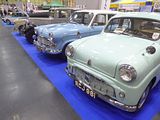

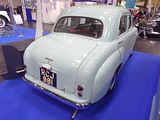


The Vanguard Phase III, released to the market for the mid-October 1955 British International Motor Show, was a radical change with the elimination of the separate chassis. There was an overlap in availability of the old model with the Phase II estate continuing into 1956. UK fuel was no longer restricted to the 72 octane “Pool petrol” of the 1940s and early 1950s, and with the modest increases in available octane levels, the Vanguard’s compression ratio was increased to 7.0:1. The 2,088 cc engine with its single Solex downdraught carburettor now produced 68 bhp. The front suspension was independent, using coil springs, and was bolted to a substantial sub-frame which also carried the recirculating ball steering gear. Semi-elliptic leaf springs were used on the rear axle. Lockheed hydraulic brakes with 9 in (229 mm) drums were fitted front and rear. The three-speed gearbox had a column change and the optional overdrive was operated by a switch on the steering column. A four-speed floor change became an option. The new body was lower and had an increased glass area, making it look much more modern, and the old two-piece flat windscreen gave way to a one-piece curved design. The wheelbase increased by 8 in (203 mm), giving much better passenger accommodation. A heater was now a standard fitting. Bench seats were fitted in front and rear with folding centre arm rests. They were covered in Vynide, with leather available as an option. The car was lighter than the superseded model, and the gearing was changed to deliver better economy with performance virtually unchanged. A car with overdrive was tested by the British magazine The Motor in 1956. It had a top speed of 83.7 mph, could accelerate from 0–60 mph in 21.7 seconds and had a fuel consumption of 25.9 miles per imperial gallon (10.9 L/100 km; 21.6 mpg‑US). The test car cost £998 including taxes. For 1957, the Australian-produced Phase III was given a facelift with a new mesh grille. In addition the sedan now sported fins on the rear guards. A performance model, the Vanguard Sportsman, intended to be badged as the Triumph Renown until shortly before launch, was announced in August 1956 with a tuned 90 bhp engine having similar features to the Triumph TR3 sports car. These included an increased compression ratio to 8.0:1, twin SU carburettors, and improved pistons. However, the Sportsman’s inlet manifold and carburettors sat at a different angle from those of the TR3, and its engine had the same 85 mm bore as the Vanguard’s, not the 83 mm bore of the TR3. The final-drive ratio was lowered to 4.55:1 to give better acceleration, and larger 10 in (254 mm) drums fitted to the brakes. The standard version had a bench front seat but separate seats were an option. Although sharing the same basic body shell with the other Vanguard variations, the Sportsman had design variations, including a squarer front grille, which gave the car a slightly higher, squarer appearance than the regular models. Just 901 examples of the Sportsman model were made up to 1958. Sportsmans then became available to special order, and around another fifty (mostly estate cars) were built between 1958 and 1960. A small number were built before the Vignale makeover in 1958. Popular Classics magazine’s test of a Sportsman in 1994 stated that a total of 962 were built. A Sportsman with overdrive was tested by the British magazine The Motor in 1956 and it recorded a top speed of 90.7 mph (146.0 km/h), acceleration from 0–60 mph in 19.2 seconds and a fuel consumption of 25.6 mpg imperial (11.0 L/100 km; 21.3 mpg‑US). The test car cost £1231 including taxes. A face-lift of the Phase III was designed by Italian stylist Giovanni Michelotti and coach-builders Vignale in 1958, and was introduced at the October 1958 Earls Court Motor Show. The windscreen and rear window were deeper, and there was a revised grill and trim. A floor change four-speed manual gearbox was now fitted, and the provision of a three-speed gear box with column change offered as an option. An overdrive was also offered an option, as was an automatic. One automatic car is known to have survived – there may be others. The car had front and rear bench seats, which were covered, as standard, in Vynide. Leather was an option on the home market and cloth for exported models. A heater and (unusual for the time) electric windscreen washers were factory fitted, although a radio remained an option. The car was replaced by the Triumph 2000 in late 1963.
In 1958 Standard presented the Atlas, their contender in the growing but (in Britain) increasingly crowded small van sector. It was a competitor for BMCs venerable J-Type and the much more modern Morris J2, as well as for the Ford Thames 400E and the market leading Bedford CA. For some export markets, notably Canada and the U.S. the Standard Atlas was badged as a Triumph, reflecting the value of the brand recognition achieved for the Triumph by their sedans and sports models. Light vans in Britain were at this time frequently identified by their maximum permissible gross payload, and the Atlas was often advertised simply as the Atlas 10 cwt or the Atlas 12 cwt, reflecting allowable load weights (including a driver) of 500 kg and 600 kg. In addition to the panel van, a pick up truck version was also offered. Both hinged doors and sliding doors were offered as was a middle side door. There was also a small flatbed truck version which had rear hinged doors. Like its competitors, the Atlas shared its engine with a passenger car from its manufacturer’s range. In this case the engine in question was firstly the 948 cc petrol engine from the Standard Ten, which was installed under a cowling between the driver and passenger, and delivered power to the rear wheels. In this form the van was very slow. That was addressed in 1961 when it became possible to specify the van with a 1,670 cc petrol. The larger dimensions of this engine meant that the chassis had to be enlarged and the cabin design rearranged. At the same time the smaller engine was enlarged to 1,147 cc. When the Standard Company was blended with British Leyland in 1964/5 the Atlas vans were then badged as Leyland 15 and Leyland 20, and were now provided with the Standard 2,138 cc petrol engine that also powered the Triumph TR4. Payload limits had also been raised to 15 cwt (750 kg gross) and 20 cwt (1000 kg gross). It was now also possible to order the van with a diesel engine. The unit in question was a 2,260 cc 60 bhp unit from Massey Ferguson who also installed it in tractors. In 1963 Standard was acquired by Leyland Motors Limited and for 1964, the van was renamed Leyland 15 / Leyland 20 (according to capacity). In 1968, Leyland merged with the British Motor Corporation to form the British Leyland Motor Corporation, and the van was taken out of production in order to avoid direct competition with a range of vans such as the Morris JU 250, now produced by the same company.
SUBARU
Another of the cars that was being displayed by Richard Hammond was this second generation Subaru Impreza, which his many fans would instantly recognise from its tv appearance.
SUNBEAM
The Sunbeam-Talbot Ten is a compact executive car or small sports saloon manufactured by Rootes Group in their Clément-Talbot factory in North Kensington between 1938 and 1939, and then reintroduced after the Second World War and sold between 1945 and 1948. It was at first a two-door then a four-door sports saloon. A drophead coupé version and a sports tourer version were also available. The Clément-Talbot and then the Sunbeam Motor Car Company businesses fell into the hands of Rootes in 1935, and the new owner’s strategy was clearly to use the prestige of the Talbot name for selling larger numbers of lower priced cars than hitherto. This Rootes’ Talbot Ten was one of the first products of the Rootes strategy intended to open Talbot’s planned shift down-market and add a genuinely small car to the proposed range. A star of the 1936 Motor Show it was a lengthened Hillman Aero Minx with a stronger chassis all updated at short notice by Talbot’s Georges Roesch and rebadged and so another variant of the existing middle market saloon, the Hillman Minx. Reviewers described the car as an attractive refined and well-equipped small car. The pillarless two-door saloon body made at the Darracq Motor Engineering Company works in Acton was probably shaped by Rootes’ Ted White, manager of Rootes’ body engineering department. The open tourer was made by Whittingham & Mitchel and the drophead coupé with an intermediate coupé de ville position was made by Abbott of Farnham. The Talbot Ten was rebadged Sunbeam-Talbot Ten in August 1938. Rootes had decided to make no large luxury car using the Sunbeam name but keep the name alive by linking it with Talbot. Although apparently just a rebadged four door version of the Talbot Ten the new Sunbeam-Talbot Ten was given a whole new all-steel body with four doors. Changes included pressed steel wheels but covered by wheel discs, a normal lever for the gear changes, better instruments, and slightly reshaped front mudguards. Synchromesh was dropped from first gear and then later from second gear. The new body was on effectively the same chassis but the engine and the radiator were moved 3.5 inches forward. This body was again made in Acton but by British Light Steel Pressings in their Works next door. Cars exported to Europe were badged Sunbeam. The car was undoubtedly the most elegant small saloon of the period. The classic saloon featured the streamlining increasingly characteristic of mainstream British cars in the later 1930s, along with “stand-alone” headlights. Power came from a 1185 cc side-valve engine for which 41 bhp of power output was claimed. All four wheels were suspended using semi elliptical leaf springs. Top speed was quoted as 68 mph (109 km/h). In 1948 the Sunbeam-Talbot Ten was almost exactly twice the price of the new Austin A40 Devon and slightly slower on the highway. Visually the faster Sunbeam-Talbot 2 Litre was virtually indistinguishable from the Ten, but it was actually about 3 inches (7.6 cm) longer in wheel-base and overall body length.
There was an example of the Alpine Harrington here. These were Coupe versions of the Alpine, much like the later MGB GT in concept, which were built by Thomas Harrington Ltd. After the Le Mans Index of Efficiency success of 1961, Harrington sold replicas as the “Harrington Le Mans”, using a fastback body and an engine tuned to 104 hp. Unlike the Le Mans racers, these cars had a more integrated rear roofline and were without the tail fins of the roadsters. Until 1962 the car was assembled for Rootes by Armstrong Siddeley. Over 400 of them were produced, based on the Series II, III and IV.
TOYOTA
The Corona Mark II, first offered for sale in Japan, September 1968, at Toyopet Store dealerships, was intended as an alternative model to the more established luxury sedan, the Crown, sold at Toyota Store dealerships, and the smaller Corona, also available at Toyopet Stores. It was a slightly larger vehicle than the Corona with a higher level of equipment offered at the time, sharing some of the features of the larger Crown, but taking the top position at Toyopet Store locations. At its introduction, the Mark II was third in Toyota’s hierarchy of sedans, below the Crown and the all new, hand built, V8-engined limousine called the Toyota Century. The four-door sedan was designated the T60, and the two-door coupé the T70. In 1970 there were minor cosmetic changes to the front grille. The 1600 cc 7R series engine was replaced by the 1,700 cc 6R series engine. A year later the 1500 cc 2R models were replaced by the 1600 cc 12R engines. Its competitor was primarily the Nissan Laurel in Japan, released earlier that year in April. In Japan, several trim packages were offered, paired with multiple engine displacements due to Japan’s annual road tax obligation. The gradually larger engines obligated Japanese buyers to pay more tax, and equipment levels were gradually increased to justify the expense. The US exported versions arrived for the 1969 model year and often include the more powerful R series motors compared to other regions. Before its US introduction, it appeared in South Africa, which was the first market to receive the 1900 cc engine. While Japan and other markets often had 1.5-litre 2R, 1.6-litre 7R/12R to 1.7-litre 6R models as well. Engines were shared with the Corona, with both using the 2R, and the 12R engine. Transmissions offered were an automatic transmission with three speeds for export and two speeds in Japan, or a choice of either a four- or three-speed manual transmission. The RT62 sedans and the RT72 coupé feature the 1.9-litre 8R four-cylinder engine, unique to the Mark II. The RT63 sedan, RT73 coupé, and RT78/RT79 station wagons feature a two-litre 18R four-cylinder engine, also unique to the Mark II. The suspension setup uses double wishbone with coil springs at the front and leaf springs at the back with a front-engine, rear-drive powertrain format. The Mark II is longer, at 4,295 mm (169.1 in) over the Corona’s length of 162.4 in (4,125 mm) for the sedan, and the coupe, with a width of 1,610 mm (63.4 in) in comparison to 61 in (1,549 mm) for the sedan and coupe. The height of the Mark II is lower at 1,405 mm (55.3 in) over 1,420 mm (55.9 in) for the sedan, but higher at 1,374 mm (54.1 in) for the coupé. For North America, the Mark II was available with bucket seats for the driver and front passenger, a center console with a floor-mounted manual transmission, electric rear window defroster, and a full size spare tire installed externally and underneath the cargo area on the wagon, with rear seats that fold down to a fully carpeted rear cargo area. The Mark II wagon was the largest wagon Toyota offered in North America, next to the Corona and Corolla wagons; the Crown wagon was no longer sold in North America.
Displayed at the October 1970 Tokyo Motor Show and marketed from December of the same year, the Celica was a two-door hardtop coupe that emphasised styling and driving enjoyment based on a platform shared with the Toyota Carina sedan which is one size above the Toyota Corolla. This car was aimed at the North American market and was Toyota’s response to the 1964 Ford Mustang (Pony car) which also was a standard sedan (Ford Falcon) with stylised 2+2 bodywork. In Europe, where it arrived in 1971, it was aimed at the successful Ford Capri. For export markets the Celica was available in three different levels of trim; LT, ST, GT, all with the same 1.6 litre 4 cylinder engine, though the LT had a single carburettor and the ST and GT had twin carbs. At its introduction the Celica was only available as a pillarless hardtop notchback coupe, adopting “coke bottle styling”. The prototype SV-1 liftback was shown as a concept car at the 1971 Tokyo Motor Show & with slight modifications this was introduced in Japan in April 1973 and this arrived in Europe in 1974. Minor styling changes were made during the car’s life before it was replaced by a second generation car in late 1977.
The MR2 derived from a 1976 Toyota design project with the goal of a car which would be enjoyable to drive, yet still provide good fuel economy – not necessarily a sports car. Design work began in 1979 when Akio Yoshida from Toyota’s testing department started to evaluate alternatives for engine placement and drive method, finalising a mid-transverse engine placement. Toyota called the 1981 prototype SA-X. From its original design, the car evolved into a sports car, and further prototypes were tested both in Japan and in the US. Significant testing was performed on race circuits including Willow Springs, where former Formula One driver Dan Gurney tested the car. All three generations were in compliance with Japanese government regulations concerning exterior dimensions and engine displacement. The MR2 appeared around the same time as the Honda CR-X, the Nissan EXA, the VW Scirocco from Europe, and the Pontiac Fiero and Ford EXP from North America. Toyota debuted its SV-3 concept car in October 1983 at the Tokyo Motor Show, gathering press and audience publicity. The car was scheduled for a Japanese launch in the second quarter of 1984 under the name MR2. Toyota introduced the first-generation MR2 in 1984, designating it the model code “W10”. When fitted with the 1.5-litre 3A engine, it was known as the “AW10”. Likewise, the 1.6-litre 4A version is identified by the “AW11” code. The MR2’s suspension and handling were designed by Toyota with the help of Lotus engineer Roger Becker. Toyota’s cooperation with Lotus during the prototype phase can be seen in the AW11, and it owes much to Lotus’s sports cars of the 1960s and 1970s. Toyota’s active suspension technology, called TEMS, was not installed. With five structural bulkheads, the MR2 was quite heavy for a two-seater of its size. Toyota employed the naturally aspirated 4A-GE 1,587 cc inline-four engine, a DOHC four-valve-per-cylinder motor, borrowed from the E80 series Corolla. This engine was also equipped with Denso electronic port fuel injection and T-VIS variable intake geometry, giving the engine a maximum power output of 112 hp in the US, 128 hp in the UK, 116 or 124 PS (114 or 122 hp) in Europe (with or without catalytic converter), 118 hp in Australia and 130 PS (128 hp) in Japan. Japanese models were later detuned to 120 PS (118 hp). A five-speed manual transmission was standard, with a four-speed automatic available as an option. In 1986 (1988 for the US market), Toyota introduced a supercharged engine for the MR2. Based on the same block and head, the 4A-GZE was equipped with a small Roots-type supercharger and a Denso intercooler. T-VIS was eliminated and the compression ratio was lowered to 8:1. It produced 145 hp at 6,400 rpm and 186 Nm (137 lb/ft) of torque at 4,400 rpm and accelerated the car from 0 to 100 km/h (62 mph) in 6.5 to 7.0 seconds. The supercharger was belt-driven but actuated by an electromagnetic clutch, so that it would not be driven except when needed, increasing fuel economy. Curb weight increased to as much as 2,494 lb (1,131 kg) for supercharged models, due to the weight of the supercharger equipment and a new, stronger transmission. A fuel selector switch was also added in some markets, to allow the car to run on regular unleaded fuel if required to. In addition to the new engine, the MR2 SC was also equipped with stiffer springs, and received special “tear-drop” aluminium wheels. The engine cover had two raised vents (only one of which was functional) that visually distinguished it from the naturally aspirated models. It was also labelled “SUPER CHARGER” on the rear trunk and body mouldings behind both doors. This model was never offered outside of the Japanese and North American markets, although some cars were privately imported to other countries. Toyota made detailed changes to the car every year until replacing it with a second generation model in 1989.
The Corolla E90, introduced in 1987 for the 1988 model year, was the sixth generation of cars sold by Toyota under the Corolla nameplate. It was the last generation of Corolla to be classified as a subcompact car and the first to be exclusively front-wheel drive or all-wheel drive; the performance option of rear-wheel drive was dropped. The European model Corolla featured either a four-door sedan and a three- or five-door hatchback, and the regular wagon basically has the front end of the Japan-spec Corolla FX, except for the all white clearance lights and the “TOYOTA” or the ellipse emblem instead of the “FX” or “GT” of the Japanese models. It has the standard side marker lights and the tail light with the integrated rear fog lamp (except for the wagon, which has the rear fog lamp on the tailgate.) European market Corollas also have headlight washers on the XL and the XLi models. The five-door liftback used the Japanese market Sprinter Cielo body in its entirety, although in Europe it was available with the little 1.3 litre engine as well. From August 1989 there was also a fuel-injected and catalyzed version of the 1.3-litre engine available to some European markets. Power outputs were increased across the range at this time, part of a light mid-life makeover. The second generation Sprinter Carib was also sold as a Corolla in Europe, where it replaced the Tercel Wagon. This little four-wheel drive station wagon received the “Touring” suffix in most European markets. The hatchback, representing the most popular and most closely contested market segment in Europe, suffered from being somewhat of a design afterthought since sedans have always been the mainstay of the Corolla lineup in the home market. As opposed to its European competitors, where hatchbacks received a tacked-on trunk to become sedans (the Ford Orion, the Volkswagen Jetta, or the Opel Kadett sedan/Vauxhall Belmont), Toyota started with the sedan and derived the hatchback from it. As a result, the design was a bit truncated and trunk space was minimal at 281 L (9.9 cu ft). This was only a fraction more than the much smaller Citroën AX, and considerably less than for competitors such as the Kadett and Fiat Tipo (390 and 345 L; 13.8 and 12.2 cu ft). The diesel version saw substantial sales in countries such as Belgium and Netherlands, where the tax structure favoured diesels but where there were also no laws hindering the sales of Japanese cars. In Europe it was only sold with the comparatively spartan XL equipment level. The diesel, while quite slow and with heavy steering, was competitive with similar European cars of the period. The power of the diesel increased by three horsepower in the late summer of 1989. From late 1989 the 4A-GE engine in the GTi model was changed from the T-VIS equipped ‘big port’ variant to the non-T-VIS ‘small port’ version. For UK specification cars (without catalytic converters), this increased power from 124 to 129 bhp. The GTi was available as a hatchback or a liftback, although not all markets received both bodystyles. The catalyzed version, which gradually became the default option across Western Europe, produces 116 PS (114 bhp) at 6,600 rpm. In Sweden, the 4A-GE equipped liftback was marketed as the Corolla CS (Coupé Sport), beginning in May 1991. It had the new 125 PS version of the 4A-GE engine and ventilated disc brakes all around. A new generation car arrive in late 1991.
This is from the fifth generation of the Celica, which was introduced in September 1989. The Celica received new Super Round organic styling, upgraded wheels and tyres, more powerful GT-Four (All-Trac Turbo in the US) with better cooling system, and for the Japanese market only, the four-wheel steering (4WS) models. Toyota engineers claimed that the round styling and lack of straight edges increased strength without adding weight. The styling was later copied by other manufacturers. Japanese market models were now S-R, Z-R, GT-R, Active Sports (first Toyota with Toyota Active Control Suspension), and GT-Four. The S-R and Z-R were powered by a 3S-FE engine, while the GT-R and Active Sports came with a 3S-GE. The 3S-GTE in the GT-Four features an air-to-air intercooler and CT26 twin entry turbo to eliminate exhaust gas interference. The Japanese market GT-Four has (221 bhp and 304 N⋅m (224 lb⋅ft) of torque, a result of more aggressive ignition advance and ceramic turbine. The Full-time 4WD system in the GT-Four has viscous coupling limited slip centre differential and Torsen rear differential. Trim levels for the European Celica were 1.6 ST-i, 2.0 GT-i 16, and GT-Four. The 2.0 GT-i 16 cabriolet was offered only in certain European countries. Only the 2.0 GT-i 16 liftback and GT-Four were officially sold in the UK. The model was superceded by a sixth generation car in 1993.
In October 1993, Toyota launched the sixth-generation Celica. The styling of the new model was acclaimed by most publications as “Supra-esque” with four round headlights and also had a visual resemblance to the Soarer introduced in 1991. Celicas were available in either notchback coupe or liftback form, the convertible would come later. New safety equipment in the form of driver (and then later passenger) airbags were standard in most markets, and anti-lock brakes were available on all models. Many Celicas also sported CFC-free air conditioning. Engine choices and model trims varied by market. The UK received ST and GT models initially, with the 3 door liftback being the only bodystyle offered. It was not long before the GT-Four version joined the range. This ST205 version was to be the most powerful Celica produced to date, producing 239 bhp in export guise from an updated 3S-GTE engine. Influenced strongly by Toyota Team Europe, Toyota’s factory team in the World Rally Championship, the final version of the GT-Four included improvements such as an all-aluminium bonnet to save weight, four-channel ABS (with G-force sensor), an improved turbocharger (incorrectly known by enthusiasts as the CT20B), and Super Strut Suspension. The 2500 homologation cars built to allow Toyota to enter the GT-Four as a Group A car in the World Rally Championship also sported extras such as all of the plumbing required to activate an anti-lag system, a water spray bar for the intercooler’s front heat exchanger, a water injection system for detonation protection, a hood spoiler mounted in front of the windscreen to stop hood flex at high speed and the standard rear spoiler mounted on riser blocks. The car proved to be quite competitive in the 1995 World Championship. However, the team was banned from competition for a year after the car’s single victory due to turbocharger fixing – a device that meant there was no air path restriction on the intake – when the jubilee clip was undone this would flick back into place so as to go un-noticed by inspectors. Toyota has always claimed that they knew nothing of the fix – but opponents say it was one very cleverly engineered device. In some respects this car is a true sports car; in order to qualify for rallying it has a lot of special features and a unique strut arrangement. The fourth-generation convertible was introduced in 1994. Built off of the GT coupe, the conversion took place in the ASC facility in Rancho Dominguez, California. The vehicle arrived in the US as a partially assembled vehicle. At ASC, the roof was removed and a three-layer insulated and power-operated top was installed, producing a vehicle that was virtually water and windproof. In August 1995, minor changes were given to all Japanese market Celica Liftback models, and the SS-III was added into the line up. All models received new rear combination lamps, and if fitted, the new style rear spoiler. The front drive models received new a front bumper design. The SS-III came with standard Super Strut Suspension and side aerodynamic rocker panels. The GT-Four also got side rocker panels, restyled rear spoiler, and new alloys. In January 1996, facelift was given to the Japanese market Celica convertible. The 1996 Celica for export market received the same front restyling as the Japanese models, although the tail lights were untouched. The new front bumper has two smaller sections on each side of a smaller air dam as opposed to a single large air dam in previous models. Also new were optional side skirts to improve its aerodynamic efficiency, as well as a redesigned rear spoiler. The North American GT and Australian ZR models came with standard fog lights, and the ST and SX models without the optional fog lights had black grills fill in their place. To celebrate 25 years of Celica, the SS-I and SS-III Special Edition were released in Japan, and the 25th Anniversary ST Limited and GT convertible marked this occasion in the US. These Special Edition models have special emblems on the front fenders, and the inside on the rear view mirror hanger, and the name Celica was printed on the front seats as well. For 1997, the only change in the North American Celica was the discontinuation of the GT coupe. Another minor change was given to Japanese market Celicas in December 1997. Projector headlights were optional for all models. The 3S-GE engine on the SS-II and SS-III received VVT-i, the SS-III was given a BEAMS tuned 3S-GE engine. WRC style high rear spoiler returned on the GT-Four and also standard on the SS-III. In 1998, the underpowered ST model was discontinued in the US, leaving only GT models. In addition, the GT notchback coupe returned after a year’s absence. In the UK, Toyota released the SR based on the 1.8 ST. The SR has full body kit, mesh grille, 16-inch alloys, and upgraded sound system. The US Celica line up was simplified even further in 1999 by eliminating all coupes, leaving only the GT liftback and GT convertible. The GT-Four was still offered in Japan. Also in early 1999, Toyota released pictures of their XYR concept car, which would soon become the next Celica, launched later that year.
TRIUMPH
Having started off producing smaller models such as the SuperSeven to compete against the market dominating Austin and Morris models, by the early 1930s, Triumph came to the conclusion that they could not really compete against these bigger selling cars, so a new strategy was conceived to offer larger and more costly cars instead. The result was the Gloria, made between 1934 and 1938. The Gloria was available in a large and complex range of sporting saloons, coupés, tourers, 2-seater sports cars, drophead coupés and golfer’s coupés. All these Glorias, apart from the final two models (1.5-Litre Saloon and Fourteen (1767 cc) Six-Light Saloon of 1937-1938) were powered by 1087 or 1232 cc four-cylinder or 1467 or 1991 cc six-cylinder Coventry Climax overhead inlet and side exhaust valve designed engines (modified and built under licence by Triumph). The chassis came in two lengths, with an extra 8 in ahead of the passenger compartment depending on whether the four- or six-cylinder engine was fitted, and had conventional non-independent suspension with semi elliptic leaf springs. The brakes were hydraulically operated using the Lockheed system with large 12 in drums. A four-speed transmission was fitted with an optional free wheel mechanism allowing “clutchless” gear changing. Synchromesh was fitted to the gearbox on the final Fourteen and 1.5-litre models. From August 1934 to 1936 the Gloria range included ‘Gloria Vitesse’ models (not to be confused with later Vitesses) which were up-rated, with twin carburettor engine and equipment, versions of the equivalent Gloria and slightly different bodywork in the case of some saloons.
The Dolomite name first appeared in 1934 as a sports car and the name was then used from 1937 on a series of sporting saloons and open cars until 1939 when the company went into receivership. All except the Straight 8 featured a “waterfall” grille styled by Walter Belgrove, versions of the saloons with conventional grilles were sold as Continental models. With the 1937 car, the car this time had a 1,767 cc four-cylinder engine and saloon body. The design was overseen by Donald Healey and the cars were marketed as “the finest in all the land” and targeted directly at the luxury sporting saloon market. Triumph had been moving progressively upmarket during the 1930s, and the 1938 Dolomites were very well equipped, with winding windows in the doors, automatic chassis lubrication, a leather-bound steering wheel adjustable for rake and reach, dual hydraulic brake circuits, twin trumpet horns, and spot lamps included in the price. There was even a tray of fitted tools slotted beneath the driver’s seat cushion, and for an extra 18 guineas buyers could specify a radio. The body was aluminium over a rot-proofed ash frame. Like many Triumphs of that time, the car followed the American trend of concealing its radiator behind a flamboyant shining metal grille. The British market, then as now, was in many ways a conservative one, however, and, before Dolomite production was suspended completely, Triumph had time to introduce a “Vitesse”-branded version of the Dolomite on which the grille had been removed and the car’s own radiator was exposed in the traditional manner. In April 1938 an increased compression ratio and mild further engine tuning justified a changed designation from 14/60 to 14/65 (where 14 was the fiscal horsepower and 65 was the claimed actual horsepower. There was an open version of the 14/65, announced 29 March 1938, with seating for three people on a single bench seat and “two additional outside seats in the tail, reminiscent of the dickey seat that was at one time common” for two more people behind. The hood folded completely into the body to give the appearance of an open sports car. The car was announced with the 1,767 cc engine with twin SU carburettors, and it is this version which is seen more often these days, and indeed was the car here.
The 1800 Roadster, model number 18TR, was designed in the closing days of World War II. Triumph had been bought by the Standard Motor Company in 1944, and the managing director of Standard, Sir John Black, wanted a sports car to take on Jaguar, who had used Standard engines in the pre-war period. Frank Callaby was selected to style the new car. After getting Black’s approval for the general shape, Callaby worked with Arthur Ballard to design the details of the body. Design of the rolling chassis was by Ray Turner. Walter Belgrove, who had styled the pre-war Triumphs and was employed as Chief Body Engineer, had no part in the design. Early post-war steel shortages meant that the body was built from aluminium, using rubber press tools that had been used making panels for the largely wooden bodied Mosquito bomber that had been built by Standard during the war. The frame was hand welded up from steel tube. The engine was a version of Standard’s 1.5-litre, four-cylinder side-valve design that had been converted to overhead valves by Harry Weslake and built by Standard exclusively for SS-Jaguar before World War II. The Triumph version differed from the Jaguar version in having a 6.7:1 compression ratio instead of the Jaguar’s 7.6:1 and a downdraught Solex carburettor instead of the Jaguar’s side-draught SU. A four-speed gearbox with synchromesh on the top three ratios was used. The tubular steel chassis was a short-wheelbase version of the 1800 saloon, featuring transverse leaf sprung independent suspension at the front and a live axle with semi-elliptic springs at the rear. The rear track was wider than the front by some 4 inches. Brakes were hydraulic. The body design was anachronistic. A journalist old enough to remember the pre-war Dolomite Roadster that had inspired the car felt that the elegant proportions of the earlier model had been abandoned in favour of a committee-based compromise, “a plump Christmas turkey to set against that dainty peacock … [more] Toadster [than Roadster]”. The front had large separate headlamps and the radiator was well back from the front between large “coal scuttle” wings. Passenger accommodation was on a bench seat that was claimed to seat three: the car’s 64 inch width helped make a reality of the three-abreast seating, and the approach meant a column gear change was required. The car’s unusual width also made it necessary to fit three screen wipers in a row, an example followed by early shallow windscreen Jaguar E Types. Additional room for two was provided at the rear in a dickey seat with its own folding windscreen: this was outside the hood that could be erected to cover the front seat. Entry and exit to the dickey seat was never easy and a step was provided on the rear bumper. The Roadster was the last production car with a dickey seat. The actor, John Nettles, drove a red 1947 Triumph Roadster 1800 in the 1980s television series, Bergerac. Two cars were actually used over the duration of the series production. This was made evident by the colour difference of the front mudguards and body without hood ornament on one car used in the earlier series and the same colour front mudguards and body with the hood ornament on the other car used in later series. The same number plate J 1610 was used on both cars in the series. In some episodes both cars appeared purporting to be the same car. The only significant update in the Roadster’s production came in September 1948 for the 1949 models, when the 2088 cc Vanguard engine, transmission, and rear axle were fitted. A retrograde step was the fitting of a three-speed gearbox even though it now had synchromesh on bottom gear. Apart from minor modifications to the mounting points, the chassis, suspension and steering were unaltered. This later version of the Roadster was given the model designation TRA. The car was never made in large numbers and was mainly hand built. 2501 examples of the 1800 and 2000 of the larger-engined version were made. Production ended in October 1949.
Oldest of a series of TR sports cars here was one of the first models, the TR2, a model produced between 1953 and 1955, during which time 8,636 cars were produced. Standard’s Triumph Roadster was out-dated and under-powered. Company boss Sir John Black tried to acquire the Morgan Motor Company but failed. He still wanted an affordable sports car, so a prototype two-seater was built on a shortened version of the Standard Eight’s chassis and powered by the Standard Vanguard’s 2-litre straight-4. The resulting Triumph 20TS prototype was revealed at the 1952 London Motor Show. Black asked BRM development engineer and test driver Ken Richardson to assess the 20TS. After he declared it to be a “death trap” a project was undertaken to improve on the design; a year later the TR2 was revealed. It had better looks; a simple ladder-type chassis; a longer body; and a bigger boot. It was loved by American buyers, and became the best earner for Triumph. In 1955 the TR3 came out with more power; a re-designed grille; and a GT package that included a factory hard-top. The car used a twin H4 type SU carburettor version of the 1991 cc four-cylinder Standard wet liner inline-four engine from the Vanguard, tuned to increase its output to 90 bhp. The body was mounted on a substantial separate chassis with coil-sprung independent suspension at the front and a leaf spring live axle at the rear. Either wire or disc wheels could be supplied. The standard transmission was a four-speed manual unit, with overdrive available on top gear as an option. Lockheed drum brakes were fitted all round. The car was replaced by the similar looking TR3 in 1955.
Launched in 1955, the TR3 was an evolution of the TR2 and not a brand new model. It was powered by a 1991 cc straight-4 OHV engine initially producing 95 bhp, an increase of 5 hp over the TR2 thanks to the larger SU-H6 carburettors fitted. This was later increased to 100 bhp at 5000 rpm by the addition of a “high port” cylinder head and enlarged manifold. The four-speed manual gearbox could be supplemented by an overdrive unit on the top three ratios, electrically operated and controlled by a switch on the dashboard. In 1956 the front brakes were changed from drums to discs, the TR3 thus becoming the first British series production car to be so fitted. The TR3 was updated in 1957, with various changes of which the full width radiator grille is the easiest recognition point and the facelifted model is commonly referred to as the Triumph “TR3A”, though unlike the later TR4 series, where the “A” suffix was adopted, the cars were not badged as such and the “TR3A” name was not used officially, Other updates included exterior door handles, a lockable boot handle and the car came with a full tool kit as standard (this was an option on the TR3). The total production run of the “TR3A” was 58,236. This makes it the third best-selling TR after the TR6 and TR7. The TR3A was so successful that the original panel moulds eventually wore out and had to be replaced. In 1959 a slightly modified version came out that had raised stampings under the bonnet and boot hinges and under the door handles, as well as a redesigned rear floor section. In addition, the windscreen was attached with bolts rather than the Dzus connectors used on the early “A” models. Partly because it was produced for less time, the original TR3 sold 13,377 examples, of which 1286 were sold within the UK; the rest being exported mainly to the USA.
Successor to the TR3a, and code named “Zest” during development, the TR4 was based on the chassis and drivetrain of the previous TR sports cars, but with a modern Michelotti styled body. The TR 4 engine was carried over from the earlier TR2/3 models, but the displacement was increased from 1991cc to 2138 cc by increasing the bore size. Gradual improvements in the manifolds and cylinder head allowed for some improvements culminating in the TR4A model. The 1991 cc engine became a no-cost option for those cars destined to race in the under-two-litre classes of the day. Some cars were fitted with vane-type superchargers, as the three main bearing engine was liable to crankshaft failure if revved beyond 6,500 rpm; superchargers allowed a TR4 to produce much more horse-power and torque at relatively modest revolutions. The standard engine produced 105 bhp but, supercharged and otherwise performance-tuned, a 2.2-litre I4 version could produce in excess of 200 bhp at the flywheel. The TR4, in common with its predecessors, was fitted with a wet-sleeve engine, so that for competition use the engine’s cubic capacity could be changed by swapping the cylinder liners and pistons, allowing a competitor to race under different capacity rules (i.e. below or above 2 litres for example). Other key improvements over the TR3 included a wider track front and rear, slightly larger standard engine displacement, full synchromesh on all forward gears, and rack and pinion steering. In addition, the optional Laycock de Normanville electrically operated overdrive Laycock Overdrive could now be selected for 2nd and 3rd gear as well as 4th, effectively providing the TR4 with a seven-speed manual close ratio gearbox. The TR4 was originally fitted with 15×4.5″ disc wheels. Optional 48-lace wire wheels could be ordered painted the same colour as the car’s bodywork (rare), stove-enamelled (matte silver with chrome spinners, most common) or in matte or polished chrome finishes (originally rare, but now more commonly fitted). The most typical tyre originally fitted was 590-15 bias ply or optional radial tires. In the US at one point, American Racing alloy (magnesium and aluminium) wheels were offered as an option, in 15×5.5″ or 15×6″ size. Tyres were a problem for original owners who opted for 60-spoke wire wheels, as the correct size radial-ply tyre for the factory rims was 155-15, an odd-sized tyre at the time only available from Michelin at considerable expense. Some original TR4 sales literature says the original radial size was 165-15. The much more common 185-15 radials were too wide to be fitted safely. As a result, many owners had new and wider rims fitted and their wheels re-laced. The new TR4 body style did away with the classical cutaway door design of the previous TRs to allow for wind-down windows (in place of less convenient side-curtains), and the angular rear allowed a boot with considerable capacity for a sports car. Advanced features included the use of adjustable fascia ventilation, and the option of a unique hard top that consisted of a fixed glass rear window (called a backlight) with an integral rollbar and a detachable, steel centre panel (aluminium for the first 500 units). This was the first such roof system on a production car and preceded by 5 years the Porsche 911/912 Targa, which has since become a generic name for this style of top. On the TR4 the rigid roof panel was replaceable with an easily folded and stowed vinyl insert and supporting frame called a Surrey Top. The entire hard top assembly is often mistakenly referred to as a Surrey Top. In original factory parts catalogues the rigid top and backlight assembly is listed as the Hard Top kit. The vinyl insert and frame are offered separately as a Surrey Top. Features such as wind-down windows were seen as a necessary step forward to meet competition and achieve good sales in the important US market, where the vast majority of TR4s were eventually sold. Dealers had concerns that buyers might not fully appreciate the new amenities, therefore a special short run of TR3As (commonly called TR3Bs) was produced in 1961 and ’62. The TR4 proved very successful and continued the rugged, “hairy-chested” image that the previous TRs had enjoyed. 40,253 cars were built during production years. Most were sold new to the US, but plenty have returned, and it is estimated that there are not far short of 900 examples of the model in the UK at present.
There were several of the successor to that car here, the TR6, the first Triumph for some time not to have been styled by Michelotti. By the mid 1960s, money was tight, so when it came to replacing the TR4 and TR5 models, Triumph were forced into trying to minimise the costs of the redesign, which meant that they kept the central section of the old car, but came up with new bodywork with the front and back ends were squared off, reportedly based on a consultancy contract involving Karmann. The resulting design, which did look modern when it was unveiled in January 1969 has what is referred to as a Kamm tail, which was very common during 1970s era of cars and a feature on most Triumphs of the era. All TR6 models featured inline six-cylinder engines. For the US market the engine was carburetted, as had been the case for the US-only TR250 engine. Like the TR5, the TR6 was fuel-injected for other world markets including the United Kingdom, hence the TR6PI (petrol-injection) designation. The Lucas mechanical fuel injection system helped the home-market TR6 produce 150 bhp at model introduction. Later, the non-US TR6 variant was detuned to 125 bhp for it to be easier to drive, while the US variant continued to be carburetted with a mere 104 hp. Sadly, the Lucas injection system proved somewhat troublesome, somewhat denting the appeal of the car. The TR6 featured a four-speed manual transmission. An optional overdrive unit was a desirable feature because it gave drivers close gearing for aggressive driving with an electrically switched overdrive which could operate on second, third, and fourth gears on early models and third and fourth on later models because of constant gearbox failures in second at high revs. Both provided “long legs” for open motorways. TR6 also featured semi-trailing arm independent rear suspension, rack and pinion steering, 15-inch wheels and tyres, pile carpet on floors and trunk/boot, bucket seats, and a full complement of instrumentation. Braking was accomplished by disc brakes at the front and drum brakes at the rear. A factory steel hardtop was optional, requiring two people to fit it. TR6 construction was fundamentally old-fashioned: the body was bolted onto a frame instead of the two being integrated into a unibody structure; the TR6 dashboard was wooden (plywood with veneer). Other factory options included a rear anti-roll bar and a limited-slip differential. Some say that the car is one of Leyland’s best achievements, but a number of issues were present and remain because of poor design. As well as the fuel injection problems, other issues include a low level radiator top-up bottle and a poor hand-brake. As is the case with other cars of the era, the TR6 can suffer from rust issues, although surviving examples tend to be well-cared for. The TR6 can be prone to overheating. Many owners fit an aftermarket electric radiator fan to supplement or replace the original engine-driven fan. Also the Leyland factory option of an oil cooler existed. Despite the reliability woes, the car proved popular, selling in greater quantity than any previous TR, with 94,619 of them produced before production ended in mid 1976. Of these, 86,249 were exported and only 8,370 were sold in the UK. A significant number have since been re-imported, as there are nearly 3000 of these much loved classics on the road and a further 1300 on SORN, helped by the fact that parts and services to support ownership of a TR6 are readily available and a number of classic car owners’ clubs cater for the model.
What turned out to be the final TR model was launched in January 1975, and this time it really was all new. A dramatic Harris Mann wedge shaped was shock enough for the purists, but the fact that at launch it only came as a Fixed Head Coupe was almost too much for some to bear. In the end, though. more TR7s were sold than any other TR model, so it really cannot have been all that bad even if the car had a somewhat bumpy existence, moving production plant from Speke, Liverpool where the early cars were made, to Canley, Coventry in 1978 and then finally to the Rover Solihull plant in 1980. An open topped model did join the range in 1980 and small numbers of factory built TR8s with the 135 bhp Rover V8 engine under the bonnet were made, but the proposed 2+2 Lynx model, and a version with the 16 valve Dolomite Sprint engine and the 2 litre O Series unit never made production. The car was launched in the United States in January 1975, with its UK home market debut in May 1976. The UK launch was delayed at least twice because of high demand for the vehicle in the US, with final sales of new TR7s continuing into 1982. The TR7 was characterised by its “wedge” shape, which was commonly advertised as: “The Shape of Things to Come”, and by a swage line sweeping down from the rear wing to just behind the front wheel. It had an overall length of 160 inches, width of 66 inches, wheelbase of 85 inches and height of 49.5 inches, and a kerbside weight of 2205 pounds, exactly 1000 kg. During development, the TR7 was referred to by the code name “Bullet”.The original full size model wore MG logos because it was styled at Longbridge, which was not a Triumph factory. Power was provided by a 105 bhp 1,998 cc eight-valve four-cylinder engine that shared the same basic design as the Triumph Dolomite Sprint engine, mounted in-line at the front of the car. Drive was to the rear wheels via a four-speed gearbox initially with optional five-speed manual gearbox, or three-speed automatic from 1976. The front independent suspension used coil spring and damper struts and lower single link at the front, and at the rear was a four-link system, again with coil springs. There were front and rear anti roll bars, with disc brakes at the front and drums at the rear. The interior trim was revised in March 1977, with the broadcord seat covers being replaced with red or green “tartan” check inserts with black leather effect vinyl edging, which looks so very period. now The tartan trim was also reflected in the door cards in padded matching red or green tartan cloth inserts in the black leather effect vinyl. A number of other detailed changes were made, partly to ensure commonality of parts in future models, such as the Convertible and the TR8, and also based on what else was available from the corporate parts bin. Badging changed a number of times, but there were no other significant alterations before the end of production in 1981. In total approximately 115,000 TR7 models were built which includes 28,864 soft top/convertibles, and approximately 2,800 TR8 models.
Envisioned as a luxury sports car, the Stag was designed to compete directly with the Mercedes-Benz SL. It started as a styling experiment, cut and shaped from a 1963–4 Triumph 2000 pre-production saloon, which had also been styled by Michelotti, and loaned to him by Harry Webster, Director of Engineering at Triumph. Their agreement was that if Webster liked the design, Triumph could use the prototype as the basis of a new Triumph model. Harry Webster, who was a long time friend of Giovanni Michelotti, whom he called “Micho”, loved the design and took the prototype back to England. The end result, a two-door drop head (convertible), had little in common with the styling of its progenitor 2000, but retained the suspension and drive line. Triumph liked the Michelotti design so much that they propagated the styling lines of the Stag into the new Mark 2 2000/2500 saloon and estate. The initial Stag design was based around the saloon’s 2.5-litre six cylinder engine, but Harry Webster intended the Stag, large saloons and estate cars to use a new Triumph-designed overhead cam 2.5-litre fuel injected V8. Under the direction of Harry Webster’s successor, Spen King in 1968, the new Triumph OHC 2.5 PI V8 was enlarged to 2997 cc to increase torque. To meet emission standards in the USA, a key target market, the troublesome mechanical fuel injection was dropped in favour of dual Zenith-Stromberg 175 CDSE carburettors. A key aim of Triumph’s engineering strategy at the time was to create a family of engines of different size around a common crankshaft. This would enable the production of power plants of capacity between 1.5 and 4 litres, sharing many parts, and hence offering economies of manufacturing scale and of mechanic training. A number of iterations of this design went into production, notably a slant four-cylinder engine used in the later Triumph Dolomite and Triumph TR7, and a variant manufactured by StanPart that was initially used in the Saab 99. The Stag’s V8 was the first of these engines into production. Sometimes described as two four-cylinder engines Siamesed together, it is more correct to say that the later four-cylinder versions were half a Stag engine. It has sometimes been alleged that Triumph were instructed to use the proven all-aluminium Rover V8, originally designed by Buick, but claimed that it would not fit. Although there was a factory attempt by Triumph to fit a Rover engine, which was pronounced unsuccessful, the decision to go with the Triumph V8 was probably driven more by the wider engineering strategy and by the fact that the Buick’s different weight and torque characteristics would have entailed substantial re-engineering of the Stag when it was almost ready to go on sale. Furthermore Rover, also owned by British Leyland, could not necessarily have supplied the numbers of V8 engines to match the anticipated production of the Stag anyway. As in the Triumph 2000 model line, unitary construction was employed, as was fully independent suspension – MacPherson struts in front, semi-trailing arms at the rear. Braking was by front disc and rear drum brakes, while steering was power-assisted rack and pinion. Although other bodystyles were envisaged, these never made production, so all Stags were four-seater convertible coupés. For structural rigidity – and to meet new American rollover standards of the time – the Stag required a B-pillar “roll bar” hoop connected to the windscreen frame by a T-bar. A removable hardtop was a popular factory option for the early Stags, and was later supplied as a standard fitment. The car was launched one year late in 1970, to a warm welcome at the various international auto shows. Sadly, it rapidly acquired a reputation for mechanical unreliability, usually in the form of overheating. These problems arose from a variety of causes, all of which are now well understood, and for which solutions have been identified, but at the time, they really hurt the reputation and hence sales of the car. They ranged from late changes to the engine which gave rise to design features that were questionable from an engineering perspective, the choice of materials which necessitated the use of antifreeze all year round, the engine’s use of long, simplex roller link chains, which would first stretch and then often fail inside fewer than 25,000 miles; the arrangement of the cylinder head fixing studs, half of which were vertical and the other half at an angle causing sideways forces which caused premature failure of the cylinder head gaskets. and poor quality production from a plant troubled with industrial unrest and poor quality control. At the time, British Leyland never provided a budget sufficient to correct the few design shortcomings of the Triumph 3.0 litre OHC V8, and the dealers did not help matters. The Stag was always a relatively rare car. British Leyland had around 2,500 UK dealers when the Stag was on sale and a total of around 19,000 were sold in the UK. Thus the average dealer sold only seven or eight Stags during the car’s whole production run, or roughly one car per year. This meant that few dealers saw defective Stags often enough to recognise and diagnose the cause of the various problems. Many owners simply replaced the engine altogether, often with the Rover V8, Ford Essex V6, or even the Triumph 6-cylinder engine around which the car was originally designed. Perhaps thanks to such a reputation for its unreliable engine, only 25,877 cars were produced between 1970 and 1977. Of this number, 6780 were export models, of which 2871 went to the United States. The majority of cars were fitted with a Borg-Warner 3-speed automatic transmission. The other choice was a derivative of the ancient Triumph TR2 gearbox which had been modified and improved over the years for use in the TR series of sports cars. Other than the choice of transmissions there were very few factory-installed options. On early cars buyers could choose to have the car fitted with just the soft-top, just the hard-top (with the hood storage compartment empty) or with both. Later cars were supplied with both roofs. Three wheel styles were offered. The standard fitments were steel wheels with Rostyle “tin-plate” trims. Five-spoke alloy wheels were an option, as were a set of traditional steel spoke wheels with “knock-off”‘ hubcaps. The latter were more commonly found on Stags sold in North America on Federal Specification vehicles. Electric windows, power steering and power-assisted brakes were standard. Options included air conditioning, a luggage rack, uprated Koni shock absorbers, floor mats and Lucas Square Eight fog lamps, and a range of after-market products, most of which were dealer installed as optional accessories could also be fitted. Rather unusually for a 4-seat touring car, the accessory list included a sump protector plate that was never produced. This was probably included as a slightly “gimmicky” tribute to Triumph’s rallying successes. Nowadays, the Stag is seen in a very different light, with lots of very enthusiastic and knowledgeable owners who enjoy the good points of this attractive looking car and who revel in the fact that the market has not yet boosted prices into the unaffordable category, as one day will surely happen.
The TR’s smaller and cheaper brother was the Spitfire and there were a couple of examples from the later part of production. Based on the chassis and mechanicals of the Triumph Herald, the Spitfire was conceived as a rival to the Austin-Healey Sprite and MG Midget, which were launched a year earlier. The Triumph soon found a strong following, with many preferring it to the BMC cars which in time would become in-house stablemates. Mark II models arrived in 1965 and a more comprehensive facelift in 1967 with the distinctive “bone in mouth” front grille necessitated by US bumper height regulations also brought changes, but it was with the Mark IV that the greatest number of alterations would come about. The Mark IV featured a completely re-designed cut-off rear end, giving a strong family resemblance to the Triumph Stag and Triumph 2000 models, both of which were also Michelotti-designed. The front end was also cleaned up, with a new bonnet pressing losing the weld lines on top of the wings from the older models, and the doors were given recessed handles and squared-off glass in the top rear corner. The interior was much improved: a proper full-width dashboard was provided, putting the instruments ahead of the driver rather than over the centre console. This was initially black plastic however was replaced with wood in 1973. An all-new hardtop was also available, with rear quarter-lights and a flatter rear screen. By far the most significant change, however, was to the rear suspension, which was de-cambered and redesigned to eliminate the unfortunate tendencies of the original swing-axle design. The Triumph GT6 and Triumph Vitesse had already been modified, and the result on all these cars was safe and progressive handling even at the limit. The 75 hp engine was now rated at 63 hp (for UK market employing the 9:1 compression ratio and twin SU HS2 carburettors; the less powerful North American version still used a single Zenith Stromberg carburettor and an 8.5:1 compression ratio) due to the German DIN system; the actual output was the same for the early Mark IV. However, it was slightly slower than the previous Mark III due to carrying more weight, and employing a taller 3.89:1 final drive as opposed to the earlier 4.11:1. The engine continued at 1296 cc, but in 1973 was modified with larger big-end bearings to rationalise production with the TR6 2.5 litre engines, which somewhat decreased its “revvy” nature; there was some detuning, to meet new emissions laws, which resulted in the new car being a little tamer. With the overall weight also increasing to 1,717 lb (779 kg) the performance dropped as a consequence, 0 to 60 mph now being achieved in 15.8 seconds and the top speed reducing to 90 mph. The overall fuel economy also dipped to 32mpg. The gearbox gained synchromesh on its bottom gear. The Mark IV went on sale in the UK at the end of 1970 with a base price of £735. In 1973 in the United States and Canada, and 1975 in the rest of the world, the 1500 engine was used to make the Spitfire 1500. Although in this final incarnation the engine was rather rougher and more prone to failure than the earlier units, torque was greatly increased by increasing the cylinder stroke to 87.5 mm (3.44 in), which made it much more drivable in traffic. While the rest of the world saw 1500s with the compression ratio reduced to 8.0:1, the American market model was fitted with a single Zenith-Stromberg carburettor and a compression ratio reduced to 7.5:1 to allow it to run on lower octane unleaded fuel, and after adding a catalytic converter and exhaust gas recirculating system, the engine only delivered 53 bhp with a slower 0–60 time of 16.3 seconds. The notable exception to this was the 1976 model year, where the compression ratio was raised to 9.1:1. This improvement was short-lived, however, as the ratio was again reduced to 7.5:1 for the remaining years of production. In the UK the 9:1 compression ratio, less restrictive emissions control equipment, and the Type HS2 SU carburettors now being replaced with larger Type HS4 models, led to the most powerful variant to date. The 1500 Spitfire now produced 71hp (DIN) at 5500 rpm, and produced 82 lb/ft of torque at 3000 rpm. Top speed was now at the magical 100 mph mark, and 0 to 60 mph was reached in 13.2 seconds. Fuel economy was reduced to 29mpg. Further improvements to the suspension followed with the 1500 included longer swing axles and a lowered spring mounting point for more negative camber and a wider rear track. The wider, lower stance gave an impressive skid pad result of 0.87g average. This put the Spitfire head and shoulders over its competition in handling. The American market Spitfire 1500 is easily identified by the big plastic over-riders and wing mounted reflectors on the front and back wings. The US specification models up to 1978 still had chrome bumpers, but on the 1979 and 1980 models these were replaced by black rubber bumpers with built-in over-riders. Chassis extensions were also fitted under the boot to support the bumpers. Detail improvements continued to be made throughout the life of the Mark IV, and included reclining seats with “chequered brushed nylon centre panels” and head restraints, introduced for domestic market cars early in 1977 along with a new set of column stalk operated minor controls (as fitted already in the TR7) replacing the old dashboard mounted knobs and switches. Also added for the model’s final years were a wood dash, hazard flashers and an electric screen washer, in place of the previous manual pump operated ones. Options such as the hard top, tonneau cover, map light and overdrive continued to be popular, but wire wheels ceased to be available. The 1980 model was the last and the heaviest of the entire run, weighing 1,875 lb (850.5 kg). Base prices for the 1980 model year was £3,631 in the UK. The last Spitfire, an Inca Yellow UK-market model with hardtop and overdrive, rolled off the assembly line at Canley in August 1980, shortly before the factory closed. It was never sold and is now displayed at the museum at Gaydon.
There were several saloon-based models here, too. Among them were several examples of the Triumph Herald. Towards the end of the 1950s Standard-Triumph offered a range of two-seater Triumph sports cars alongside its Standard saloons, the Standard 8 and 10, powered by a small (803 cc or 948 cc) 4-cylinder engine, which by the late 1950s were due for an update. Standard-Triumph therefore started work on the Herald. The choice of the Herald name suggests that the car was originally intended to be marketed as a Standard, as it fits the model-naming scheme of the time (Ensign, Pennant and Standard itself). But by 1959 it was felt that the Triumph name had more brand equity, and the Standard name was phased out in Britain after 1963. Giovanni Michelotti was commissioned to style the car by the Standard-Triumph board, encouraged by chief engineer Harry Webster, and quickly produced designs for a two-door saloon with a large glass area that gave 93 per cent all-round visibility in the saloon variant and the “razor-edge” looks to which many makers were turning. As Fisher & Ludlow, Standard-Triumph’s body suppliers became part of an uncooperative BMC, it was decided that the car should have a separate chassis rather than adopting the newer monocoque construction. The main body tub was bolted to the chassis and the whole front end hinged forward to allow access to the engine. Every panel – including the sills and roof – could be unbolted from the car so that different body styles could be easily built on the same chassis. As an addition to the original coupé and saloon models, a convertible was introduced in 1960. The Standard Pennant’s 4-cylinder 948 cc OHV engine and 4 speed manual gearbox was used with synchromesh on the top three gears and remote gear shift and driving the rear wheels. Most of the engine parts were previously used in the Standard 8/10. The rack and pinion steering afforded the Herald a tight 25-foot turning circle. Coil and double-wishbone front suspension was fitted, while the rear suspension, a new departure for Triumph, offered “limited” independent springing via a single transverse leaf-spring bolted to the top of the final drive unit and swing axles. Instruments were confined to a single large speedometer with fuel gauge in the saloon (a temperature gauge was available as an option) on a dashboard of grey pressed fibreboard. The coupé dashboard was equipped with speedometer, fuel and temperature gauges, together with a lockable glovebox. The car had loop-pile carpeting and heater as standard. A number of extras were available including twin SU carburettors, leather seats, a wood-vaneered dashboard, Telaflo shock absorbers and paint options. In late 1958, prototype cars embarked on a test run from Cape Town to Tangiers. An account of the journey was embellished by PR at the time. However only minor changes were deemed necessary between the prototype and production cars. The new car was launched at the Royal Albert Hall in London on 22 April 1959 but was not an immediate sales success, partly owing to its relatively high cost, approaching £700 (including 45 per cent Purchase Tax). In standard single-carburettor form the 34.5 bhp car was no better than average in terms of performance. A saloon tested by The Motor magazine in 1959 was found to have a top speed of 70.9 mph and could accelerate from 0–60 mph in 31.1 seconds. A fuel consumption of 34.5 mpg was recorded. The rear suspension was criticised as yielding poor handling at the extremes of performance though the model was considered easy to drive with its good vision, light steering (smallest turning circle of any production car) and controls, and ease of repair. A Herald S variant was introduced in 1961 with a lower equipment level and less chromium than the Herald, offered in saloon form only. The 948cc Herald Coupe and Convertible models were discontinued in 1961, the 948cc Herald Saloon in 1962 and the Herald S in 1964. Standard-Triumph experienced financial difficulties at the beginning of the 1960s and was taken over by Leyland Motors Ltd in 1961. This released new resources to develop the Herald and the car was re-launched in April 1961 with an 1147 cc engine as the Herald 1200. The new model featured rubber-covered bumpers, a wooden laminate dashboard and improved seating. Quality control was also tightened up. Twin carburettors were no longer fitted to any of the range as standard although they remained an option, the standard being a single down-draught Solex carburettor. Claimed maximum power of the Herald 1200 was 39 bhp, as against the 34.5 bhp claimed for the 948 cc model. One month after the release of the Herald 1200, a 2-door estate was added to the range. Disc brakes became an option from 1962. Sales picked up despite growing competition from the BMC Mini and the Ford Anglia, with the car proving particularly popular to women drivers. The coupé was dropped from the range in late 1964 as it was by then in direct competition with the Triumph Spitfire. The Triumph Courier van, a Herald estate with side panels in place of rear side windows, was produced from 1962 until 1966, but was dropped following poor sales. Production in England ceased in mid-1964. CKD assembly by MCA in Malta continued till late 1965, at least. The Courier was powered by the 1147 cc engine. An upmarket version, the Herald 12/50, was offered from 1963 to 1967. It featured a tuned engine with a claimed output of 51 bhp in place of the previous 39, along with a sliding (Webasto) vinyl-fabric sunroof and front disc brakes as standard. The 12/50, which was offered only as a 2-door saloon, was fitted with a fine-barred aluminium grille. The power output of the 1200, which remained in production alongside the 12/50, was subsequently boosted to 48 bhp. In October 1967 the range was updated with the introduction at the London Motor Show of the Herald 13/60, which was offered in saloon, convertible and estate-bodied versions. The sun-roof remained available for the saloon as an optional extra rather than a standard feature. The front end was restyled using a bonnet similar to the Triumph Vitesse’s and the interior substantially revised though still featuring the wooden dashboard. Interior space was improved by recessing a rear armrest in each side panel. The engine was enlarged to 1296 cc, essentially the unit employed since 1965 in the Triumph 1300, fitted with a Stromberg CD150 carburettor, offering 61 bhp and much improved performance. In this form (though the 1200 saloon was sold alongside it until the end of 1970) the Herald Saloon lasted until December 1970 and the Convertible and Estate until May 1971, by which time, severely outdated in style if not performance, it had already outlived the introduction of the Triumph 1300 Saloon, the car designed to replace it and was still selling reasonably well but, because of its labour-intensive method of construction, selling at a loss.
The Triumph Vitesse was introduced on 25 May 1962, reusing a name previously used by the pre-Second World War Triumph Motor Company from 1936–38, and was an in-line 6-cylinder performance version of the Triumph Herald small saloon. The Herald had been introduced on 22 April 1959 and was a 2-door car styled by the Italian designer Giovanni Michelotti. Within two years, Triumph began to give thought to a sports saloon based on the Herald and using their 6-cylinder engine. Michelotti was again approached for styling, and he came up with a car that used almost all body panels from the Herald, combined with a new front end with a slanted 4-headlamp design. Standard-Triumph fitted a 1596 cc version of their traditional straight-6 derived from the engine used in the Standard Vanguard Six, but with a smaller bore diameter of 66.75 mm, compared with the 74.7 mm bore on the Vanguard, equipped with twin Solex B32PIH semi-downdraught carburettors. These were soon replaced by B321H carburettors, as the accelerator pumps proved a problem. The curious observer will notice a “seam” on the cylinder block between the third & fourth cylinders revealing the design beginnings from the 803 cc Standard SC engine block, first used in the Standard Eight of 1953. The gearbox was strengthened and upgraded to closer (more sporting) gear ratios, and also offered with optional Laycock De Normanville ‘D-type’ overdrive with a 20% higher ratio for the top gear (the equivalent change from 3rd to 4th in a standard transmission), giving more relaxed and economical cruising at the expense of slight oil drag from the pump in the overdrive unit. Models fitted with overdrive had a chrome badge with “Overdrive” in italic text on the left side of the boot opposite the Vitesse 6 chrome script badge on the right. Synchromesh was present on 2nd, 3rd and 4th gears. The rear axle was changed to a slightly uprated differential, but retaining the same 4.11:1 ratio and flange sizes as the Herald. Front disc brakes were standard as were larger rear brake drums, and the Herald fuel tank was enlarged, retaining the reserve feature (essentially a curved pickup pipe that could be rotated to dip into the last few centimetres of fuel) of the smaller Herald tank. The front suspension featured uprated springs to cope with the extra weight of the new engine, but the rear suspension was almost the same as on the Herald—a swing-axle transverse-leaf system which quickly proved inadequate for the relatively powerful Vitesse. The chassis looked outwardly similar to the early Heralds but in fact was substantially re-designed and strengthened, especially around the differential mountings, improvements which were immediately passed through to Herald production. The dash and instrument panel of the earliest Vitesse was the same as the Herald, with a single speedo dial featuring fuel and temperature gauge insets. The Vitesse was available in convertible and saloon forms; a coupé never got beyond the prototype stage. The separate chassis construction of the car meant that no additional strengthening to chassis or body was considered necessary for the convertible model, the only concession being additional door catches to prevent the doors opening during hard cornering. The gearboxes of all the Vitesse and GT6 models were a weak point being derived from the earlier Heralds. The increased power caused accelerated wear on the bearing and forward end of the main shaft which would eventually wear through the hardened surface, leading to large amounts of play between the input and main shafts. This was characterised by growling gear noise on acceleration and deceleration in 1st, 2nd and 3rd getting high in each gear as the torque transmission from the lay shaft moved further from the rear of the box where the bearing support was intact. Repair involved either a new mainshaft or metal spraying/stellite repair. Some engineers suggested repairs were more long lived than a new shaft as the technology 10-20 and more years after manufacture meant that the repaired mainshaft had better specifications that new old stock. The remote lever construction suffered from the same regular bushing wear as the herald spitfire etc where sloppy gearchange and rattling can be cured (easy diy job) with a kit of new parts. A handful of Vitesse estates also were assembled to special order at Standard-Triumph’s Service Depot at Park Royal in West London. The interior was much improved over the Herald; wooden door cappings were added to match the wooden dashboard and the car featured slightly better seats and door trims. Optional extras included a vinyl/fabric, (Britax Weathershield), sunroof on saloon models. Exterior trim was also improved with an elongated stainless steel trim piece which extended further down the body than the Herald, including a Vitesse specific piece of trim rearward of the petrol filler cap and satin-silver anodised alloy bumper cappings replacing the white rubber Herald items. In September 1963 the Vitesse received its first facelift, when the dashboard was revised with a full range of Smith instruments instead of the large single dial from the Herald (large speedometer and cable driven tachometer flanked by smaller 2 inch fuel and temperature gauges). From September 1965, at commission number HB27986, the twin Solex carburettors were replaced by twin Stromberg CD 150 carburettors. Power output increased from the original 70 bhp at 5,000 rpm and torque of 92.5 lb/ft (125 Nm), enough to provide a useful performance boost and making the car a more flexible performer. There was a claimed, although somewhat optimistic increase of 13–14 bhp, and the motoring magazine tested top speed rose to 91 mph (146 km/h), with the 0–80 mph (0–129 km/h) time decreasing from 46.6 seconds to just 33.6 seconds. The Vitesse 6 sold extremely well for Triumph, and was by some way the most popular Vitesse sold during the model’s lifetime. The car was well liked for its performance and reasonable fuel economy, and the well-appointed interior. The exceptionally small turning circle was also liked by users. With its ability to perform as well as many sports cars, but with room for a family, the Vitesse had few rivals for the price. The convertible in particular was virtually unique in the marketplace; another genuine four-seater sporting convertible would not reappear from a British manufacturer until the Triumph Stag several years later. In September 1966 Triumph upgraded the engine to 1998 cc, in line with the new Triumph GT6 coupé, and relaunched the Vitesse as the Vitesse 2-Litre. Power was increased to 95 bhp, endowing the new car with a claimed 0–60 mph time of just under 12 seconds, and lifting top speed to 104 mph (167 km/h). (The 2-Litre was advertised by Triumph as “The Two Seater Beater”). The performance increase was welcome, but it highlighted the deficiencies of the rear suspension. Other detail modifications for the 2-litre, included a stronger clutch, all synchromesh gearbox, larger front brakes (still without a servo), and a stronger differential with a slightly higher 3.89:1 ratio. Wider & stronger 4.5-inch wheel rims were fitted, but radial-ply tyres were still optional, at extra cost. There was a satin silver anodised aluminium-alloy cowling above the new reversing light, and badges on the side of the bonnet and in the centre of the grille read 2 litre. The Vitesse boot badge was retained as italic script but lost the 6 of the earlier model – replacing that with the rectangular 2 litre badge and with a chrome strip underlining the Vitesse badge. Cars with overdrive had a separate badge on the cowling above the number plate/reversing light. Inside the car, the seats were greatly improved, with softer (more plush) covering and a better back-rest shape which slightly improved rear-seat knee-room. A new leather-covered three-spoke steering wheel was also added. The Vitesse Mk I was sold until 1968. The Vitesse Mark 2 was launched in October 1968 as the final update to the Vitesse range. Essentially intended to be Triumph’s answer to growing criticism of the rear suspension, the Mark 2 was fitted with a redesigned layout using new lower wishbones and Rotoflex half-shaft couplings. This system, also shared with the new GT6 MKII (GT6+ in the US market), and the first GT6 MkIIIs, tamed the wayward handling and endowed the Vitesse with more firm, progressive roadholding. The solid swing axles of the Herald and earlier Vitesses had camber changes of some 15 degrees from the limits of travel. By adding the lower wishbone and the divided drive shaft whilst retaining the transverse leaf spring as the top link, this camber change was reduced to about 5 degrees. While this was a considerable improvement, it was still a system that struggled to keep up with a really good link-located live axle (such as Triumph would introduce on the Toledo, 1500TC and later Dolomite saloons). There were other improvements: the engine was tweaked once more to provide 104 bhp, cutting the 0–60 mph time to just over 11 seconds and providing a top speed of over 100 mph (160 km/h). The main changes were to the valve timing, to give earlier opening and later closing of the inlet valves compared with the earlier 2-litre engine. (38/78 btdc/atdc for the Mk2 vs 30/60 for the 2 litre). Design changes to the cylinder head allowed for increased inlet valve diameters and better porting. Another major difference in the cylinder head removed the “step” in earlier 1600 and 2 litre incarnations. This meant that in the earlier cars the head studs on the right (manifold) side were short and ended under the manifolds, necessitating unbolting the (hot) manifolds and dropping them back to retorque the studs after a head gasket replacement. The MKII head was full width so all the studs were accessible. The inlet manifolds of the mkII were shorter than the 2 litre to keep inlet tract length the same. The Stromberg carburetors were also changed from 150 CD to 150 CDS, the S referring to the use of a spring between the dashpot cover and piston. The exterior featured a new grille with 3 sets of horizontal elements that were also used (in longer form) in the herald 13/60, Rostyle wheel trims and silver painted steel rear panel, (described by Triumph as “ceramic”), and the interior was upgraded once more in order to share parts with the new Herald 13/60, although there were significant differences between the two models; the inclusion of a tachometer being an obvious one, the provision of a larger ash tray in the Vitesse not quite so obvious. A new colour range was offered for the Mark 2 models. The aluminium cowling above the reversing light gained an oblong chromed VITESSE badge, and the separate chromed Mazak TRIUMPH letters on the bonnet and the boot lid were also deleted. The badges on the bonnet sides were changed to read Mk2 instead of 2 litre. Cars with overdrive had a small badge that fitted below the new rectangular Triumph boot badge. This was the ultimate Vitesse, a saloon or convertible with performance superior to the MGB and the Sunbeam Alpine sports car (in both acceleration and top speed) but with four seats and a large boot. Contemporary testing in the UK press listed the Vitesse’s 0-70 mph[clarification needed] time as 15.0 seconds against 17.9 for both the MGBGT and the Sunbeam Alpine Series IV, and standing-quarter-mile times were 18.1, 19.5, and 19.0 respectively. The Vitesse sold well until its withdrawal in July 1971, seven months before the new Triumph Dolomite saloon entered the performance luxury sector for Triumph. Although the Vitesse was an older model, it proved to be more reliable than its replacement, due to its simpler and more proven engine design
Launched at the same time as the Rover 2000 was Triumph’s large saloon car, also called 2000. A replacement for the long running Standard Vanguard, this was the more sporting of the duo, with a subtly different appeal from the Rover. Between them, the cars defined a new market sector in the UK, promising levels of comfort and luxury hitherto associated with larger Rover and Jaguar models, but with usefully lower running costs and purchase prices, all in a modern package. Both added more powerful models to their range, with Rover going down the twin carburettor route, whilst in 1967, Triumph installed a larger 2.5 litre engine and the then relatively new fuel injection system, creating the 2.5PI, which is what was to be seen here. This Lucas system was not renowned for its reliability in the early days, but it did make the car rapid and refined. A facelift in 1969 brought new styling front and rear, which turned out to be a taster for a new grand tourer model which would emerge a few months later, and in this Mark 2 guise, the car was sold until 1977, in both saloon and estate guises. A mid range model, with twin carburettors but the larger engine, the 2500TC was introduced in 1974 and the 2500S arrived in 1975 with more power but also carb fed, to replace the troublesome and thirsty PI. These are the most sought after models now.
TROJAN
The Heinkel Kabine was a microcar designed by Heinkel Flugzeugwerke and built by them from 1956 to 1958. Production was transferred under licence to Dundalk Engineering Company in Ireland in 1958. However, the licence was withdrawn shortly afterwards due to poor quality control. Production restarted in 1960, again under licence, under the Trojan 200 name by Trojan Cars Ltd. in the UK, and continued until 1966. Heinkel Kabines were also assembled under licence by Los Cedros S.A. from 1959 until 1962. As Heinkel in Argentina, they were built alongside Studebaker pickups. The Kabine Model 150 used the 174 cc 9.2 hp single-cylinder four-stroke engine that powered the Heinkel Tourist scooter. In October 1956, Heinkel introduced the Kabine Model 153 (with three wheels) and the Kabine Model 154 (with four wheels), both with 204 cc engines. The engines in these models were later reduced in capacity to 198 cc for insurance purposes. The Kabine had a steel unit body. Access to the interior was by an opening front. In order not to infringe Iso Rivolta’s patent used on the Isetta, the steering wheel did not hinge outwards with the door to ease passenger access. However, it did feature a reverse gear, unlike some other bubble cars. The fabric sun roof served as an emergency escape hatch should the sole door in front become jammed in a collision. The Kabine featured prominently in the 1959 film I’m All Right Jack and the 1961 film Murder in Eden, and was briefly featured in the 1957 films Blue Murder at St Trinian’s and The Naked Truth (aka Your Past Is Showing).
TURNER
The first Turner models were produced between 1951 and 1966 by Turner Sports Car Company Limited, a company established by Jack Turner near Wolverhampton, England. As well as complete cars, Turners were available in kit form. From the late 1940s, Jack Turner built a series of one-off specials, and prepared racing cars, including building his own engines. The first cars for sale were based on one of the specials, and consisted of chassis, independent suspension units using transverse leaf springs, and Turner’s own alloy wheels. It was up to the customer to arrange engine, transmission and body. Eight are thought to have been made. The first complete car was the Turner A30 Sports, a two-seater also known as the 803 and using an 803 cc Austin A30 engine, transmission and suspension. The car featured a simple ladder frame chassis and open fibreglass two-seater sports bodywork. As BMC would not supply components directly, they had to be purchased from dealers, which increased the price of the car. In 1956, the uprated 948 cc unit from the Austin A35 was adopted, and the model renamed Turner 950 Sports, but, apart from fully hydraulic brakes with optional front discs, was otherwise unchanged. The majority were exported mainly to the United States and South Africa. In 1959, the Turner Sports Mk I was introduced, and although similar to the outgoing model, featured substantial revisions to the body and chassis, and front disc brakes became an option. The 948 cc Austin engined version was named the Turner Sports Mk I, and versions known as Turner-Climaxes were also available with the powerful Coventry Climax 1,097 cc FWA and 1,216 FWE units. Almost 40 of the Sports Mk Is were made. In 1960, a Turner Sports Mk II model appeared, with improved interior trim and further minor styling revisions. From 1960, the front suspension became Triumph Herald-based. In 1961, as well as the Austin and Coventry Climax engines, other options were introduced, such as the Ford 105E 997 cc and 109E 1,340 cc units. Finally, in 1963, the new Ford Cortina 1,500 cc engine was also made available. About 150 Turner Sports Mk II models were made. Many Turners had illustrious racing careers such as the legendary VUD 701 driven by John E Miles in the Autosport National Race Championship of 1963–64, winning outright 15 of the 17 races against the works cars of Jaguar, Lotus and Aston Martin. Fully developed as a space-framed Modsports Race Car using a Cosworth engineered Ford 1824cc, VUD 701 is known to be the fastest of all the racing Turner Sports Cars, holding many UK class lap records to the present day. Throughout the UK, USA and Australia, the owner drivers of these lightweight nimble Turner Sports Cars are still winning in their class and overall, beating much more powerful cars. In early 1962, a completely new, larger, fixed-head Turner GT had been introduced, at the London Racing Car Show. It had a glass fibre monocoque centre section and could be had with a choice of Ford or Coventry Climax engines. Only nine of this model were produced, all believed to be fitted with the Ford 1,500 cc engine, before the model was discontinued in 1964. In late 1963, the final model was introduced as the Turner Sports Mk III, and featured a tuned version of the Ford 1,500 cc engine as standard. Externally, the bonnet gained a large air scoop. This model remained in production until the company went into liquidation in April 1966, when approximately 100 had been produced. In 1966, the company closed, after the founder had a heart attack. The company’s demise may also have been due to the development cost of a completely new coupé model with a rear-mounted Hillman Imp engine, the prototype of which was incomplete.
TVR
Oldest TVR model here was a Vixen. First introduced in 1967 as an evolution of the discontinued 1800S, the new Vixen used the same chassis as the outgoing car, but a significant change was the use of the 1599 cc Ford Kent engine (as found in the Ford Cortina GT), developing 88 bhp, a change necessitated by the problems TVR were having with receiving MG engine deliveries, and also in an effort to lower the price of the car. To use up remaining supplies, the first twelve Vixens built still received the MGB engine. The bodywork was also slightly revised, with the bonnet having a broad flat air intake scoop. The rear of the car with fitted with the round Cortina Mark I tail lamps. 117 of these were built before the S2 model arrived in 1968. This version was built with the longer (90 inch) wheelbase chassis, introduced on the Tuscan V8 but which TVR had now standardised to address complaints about difficulty of ingress. The bonnet was restyled again, with some early cars having a prominent central bulge, and later cars having twin intake ducts at the front corners of the bonnet. The tail lamps were updated from the round Cortina Mark I style to the newer wraparound Mark II style. Also very significant was the fact that the body was bolted (rather than bonded) to the chassis, meaning that it could be easily removed for repairs. The interior was improved, with a leather-skinned steering wheel mounted much lower than before. In a further attempt to improve the quality feel, the body was thicker and panel fit was improved. Sales were strong, with 438 of these made before the arrival of the S3, which continued to improve the car with a number of detail changes. The heat extraction vents on the bonnet were decorated with “Aeroflow” grilles borrowed from the Ford Zodiac Mark IV, and the Ford four-cylinder engine was now in the same tune as in the Ford Capri, producing 92 bhp. Instead of wire wheels, cast alloy wheels were fitted as standard. 165 of these were made before the final iteration, the S4 was launched. This was an interim model that used the TVR M Series chassis with the Vixen body shell. Apart from the chassis, there were no significant mechanical or cosmetic changes between the S3 and S4. Twenty-two were built in 1972 and one in 1973. TVR added a 1300 model to the range in late 1971. This was built in an attempt to fill an “economy” market segment for sports cars. It was powered by a 1296 cc Triumph Spitfire engine making 63 bhp, but its lacklustre performance limited its sales success. Top speed was barely 90 mph. Only fifteen were built, all in 1972. The final six of these cars were built on a M Series chassis, and the very last 1300 was also built with M Series bodywork, although it never received a “1300M” designation. Not to be confused with the later 2500M, the 2500 (marketed as the Vixen 2500 in the United States) was built between 1971 and 1972, and was designed to take advantage of the fact that the Triumph 2.5 litre inline-six engine had already been certified for US emissions standards (although only in 105 bhp form.) The final production run of the 2500 (comprising 96 cars) used the M Series chassis with Vixen-style bodywork. 385 of these cars were made.
The TVR M Series cars were built between 1972 and 1979, replacing the Vixen and Tuscan models. The styling showed a clear resemblance to the models that the M replaced, with the centre section of the car being carried forward and conceptually, the cars were little different, with a front mid-engine, rear-wheel drive layout and body-on-frame construction. The bodies themselves were built from glass-reinforced plastic (GRP). The engines were bought in, sourced from Triumph and Ford, which resulted in a number of different models being made. These included the 1600M, 2500M, 3000M, 3000S, and Taimar, as well as turbocharged versions of the 3000M, 3000S, and Taimar. The first model to start production was the 2500M in March 1972, after being built as a prototype in 1971, which had the 2500cc engine from the Triumph 2.5PI and TR6 under the bonnet. Ford engined 1600M and 3000M models followed later. The American market was financially very important to TVR, and Gerry Sagerman oversaw import and distribution of the cars within the United States from his facility on Long Island. Approximately thirty dealers sold TVRs in the eastern part of the country. John Wadman handled distribution of the cars in Canada through his business, JAG Auto Enterprises.. A small number of 5.0 litre Ford V8-powered cars were finished or converted by the TVR North America importer; these were sold as the 5000M. A total of 2,465 M Series cars were built over the nine years of production. Because of the hand-built and low-volume nature of TVR production, there are many small and often-undocumented variations between cars of the same model that arise due to component availability and minor changes in the build process. The M Series was regarded by contemporary reviewers as being loud and fast and having excellent roadholding. This came at the expense of unusual ergonomics, and heating and ventilation systems that were sometimes problematic. The first major alteration to the M Series body was the hatchback Taimar, introduced at the October 1976 British International Motor Show and using the same mechanicals as the 3000M. The name was inspired by the name of Martin’s friend’s girlfriend, Tayma. The opening hatchback alleviated the previous difficulty of manoeuvering luggage over the seats to stow it in the cargo area, and the hatch itself was opened electrically via a solenoid-actuated latch triggered by a button on the driver’s doorjamb. Over its three-year production, a total of 395 normally aspirated Taimars were built. The final body style for the M Series, an open roadster, arrived in 1978 as the TVR 3000S (marketed in some places as the “Convertible”, and referred to at least once as the “Taimar Roadster”.) Like the Taimar, the 3000S was mechanically identical to the 3000M; the body, however, had undergone significant changes. Only the nose of the car was the same as the previous coupes, as the windscreen, doors, and rear end had all been reworked. The redesign of the doors precluded the possibility of using wind-up windows, so sliding sidecurtains were instead fitted. These could be removed entirely and stowed in the boot, which, for the first time on a TVR, was a separate compartment with its own lid. The boot lid was operated electrically in a manner similar to the Taimar’s hatch. Its design was not finalised by the time the first cars entered production, so the first several cars (including the prototype) were built with no cutout for boot access. The final styling tweaks and the production of moulds for the fibreglass were done by Topolec Ltd. of Norfolk. The styling of the 3000S was revived in a somewhat modernised form later, with the 1987 introduction of the TVR S Series (although the S Series shared almost no components with the M Series cars.) The windscreen and convertible top had been adapted from those used on the Jensen-Healey roadster. Because Jensen Motors had ceased operation in 1976, the windscreen and sidecurtain designs were done by a company named Jensen Special Products, which was run by former Jensen employees. The design for the convertible top was finalised by Car Hood Company in Coventry. One of the minor undocumented variations found on M Series cars is the presence of a map light built into the upper windscreen surround of the 3000S. It appears to have been included only on a very small number of cars built near the end of the production run. When production of the 3000S ended (with 258 cars built), it cost £8,730. Reportedly, 67 of these cars were in a left-hand drive configuration, and 49 were exported to North America.
TVR replaced their long-running shape with something really quite radical looking in early 1980. with the Tasmin, and there was a relatively early version of these “wedge” era TVRs here. During the 1970s, when Martin Lilley started to look where to take the Blackpool based company next, he noted that Lotus appeared to have reinvented itself with the Elite, Eclat and Esprit, losing much of the kit-car image in the process, and he thought he needed to do something similar. He needed a new design language, so he contacted Oliver Winterbottom who had done the Elite/Eclat for the Norfolk firm, hoping for something new. The wedge-shaped design that Winterbottom created was produced in 1977, and a prototype was created the following year, before the new car’s launch very early in 1980. Based on the Taimar, but with very different wedge styling, the car was not exactly received with massive enthusiasm. The styling looked a bit like yesterday’s car, as the wedge era was on the wane, and the car’s price pitched it against cars like the Porsche 924 Turbo. Development of the new car had drained TVR’s finances, which led to Lilley ceding control of the company in 1981 to Peter Wheeler. The convertible that followed helped matters a bit, whereas the 2 litre 200 and the 2+2 model did not, but in 1983, TVR announced a revised version with the potent Rover 3.5 litre V8 under the bonnet, in lieu of the 2.8 litre Ford Essex unit, and it transformed the car. It was just what was needed, and over the next few years, a series of ever more potent models, with ever wilder styling came into the range. By 1986, the 450SEAC boasted 340 bhp, making this something of a supercar.
VANDEN PLAS
The Vanden Plas Princess R with its Rolls-Royce all-aluminium 175 bhp engine was announced in August 1964. With an unusually high power to weight ratio the car gave easy cruising at 90+ mph and was capable of 112 mph. While there were some significant exterior alterations, the big change was under the bonnet where there was a result of more than two years technical collaboration between BMC and Rolls-Royce. The aluminium Rolls-Royce FB60 engine was a short-stroke version of the B series engine: 4, 6 and 8 cylinder units of which more than 30,000 had already been produced. The 6-cylinder engine weighed only 450 lb (204 kg). Its cubic capacity was 3909cc and its output was 175 bhp @4,800 rpm. Twin SU carburettors were fitted. Both block and head were aluminium, tappets were hydraulic self-adjusting operating on overhead inlet and side exhaust valves. The counterbalanced crankshaft ran in seven bearings. The 4-litre R was replete with polished walnut fascia padded top and bottom, hide upholstered seats with fully reclinable backs and polished picnic tables for the rear passengers. A new automatic transmission was provided, Borg-Warner model 8, its first use in a British car and Hydrosteer variable ratio power steering accompanied wider tyres. Externally the fog lamps were moved up by the grille, the hindquarters tidied extended and adjusted to look more substantial and the tailfins replaced by small corner-ridges. The new car was priced on a par with the curvaceous Jaguar Mark X (albeit only the manual transmission model of the Jaguar and 50 per cent more than its apparent predecessor the 3-litre car. It was a major change of market positioning aimed at the growing prestige and executive market in Europe and the United States, but its close appearance to its predecessor, its pricing near to that of the Jaguar, which was both bigger, with a far more advanced chassis design, more prestigious though itself without a useful market in the United States, doomed it to failure. Joint production capacity of 12,000 cars a year was provided, (although actual production was never more than a fraction of this) and final assembly and hand finishing was at the Vanden Plas works in Kingsbury London. The Vanden Plas Princess 4-litre R remained in production until 1968, just ahead of BMC’s merge into British Leyland. 6,687 vehicles were produced at Kingsbury and an additional 312 C.K.D. kits were exported to South Africa bringing total production to 6,999 units. It was the only mass-produced civilian vehicle from another manufacturer ever to use a Rolls-Royce engine.
The Princess 1100 sat of the top of the ADO16 range, and although mechanically, it was no different from some of the other models, the extra purchase price brought a much higher quality interior with lashings of real wood, plush leather seats, thick carpets and rear picnic tables, as well as a distinctive front grille which was a styling nod to the larger Vanden Plas models. It was first seen at the end of 1964 and proved quite popular, having no real rivals at the time. It received the 1300cc engine when this was added to the other models in the range, and continued in production until 1974 when it was replaced by an Allegro-based car.
Although we think of these cars as an Allegro, that badge was not used, and the car was officially called the Vanden Plas 1500, and later the Vanden Plas 1750. Introduced in September 1974, this car followed on from the popular Vanden Plas 1100 and 1300 models as a very upmarket version of a volume selling car. It featured a prominent grille at the front and an interior enhanced by a range of modifications designed to attract traditionally inclined customers, including: special seats upholstered in real leather, with reclining backrests; deep-pile carpets; extra sound insulation; a new instrument panel in walnut; walnut folding tables for the rear passengers; nylon headlining; and for the luggage, a fully trimmed boot. In 1974, a time when the UK starting price for the Austin Allegro was given as £1159, BLMC were quoting, at launch, a list price of £1951 for the Vanden Plas 1500. The larger 1750 cc engine was added to the range a few years later. The model changed little during its production run.
VAUXHALL
Announced 2 October 1957, this is probably the best-known Cresta these days. It mimicked the American fashion for tail-fins, wrap-around windows and white-wall tyres, taking its cues from the 1957 model Buick Special announced twelve months before the Cresta, though understated compared to the Cadillacs and Buicks of the time. All factory-built PAs were four-door saloons: the estate cars were converted by Friary of Basingstoke, Hampshire and are rare today. The PA Cresta had independent front suspension using coil springs and an anti-roll bar with a rigid axle and semi-elliptic leaf springs at the rear. The Lockheed brakes used 9 in drums all round. Carried over from the last of the E series cars, the 2,262 cc six-cylinder engine had pushrod-operated overhead valves and a compression ratio of 7.8:1 (a low compression 6.8:1 version was available); it produced 82.5 bhp at 4,400 rpm. A single Zenith carburettor was used. The transmission had three forward speeds.It was well equipped with leather and nylon upholstery for its bench front and rear seats and woven pile carpet. A heater was fitted as standard. The radio remained an option on the home market. Other options included fog lamps, reversing light, locking filler cap and external mirrors. In order to keep the front floor clear to seat six people the handbrake lever was mounted under the dashboard and the gearchange lever was column mounted. The car could be ordered painted in either single or two tone colours. In August 1959 the Cresta was given a facelift, with a new, larger, grille and the replacement of the three piece rear window with a single wrap around screen. The previous ribbed roof panel was replaced with a smoothly contoured version (with structural revisions to the C pillars and rear parcel shelf area to retain structural strength). The Vauxhall flutes on the front wings finally disappeared, replaced by a straight chrome side moulding which was also the division point for the two tone colour scheme. Further changes came in August 1960 with the introduction of a new engine of square dimensions with a redesigned, longer, cylinder block and a capacity of 2651cc. A further increase in compression ratio to 8.0:1 and larger valves in wedge shaped combustion chambers contributed to a power output of 95bhp at 4,600rpm. Increased diameter wheels allowed larger brakes to be fitted, but these were still of the drum type (Ford had introduced front disc brakes as an option on the rival Zephyr/Zodiac models in September 1960 and would make them standard in June 1961). Externally, there was a redesign of the rear lights, with shallower units replacing the elongated oval ones of the previous versions. The direction indicators, previously in the rear tail fins were now incorporated in the main lamp unit and the fins were now solid with a V for Vauxhall badge. The rear bumper was now a higher mounted straight topped design. The front sidelights and direction indicators, previously separate were now in a combined housing and there were redesigned wheel trims and hub caps. Inside, a redesigned fascia with a padded top and a horizontal speedometer was featured. In October 1961 the final updates to the PA series were made. Front disc brakes became an optional extra (four months after Ford had made them standard on the Zephyr/Zodiac). Separate front seats became an option to the standard bench and there was now wood trim to the fascia and door cappings. The PA Cresta continued in production in this form until replaced by the PB series in October 1962.
Launched in 1962, the Velox and Cresta PB was a major styling revision, completely eliminating the tailfins, with a flat bonnet and generally more conservative styling taking its cues from the Victor FB introduced the previous year and with which it shared its doors. The engine was the same 2,651 cc straight six as the last of the PA series and although the compression ratio was increased to 8.5:1, power output remained at 95 bhp. Front disc brakes were now fitted as standard. In October 1963 an estate conversion was made available, the work carried out by Martin Walter Ltd. of Bedford Dormobile fame and fully approved by Vauxhall. The conversion featured a steel-framed glass fibre roof extension and tailgate. The rear doors with squared-off window frames were straight from the factory-built Victor estate. In October 1964 the engine was increased in capacity to 3293 cc by virtue of a larger, 92 mm, bore in combination with the original 82.55 mm stroke. Power increased to 115 bhp at 4,200 rpm. The gearbox was still three-speed with column change but an overdrive was available. As standard, the 3.3-litre cars had a three-speed column-change gearbox, with a four-speed floor-change unit as an option. Three-speed hydramatic automatic transmission was available with both engines but this was changed to the two-speed Powerglide unit towards the end of the 3.3-litre PB run. Servo-assisted brakes, with discs at the front, were fitted. Minor changes to gearing and the option of power steering were introduced early in 1965 and the PB series continued until replaced by the PC models in October of that year. The model received a new full-width chrome grille incorporating the headlights and there was a full-length chrome strip along the body sides. It was replaced just three years later by the new PC version. 87,407 were made.
Introduced early in June 1966, with the same engine and mechanical components as the Cresta PC, the Viscount was the super de-luxe version of it, intended to compete with vehicles such as the Audi 100 and Mercedes-Benz W108. It was supplied as standard with power steering, electric windows, reclining seats, a vinyl roof, walnut dashboard, inertia reel seat belts front, and even a heated rear window. Areas of the grille and headlamp surrounds were blacked out to give a classier look and the tail-lights had a chrome overlay. The dark green, blue or maroon paintwork featured simulated, hand painted coachlines, along each flank, to give the car a coachpainted appearance. The outer pair of the quad, five inch, sealed beam headlamps were twin filament, giving the car four main beams. The Viscount also came with wider tyres and rims than the Cresta (7.00-14in on 5″ rims rather than 5.90-14in on 4.5″ rims). All PC 3.3 had twin tail-pipes. The standard transmission option was GM’s Powerglide 2-speed automatic system, but a four speed manual gearbox was available, initially on the UK market at a saving of £85: elsewhere the manual gear box was a no-cost option. In the third quarter of 1970 the two-speed Powerglide automatic was replaced with a GM 3-speed automatic transmission. Some South African versions were fitted with a Chrysler V8 as an option – one of the rare times a General Motors product used a direct rival’s engine. The British version of the Vauxhall Viscount automatic with the 2-speed Powerglide transmission was road tested by Motor ref.33/66 on 3 September 1966. A maximum (best) top speed of 100mph was recorded with 0-60 mph in 14.5secs, Standing quarter mile in 20.3secs. Overall mpg was 15.6. The later automatic Viscount model, with the 3 speed Strasbourg GM transmission, ought to have improved on these acceleration figures, especially at the lower speeds. Production ended in 1972 with no direct replacement, although the Cresta engine continued to be used in the slightly smaller Vauxhall Ventora until 1978.
The HB Series Viva was launched in October 1966. It inherited the engines, but little else, from the first Viva, the HA. It was a larger car than the HA, featuring coke bottle styling, modelled after American GM models such as the Chevrolet Impala/Caprice of the period. It featured the same basic engine as the HA, but enlarged to 1159 cc, but with the added weight of the larger body the final drive gearing was reduced from 3.9 to 1 to 4.1 to keep the nippy performance (except the SL90 which retained the 3.9 diff having the power to cope with the higher ratio). An automatic Viva HB was offered from February 1967, fitted with the ubiquitous Borg Warner Type 35 system. Cars of this size featuring automatic transmission were still unusual owing to the amount of power the transmission systems absorbed: in a heartfelt if uncharacteristically blunt piece of criticism a major British motoring journal later described Viva HBs with automatic transmission as “among the slowest cars on the road”. The HB used a completely different suspension design from the HA, having double-wishbone and coil springs with integrated telescopic dampers at the front, and trailing arms and coil springs at the rear. Lateral location and anti-squat of the rear axle was achieved using upper trailing arms mounted at approximately 45° fixed to lugs at the top of the differential. Both front and rear could also be fitted with optional anti-roll bars. The HB set new standards for handling in its class as a result of the adoption of this suspension design, where many of its contemporaries stuck with leaf springs and MacPherson struts. This encouraged the development of more powerful Viva models. First to appear was the Brabham SL/90 HB that was purported to have been developed with the aid of world racing champion Jack Brabham. Brabham models were marked out externally by distinctive lateral black stripes at the front of the bonnet that curved down the wings and then headed back to end in a taper at the front doors. The Brabham model differed from the standard Viva SL/90 in having a different cam-shaft, uprated suspension with anti-roll bars, different exhaust manifolds, and a unique twin-carb manifold, as well as differing interior trim. This model is almost impossible to find today. Not quite so rare is the top of the range model which was first seen in February 1968, the Viva GT. This car featured the 2 litre twin carb overhead camshaft engines from the larger Vauxhall Victor. It was distinguished by having a black bonnet with twin louvres and significant changes to the interior. Initially all the cars were white, but later GTs came in different colours. Fast for sure, the car was not as thoroughly developed as it needed to be, and the car was not really the desirable sports saloon that Vauxhall envisaged. A revised version produced in 1970 for the final months of HB production was much better, and these are the most desirable version of the range, if you can find one. 566,391 Viva HBs were produced. Whilst the body design had improved after Vauxhall’s poor reputation with corrosion on previous models, and the HB had better underbody protection, UK cars were still prone to rusting through the front wings in the area behind the headlights where water, mud and salt could accumulate. This ongoing problem with salt on UK roads affected many makes and models, not just the Viva, but Vauxhall’s ongoing poor reputation for corrosion undoubtedly contributed to the development of bolt-on wings and wheel-arch liners in subsequent generations of family passenger cars. There are not many HB Vivas left.
The HC Viva, one example of which was here, was mechanically the same as the HB but had more modern styling and greater interior space due to redesigned seating and positioning of bulkheads. It offered 2- and 4-door saloons and a fastback estate with the choice of either standard 1,159 cc, 90 tuned 1,159 cc or 1,600 cc overhead cam power. No 2.0 GT version was offered with the new range, although the 2.0 became the sole engine offering for Canada, where the HC became the Firenza, marketed by Pontiac/Buick dealers without the Vauxhall name. The cloned Envoy Epic was dropped as Chevrolet dealers now carried the domestic Chevrolet Vega. The HC was pulled from the Canadian market after two model years amidst consumer anger over corrosion and reliability issues. A class action lawsuit launched against General Motors of Canada by dissatisfied owners was not settled until the early 1980s. The American influence was still obvious on the design, with narrow horizontal rear lamp clusters, flat dashboard with a “letterbox” style speedometer, and a pronounced mid bonnet hump that was echoed in the front bumper. A coupé version called the Firenza was introduced in early 1971 to compete with the Ford Capri and forthcoming Morris Marina Coupé. It was available in deluxe and SL forms, with the latter sporting four headlights and finally resurrecting the missing 2.0 twin-carburettor engine from the HB Viva GT. The basic 1,159 cc engine was enlarged to 1,256 cc in late 1971 and with this the 90 version was removed from the line-up. The overhead cam engines were upgraded in early 1972, the 1.6 becoming a 1.8 and the 2.0 twin carburettor became a 2.3 (2,279 cc). At this time, the Viva 2300 SL and Firenza Sport SL did away with the letter-box speedometer and substituted an attractive seven-dial instrument pack. Firenza SLs had a two round-dial pack, though all other Vivas and Firenzas stuck with the original presentation. In September 1973, the Viva range was divided, the entry 1,256 cc models staying as Vivas, with an optional 1.8 litre engine if automatic transmission was chosen. The 1.8 and 2.3 litre models took on more luxurious trim and were rebadged as the Magnum. At the same time, the Firenza coupe was given a radical makeover with an aerodynamic nose and beefed up 2.3 litre twin carb engine mated to a ZF five-speed gearbox, turning it into the HP (High Performance) Firenza. The Viva was again revised in 1975, with trim levels becoming the E (for Economy), L and SL. The E was Vauxhall’s answer to the Ford Popular and was first offered as a promotional edition two-door coupe using surplus Firenza body shells, before becoming a permanent Viva model in two-door saloon form. It was the only Viva to still have the strip speedometer after this as the L and SL adopted the Firenza SL’s two round dial set up. As of the autumn of 1975 the 1800 engine was also upgraded, increasing power from 77 to 88 hp. For 1977, the SL was replaced by the GLS, essentially marrying the plusher Magnum trim and equipment with the base 1,256 cc pushrod ohv engine. These models all had the full seven dial instrument panel, velour seating and Rostyle wheels, among many other upgrades. Viva production was scaled down after the launch of the Chevette in spring 1975. Originally a three-door hatchback, the Chevette offered two- and four-door saloons and a three-door estate in 1976 that all usurped the Viva’s position as Vauxhall’s small car entry. The Chevette hatch was also sold as the Opel Kadett City, but the Viva remained on sale until the later part of 1979, with 640,863 cars having been made. The Viva was effectively replaced by the new Vauxhall Astra, a variant of the front-wheel-drive Opel Kadett. By that time it was dated in comparison with more modern rivals like the Volkswagen Golf.
The final car to bear the Victor name, and the last Vauxhall to be designed independently of Opel, was the FE Series, and this was launched in March 1972. This was a time when labour relations in the UK motor industry were poor and strikes were an almost constant feature, so there were very few launch cars and most of the publicity material used drawings rather than photos. The FE Series cars appeared substantially larger than their predecessors, but in fact were no wider and only 2 inches longer with much of the extra length accounted for by larger bumpers. Nevertheless, a higher cabin and improved packaging enabled the manufacturer to boast of 1.5 inches more leg room in the front and no less than 4 inches of extra leg room in the back, with virtually no loss of luggage capacity. Useful increases in headroom and shoulder-level cabin width were also achieved through the use of differently shaped side panels and windows. The engines were carried over from the FD range although enlarged to 1759 cc and 2279 cc. For a short period, the straight-six engine was used in the Ventora and 3300SL models, the latter effectively a Victor Estate with lesser trim than the luxury Ventora. Most cars in this class featured manual transmission and with the FE Vauxhall belatedly fell into line with their principal market competitors by including a four-speed gearbox – available only at extra cost on the old Victor FD – as standard equipment. The FE’s extra weight presumably made this development irresistible. The four-speed transmission used the same box and ratios across the range, from the 1759 cc Victor to the torquey 3294 cc Ventora-badged version. Contemporary road tests of the four-cylinder cars commented adversely on the wide gap – highlighted on the mountain roads included in the Portuguese route chosen for the car’s press launch – between second and third gears. Although the architecture of the suspension remained as before, numerous detailed modifications were made to counter criticism of the old model. Changes included an anti-roll bar as standard equipment on all but the entry-level models, and stiffer springs at the back, intended to compensate for the Victor’s tendency to understeer. At the front the springing remained soft by the standards of the time: the track was widened by 1.7 inches and wheel geometry modified to incorporate “anti-dive action”, improvements intended to address the Victor’s tendency to wallow, which by then was attracting criticism from performance-oriented commentators. The FE Victor shared its floorpan with the Opel Rekord but retained a distinct bodyshell, its own suspension and rack-and-pinion steering as opposed to the Rekord’s recirculating ball unit. The front end incorporated the then advanced detail of having the slim bumper bisect the grille, with a third of the grille and the side-lights (on quad headlamp models) below the bumper line. Despite the absence of shared body panels anywhere that they could be seen, detailed investigation disclosed that minor assemblies such as the door locks and the wiper mechanisms were shared with the Opel Rekord D. World energy crises, falling exports and an increasingly muddled image led to Vauxhall’s decline during the early 1970s, such that sales of the FE slumped to 55,000 units before it was transformed to the VX series in January 1976. The changes introduced then were intended to position the car more clearly in the range over the newly introduced, and more expensive Cavalier, with a more powerful 1800cc engine and upgraded trim being among the modifications made. In this guise, the VX Series lived on nearly another 3 years before finally being replaced by the Carlton in the autumn of 1978.
This is a Chevette 2300 HS, the limited production car that was made in the late 1970s. The concept goes back to 1976, when at the instigation of new chairman Bob Price, Vauxhall decided to increase their profile in international rallying. They developed a rally version of the Chevette in conjunction with Blydenstein Racing, who ran Dealer Team Vauxhall, the nearest equivalent to a ‘works’ competition team that GM policy would allow. In order to compete in international rallying, the car had to be homologated; for Group 4, the class the HS was to compete in, this meant building 400 production vehicles for public sale. Vauxhall created a far more powerful Chevette variant by fitting the 2.3 litre Slant Four engine, using a sixteen valve cylinder head which Vauxhall was developing. Fitted with two Stromberg carburettors the engine developed 135 bhp. Suspension and rear axle were from the Opel Kadett C GT/E and the gearbox was a Getrag 5-speed. Chevrolet Vega Alloy wheels (similar in appearance to the Avon wheels used on the droopsnoot Firenza) were used, as well as a newly developed glass-reinforced plastic air dam. The result was a very fast and well handling, if rather unrefined, road car. Like the Droopsnoot Firenza, the HS was available only in silver, with red highlighting and a bright red, black and tartan interior; though (partly to help sell unsold vehicles) some cars were repainted in other colours, such as the black Mamos Garage HS-X. The HS became a great success as a rally car, clocking up notable wins for drivers such as Pentti Airikkala and Tony Pond. It was a challenge to the most successful rally car of the time, the Ford Escort, winning the British Open Rally Championship for Drivers in 1979 and for manufacturers in 1981. It was also successful in other national rally championships, such as Belgium’s. To keep the rally car competitive into the 1980s an evolution version, the Chevette HSR, was developed which was successful for several more years. The modified cars featured glass reinforced plastic (fibreglass) front and rear wings, spoiler, bonnet and tailgate (giving the HSR the nickname ‘Plastic Fantastic’), revised suspension (particularly at the rear, where extra suspension links were fitted), and other minor changes. Group 4 evolution required a production run of 50 cars incorporating the new modifications; these were made by rebuilding unsold HSs and by modifying customers’ vehicles. However, the merger of the Vauxhall and Opel marketing departments resulted in Dealer Team Vauxhall and Dealer Opel Team (DOT) joining to form GM Dealer Sport (GMDS); with the Chevette soon to be obsolete, Opel were able to force the cancellation of the HSR rally programme in favour of the Manta 400.
The Cavalier was a critical model for Vauxhall, who had been trailing Ford and BL in the sales charts in the all important home market for some time. Much of the reason for that is because they lacked a car to compete directly against the market-leading Ford Cortina, their rival, the Vauxhall Victor having grown in size with every model update marking it more of a Granada competitor, a size up. The Cortina class was crucial, as the United Kingdom tax system meant that sales to company car fleets comprised a larger proportion of the overall market – especially for middle-weight saloons – than elsewhere in Europe. It was dominated by the Cortina, which regularly achieved over 10% of the total market and yet when Cortina Mk II had been replaced by the Ford Cortina Mk III in 1970, in the eyes of the all important company car fleet managers, the newer Cortina never quite matched the earlier car for reliability, notably in respect of problems with its cable clutch and with camshaft wear in the 1.6 and 2.0 litre ohc units. With alternatives in a market which only really wanted “British” cars, and traditionally engineered ones at that, limited to the Morris Marina, there was a clear need for some competition, which meant that the market should have been particularly receptive to Vauxhall’s new Cortina challenger. There was a slight problem that the new car was actually made in Belgium, but that objection was pushed to one side by many when they saw this smartly styled car. Launched with a choice of 1596 and 1,896 cc engines, the Cavalier was a restyled version of the second generation German Opel Ascona, offered as a two and four-door saloon, and with a two-door booted coupé body, withe coupe only available with the larger engine, The Ascona/Cavalier was built on what GM called the U-car platform. Whilst the Cavalier was originally intended to have its own bodywork, it ended up with the front of an Opel Manta B model and the rearend of an Opel Ascona B model, to keep costs down. A different nose, designed by Wayne Cherry, was the only obvious styling feature to set the Vauxhall apart. Although van, pick-up and estate versions were also on the drawing board, these never made production and nor did the prototype that was built using the 2.3 litre Vauxhall Slant-4 engine, planned for use in a high performance variant, which meant that the larger engined Cavaliers were exclusively powered by the Opel CIH engine. The Cavalier did not replace the larger Victor, which remained in production until 1978, as the VX1800/VX2000, With growing demand, and also a desire to answer the “but it is not British built” objection, Vauxhall started to produce the Cavalier in the UK, with the first Cavalier to be assembled at Vauxhall’s Luton plant being driven off the production line by Eric Fountain, Vauxhall’s manufacturing director, on 26 August 1977, after which the 1256 cc version, assembled at Luton and using engine and transmission already familiar to Viva 1300 owners, broadened the range. At that stage the 1584 cc Cavalier and the 1897 cc which had joined it were still being imported from Belgium, but in due course these, too, started to emerge from the Luton production plant. The range was revised in 1978, when the 1.9 litre engine was enlarged to 2 litres and a few weeks later, a three-door hatchback known as the Sports hatch (also seen on the Manta) was added to the range. Apart from minor updates, that was it until the model was replaced in the autumn of 1981 by the new front wheel drive J-car, but there was a new trim added to the range in 1980, the LS, and there was a rare survivor of that on show here. The original Cavalier was a relatively strong seller in Britain, even though it never quite matched the runaway sales success of the Ford Cortina, or even the sales figures attained by British Leyland’s Morris Marina (which sold well throughout the 1970s despite an adverse reputation) but it at least managed to help Vauxhall regain lost ground in a market sector where it had declined during the first half of the 1970s as Victor sales slumped. Nearly 250,000 were sold but there are few survivors of any type of the Mark 1, so it was nice to see this one here.
The Vauxhall Viceroy was nothing more than an Opel Commodore C with a different grille. The 2.5-litre executive car filled in a tiny gap in between the Carlton and Senator and was eventually assimilated into the Rekord range. It sold rather slowly, as the public were none the wiser on where the Viceroy fitted into their lives. Only sold in the UK as a saloon, GM went one better by kitting out this unique 1982 estate version for the most famous woman in the world. Apparently built to transport her Corgis (the dog variety, rather than stocks of James Bond toy car models), it was used for a short period by its intended recipient and eventually sold on. Vauxhall chose not to promote the royal connection, probably due to its unavailability to the general public and to respect the incognito aspect of the royal household choosing a humble Vauxhall.
Tickford were behind the Cavalier Calibre. It is over 35 years this year since the launch of the Mk 2 Cavalier, a model which marked the introduction of front wheel drive and the availability of a hatchback to a market segment that was still very conservative in its taste. That the new car was head and shoulders above all its rivals was very evident very quickly, with lusty 1.3 and 1.6 litre engines making it good to drive just adding to the appeal. The range expanded with the more luxurious CD version arriving in late 1982, at which point a five speed gearbox became an option, and a 1.8 litre injected engine added some spice to the SRi version which every 1.6L driver aspired to. Diesels came in 1983 and there was also a practical Estate model in the UK (but not the rest of Europe) which used pressings developed for the Australian Holden Camira version. An open topped model was offered later. A mild facelift in 1986 was enough to keep the car fresh until its replacement by the more rounded and aerodynamic looking Mark 3 in 1988, but somehow it never quite hit the same spot, and GM have struggled ever since to find the same appeal as this car did. Seen here was one of the Calibre versions which were a conversion done by Tickford. 500 cars were produced with the engine from the SRi 130 and a 5 speed close ratio box. All were produced in Carmine Red with Grey Chicago velour trim. The bodywork was a joint design by Tickford and Irmscher. The price new was £13,127. It is believed that just 5 are left on the road.
The front-wheel drive Opel Corsa was first launched in September 1982. It went on sale first in France, Italy, and Spain – markets where small cars represented from 34 to 43 percent of sales. Built-in Zaragoza, Spain, the first Corsas were three-door hatchback and two-door saloon models, with four-door and five-door versions arriving in 1984. In certain markets, commercial “van” models were also sold, with or without rear windows depending on local requirements. In mainland Europe, the saloon versions were known as the “Corsa TR” until May 1985 and received an egg-crate grille rather than the four slits used on hatchbacks. The saloons were intended to appeal to customers of the Opel Kadett C and its sister the Vauxhall Chevette who still desired a traditional 3-box sedan shape – but it did not sell particularly well in most of Europe but were popular in Spain and Portugal, among other markets. While only taking ten percent of French Corsa sales during the car’s first half-year, the TR represented half of all Corsas sold in Spain. The basic trim level was called just the Corsa, which was followed by the Corsa Luxus, Corsa Berlina, and the sporty Corsa SR. The SR receives a spoiler which surrounds the rear window, alloy wheels, checkered sport seats, and a somewhat more powerful 70 PS engine. Six years later, the Corsa received a facelift, which included a new front fascia and some other minor changes. The models were called LS, GL, GLS, and GT. The Corsa A was known in the United Kingdom market as the Vauxhall Nova (as it was considered that Corsa sounded too much like “coarser”), where it was launched in April 1983, following a seven-month-long union dispute due to British workers being angry about the car not being built there, in contrast to the rival Ford Fiesta, Austin Metro and Talbot Samba. In addition, there was also a dispute about the disparity of import tariffs, as while cars exported from Spain to the European Community were subject to tariffs of only 4.4 per cent, those exported in the other direction were subject to tariffs as high as 36.7 per cent. Power first came from 1.0 L 45 hp, 1.2 L 55 hp, and 1.3 L 70 hp petrol engines. (The first engines were all equipped with carburettors; fuel injection came later, but never for the 1.0.) The engines were based on the well proven Family II design, except for the 1.0 L and early 1.2 L engines, which were based on the OHV unit from the Kadett C. There was also an Isuzu-built, 67 PS 1.5 L turbo diesel engine available, which was also used in the Isuzu Gemini at around the same time. The diesel joined the line up in May 1987, at the Frankfurt Motor Show, along with the sporty GSi. The engines and most of the mechanical componentry were derived from those used in the Astra/Kadett. In September 1987 the Corsa received a light facelift, with a new grille that was now the same on hatchbacks and sedans, an updated interior, and other slight changes. For the 1989 model year, the 1.3 was bored out to 1.4 liters. Power remained the same, although torque increased. A rare “Sport” model was produced in 1985 to homologate for the sub 1,300 cc class of Group A for the British Rally Championship. These Sport models were white and came with unique vinyl decals, a 13SB engine with twin Weber 40 DCOE carburettors, an optional bespoke camshaft, a replacement rear silencer, and few luxuries. This gave 93 hp and a top speed of 112 mph (180 km/h) with a 0–60 mph time of 8.9 seconds. These are by far the rarest models (500 produced) and thus acquire a high market price if one does become available. A 1.6 L multi point fuel-injected engine with 101 PS at 5600 rpm (98 PS in the catalysed version) and capable of 186 km/h (116 mph) was added to the Corsa/Nova at the 1987 Frankfurt Motor Show, giving decent performance and being badged as a GSi (“Nova GTE” in pre-facelift models in the United Kingdom, later models were all called GSi). The GSi’s engine mapping had been carried out by Opel tuning specialists Irmscher. A model with the 82 PS 1.4 L multi-point fuel-injected engine, which was otherwise mechanically identical to the GSi, also became available as the Nova SRi in the United Kingdom. In January 1988, a turbocharged version of the Isuzu diesel engine was introduced, with power increased to 67 PS. The design was freshened in September 1990, with new bumpers, headlights, grille, and interior, but it was clearly recognisable as a gentle makeover of an early 1980s design when it had to compete with the latest two all-new superminis in Europe – the Peugeot 106 and the Renault Clio. The car was finally replaced in the spring of 1993. Nearly 500,000 Novas were sold in Britain over its ten years on sale. In its best year, 1989, it was Britain’s seventh best selling car with more than 70,000 sales, but by February 2016, only 1,757 were still on the road.
Opel chose to name its 1986 replacement car in this segment Omega rather than Rekord. Vauxhall stayed with the Carlton name. On its launch in November 1986 the Vauxhall Carlton / Opel Omega saloon and estate range earned itself the accolade of European Car of the Year – the second Vauxhall/Opel product to achieve this distinction, two years after the Astra/Kadett won the accolade. The Carlton (Omega B) shared its platform again with the Senator this time known in both Opel and Vauxhall forms by the same name: Senator. Interior dashboard and trim also differed The Senator body-shell was different between the B and C/D pillars and used different rear doors and a larger rear quarter-light, resulting in a higher roof-line at the rear, in order to give rear seat passengers slightly better headroom. This had a corresponding effect on drag, with the Carlton achieving 0.28cd against the Senator’s 0.30cd. The same GM V platform was also used in Holden variants and other GM products. Vauxhall scrapped the Carlton nameplate in early 1994, but the name of its Opel equivalent, the Omega, lived on, as it was applied to the Carlton’s replacement, the Opel Omega B1. Although the models had always shared the same platform, and the replacement was again based on the GM V Platform, GM had the Vauxhall equivalent adopt the Opel name (a drive towards homogenization of European market model names was taking place throughout the range) and so the Carlton’s replacement was sold as the Vauxhall Omega. There was no equivalent up-market Senator variant in the new range. All of the 4-cylinder engines available in the Carlton Mk II were the GM Family II units in 1.8L and 2.0L capacities. The Opel Omega A was offered with a large 2.4L Opel CIH engine in certain European markets, but this variant was never offered in the Carlton. New to the Carlton’s line-up with the Mark II were two straight-6 engines with 2.6 and 3.0–litres. These were both 12-valve engines, again from the Opel CIH family, but later 3.0-litre models were offered with 24-valves, producing much more power and torque. As well, Vauxhall used the “Dual-Ram” intake manifold, which lets the car breathe as two separate three-cylinder engines below 4,000 rpm, but changes the intake manifold profile at 4000 rpm to increase the runner length, thus increasing total engine output. In addition to the straight-6 engines there was a range of straight-4s. Starting with GMs popular 2-litre family 2 engine, the C20NE, with 115PS and 125lb.ft torque. There was also a 2.3 turbo diesel available with 100PS and 160lb.ft torque. In 1990, Vauxhall launched a high performance 377 bhp Lotus Carlton in collaboration with Lotus Cars. (An Opel version was also produced as the Lotus Omega.) It was built with a 3615 cc six-cylinder twin-turbo engine (designated C36GET) capable of over 176 mph (283 km/h), making it officially (for the time) the fastest full four-seater that had ever been made. It cost £48,000 – well over double the price of a standard Carlton. As a result, Vauxhall’s original plans to sell about 1,000 in the UK ended in 440 UK cars being sold. For those with less money there was the 3000GSi 24v, with a top speed of 146 mph (235 km/h). Prior to the Lotus tuned version, the range topper was the GSi 3000 upon which the Lotus Carlton was based. At launch in 1986 it had 177 bhp giving it a top speed of 134 mph (216 km/h). In 1990, power was increased by going from two valves per cylinder to four, creating a 24-valve engine, resulting in 204 bhp which allowed 0-62 mph to be dispatched in 7.6 seconds and increased the top speed to 149 mph (240 km/h). It was also available with an Automatic gearbox, which reduced the top speed to 146 mph (235 km/h) and increased the 0–62 mph time to 8.6 seconds. The Carlton Diamond 3.0 24v Estate was also made. Identical to the GSI but with an estate body shell, it sold in much more limited numbers (90) and so is a much rarer sight. In June 1992 two teams from Horley Round Table, Surrey, UK, set a Guinness World Record time of 77 hours 34 minutes, driving a total 6,700 km across the then 12 EC countries in two Vauxhall Carlton 24V 3000 GSi’s (J870 FFM and J751 DYC). The Carltons were provided by Vauxhall Motors and the record attempt was also supported by Mobil Oil and the Royal Automobile Club. By February 2016, just 468 examples of the Carlton were still on Britain’s roads, with most remaining examples believed to be the high performance 3000 GSi and Lotus versions of the MK2 model.
By the mid-1980s, General Motors had started developing a new model to replace the J-Car models in Europe (its American, Australian and Japanese divisions would instead be replaced by different designs in due course) by the end of the decade. The new model would retain the Cavalier nameplate for the Vauxhall version on the UK market, but elsewhere in Europe the car would be sold as the Opel Vectra – spelling the end for the long-running Ascona nameplate. Soon afterwards, development also began on a new coupe which would share the same underpinnings as the hatchbacks and saloons, but would use a different nameplate and feature completely different styling. The final generation Cavalier went on sale on 14 October 1988, being Vauxhall’s version of the Opel Vectra “A”, again available as a saloon and hatchback. There was no estate version in the Opel line-up, and as this design was not going to be sold in Australia, there was no prospect of Vauxhall turning to Holden for a replacement. Early plans for an estate model exclusive to Europe to be developed never materialised. During 1989, however, the Cavalier’s floorpan did spawn a new coupe – the Calibra, the first Vauxhall coupe since the original Cavalier coupe was discontinued in 1981. The Calibra was the official replacement for the Opel Manta, which had been discontinued in 1988, and was also sold on continental Europe under the Opel Brand. Plans for the Calibra to be imported to the USA under the Saab brand never materialised. The Vectra name was not adopted at this model change as Vauxhall feared reviving memories of the much-maligned Vauxhall Victor, whereas the Cavalier was a generally well received product and had helped boost Vauxhall’s sales and reputation. Early Victors had been viewed in some quarters as excessively corrosion prone, but the Victor was becoming a very distant memory by this stage: the Vectra name would eventually appear on a Vauxhall in 1995, when the Cavalier was finally replaced. In place of the Mark II Cavalier’s angular exterior was a more rounded appearance, reflecting the change in styling tastes throughout Europe at this time. There was also a new economical 1.4 L petrol engine. The biggest changes to the range were the addition of 2.0 L sixteen valve engines, better known as the “red top” or XE. This was fitted to the GSi 2000 and later SRis. Also made available was a four-wheel drive system, fitted to a 2.0iL model (8 valve SRi spec) and on a version of the GSi 2000. There were two diesels available: a 1.7 L, 60 hp from launch, and an 82 hp 1.7-litre Isuzu-engined lightly blown turbodiesel from 1992. The early SRis were fitted with the 2.0-liter eight-valve engine from the previous Cavalier model, which produced 130 hp. Despite the lack of an estate body style, the Cavalier topped the large medium family car sales charts in Britain in 1990, narrowly outselling the Ford Sierra, while Rover was beginning to phase out its Montego in favour of the new Rover 400 Series and later the more upmarket 600 Series. Other strong contenders in this sector included the long-running Citroën BX and Peugeot’s highly regarded 405. Having first outsold the Sierra in Britain in 1990, it was Britain’s second best selling car behind the Ford Escort in 1992. It did not lose top spot in its sector until it was overtaken by the Sierra’s successor, the Mondeo, in 1994. The Calibra, launched in 1989, was well received, notably for its sporty although cramped interior (largely based on the interior of the Cavalier) and its streamlined styling which in turn enabled the Calibra to have the lowest drag coefficient of the period at 0.26 for the 8v model (0.29 for the rest) – a record it held for the next 10 years. A few variants were made: the 2.0 litre eight valve, 2.0 L sixteen valve (the same engine found in the proven Cavalier GSi 2000), the turbo version (again, the same engine used in the very successful Cavalier Turbo), the 2.5 L V6 (with a top speed of around 145 mph) and finally the 2.0 L 16-valve “Ecotec”. A facelift in the autumn of 1992 for the 1993 model year saw the Cavalier’s 1.4 L engine dropped and the 167 bhp 2.5 L V6 added to the range. At this time the GSi 2000 was replaced by a new four wheel drive version badged simply “Cavalier Turbo”, with a turbocharged version of the sixteen valve engine producing over 200 bhp. The Vauxhall logo was added to the centre of the boot. Most of the range now had airbags and anti-lock brakes as standard (the first car in its class to do so) and all models were fitted with a toughened safety cage, side impact beams (providing additional longitudinal load paths) and front seatbelt pretensioners. This version of the Cavalier was the first Vauxhall to feature a drivers airbag, with a passenger one being optional; this feature soon became available across the rest of the company’s range. The exterior design was also freshened up, with a new look grille, headlights, rear lights and bumper mouldings and an increase in sound insulation, especially in GLS and higher models making the Cavalier a quiet place to travel in. In late 1994, the new 2.0L Ecotec engine was launched replacing both the popular eight valve C20NE and high performance sixteen valve “redtop” engine. The new engine had improved fuel economy and low end torque at the cost of maximum power output, 136 hp compared to 150 hp for the “redtop” that it replaced. After twenty years and three generations, the Cavalier came to an end in October 1995 when it was replaced by the Vectra, though sales continued for about a year afterwards and several P registered versions (August 1996 to July 1997 period) were sold. The third and final incarnation of the Cavalier was a big improvement over its predecessors (and most earlier Vauxhalls) in terms of durability, with the rust problems that had plagued Vauxhall for years finally being conquered. This was reflected by the fact that Mark III Cavaliers were a common sight on British roads for well over a decade after the end of production. The demise of the Cavalier name marked a significant moment for the Luton-based company, as it would be the last of its main models with a distinct name from its Opel counterparts until the rebadging of the Opel Speedster as the Vauxhall VX220 and the Opel Karl as the Vauxhall Viva. All future Vauxhall models would share their names with those of Opel, or in the case of the 2004 Vauxhall Monaro, with Holden. However, the Astra nameplate was chosen by Vauxhall at the beginning of 1980 for its version of the first front-wheel drive Opel Kadett, and from 1991 General Motors decided to sell the Opel version of the car as the Astra. This version of the Cavalier shared its chassis with the Saab 900 that was produced from 1993 until 1998, and continued until 2002 as the Saab 9-3, due to Saab also being within the General Motors combine at the time.
Getting rare now is the Calibra, a model that GM introduced to counter the Japanese sports coupés of the late 1980s and early 1990s. Launched in 1989, it employed the running gear of the first generation Opel Vectra, which had been launched a year earlier in 1988. Calibra production was based in the Opel factory in Rüsselsheim, Germany, and the Valmet Automotive factory in Uusikaupunki, Finland, where production was consolidated in November 1995. Known in Europe as the Opel Calibra and as a Vauxhall in the UK, it was also marketed as the Chevrolet Calibra in South America and the Holden Calibra in Australia and New Zealand. The Calibra was styled by GM’s designer Wayne Cherry and the German designer, Erhard Schnell. and when launched, it was the most aerodynamic production car in the world, with a drag coefficient (Cd) of 0.26. It remained the most aerodynamic mass production car for the next 10 years, until the Honda Insight, along with the Audi A2, were launched both in 1999, with a Cd of 0.25, though the more powerful 16V, V6, 4×4 and turbo models had a worse Cd of 0.29, due to changes in their cooling system, underbody, use of spoked wheels and glass detail. As a front-wheel drive coupé based on the Vectra A chassis, its ride and handling were not significantly better than that of the large family car from which it grew. The 4WD turbo version of the car, which had independent rear suspension, featured the rear axle of the Opel Omega A with some minor alterations to it. Power was initially from 2.0 litre 8-valve 115 bhp and a Cosworth designed 16-valve fuel-injected 150 bhp four-cylinder redtop petrol engines. In 1992 a turbocharged 2.0 litre 16 valve 204 bhp engine was added to the range. With four-wheel drive, a six-speed Getrag manual transmission and a claimed top speed of 152 mph, this flagship model finally gave the Calibra the dynamics to match its looks. The Turbo model was also notable for the 5-stud wheel hubs and the extreme negative camber of its rear wheels, which is apparent even from a cursory visual inspection. In 1993 a 167 hp 2.5 litre V6 (was introduced. Available with both manual and automatic transmissions, the V6 was not as fast as the Turbo, but was rather more civilised, and proved to be more reliable as car than the complex four-wheel drive model. 1995 saw the introduction of the X20XEV Ecotec engine, a new version of the classic C20XE 16-valve or “red top” engine. This marked a reduction in power from 150 bhp to 136 bhp for the 16-valve version, although the Turbo continued with the older C20LET. Throughout the production run, several special edition models were launched. This began with the 1993 SE1, and ran through to the SE9 in 1997. These limited run editions had often unique aspects. For example, solar yellow paint on the SE2, or “Icelandic” blue on the SE6. Neither colours were found on any other Calibra. In September 1995, the Vectra A was replaced, but Calibra production continued until 1997. During its lifetime, the Calibra was much more popular in Europe, and outsold its nearest rival, the Ford Probe, which was considered to be underpowered, and very American for most European drivers, but in the UK, it failed to outsell the Rover 200 Coupé, which offered comparable performance, but without 4WD in the top–of–the–range models.
The Vectra B was introduced in October 1995 for the 1996 model year, at the Frankfurt Motor Show, and the model range came to include an estate version for the first time. This model replaced the Vauxhall Cavalier in the United Kingdom. The five-door estate version premiered in September 1996, with the tagline ‘One step ahead of the Mob’. The Vauxhall badged Vectra B was the last Vauxhall to be produced at the company’s Luton plant, where the end of automobile production was announced in December 2000, taking effect just over a year later. Car production at the site finished in March 2002, although production of commercial vehicles continued. The Vectra B was replaced by the Vectra C in September 2002, which was branded as the Holden Vectra in Australia and New Zealand. Between 1998 and 2001, Holden assembled the Vectra for export to other RHD markets in the region, with a view to exporting 60 per cent of output, although this was adversely affected by the Asian economic crisis. Engines started from the 75 PS 1.6 L, Family 1 but eventually the 8-valve engines were all replaced by 16-valve powerplants. The 2.0 L Family II engine, with 136 PS was developed as a basis for touring car racing (later in Australia, 2.2 L), but the top of the line was a 2.5 L V6 with 170 PS. Diesel power came once again from Isuzu, with 1.7 liters and 82 PS, also a 2.0 L Ecotec with either 82 PS or 101 PS and 2.2 L Ecotec with 125 PS. In 2001, the all new 2.2 L petrol engine, as carried over to the Vectra C, was introduced with the 2.5 L petrol in its last incarnation being upgraded to a 2.6 L to accommodate emissions improvements. In April 1999, the Vectra was updated, receiving a mildly modified body (that can be identified by the single piece headlight units and body coloured bumpers) together with somewhat improved handling and better equipment. Sporting limited edition models included the touring car championship inspired i500, Super Touring and GSi. The first model was developed in Germany by Opel Motorsport, with the V6 engine’s power increased to 195 PS, and the other two were created in Milton Keynes by Motor Sport Developments. Only 3,900 2.5 GSi models were ever produced, mostly in saloon and hatchback guise. With only 317 estate versions produced during this time, they became one of the rarest production Vauxhalls ever. On model years 2001 and 2002, a last of the line 2.6 GSi was made also but these were limited to five hundred cars. These were again mostly saloons and hatchbacks, however 37 estates were made. These models received a host of extra upgrades, including to Xenon headlamps, and larger front brakes. In October 2013, Top Gear magazine placed the 1995 Vectra on its list of The 13 Worst Cars Of The Last 20 Years, describing the car as “so mediocre that Jeremy Clarkson refused to drive it.” Production of the Vectra B ended in March 2002.
VIGNALE
Perhaps the best known of the cars to bear the Vignale name is this 500 Gamine, sometimes known as the “noddy car”. Produced from 1967 to 1971, the Gamine was based on the Fiat 500, but unlike that car, however, the Gamine had an open-top Roadster structure and only two seats. Styling was by Alfredo Vignale. The Gamine is sometimes related in design to the Fiat 508 Balila. A hard-top was offered at an extra cost, and is considered these days to be quite rare. It was powered by a 2-cylinder, air-cooled engine of 499.5 cc from the Fiat 500 sport, the sporty version of the 500, and an engine later to be offered on the 500F, producing 21.2 bhp, which was enough to get the car to 60 mph, just. The Gamine was Alfredo Vignale’s baby project, but while the design was fairly cute, the performance was lacklustre even for the times. A high price, mediocre handling and versatility, meant that the Gamine never sold very well. In fact, the slow sales drove Carrozzeria Vignale out of business, forcing Alfredo Vignale to sell his production line to De Tomaso
VOLKSWAGEN
Needing no introduction, despite it being over 40 years since European sales stopped as this classic Beetle.
Conceived as a replacement for the popular Beetle Cabrio, and at the time unique in the market place, a convertible version of the Golf was presented to Volkswagen’s management by coachbuilder Wilhelm Karmann GmbH as early as 1976. This early prototype lacked the roll-over bar of the later version, and had a flat body line in the rear, where the soft top folded down below the sill level. The production version of the convertible Golf was designated Type 155. In Europe and Canada it was called the Golf Cabriolet, while in the United States it was sold as the Rabbit Convertible until 1985, when it was also renamed “Cabriolet”. The Cabriolet was sold from 1980 to 1993. It had a reinforced body, a transverse roll-over bar, and a high level of trim. From stamping to final assembly the Mk1 Cabriolet was built entirely at the Karmann factory. Volkswagen supplied engines, suspension, and interior trim for Karmann to install. The tops, of vinyl or cloth, were heavily insulated, with a heated glass rear window. The top was raised and lowered manually until 1991, when it became electrically operated. The body of the Cabriolet did not change through the entire production run except for a larger fuel tank. It kept the pre-1980 style of rear lamp clusters. A space saver spare wheel was fitted from the outset, including 1978 pre-production models, unlike the saloon which did not adopt this until 1984. All Cabriolets from 1988 on left the factory fitted with a “Clipper” bodykit that featured smooth body-coloured bumpers, wheel-arch extensions, and side skirts. Prior to the 1984 model year the highest standard specification Cabriolet was the GLI, which was essentially a GTI in all but name. It was only in late 1983 with the introduction of the 1984 model that an officially badged GTI version of the cabriolet finally became available.
A heavily redesigned “Type 2” Scirocco (internally designated Typ 53B) went on sale in 1981, although it remained on the A1 platform. The second generation Scirocco, still assembled on behalf of Volkswagen by Karmann of Osnabrück (in the same factory as the first generation Scirocco), was first shown at the 1981 Geneva Motor Show in March that year. Designed by Volkswagen’s own internal design team, the new car featured increased front and rear headroom, increased luggage space and a reduction in the coefficient of drag. One feature of the Type 2 was the location of the rear spoiler midway up the glass on the rear hatch. A mid-cycle update occurred in 1984, which included minor changes over the 1982 model: removal of the outlined “SCIROCCO” script from the rear hatch (below the spoiler), a redesigned air conditioning compressor, and a different brake master cylinder with in-line proportioning valves and a brake light switch mounted to the pedal instead of on the master cylinder. Halfway through the 1984 model year, a new space-saver spare wheel was added, that provided room for a larger fuel tank (with a second “transfer” fuel pump). Leather interior, power windows and mirrors, air conditioning, and a manual sunroof were options for all years. The 1984 model year saw the return of two windshield wipers (vs the large single wiper), absent since the 1976 models. Eleven different engines were offered in the Type 2 Scirocco over the production run, although not all engines were available in all markets. These engines included both carburettor and fuel injection engines. Initially all models had eight-valve engines. A 16-valve head was developed by tuner Oettinger in 1981, with the modification adopted by Volkswagen when they showed a multi-valve Scirocco at the 1983 Frankfurt Motor Show. It went on sale in Germany and a few other markets in July 1985, with a catalysed model arriving in 1986. Displacements ranged from 1.3 litres up to 1.8 litres. Power ranged from 60 PS to 112 PS for the 8 valve engines and either 129 PS or 139 PS for the 16 valve engines. Numerous trim levels existed, depending on the model year and market, and included the L, CL, GL, LS, GLS, GLI, GT, GTI, GTL, GTS, GTX, GT II, Scala, GT 16V and GTX 16V. Special limited edition models including the White Cat (Europe), Tropic (Europe), Storm (UK), Slegato (Canada), and Wolfsburg Edition (USA and Canada) were also produced. These special models typically featured unique interior/exterior colour combinations, special alloy wheels and had special combinations of options such as leather, multi-function trip computer and/or power windows as standard. Scirocco sales continued until 1992 in Germany, the UK, and some other European markets. The Scirocco was briefly joined but effectively replaced by the Corrado in the VW line-up.
VOLVO
Along with the earlier PV444, the PV544 was made by Volvo from 1947 to 1966. During World War II’s early stages, Volvo had decided that a new, smaller car that could deliver good fuel economy would assure the company’s future. A raw materials shortage during the war drove home the point that an automobile should be smaller, and also complicated Volvo’s ability to mass-produce the product. In 1944, when the car was finally introduced to a car-hungry public, response was very positive and orders poured in from the Swedish population. It was another three years though, until 1947, before series production began. The PV quickly earned a reputation for being strong and rugged, although the design was considered outdated from early on. The PV444 was Volvo’s first uni-body car. Its body structure was influenced by the 1939 Hanomag 1,3 litre, which was purchased and studied by Volvo engineers. It was also the first Volvo in almost 20 years to come with a 4-cylinder engine. The first PV444s were powered by a 40 PS 1.4 litre inline-four engine designated the B4B, with three main bearings, overhead valves, and a single downdraft carburettor. The power of this engine increased to 44 PS in October 1950, and to 51 PS in October 1955. US models, beginning to appear in the US in early 1956, received an uprated version called the B14A which was given twin side-draft 1½ in S.U. carburettors for a total of 70 hp. Most early US sales were limited to Texas and southern California. American customers also had the option of European delivery, in which case they could also get a cheaper model with the basic B4B engine. By the 1957 model year, engine displacement was increased to 1.6 litres and both single downdraft- B16A and twin side-draught carburetted B16B versions were offered. Fuel economy was quite above average for cars sold in the United States. Performance, particularly with the twin carburettor configuration, was brisk. The combination of performance and durability won over many two-seat sports car drivers, allowing them a pleasurable drive in the entire family’s company if desired and the car enjoyed considerable success in motorsport. In 1958, the PV544 was phased in. Subtle differences with the PV444 included the introduction of a curved one-piece windscreen to replace the two panes of flat glass, larger taillights, and a ribbon-type speedometer. The 444’s 3-speed manual transmission was also supplanted by a 4-speed unit in the 544. The next significant change occurred in 1962, when the B16 was replaced by Volvo’s new B18 engine, initially developed for the P1800 sports car introduced the previous year. This 1.8 litre engine had five main bearings. Again single and twin carburettor versions were offered, designated B18A and B18D, respectively. Also in 1962, Volvo changed from 6- to 12-volt electrical systems. In 1963 Volvo began producing the 544 at their new Canadian Dartmouth/Halifax plant, the first Volvo plant to be located outside of Sweden. The PV544 was also made as an estate (wagon) version, the Duett, initially designated the P445 and later the P210. The 544 received incremental mechanical revisions and trim changes until its final production year of 1965. Exactly 440,000 units were built during the 18-year run. The car had so endeared itself to its owners that Volvo ran self-deprecating advertisements in late 1965 and early 1966 imploring PV owners not to be angry with the company.
There was a late model example of the “Amazon” Volvo here. Although costly when new, thanks to the UK’s Import Duty which applied to foreign car imports at the time, the Volvo of this era was surprisingly popular with UK buyers. The cars were tough, as strong success in rallying evidenced, but not that many have survived. There’s a complex history to this model, with lots of different numbers applied to the car during a 13 year production run. When introduced, the car was named the Amason (with an ‘s’), deriving from the fierce female warriors of Greek mythology, the Amazons. German motorcycle manufacturer Kreidler had already registered the name, and the two companies finally agreed that Volvo could only use the name domestically (i.e., within Sweden), modifying the spelling to Amazon. Subsequently, Volvo began its tri-digit nomenclature and the line became known as the 120 Series. Under prototype designation 1200, following the PV444’s internal designation as the 1100, the Amazon was released in the press in February 1956, with production initially set to begin in July of the same year, and deliveries commenced in August 1956 — under the now modified internal designation 120 series. The Amazon sedan’s ponton genre, three-box styling was inspired by US cars of the early 1950s, strongly resembling the Chrysler New Yorker sedan and the Chrysler 300C hardtop Coupe. According to designer Jan Wilsgaard, the Amazon’s styling was inspired by a Kaiser he saw at the Gothenburg harbour. The Amazon featured strong articulation front to rear, pronounced “shoulders”, and slight but visible tailfins. These features became inspiration for Peter Horbury when reconceiving Volvo’s design direction with the V70 after decades of rectilinear, slab-sided, boxy designs. The Amazon’s bodywork was constructed of phosphate-treated steel (to improve paint adhesion) and with heavy use of undercoating and anti-corrosive oil treatment. The Amazon shared the wheelbase, tall posture and high H-point seating of its predecessor, the PV. In 1959 Volvo became the world’s first manufacturer to provide front seat belts as standard equipment — by providing them on all Amazon models, including the export models — and later becoming the first car featuring three-point seat belts as standard equipment. The Amazon’s handbrake location, outboard of the driver’s seat, was intended to accommodate subsequent bench seat models with column shift transmissions — which never materialised. Buyers began to receive the first cars in February 1957, and initial models were two-tone red and black with light grey roof, light grey with a black roof, followed by a dark blue with grey roof in 1958. Further iterations included the 121, the base model with a single carburettor 66 bhp engine, the 122S introduced in 1958 as a performance model equipped with a dual carburettor 85 bhp engine. The estate version was introduced at the 1962 Stockholm Auto Show, and Volvo manufactured 73,000 examples between 1962 and 1969. The Amazon estate featured a two-piece tailgate, with the lower section folding down to provide a load surface and the upper section that hinged overhead. The vehicle’s rear licence plate, attached to the lower tailgate, could fold “up” such that when the tailgate was lowered and the vehicle in use, the plate was still visible. This idea was used by the original 1959 Mini. In recent years a similar arrangement was used on the tailgate of the Subaru Baja. In 1966 the Volvo PV ended production, replaced by the Amazon Favorit, a less expensive version of the Amazon, without exterior chrome trim, a passenger-side sun visor or cigarette lighter, and with a three-speed rather than four-speed transmission — available in black with red interior and later white or black with red interior. The newer Volvo 140 was becoming the company’s mainstream model, and the last of the four-door 120 saloons were produced in 1967, the year which saw the launch of the 123GT, which was a Model 130 with high-compression four-cylinder B18B engine (from the Volvo P1800), M41 gearbox, fully reclining seats, front fog and driving lights (on some markets), alternator, fender mounted mirrors, special steering wheel, dash with a shelf and tachometer, and other cosmetic upgrades. In 1969 the displacement of the old B18 engine was increased and the engine was called the B20. The last Amazon was manufactured on 3 July 1970. By the end of production, 234,653 four-door models, 359,917 two-door models and 73,220 station wagons had been produced, of which 60% were exported; a total of 667,791 vehicles.
This is a nice example of the Volvo P1800, a sports car that was manufactured by Volvo Cars between 1961 and 1973. The car was a one-time venture by the usually sober Swedish Volvo, who already had a reputation for building sensible sedans. The project was originally started in 1957 because Volvo wanted a sports car to compete in the US and European markets, despite the fact that their previous attempt, the P1900, had failed to take off with only 68 cars sold. The man behind the project was an engineering consultant to Volvo, Helmer Petterson, who in the 1940s was responsible for the Volvo PV444. The design work was done by Helmer’s son Pelle Petterson, who worked at Pietro Frua at that time. Volvo insisted it was an Italian design by Frua and only officially recognised that it was by Pelle Petterson many years later. The Italian Carrozzeria Pietro Frua design firm (then a recently acquired subsidiary of Ghia) built the first three prototypes between September 1957 and early 1958, later designated by Volvo in September 1958: P958-X1, P958-X2 and P958-X3. In December 1957 Helmer Petterson drove X1, the first hand-built P1800 prototype to Osnabrück, West Germany, headquarters of Karmann. Petterson hoped that Karmann would be able to take on the tooling and building of the P1800. Karmann’s engineers had already been preparing working drawings from the wooden styling buck at Frua. Petterson and Volvo chief engineer Thor Berthelius met there, tested the car and discussed the construction with Karmann. They were ready to build it and this meant that the first cars could hit the market as early as December 1958. But in February, Karmann’s most important customer, Volkswagen forbade Karmann to take on the job, as they feared that the P1800 would compete with the sales of their own cars, and threatened to cancel all their contracts with Karmann if they took on this car. This setback almost caused the project to be abandoned. Other German firms, NSU, Drautz and Hanomag, were contacted but none was chosen because Volvo did not believe they met Volvo’s manufacturing quality-control standards. It began to appear that Volvo might never produce the P1800. This motivated Helmer Petterson to obtain financial backing from two financial firms with the intention of buying the components directly from Volvo and marketing the car himself. At this point Volvo had made no mention of the P1800 and the factory would not comment. Then a press release surfaced with a photo of the car, putting Volvo in a position where they had to acknowledge its existence. These events influenced the company to renew its efforts: the car was presented to the public for the first time at the Brussels Motor Show in January 1960 and Volvo turned to Jensen Motors, whose production lines were under-utilised, and they agreed a contract for 10,000 cars. The Linwood, Scotland, body plant of manufacturer Pressed Steel was in turn sub-contracted by Jensen to create the unibody shells, which were then taken by rail to be assembled at Jensen in West Bromwich. In September 1960, the first production P1800 left Jensen for an eager public. The engine was the B18, an 1800cc petrol engine, with dual SU carburettors, producing 100 hp. This variant (named B18B) had a higher compression ratio than the slightly less powerful twin-carb B18D used in the contemporary Amazon 122S, as well as a different camshaft. The ‘new’ B18 was actually developed from the existing B36 V8 engine used in Volvo trucks at the time. This cut production costs, as well as furnishing the P1800 with a strong engine boasting five main crankshaft bearings. The B18 was matched with the new and more robust M40 manual gearbox through 1963. From 1963 to 1972 the M41 gearbox with electrically actuated overdrive was a popular option. Two overdrive types were used, the D-Type through 1969, and the J-type through 1973. The J-type had a slightly shorter ratio of 0.797:1 as opposed to 0.756:1 for the D-type. The overdrive effectively gave the 1800 series a fifth gear, for improved fuel efficiency and decreased drivetrain wear. Cars without overdrive had a numerically lower-ratio differential, which had the interesting effect of giving them a somewhat higher top speed of just under 120 mph, than the more popular overdrive models. This was because the non-overdrive cars could reach the engine’s redline in top gear, while the overdrive-equipped cars could not, giving them a top speed of roughly 110 mph. As time progressed, Jensen had problems with quality control, so the contract was ended early after 6,000 cars had been built. In 1963 production was moved to Volvo’s Lundby Plant in Gothenburg and the car’s name was changed to 1800S (S standing for Sverige, or in English : Sweden). The engine was improved with an additional 8 hp. In 1966 the four-cylinder engine was updated to 115 PS, which meant the top speed increased to 109 mph. In 1969 the B18 engine was replaced with the 2-litre B20B variant of the B20 giving 118 bhp, though it kept the designation 1800S. For 1970 numerous changes came with the fuel-injected 1800E, which had the B20E engine with Bosch D-Jetronic fuel injection and a revised camshaft, and produced 130 bhp without sacrificing fuel economy. Top speed was around 118 mph and acceleration from 0–62 took 9.5 seconds. In addition, the 1970 model was the first 1800 with four-wheel disc brakes; till then the 1800 series had front discs and rear drums. Volvo introduced its final P1800 variant, the 1800ES, in 1972 as a two-door station wagon with a frameless, all-glass tailgate. The final design was chosen after two prototypes had been built by Sergio Coggiola and Pietro Frua. Frua’s prototype, Raketen (“the Rocket”), is located in the Volvo Museum. Both Italian prototypes were considered too futuristic, and instead in-house designer Jan Wilsgaard’s proposal was accepted. The ES engine was downgraded to 125 bhp by reducing the compression ratio with a thicker head gasket (engine variant B20F); although maximum power was slightly down the engine was less “peaky” and the car’s on-the-road performance was actually improved. The ES’s rear backrest folded down to create a long flat loading area. As an alternative to the usual four-speed plus overdrive manual transmission, a Borg-Warner three-speed automatic was available in the 1800ES. With stricter American safety and emissions standards looming for 1974, Volvo did not see fit to spend the considerable amount that would be necessary to redesign the small-volume 1800 ES. Only 8,077 examples of the ES were built in its two model years.
The Volvo 200 series replaced the 140 and 160 series and was produced by Volvo Cars from 1974 to 1993, with more than 2.8 million units sold worldwide. Like the Volvo 140, it was designed by Jan Wilsgaard. It overlapped production of the Volvo 700 series introduced in 1982. As the 240 remained popular, only the 260 was displaced by the 700 series — which Volvo marketed alongside the 240 for another decade. The 700 series was replaced a year before the 240 was discontinued. Production of the 240 ended on 14 May 1993 after nearly 20 years. The Volvo 240 and 260 series were introduced in the autumn of 1974, and was initially available as six variations of the 240 Series (242L, 242DL, 242GT, 244DL, 244GL, 245L and 245DL) and two variations of the 260 Series (264DL and 264GL). The 240 Series was available in sedan (with two or four doors) or station wagon, however the 260 Series was available as a coupé (262C Bertone), four-door sedan, or station wagon. The 200 looked much like the earlier 140 and 164 Series, for they shared the same body shell and were largely the same from the cowl rearward. However, the 200 incorporated many of the features and design elements tried in the Volvo VESC ESV in 1972, which was a prototype experiment in car safety. The overall safety of the driver and passengers in the event of a crash was greatly improved with very large front and rear end crumple zones. Another main change was to the engines, which were now of an overhead-cam design. The 260 series also received a V6 engine in lieu of the 164’s inline-six. The 200 Series had MacPherson strut type front suspension, which increased room around the engine bay, while the rear suspension was a modified version of that fitted to the 140 Series. The steering was greatly improved with the installation of rack-and-pinion steering, with power steering fitted as standard to the 244GL, 264DL and 264GL, and there were some modifications made to the braking system. The front end of the car was also completely restyled – that being the most obvious change which made the 200 Series distinguishable from the earlier 140 and 160 Series. Other than all the changes mentioned above, the 200 Series was almost identical to the 140 and 160 Series from the bulkhead to the very rear end. In 1978, a facelift meant a redesigned rear end for sedans, with wraparound taillights and a trunk opening with a lower lip. The dashboard was derived from the safety fascia introduced for the 1973 140-series – but was changed again for the 1981 model year with the instrument pod made considerably larger and the radio repositioned near the top of the dashboard. All models were available with a choice of four-speed manual or a three-speed automatic transmission. Overdrive was also optional on the manual 244GL, while a five-speed manual gearbox was optional on the 264GL and 265GL. In the autumn of 1975 (for the 1976 model year in America), the 265 DL estate became available alongside the existing range, and this was the first production Volvo estate to be powered by a six-cylinder engine. The choice of gearbox was also greatly improved, with overdrive now available as an option in all manual models except the base-model 242L and 245L. As before, the 3-speed automatic was optional in every model. The B21A engine gained three horsepower; a new steering wheel and gearknob were also introduced. At the 1976 Paris Motor Show Bertone first showed the stretched 264 TE, a seven-seater limousine on a 3,430 mm (135 in) wheelbase, although it had entered production earlier. The raw bodies were sent from Sweden to Grugliasco for lengthening, reinforcing, and finishing. Carl XVI Gustav of Sweden used one, as did much of East Germany’s political leadership. For 1977 the B19A engine with 90 PS replaced the old B20A in most markets, although it soldiered on for another two years in some places. This is also when the sportier 242 GT arrived. In 1978 the grille was altered, now with a chrome surround. Rear view mirrors were now black, while the front seats were changed as were the emblems, while interval wipers were introduced. 1978s were also the first 240s to receive new paint, unlike the earlier model years which rusted very badly. 1979 brought a full facelift front and rear. The GLE was added while the L was cancelled, and the six-cylinder diesel arrived late in the year. For 1980, the sporty GLT arrived, replacing the GT. For 1981 there was yet another new grille, while the station wagons received new, wraparound taillights. The B21A gained some four horsepower, now 106 PS, while the carburetted B23A with 112 PS was introduced in some markets. The Turbo arrived, while six-cylinder models now had a more powerful 2.8-litre engine. Incremental improvements were made almost every year of the production run. One of the major improvements was the introduction of the oxygen sensor in North America in late 1976, which Volvo called Lambda Sond and developed in conjunction with Bosch. It added a feedback loop to the K-Jetronic fuel injection system already in use, which allowed fine-tuning of the air and fuel mixture and therefore produced superior emissions, driveability and fuel economy. For the 1983 model year, Volvo dropped the DL and GLE labels, selling the cars simply as 240s. Buyers protested and the grades returned for 1984. A new manual gearbox also arrived for 1984, while a four-speed automatic option was available in the GL. GLT and Turbo versions received a taller grille. About one-third of all 240s sold were estate models, which featured very large cargo space of 41 cubic feet. They could be outfitted with a rear-facing foldable jumpseat in the passenger area, making them a seven-passenger vehicle. The last 200 produced was a blue station wagon built to the Italian specification and named the “Polar Italia”, currently displayed at the Volvo World Museum.
In the spring of 1996, Volvo introduced a new high-performance Volvo 850 as a replacement for the hugely successful limited edition T-5R. Volvo decided there should be no direct successor to the T-5R, but due to its success, Volvo decided to develop a new high-performance model. The new car, based on the T-5R, was called the 850 R, which again came in either saloon or sport wagon editions. The only colours available were Bright Red, Black Stone, Dark Grey Pearl, Dark Olive Pearl, Turquoise Pearl and Polar White. In the U.S. market only Bright Red, Polar White and Black Stone were available. Cream yellow was discontinued for the 850 R. The saloon featured a newly designed rear spoiler; spoiler was now standard on the estate. The interior upgrades included bucket style heavily bolstered ‘sport’ front seats (Alcantara centre with leather bolsters), Alcantara door cards, 2-tone leather steering wheel, stainless steel ‘850’ kick plates and R branded over mats. A 200w amplifier was also added to the 8-speaker audio system as was the option to have an SC-805/815 in-dash CD player (some markets). For a limited time in 1996 only, Volvo offered a new heavy duty manual transmission designed specifically for the 850 R (excluding U.S. market), called the M59, which featured a viscous coupling limited slip differential. Furthermore, the M59 equipped cars were fitted with the B5234T4 2.3-litre 5-cylinder engine featuring a larger TD04HL-16T turbo, re-designed turbo manifold & intercooler, unique ecu with Motronic 4.4, uprated fuel pressure sensor and a heavy duty clutch. These modifications enabled the manual transmission cars to produce 250 bhp and 350 Nm (258 lb/ft) versus 240 bhp and 330 Nm (243 lb/ft) for the automatic transmission. Due to encumbrances placed on engine volume by the Italian government, 850 Rs sold in Italy were based on the 2.0 litre 850 Turbo. The transmission was the standard AW/50-42 used in all U.S. 850s, the M59 being available in other countries.
And finally there was this 1967 Volvo F86. This is a very important vehicle in the history of British trucking as it is the very first Volvo commercial vehicle sold in the UK by Ailsa Trucks 50 years ago. It was bought back by Volvo and sent to Sweden for restoration in its original livery.
C70 2nd gen
VSCC
The VSCC had a large stand in Hall 1 once again, with a variety of historic cars displayed thereon. These included the following:
Trojan
This car is known as “Slippery Anne”. It is a 1925 Austin supercharged race car which was originally built by the Austin competition department to be the first sub 1 litre car to make it to 100mph and raced at Brooklands as a works team car. It has a 747cc roots supercharged engine and the body is an ash frame covered in Irish linen and aluminium panels. Slippery Anne currently competes in VSCC events across the UK
More familiar, perhaps, are this ERA and an HRG.
WARTBURG
The Wartburg 311 was a car produced by East German car manufacturer VEB Automobilwerk Eisenach from 1956 to 1965. The 311 model was manufactured in a number of variations, including pickup, sedan, limousine, coupé, and as a two-seat roadster. The two-stroke engine was enlarged to 992 cc in 1962. An interim model, called the Wartburg 312 and featuring the chassis developed for the succeeding 353, was built from 1965 until 1967. Production of the Wartburg 311 was already underway at Eisenach by the end of 1955. The car was a development of the existing EMW 309. This was the car previously identified as the IFA F9, which, in turn, had been based on the 1940 DKW F9 scheduled for launch in 1940 until the Second World War intervened. The basic architecture of the pre-war design, forcibly acquired from Zwickau-based Auto Union, was retained, albeit with the chassis lengthened by 10 cm, which combined with long overhangs to create a larger car with a relatively spacious four-door sedan/saloon body. The name “Wartburg” came from the very first model (Wartburgwagen) produced in 1898 at the Automobilwerk Eisenach factory, three decades before that company was acquired by BMW, and nearly five decades before the plant’s location, following the defeat of Third Reich, in the Soviet occupation zone placed it under state control. The “311” designation followed the tradition of the plant’s previous owner, BMW, whose Eisenach-produced passenger cars had all been identified by a three-digit number starting with a “3”. The use of a separate chassis facilitated the adaptation of the car to a range of differing body shapes. On the other hand, the use of a separate chassis with the frame rails running under the passenger compartment’s floor during a period when automakers elsewhere in Europe were increasingly standardizing on self-supporting car bodies, left the Wartburg approach looking increasingly dated, and also added to the car’s height, while “low-long-sleek” was becoming the order of the day in car styling. The 313-1 was a two-seat roadster, sold as the Wartburg Sport, built from 1957 until 1960. Of 469 cars that were built, about one-third were exported to the United States. A plethora of other body styles were available, including a rare four-door military utility roadster, coupés, and several station wagon versions. Exports of the Wartburg 311 to West Germany beginning in 1958, and by the early 1960s the car was exported to many other countries, including the United Kingdom and United States. In all, 737 right-hand-drive 311s were built from 1961 until 1964.
WOLSELEY
The Wolseley 15/50 was an updated version of the Wolseley 4/44. The main change was the engine; the 4/44 used a pre BMC Morris XPA unit and after the MG TF stopped production it was the only car still fitted with it. To rationalise production the 15/50 was launched with the BMC B-series engine fitted. Much of the design was shared with the MG Magnette, although some of the panels of the MG Magnette ZA/ZB (e.g. the boot and rear wings) are not interchangeable with those of the Wolseley 15/50, as stated in Practical Classics. Unlike the MG, the 15/50 engine had only a single SU carburettor so the power output was slightly less at 55 bhp at 4400 rpm. Unlike the 4/44, the 15/50 had a floor gear change. From 1956 a “Manumatic” two pedal (centrifugal clutch) transmission was an option. This was controlled by a micro switch hidden in the gear lever operating a vacuum servo. Having no synchromesh on bottom gear could make changes into the lowest ratio, which would normally require double declutching, difficult. The construction was monocoque with independent suspension at the front by coil springs and a live rear axle with semi elliptic leaf springs. The steering was rack and pinion and Lockheed brakes were fitted with 9 in drums all round In keeping with the up-market positioning of the Wolseley brand the car had upmarket trim with polished walnut dashboard and door cappings and leather seats and a traditional Wolseley radiator grille with illuminated badge. The individual front seats were placed very closely together to allow the car to be used as a six-seater albeit marginal but it was usually sold as a four seater. The handbrake lever was under the dash. A heater was fitted as standard. An example with Manumatic transmission tested by The Motor magazine in 1957 had a top speed of 77.9 mph and could accelerate from 0-60 mph in 26.7 seconds. A fuel consumption of 28.7 mpg was recorded. The test car cost £1011 including taxes of £338. 12.352 were built and it was replaced in 1958 by the Farina styled Wolseley 15/60.
There were a couple of examples of the Wolseley version of the ADO17 “Land Crab” here, the 18/85 and later Six. This was the luxury version of the car and featured higher quality trim and the most powerful engine, which in the case of the 18/85 meant the twin carb 1798cc B Series and for the Six, which was launched in March 1972 with the Series 3 cars, the new E Series 2226cc 6 cylinder engine. Production ceased at the end of 1974.
YUGO
The Yugo Florida, also known as Zastava Florida, Yugo Sana or Yugo Miami, is a five-door hatchback which was introduced by Yugoslav automaker Zastava on 19 February 1987, and remained in production until 2008. The Florida was designed by Giorgetto Giugiaro, and one group of engineers of Zastava at Italdesign. It has design similarities to Giugiaro’s highly influential Fiat Uno supermini design, and also his design for the Mk1 SEAT Ibiza. Detail style is similar to his Renault 21 design. The Florida was the most advanced and independently engineered automobile produced by Zastava before it stopped producing civilian automobiles in 2008. It was sold in the United Kingdom from 1988 to 1992, badged as the Yugo Sana and available with a 1400 cc litre petrol engine and also with a 1700 cc diesel, both shared with the Fiat Tipo and supplied under licence from Fiat. It was eventually withdrawn from sale, due to its distributor, Zastava Cars (GB) Ltd of Reading going out of business as a consequence of the Yugoslav Wars and economic sanctions. In 2001, many years after its debut in Europe, the Nasr badged Florida entered production in Helwan District in Cairo, Egypt by Nasr. Nasr’s Florida is almost exactly the same as Zastava’s Florida, except with a modified grille. The Zastava Florida was developed as the Zastava 103, and officially went on sale on 2 October 1988. The model was given the name “Florida” in order to celebrate the success of the Yugo in the United States. During its lifetime the Florida faced competition from the Romanian built Renault based Dacia Solenza and its successor Dacia Logan, and the Russian Lada 112, in the value for money compact family hatchback market. Its main advantages were its versatility, its high technology compared to other Zastavas, and its price, never exceeding the EUR 7,000 figure for top of the range models. In 2000 a refreshed model of the Zastava Florida was revealed, originally called the Florida 103FL. At the 2001 Belgrade Auto Show, it was shown with an “In” trim name added, so as to be called the “Zastava Florida In”, and this is how it was marketed since. The Florida In L was the top-of-the-line trim, and offered air conditioning and radio. The price range was between EUR 5,000 and 7,000. It was Zastava’s most expensive car, before the introduction of the Zastava 10 at the 2006 Belgrade Motor Show. It was also available in flat bed pick up, panel van and ambulance format. After Zastava’s brief fallout with Fiat, 1.1 and 1.6 litre Peugeot TU Series engines were installed, beginning in September 2002. Zastava announced a diesel engined Florida in January 2007, which was a model which had been promised since before the original introduction, using Peugeot’s 68 PS 1.4 litre HDi engine. In the end, only 18 of these cars were built. In November 2008, the last Zastava Florida was produced in the factory in Kragujevac.
After a slightly reduced 2021 event, thanks to continued concerns around post-Covid safety, no question that the 2022 NEC Classic was back to the size and scale that it had been pre-pandemic. The cost to attend has increased steadily, but then that’s the case for most events, so this is no longer a particularly cheap day out, but with so much to see, I think it is still worth every penny, and equally it is worth putting up with the crowds in the middle of the day, as early on and late in the day, there are relatively few people around and you can get a good look at am array of cars which you are not going to see very often anywhere else in the UK. The 2023 dates have already been announced, for the same three days around the second weekend of November and I, for one, plan to be there.


